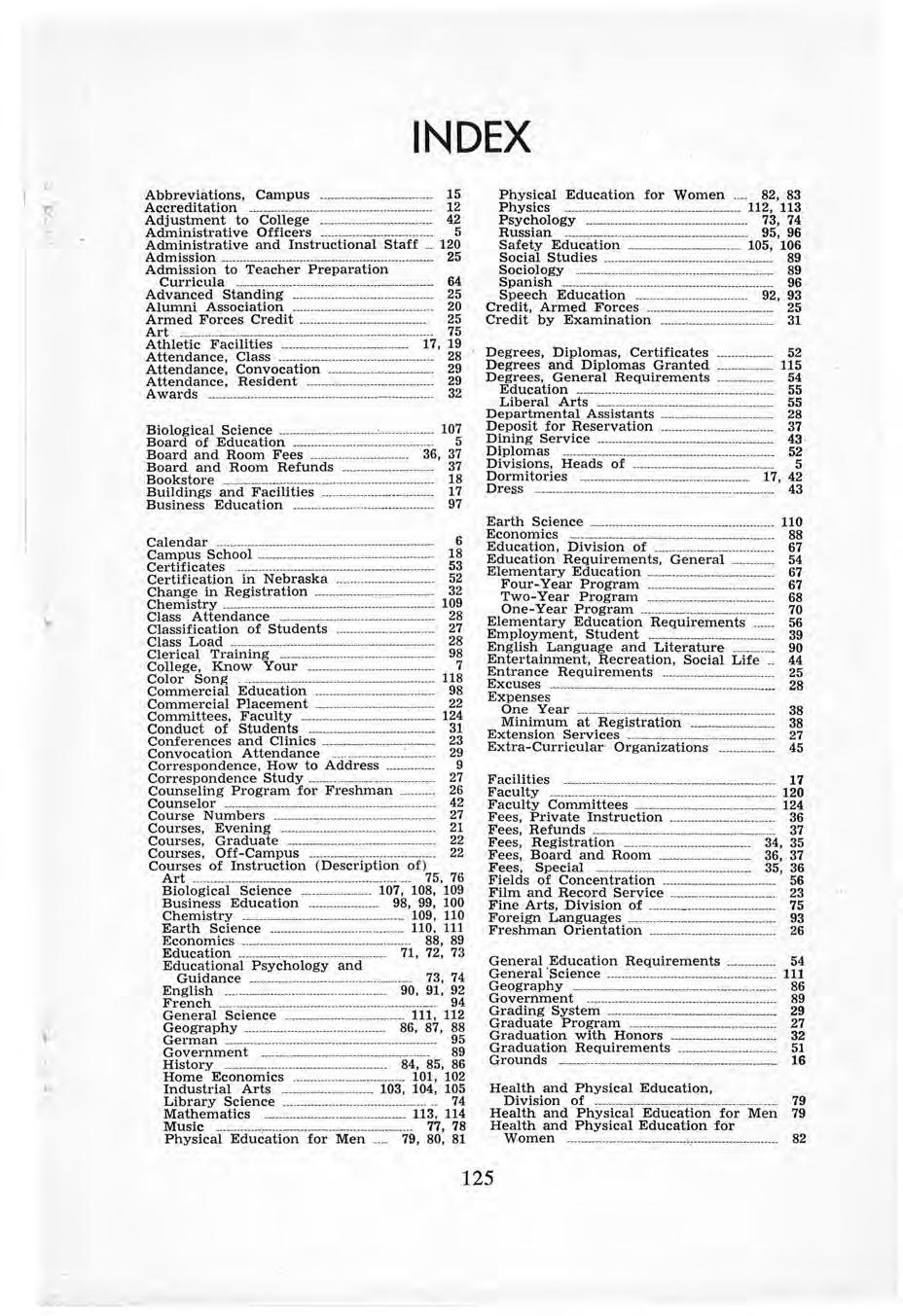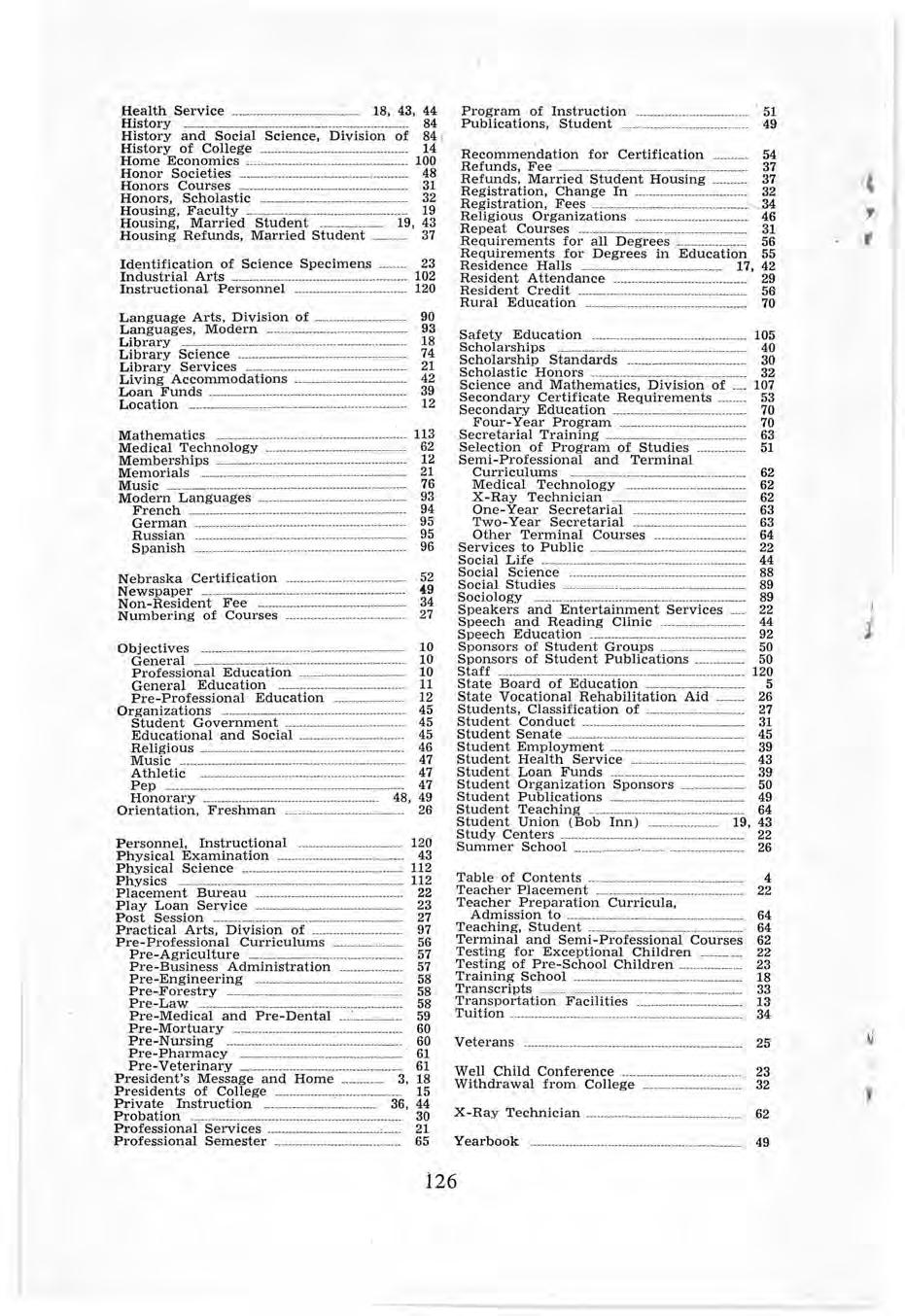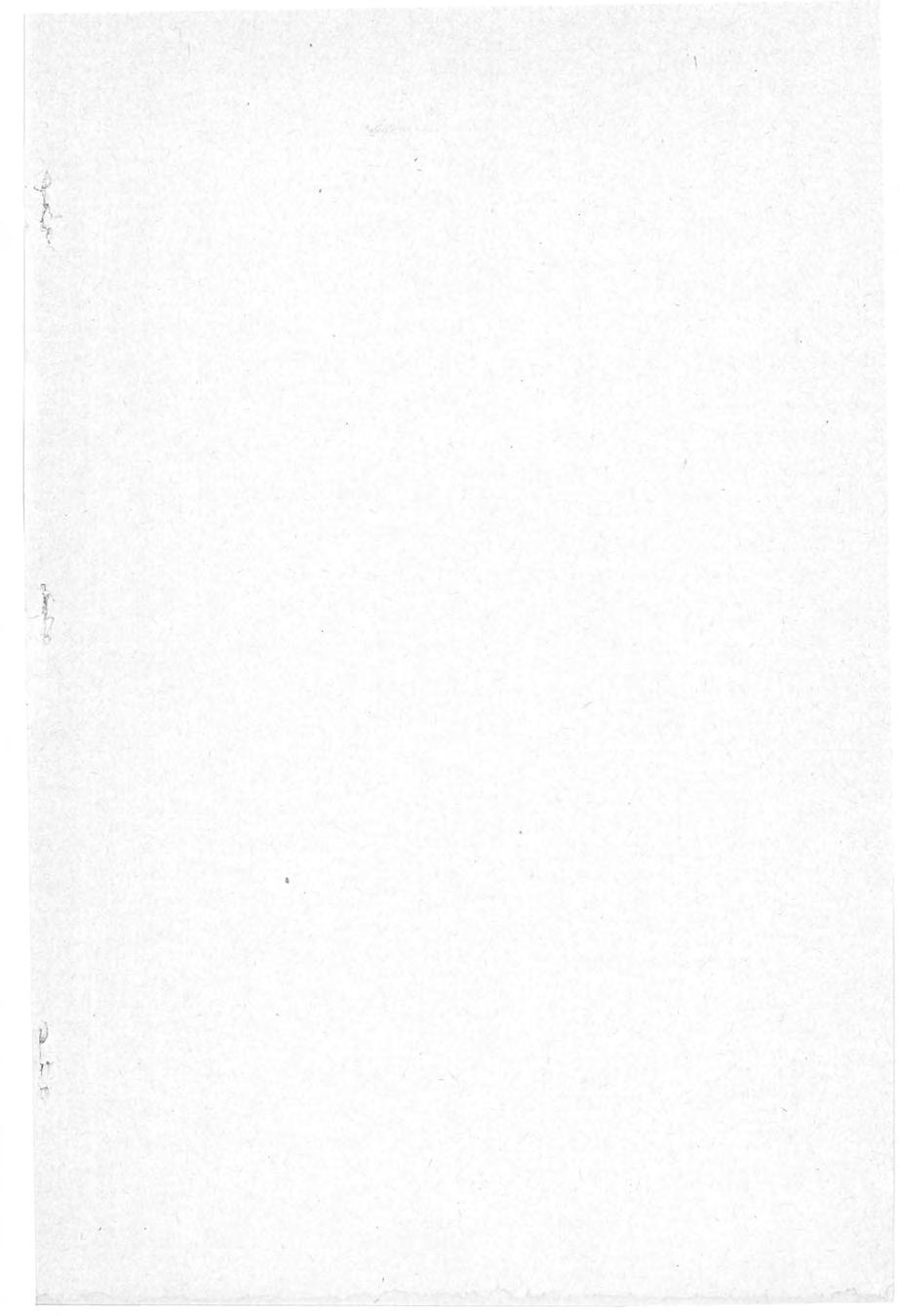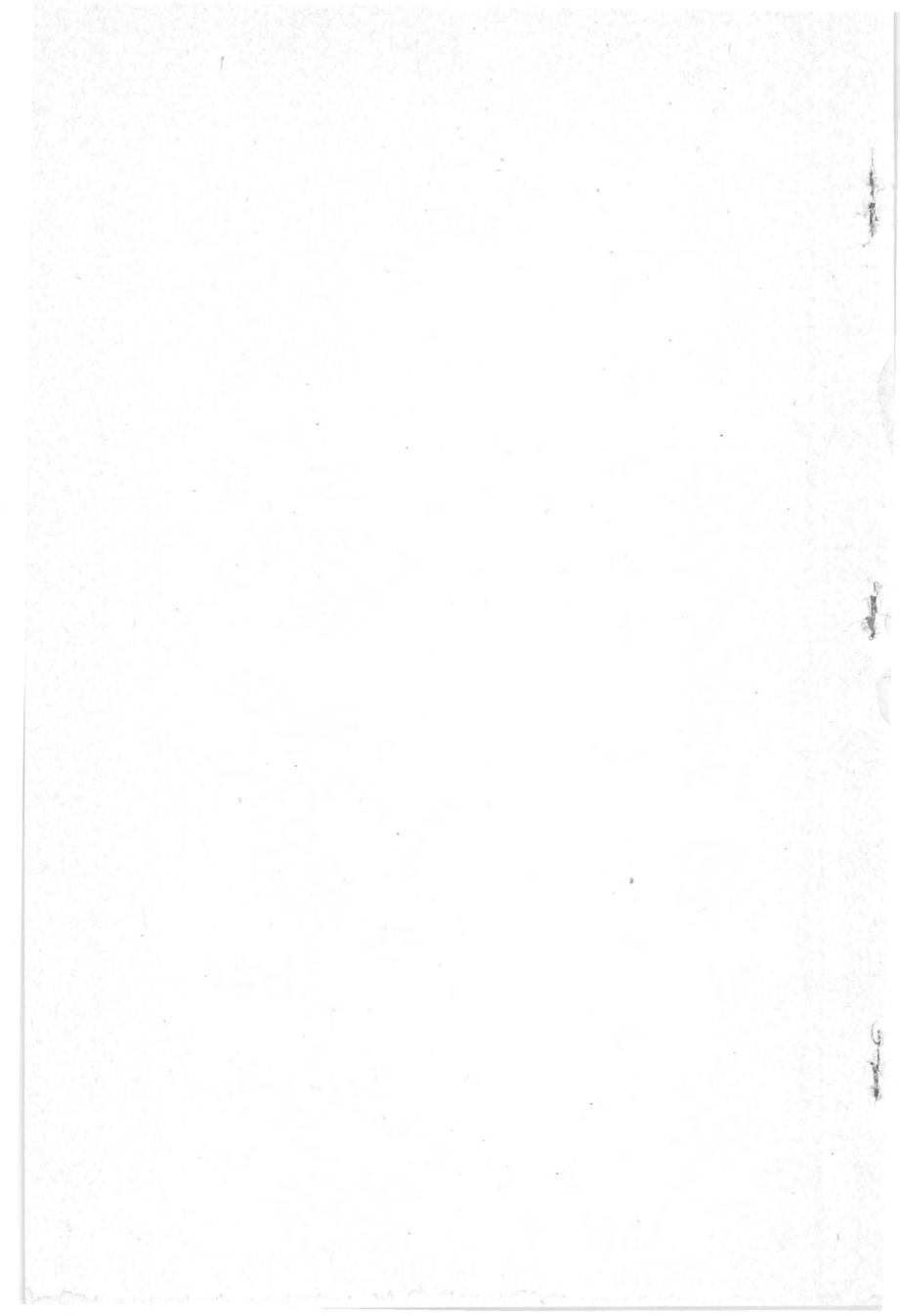




1959-60 CATALOG
Announcements for 1959-60
Academic Ye ar
VOL. XLVI, No 1, _MARCH, 1959
Published by Nebraska State Teachers College at Peru, N ebras ka , and entered under Bulk Permit Number 4 at P e ru, Nebras ka.
STUDENTS ARE REQUESTED TO BRING THEIR CATALOG WITH THEM TO THE CAMPUS FOR REFERENCE WHILE AT THE COLLEGE
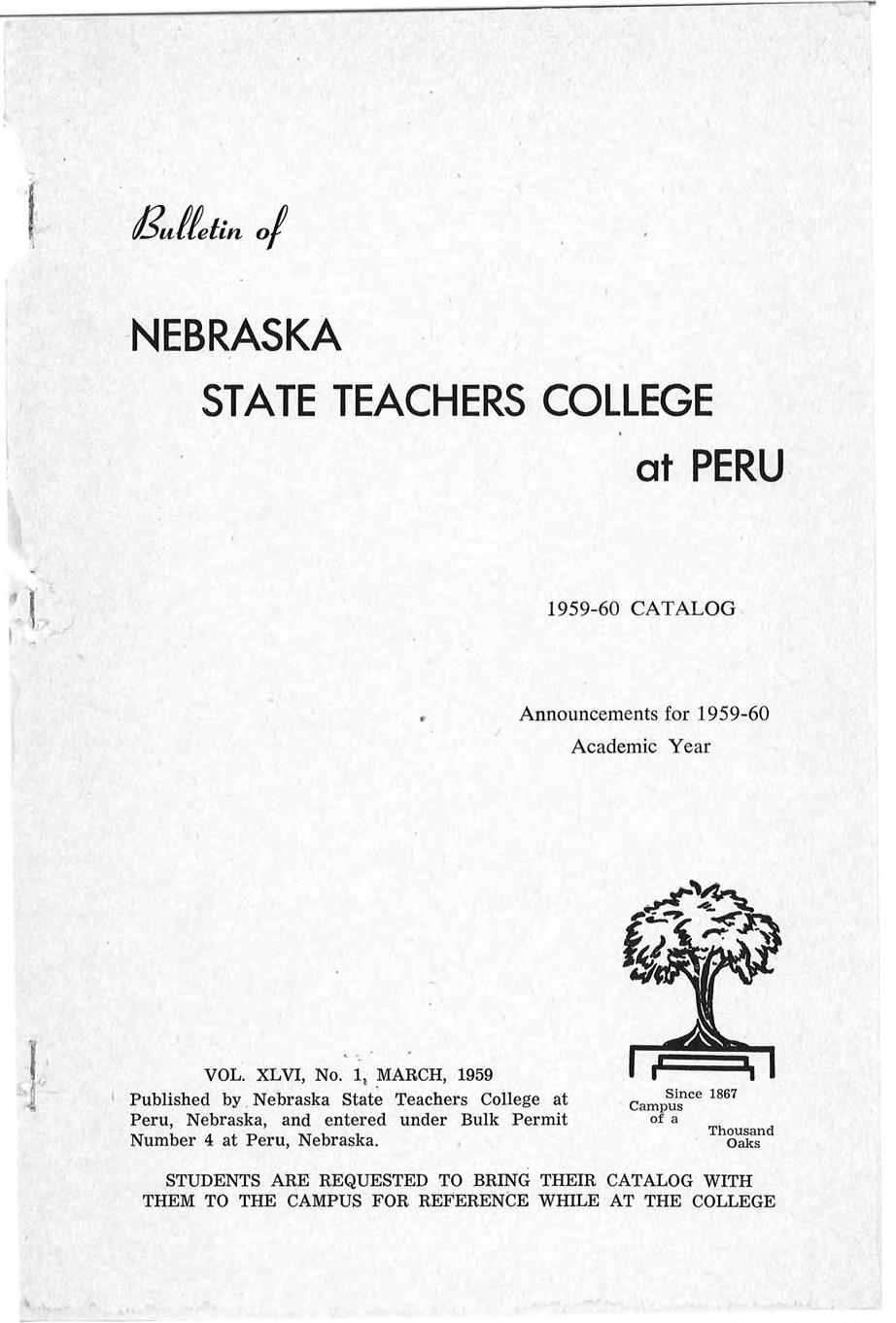
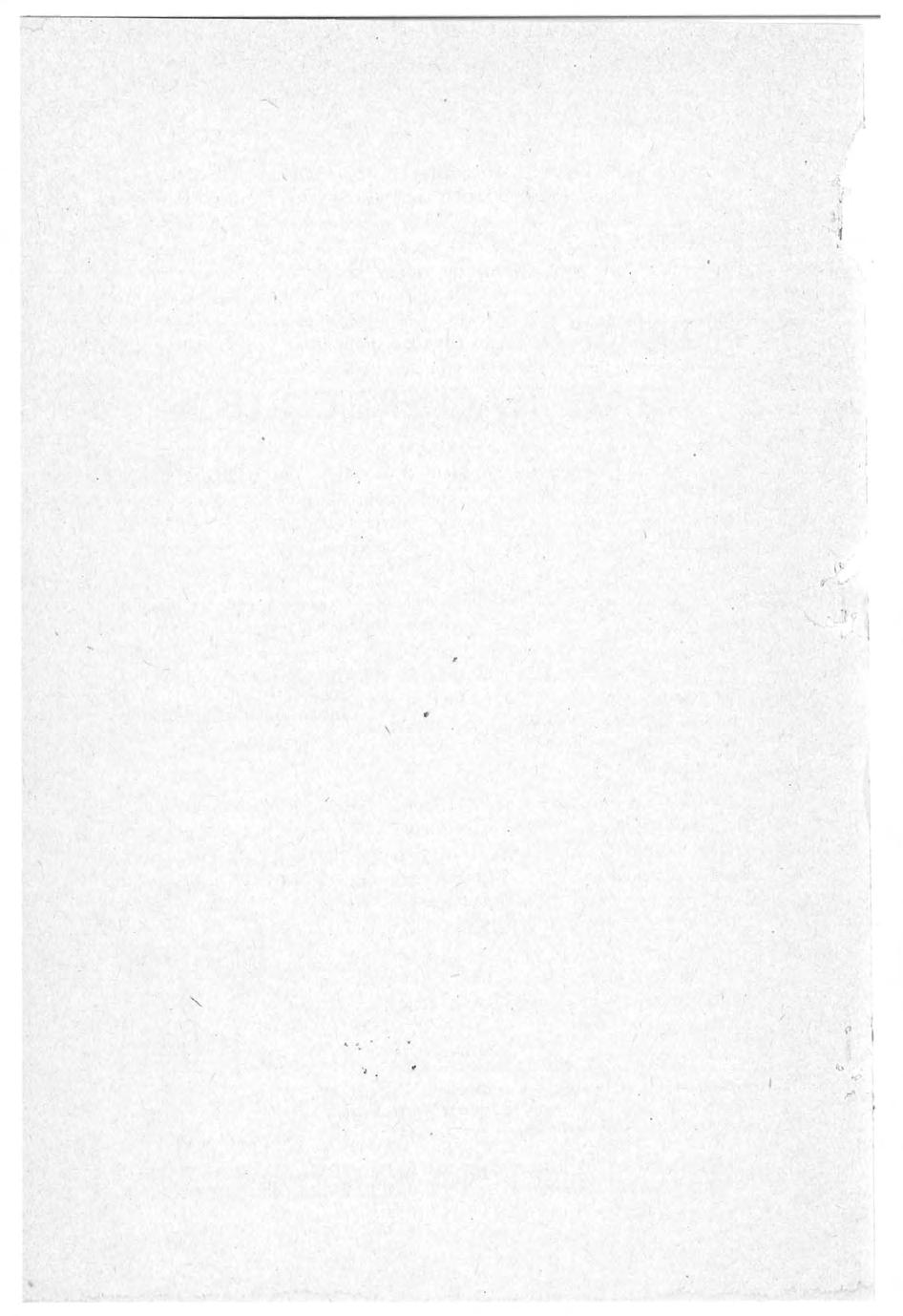
Peru State is the oldest college in - Nebraska and the third oldest teacher-training institution west of the Missouri River. Peru was established the same year Nebraska became a state. For 38 years it was the only teacher-training institution in Nebraska. For more than nine decades this College has been serving the young people of the state and surrounding states. During these 93 years thousands of young peopk have crossed the Campus of a Thousand Oaks and have gone forth to become teachers, adviser and friend to countless millions of children throughout the length and breadth of this great country.
The people of the State of Nebraska have made the facilities of this fine College available to you at a minimum of personal ·cost. The taxpayers of the state bear most of the cost of your college education exclusive of personal expenses. This support is in conformance with the deep-rooted American principle that every young person ·is entitled to a college education at reasonable expense to himself and to his family.
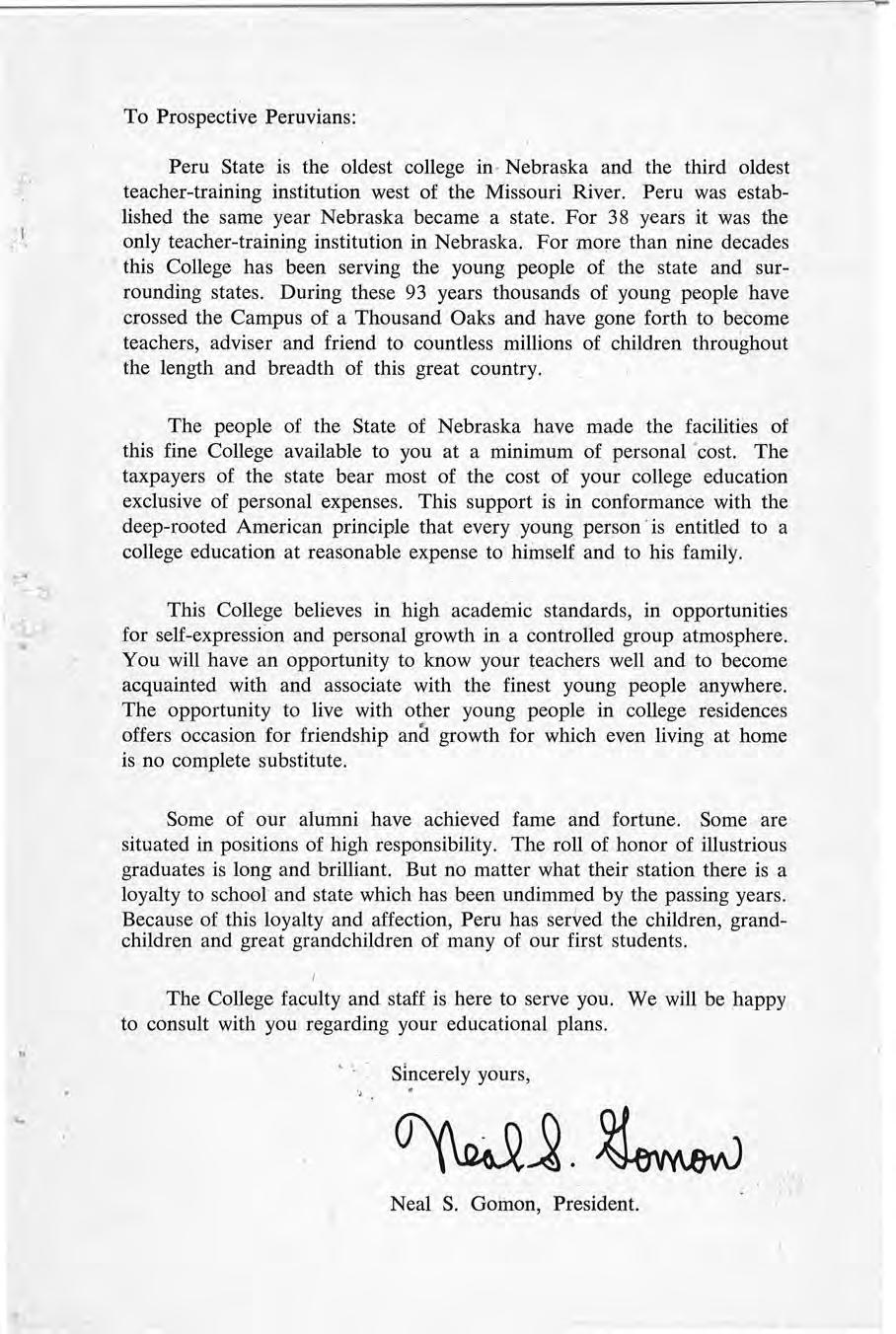
This College believes in high academic standards, in opportunities for self-expression and personal growth in a controlled group atmosphere . You will have an opportunity to know your teachers well and to become acquainted with and associate with the finest young people anywhere . The opportunity to live with other young people in college residences offers occasion for friendship and growth for which even living at home is no complete substitute.
Some of our alumni have achieved fame and fortune . Some are situated in positions of high responsibility. The roll of honor of illustrious graduates is long and brilliant. But no matter what their station there is a loyalty to school and state which has been undimmed by the passing years. Because of this loyalty and affection, Peru has served the children, grandchildren and great grandchildren of many of our first students.
The College faculty and staff is here to serve you. We will be happy to consult with you regarding your educational plans.
Sincerely yours, .
Neal S. Gomon, President.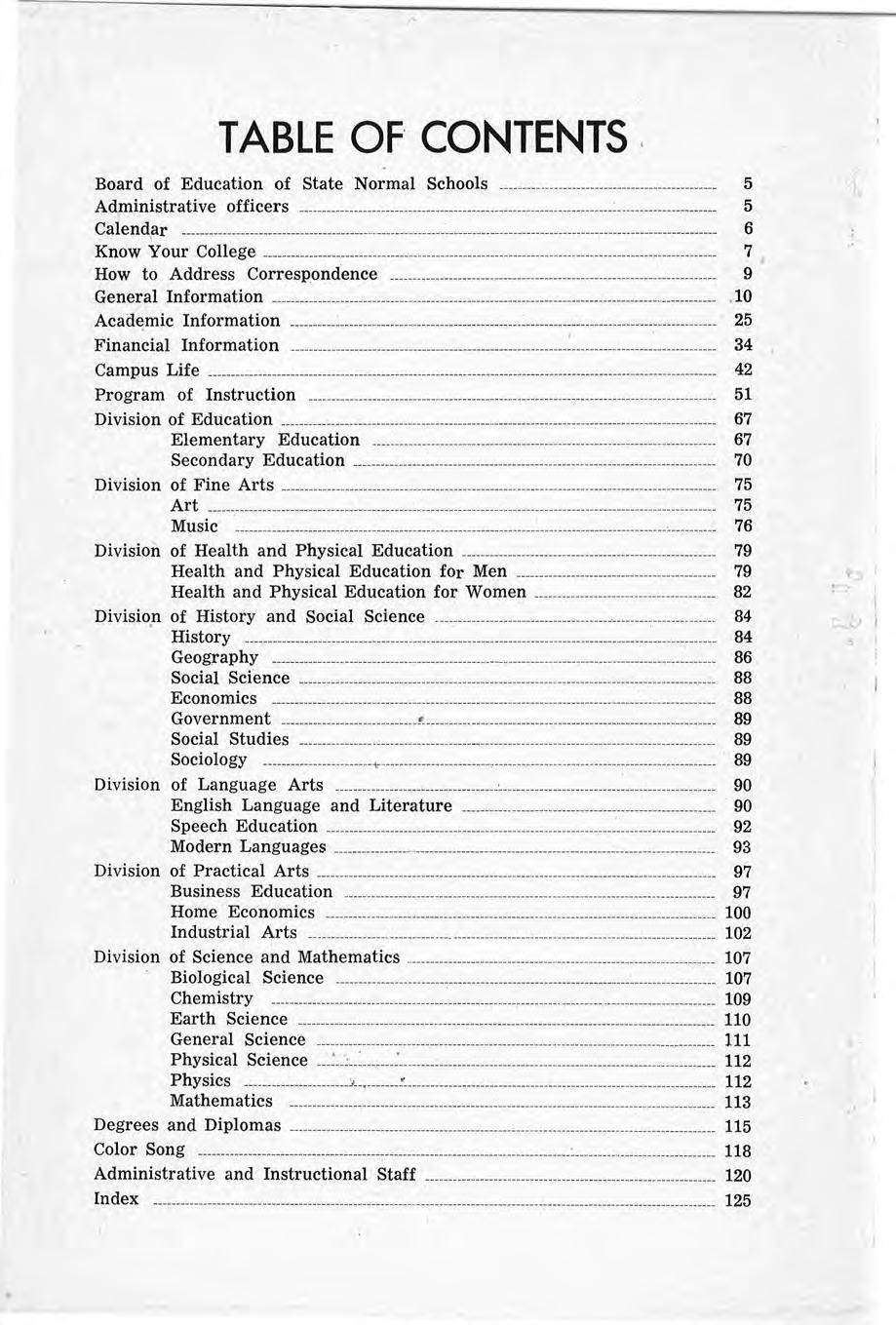
HEADS
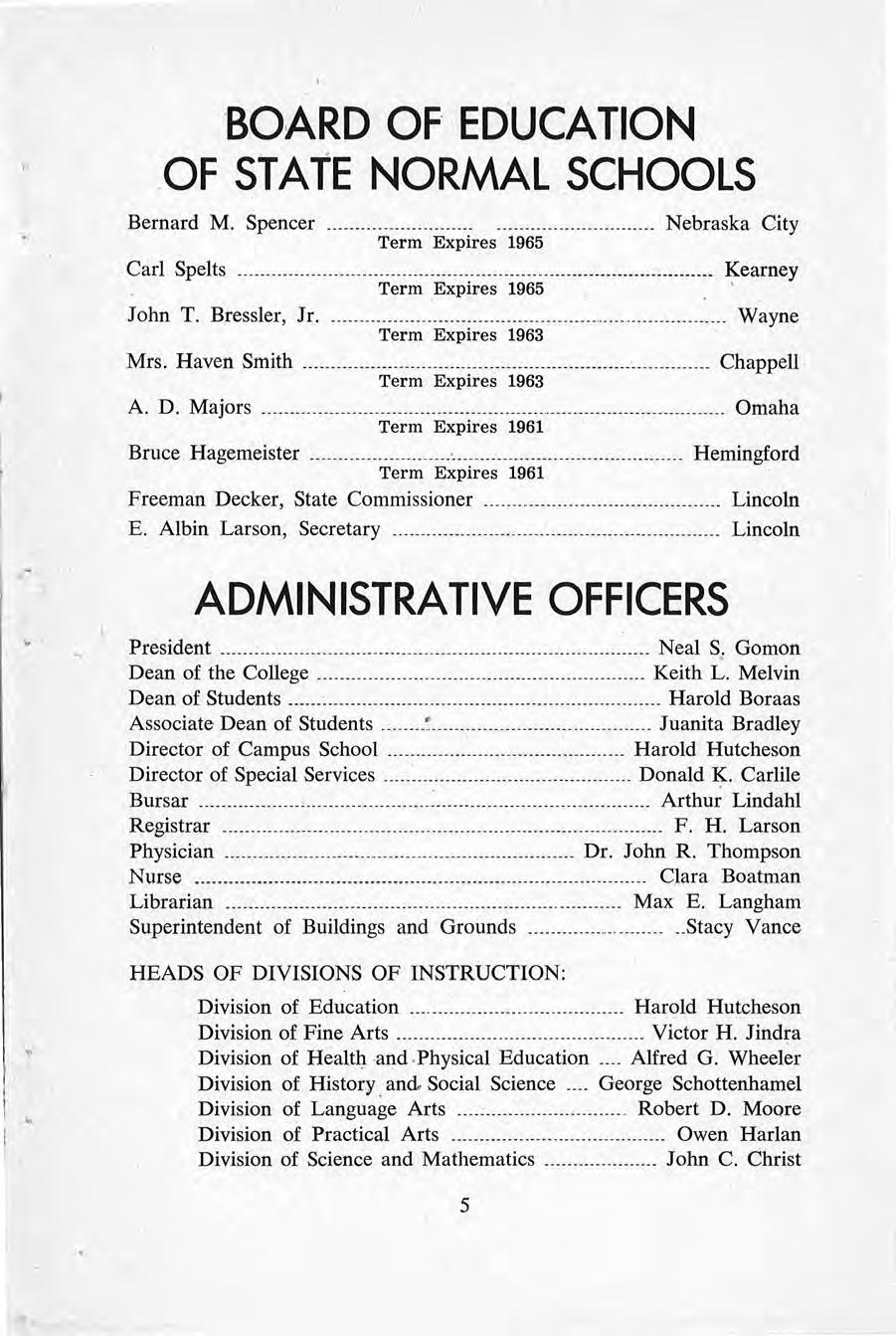
.
September 3-Faculty Workshop.
September 4-Faculty Meeting.
September 7-Campus School begins. Freshman Welcome Day
September 8-9-Freshman Orientation.
September 10-Freshman Registration .
September 11-Upperclassman Registration .
September 14-Classes begin. (Late registration fee after this date.)
September 21-Final date for change of registration
October 29-30-N S.E.A. Conventions
November 26-27-Thanksgiving recess •
December 18-Christmas recess begins. (4:00 p.m.)
January 4-Classes resume. (7:50 a.m )
January 4-15-Pre-registrati6n, second semester.
January 18-20-Final examinations
January 22-First semester ends.
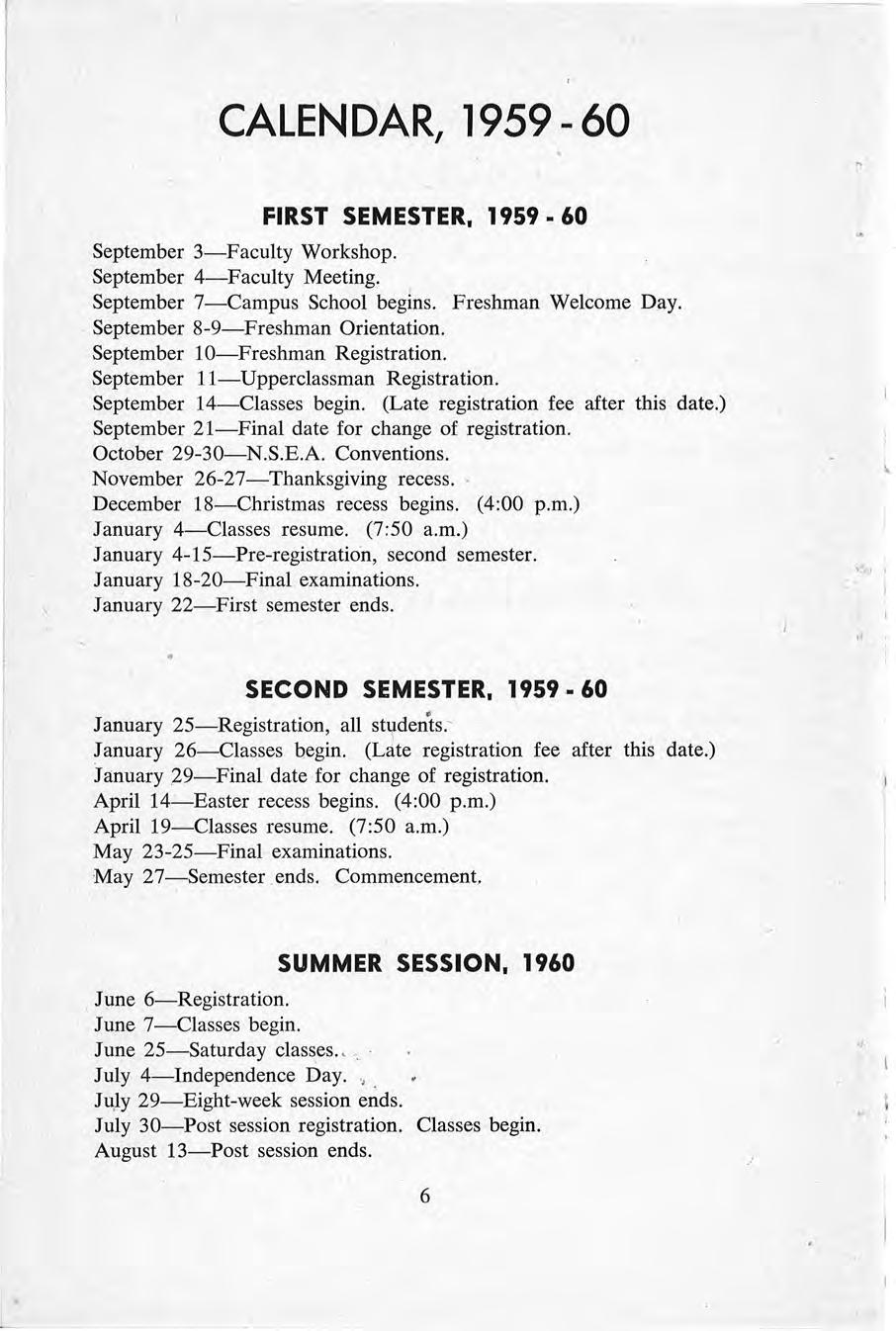
January 25-Registration, all st~den"ts . -
J anuary 26-Classes begin. (Late registration fee after this date.)
January .29-Final date for change of registration.
April 14-Easter recess begins . (4:00 p.m.)
April 19-Classes resume. (7:50 a.m .)
May 23-25-Final ex aminations.
May 27-Semester ends. Commencement,
June 6-Registration.
June 7-Classes begin.
June 25-Saturday class.es. , .. •
July 4-Independence Day . ., .
July 29-Eight-week session ends.
July 30-Post session registration. Classes begin.
August 13-Post session ends
To help you understand words and expressions used frequently in your association with the College, the following is pre sented as a preliminary in the catalog
ACCREDITED-A college having met standards set up by accrediting agencies, such as the North Central Association , is referred to as being accredited.
ADVISOR-See counselor.
CERTIFICATE-A written recognition by the State Department of Education of qualification to teach in rural, elementary or secondary schools. The College does not issue a certificate . (See also diploma.)
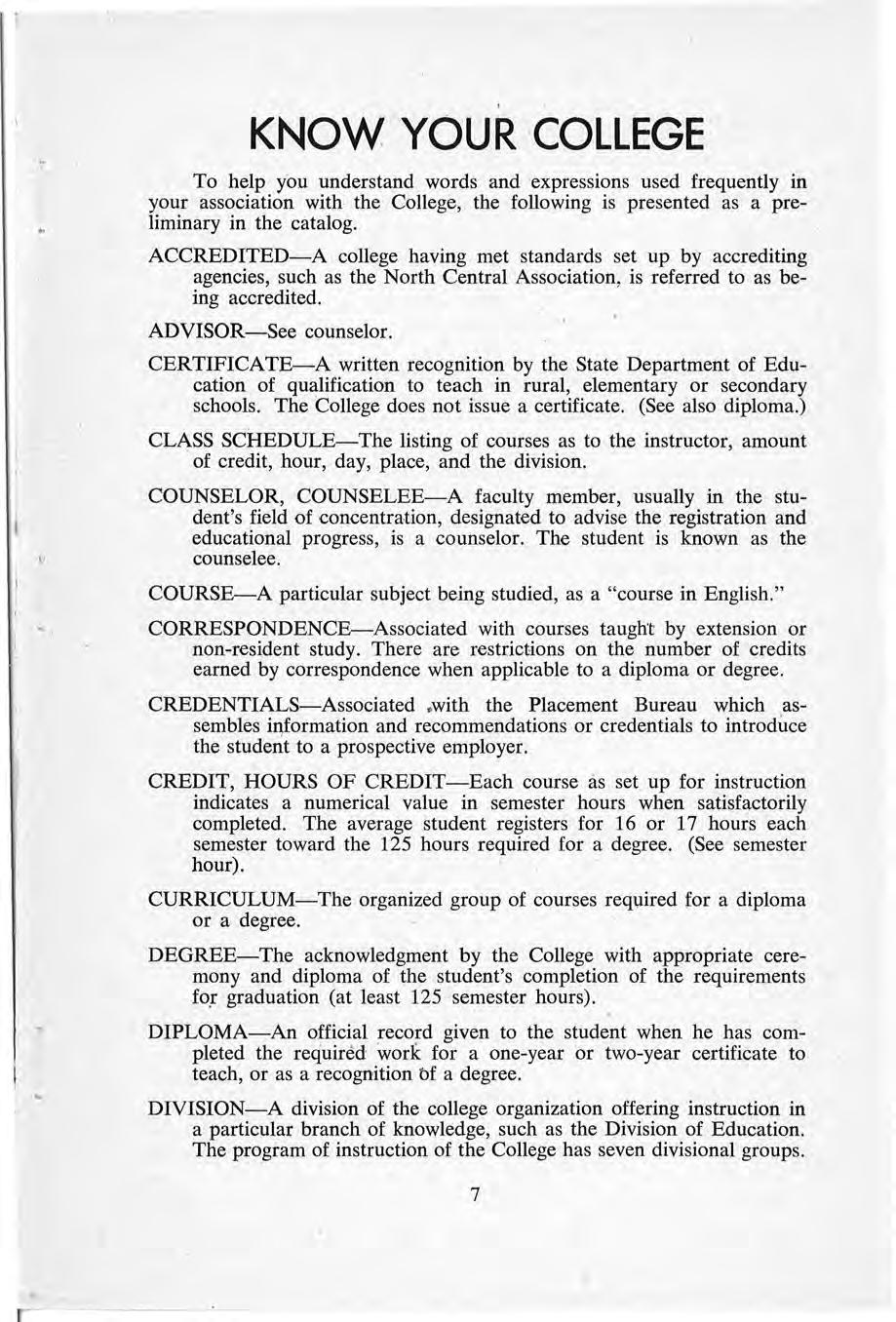
CLASS SCHEDULE-The listing of courses as to the instructor, amount of credit , hour, day, place, and the division.
COUNSELOR, COUNSELEE-A faculty member, usually in the student 's field of concentration, designated to advise the registration a:nd educational progress, is a coun selor. The student is known as the counselee.
COURSE-A particular subject being studied, as a "course in English."
CORRESPONDENCE-Associated with courses taught by extension or non-resident study. There are restrictions on the number of credits earned by correspondence when applicable to a diploma or degree.
CREDENTIALS-Associated with the Placement Bureau which assembles iqformation and recommendations or credentials to introduce the student to a prospective employer.
CREDIT , HOURS OF CREDIT-Each course as set up for instruction indicates a numerical value in semester hours when satisfactorily completed. The average student registers for 16 or 17 hours each semester toward the 125 hours required for a degree. (See semester hour). ·
CURRICULUM-The organized group of courses req1,1ired for a diploma or a degree.
DEGREE-The acknowledgment by the College with appropriate ceremony and diploma of the student's completion of the requirements fo,r graduation (at least 125 semester hours).
DIPLOMA-An official record given to the student when he has completed the required work for a one-year or two-year certificate to teach, or as a recognition t>f a degree.
DIVISION-A division of the college organization offering instruction in a particular branch of knowledge, such as the Division of Education. The program of instruction of the College has seven divisional groups.
DIVISION, LOWER AND UPPER-During the student's freshman and sophomore years he ordinarily takes courses in the 100-200 course number series as lower division, while in the junior and senior years he takes those in 300-400 series' as upper division. A specific number of hours in upper division courses are required for a degree
ELECTIVE-A course which is not included in the general requirements, or in the field of concentration for a degree, but taken because of the student's personal interest, is an elective.
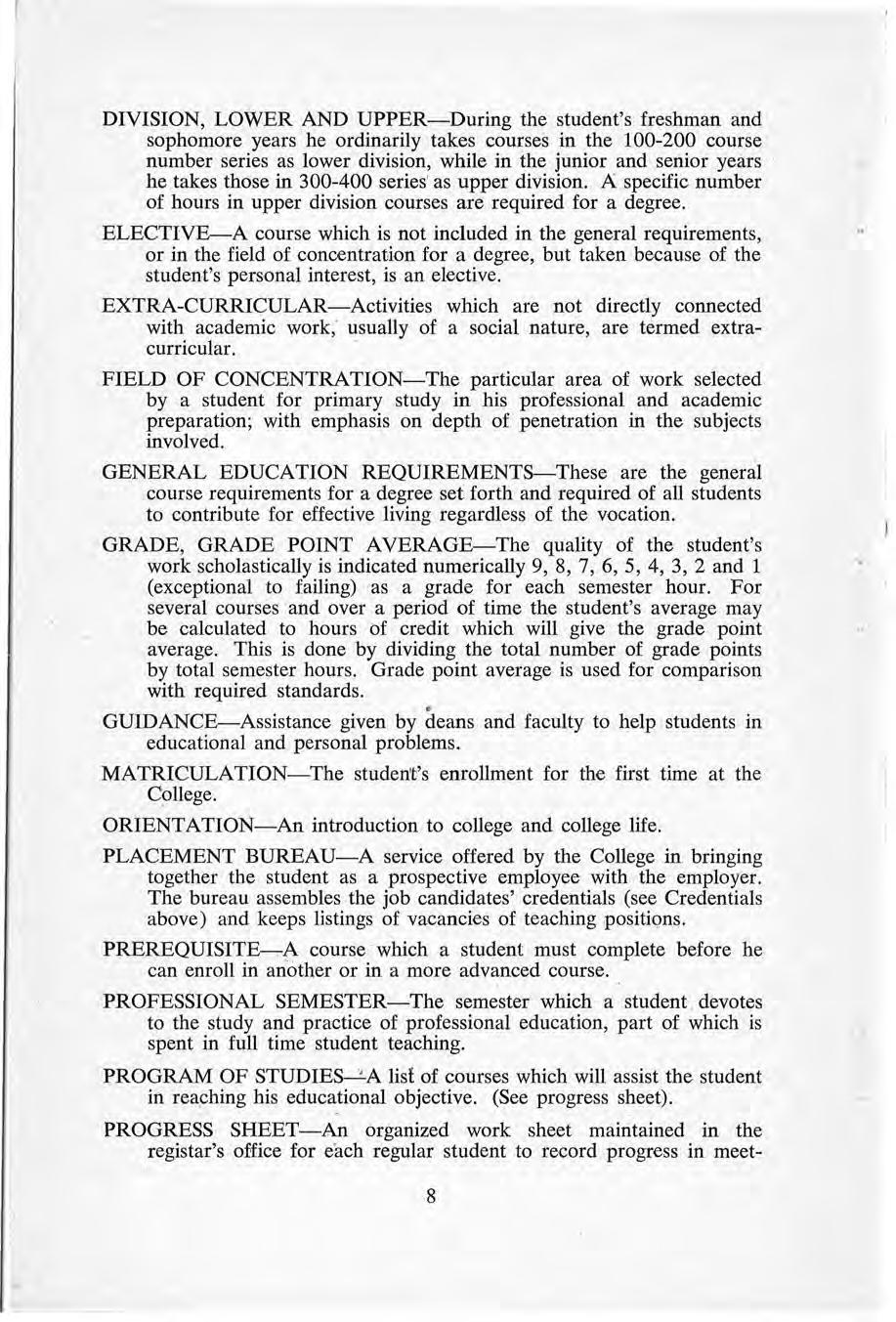
EXTRA-CURRICULAR-Activities which are not directly connected with academic work ,' usually of a social nature, are termed extracurricular. ·
FIELD OF CONCENTRATION-The particular area of work selected by a student for primary study in his professional and academic preparation; with emphasis on depth of penetration in the subjects involved .
GENERAL EDUCATION REQUIREMENTS-These are the general course requirements for a degree set forth and required of all students to contribute for effective living regardless of the vocation.
GRADE, GRADE POINT AVERAGE-The quality of the student's work scholastically is indicated numerically 9, 8, 7, 6 , 5, 4, 3, 2 and 1 (exceptional to . failing) as a grade for each semester hour. For several courses and over a period of time the student's average may be calculated to hours of credit which will give the grade point average . This is done by dividing the total number of grade points by total semester hours. Grade point average is used for comparison with required standard s.
GUIDANCE-As sistance given by deans and faculty to help students in educational and personal problems.
MATRICULATION-The studen't's enrollment for the first time at the College.
ORIENTATI ON-An introduction to college and college life.
PLACEMENT BUREAU-A service offered by the College in bringing together the student as a prospective employee with the employer. The bureau assembles the job candid a tes ' credentials (see Credentials above) a nd keeps listings of vacancies of teaching positiqns.
PREREQUISITE-,-A course ·which a student must complete before he can enroll in an other or in a more advanced course.
PROFESSIONAL SEMESTER-The semester which a student devotes to the study and practice of professional education, part of which is spent in full time student teaching.
PROGRAM OF STUDIES-'-A list of courses which will assist the student in reaFhing his educational objective. (See progress sheet).
PROGRESS SHEET-,-An organized work sheet maintained in the registar's office for each regular student to record progress in meet-
ing requirements for a .diploma or a degree . This also is accessible and used by the counselor and the student from time to time.
REGISTRATION-The procedure of enrolling in classes at the beginning of a semester which involves the choosing of courses with the advisement of a counselor and the payment of fees.
SEMESTER HOUR-A semester hour usually is an indication of the number of hours a week that the class meets , with the student expected to spend twice as many hours in class preparation. A threehour course meeting three days a week would require six hours of preparation, giving the student three semester hours of credit.
STUDENT LOAD-The number of hours in which a student is registered for a semester.
STUDENT TEACHING-Teaching without remuneration and under the supervision of a master teacher.
TERMINAL--This usually refers to curriculums designed to prepare students for vocational placement in less than four years
TRANSCRIPT-An official photostat or certified copy from the College of a student's record, date of matriculation, entrance units, full scho'lastic record , current status, and signature of the Regisrar.
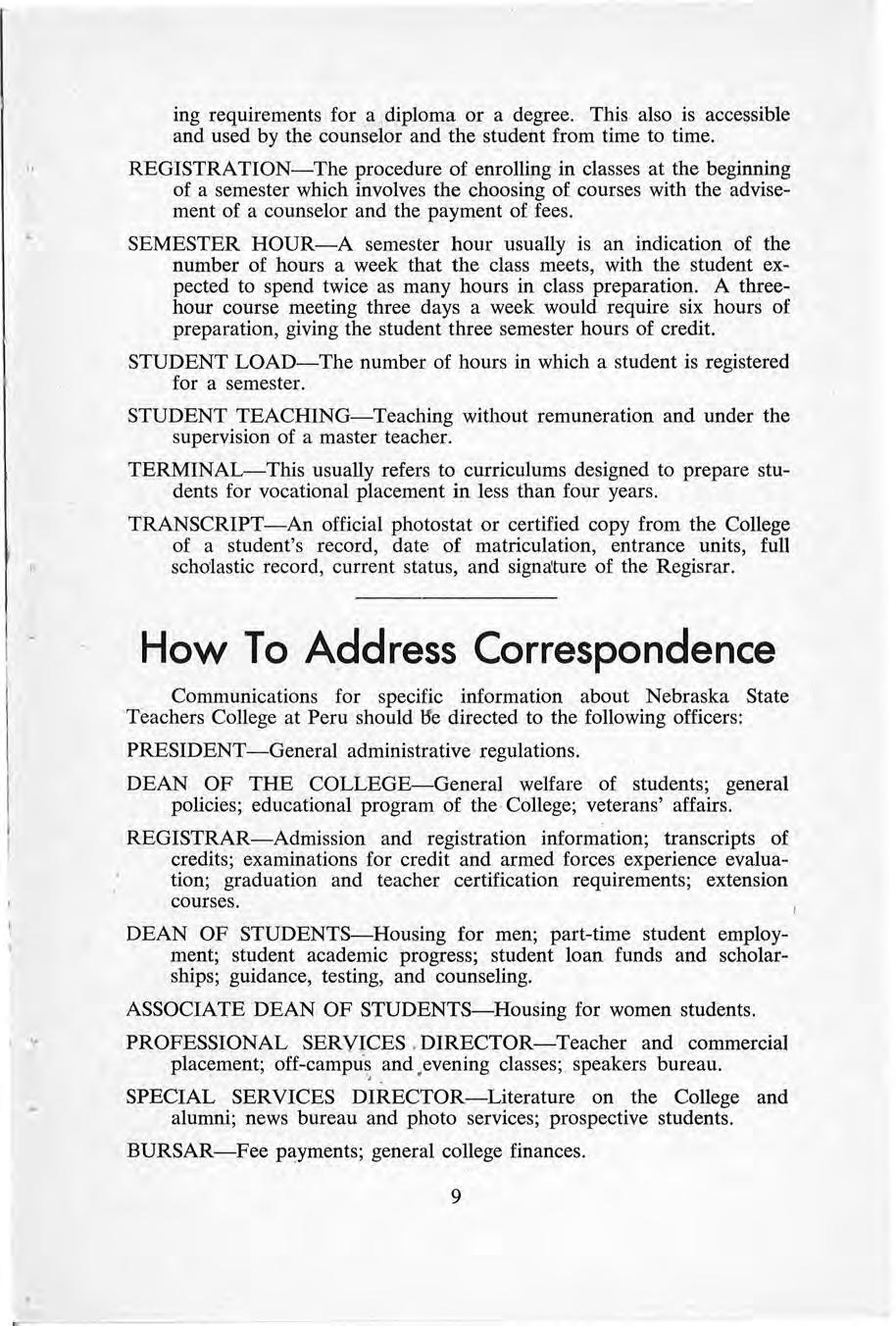
Communications for specific information about Nebraska State Teachers College at Peru should 15e directed to the following officers:
PRESIDENT-General administrative regulations.
DEAN OF THE COLLEGE-General welfare of students; general policies; educational program of the College; veterans' affairs.
REGISTRAR-Admission and registration information; transcripts of credits; examinations for credit and armed forces experience evaluation; graduation and teacher certification requirements ; extension courses.
DEAN OF STUDENTS-Housing for men; part-time student employment; student academic progress; student loan funds and scholarships; guidance, testing, and counseling.
ASSOCIATE DEAN OF STUDENTS-Housing for women students.
PROFESSIONAL SERVICES DIRECTOR-Teacher and commercial placement; off-campu s and evening classes; speakers bureau.
SPECIAL SERVICES DIRECTOR-Literature on the College and alumni; news bureau and photo services; prospective students.
BURSAR-Fee payments; general college finances.
The College offers students the opportunity to secure both professional training and general education. This is made possible through the following objectives.
The staff believes that in addition to more specific objectives, the College should provide for all students the environment for learning which will: -
1. Defend and strengthen free public education in the cause of American Democracy.
2. Cause an understanding and acceptance of the necessity for an enlightened citizenry so that self-government will survive and national unity will be protected.
3. Promote and further develop equality of educational opportunity, the kind that recognizes the worth and dignity of each individual.
4. Provide the opportunity to develop a system of values, consistent with reality and truth, by which the student may know himself and his relationship to the world.
5. Emphasize that all endeavor is worthy of high scholarly achievement or proficiency.
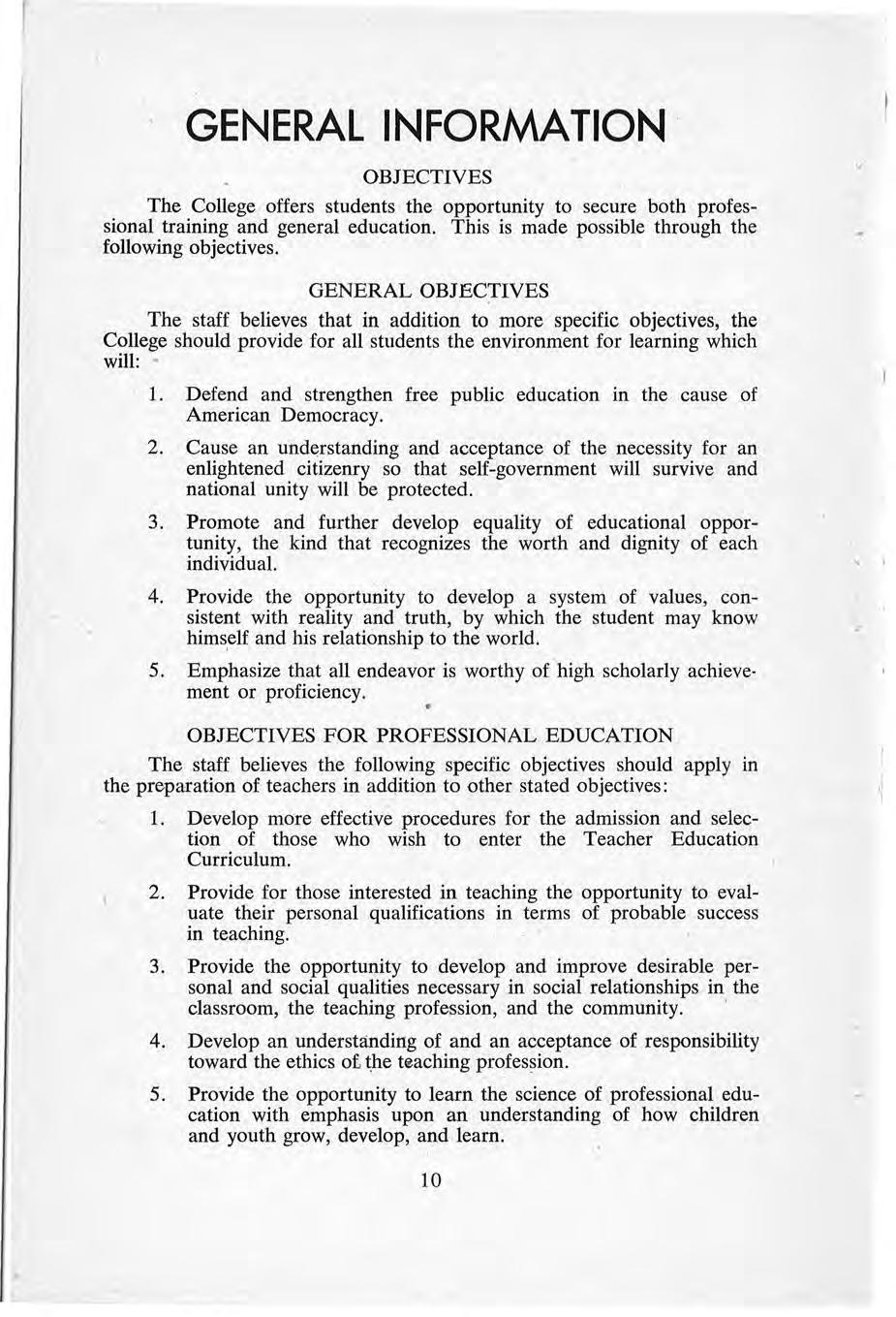
The staff believes the following specific objectives should apply in the preparation of teachers in addition to other stated objectives:
1. Develop more effective procedures for the admission and selection of those who wish to enter the Teacher Education Curriculum
2. Provide for those interested in teaching the opportunity to evaluate their personal qualifications in terms of probable success in teaching
3. Provide the opportunity to develop and improve desirable personal and social qualities necessary in social relationships in the classroom, the teaching profession, and the community. '
4. Develop an understanding of and an acceptance of responsibility toward the ethics 0£ (he teaching profession.
5. Provide the opportunity to learn the science of professional education with emphasis upon an understanding of how children and youth grow, develop, and learn.
6. Provide the opportunity to acq uire appropriate and sufficient subject matter background.
7. Provide the opportunity to become aware of and familiar with the material available for instructional purposes.
8. Provide an opportunity to develop certain skills in method and technique in teaching.
9. Develop a liking for young people and a desire to work with them.
10. Provide an opportunity to develop a defensible and practical philosophy of free . public education-that wh ich interprets the school's place in a democratic society, 1ts objectives, methods, and contributions to the national welfare. ·
11. Promote the continued improvement of teacher preparation, both in terms of the length in pre-service training and the quality of the program.
12. Provide appropriate and effective placement and follow-up services.
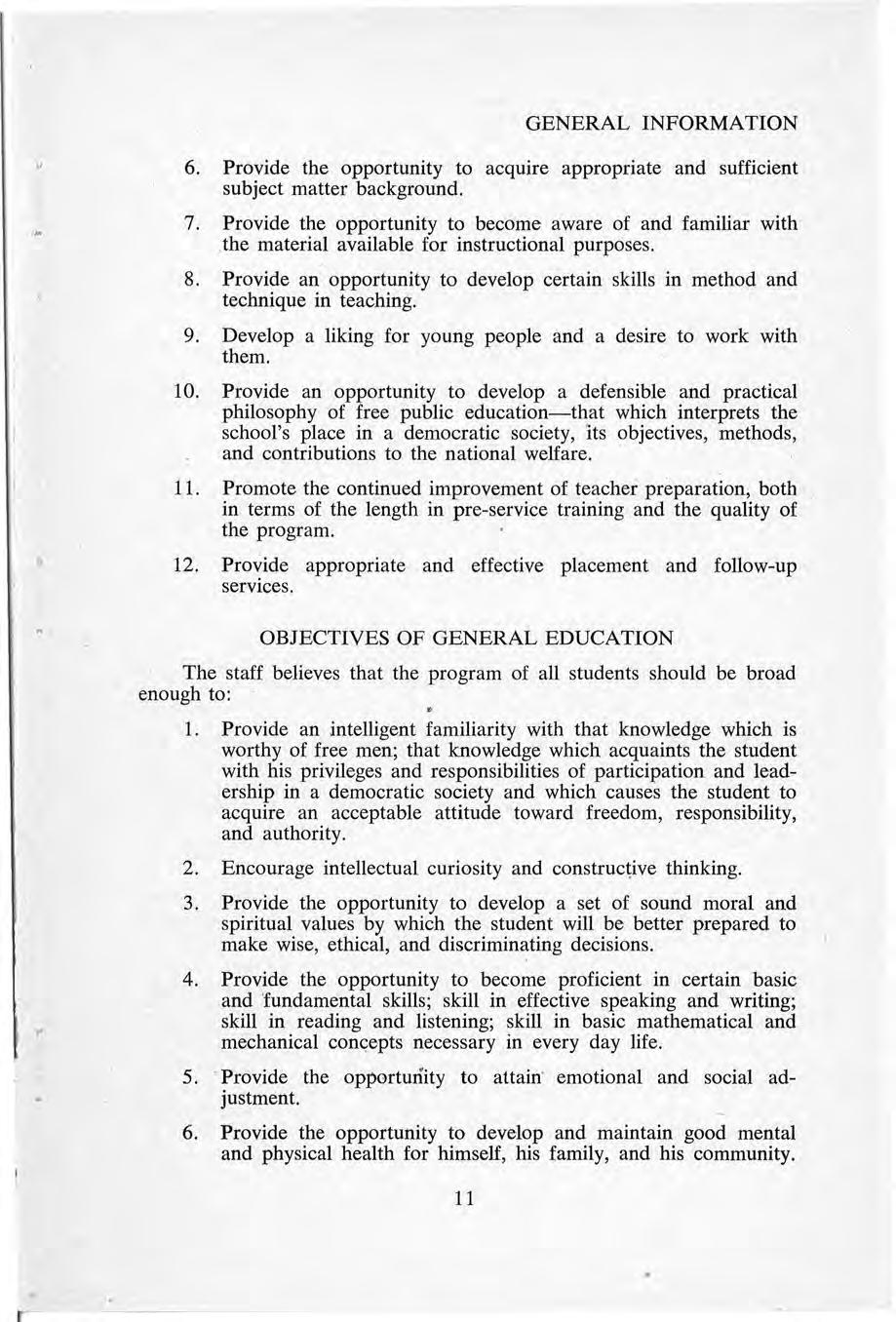
The staff believes that the program of all students should be broad enough to:
1. Provide an intelligent familiarity with that knowledge which is worthy of free men; that knowledge which acquaints the student with his privileges and responsibilities of participation and leadership in a democratic society and which causes the student to acquire an acceptable att itude toward freedom, responsibility, and authority.
2. Encourage intellectual curiosity and constructive thinking.
3. Provide the opportunity to develop a set of sound moral and spiritual values by which the student will be better prepared to make wise, ethical, and discriminating decisions.
4. Provide the opportunity to become proficient in certain basic and 'fundamental skills; skill in effective speaking and writing; skill in reading and li stening; skill in basic mathematical and mechanical conc;epts necessary in every day life.
5. · Provide the opportunity to attain• emotional and social adjustment.
6. Provide the opportunity to develop and maintain good mental and physical health for himself, his family, and his community.
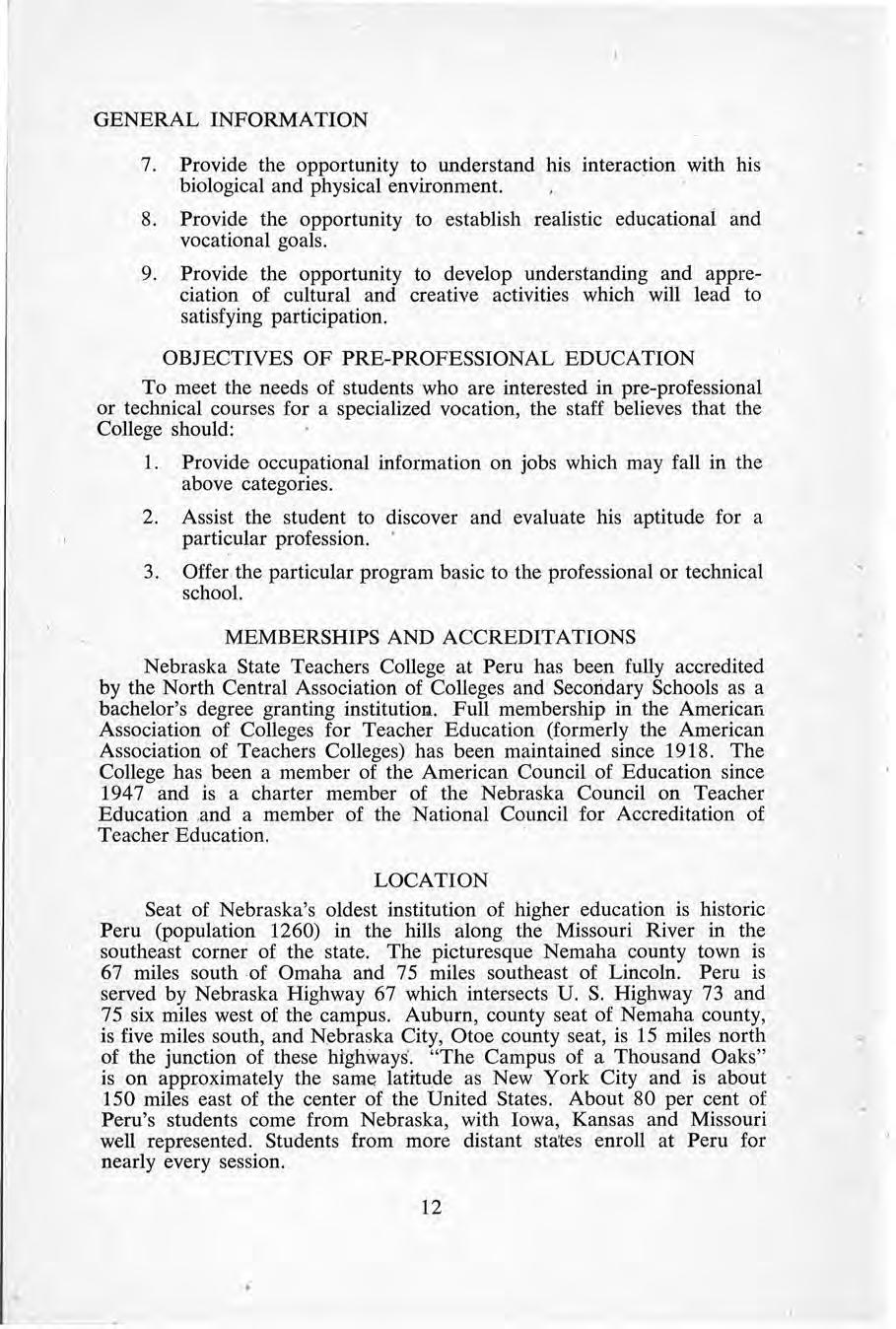
7. Provide the opportunity to understand his interaction with his biological and physical environment.
8. Provide the opportunity to establish realistic educationai and vocational goals.
9. Provide the opportunity to develop understanding and appreciation of cultural and creative activities which will lead to satisfying participation.
To meet the needs of students who are interested in pre-professional or technical courses for a specialized vocation, the staff believes that the College should:
1. Provide occupational information on jobs which may fall in the above categories.
2. Assist the student to discover and evaluate his aptitude for a particular profession.
3. Offer the particular program basic to the professional or technical school.
Nebraska State Teachers Colleg~ at Peru has been fully accredited by the North Central Association of Colleges and Secondary Schools as a bachelor's degree granting institution.. Full membership in the American Association of Colleges for Teacher Education (fqrmerly the American Association of Teachers Colleges) has been maintained since 1918 . The College has been a member of the American Council of Education since 1947 and is a charter member of the Nebraska Council on Teacher Education .and a member of the National Council for Accreditation of Teacher Education .
Seat of Nebraska's oldest institution of higher education is historic Peru (population 1260) in the hills along the Missouri River in the southeast corner of the state. The picturesque Nemaha county town is 67 miles south -of Omaha and 75 miles southeast of Lincoln. Peru is served by Nebraska Highway 67 which intersects U. S. Highway 73 and 75 six miles west of the campus . Auburn, county seat of Nemaha county, is five miles south, and Nebraska City, Otoe county seat, is 15 miles north of the junction of these highways . "The Campus of a Thousand Oaks" is on approximately the same latitude as New York City and is about 150 miles east of the center of the United States. About 80 per cent of Peru's students come from Nebraska, with Iowa, Kansas and Missouri well represented. Students from more distant sta'tes enroll at Peru for nearly every session.
Daily bus and train service to Omaha, Lincoln, Kansas City, Topeka, with connections in those cities to more distant points, is available at Auburn, 12 miles distant from Peru. Persons wanting transportation from Peru to Auburn can find rides almost hourly by inquiring of students and faculty members. Students arriving in Auburn at the opening of a semester or summer session may secure transportation by informing the Director of Special Services in advance of arrival. College transportation will be provided to and from Auburn only at the beginning or end of a semester or summer session.
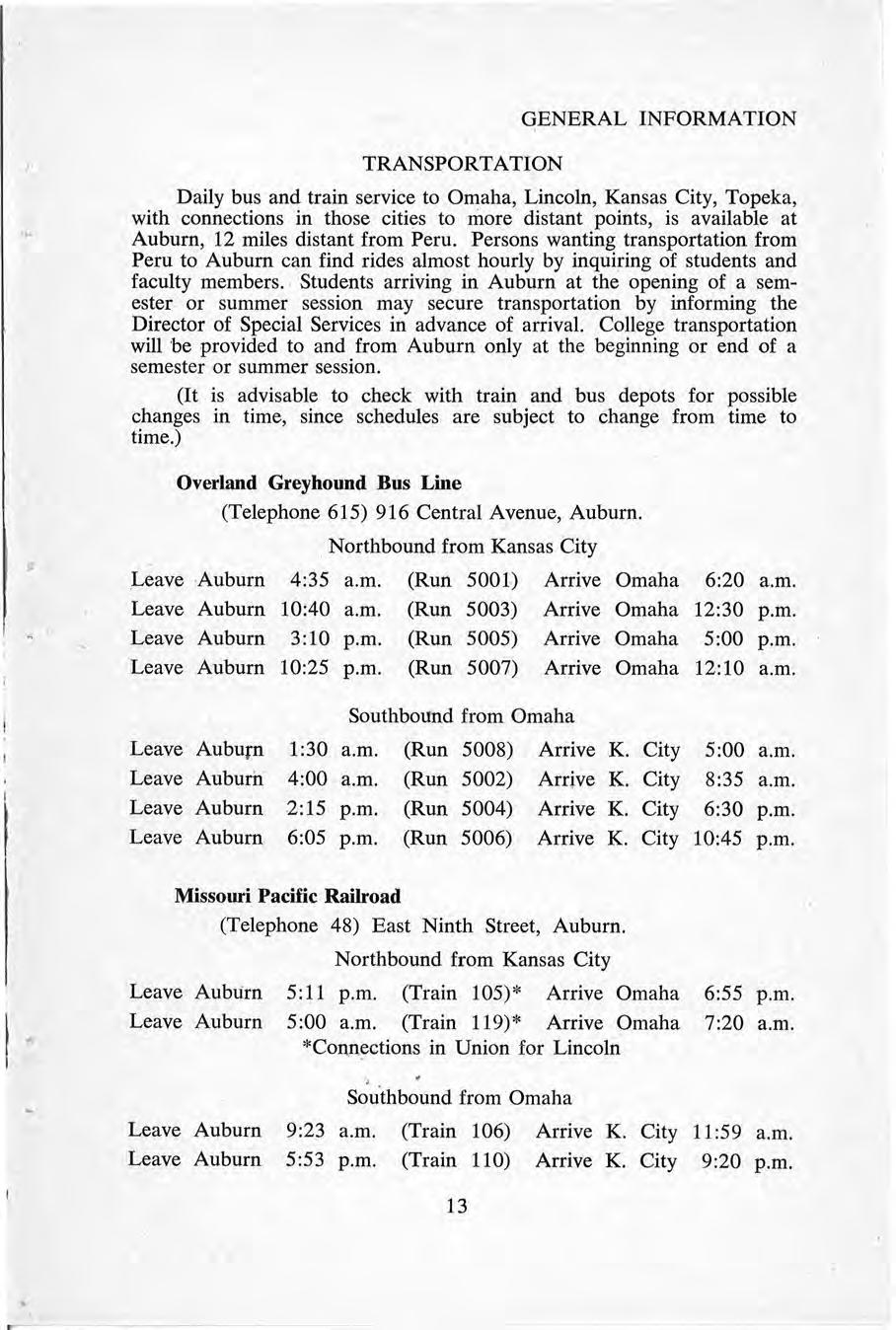
(It is advisable to check with train and bus depots for possible changes in time, since schedules are subject to change from time to time.)
Overland Greyhound Bus Line
(Telephone 615) 916 Central A venue, Auburn . . Northbound from Kansas City
'
The same year Nebraska became a state, the new state legislature provided for the establishment of a training school for teachers or "normal school " at Peru. At that time only two other such institutions existed west of the Missouri River-one in Kansas and one in California. The school's beginning actually dates back to December 2, 1865, when its predecessor institution, Mount Vernon College, was organized by a group of early settlers who resolved to place the school under the . "care and management of the Methodist Episcopal Church ."
After the church declined the offer , Col. T. J. Majors, a leader in the War Between the States and a state legislator, proposed that the school 'be made .the state university. Although the offer was rejected, the state legislature on June 20, 1867, did accept the school as a "normal school" several months before the state university was established. For 38 years after the Peru school became a "normal school" it was the only teacher e ducation institution in the state.
As Nebraska' s population increased, the legislature provided for three other normal schools-at Kearney in 1905, at Wayne in 1910, and at Chadron in 1911. The legislature extended the normal schools from two years to four years in 1921, and authorized these institutions to grant the degrees of Bachelor of A rt s in Edu cati on, Bachelor of Science in Education, and Bachelor of Fine Arts in Education.
When the United States entered World War II, the College offered its staff and facilities to the government for the training of officers for the armed forces. The first unit of men in the Navy V-12 program arrived on July 1, 1943. During the time the nearly 500 trainees received college training, the College operated on an accelerated program for both civilian students and nava.l trainees. Since that time many of these trainees have u sed the hours of college credit earned at Peru for degree requirements at Peru or other institutions of higher learning throughout the nation.
The liberal arts curriculum which was authorized by the 1949 legislature made it possible for the teacher-education institutions to confer the Bachelor of Arts degree. At the same time the names of the schools were changed from State Normal Scl10ols to State Teachers Colleges. In 1956 the Board of Education of State Normal Schools authorized these colleges to grant the Master of Science in Education and Master of Arts in Education degrees.
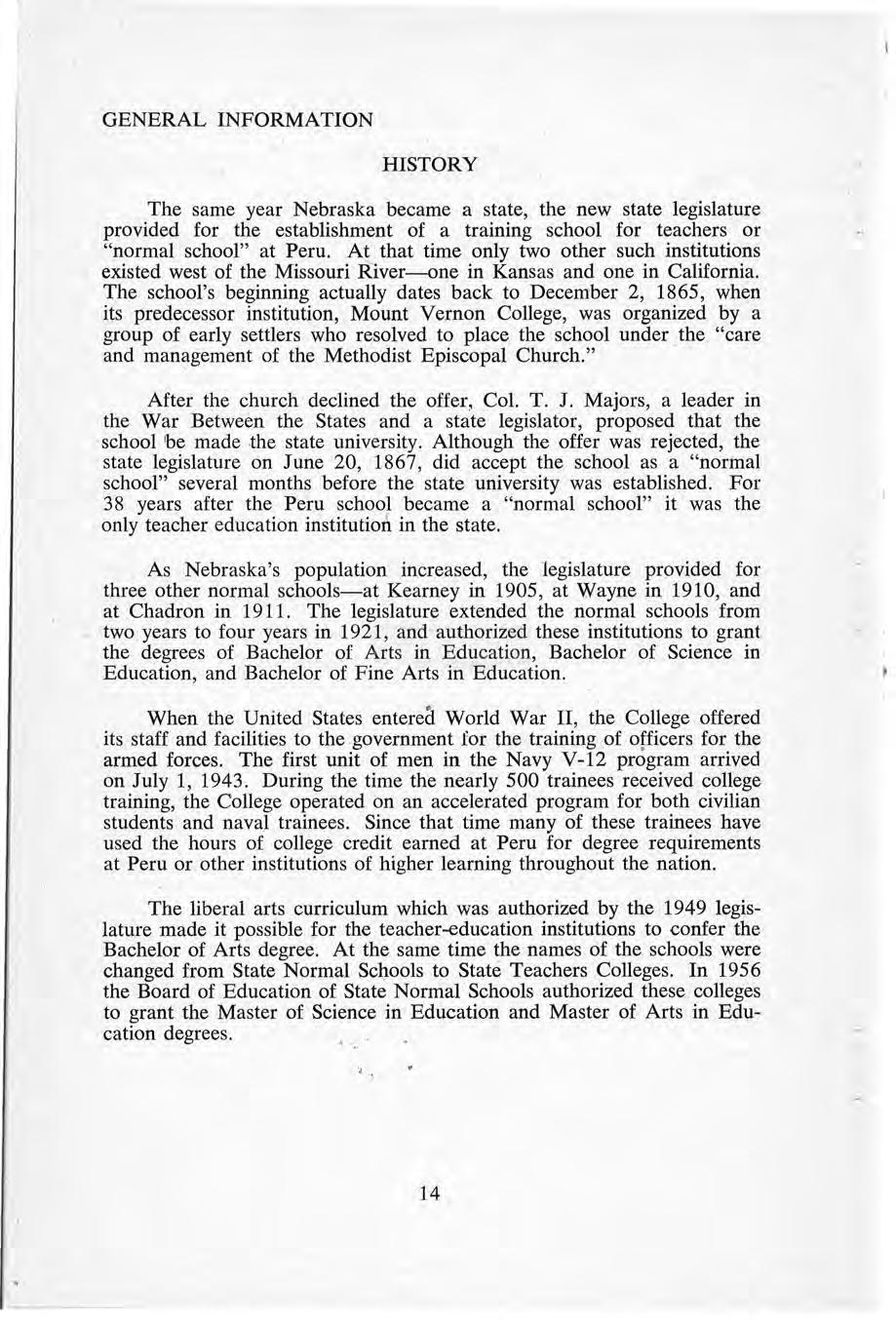
Nebraska's first college has been guided through the years by these presidents:
1867~1871-J. M. McKenzie
1871-1871-Henry H. Straight
1871-1872-A. D. Williams
1872-1874-T. J. Morgan
1874-1875-Azel Freeman
1875-1877-S. R. Thompson
1877-1883-Robert Curry
1883~1893-G. E. Farnham
1893-1896-A . W. Norton
1896-1900-James A. Beattie
1900-1904-A. W. Clark
1904-1910-J. W. Crabtree
1910-1918-D. W. Hayes
1918-1921-E. L. Rouse
1921-1923-A. L. Caviness
1923-1946-W. R. Pate
1946-1950-W. L. Nicholas
1950-1951-Wayne 0. Reed
1951 --'Neal S. Gamon
Abbreviations for campus buildings are used frequently in listing rooms for class and organization meetings. The first of the three-digit numbers used with 'the building abbreviation indicates the floor and the second and third are the room number on that floor. For example, Ad 101 would be room number one on the first floor of the Administration building. ·
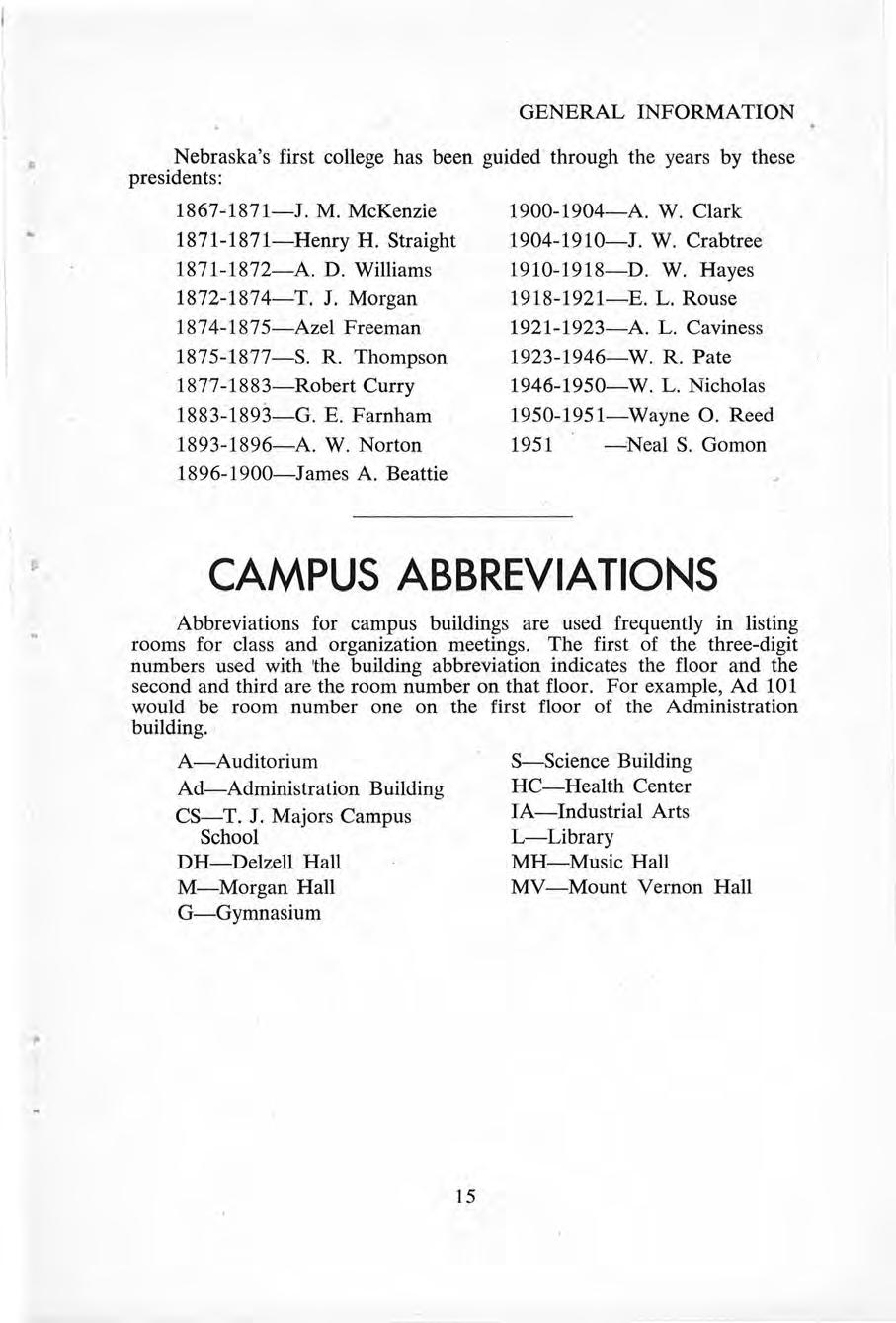
A-Auditorium
Ad-Administration Building
CS-T. J. Majors Campus School
DH-Delzell Hall
M-Morgan Hall
G-Gymnasium
S-Science Building
RC-Health Center
IA-Industrial Arts
L-Library
MR-Music Hall
MY-Mount Vernon Hall
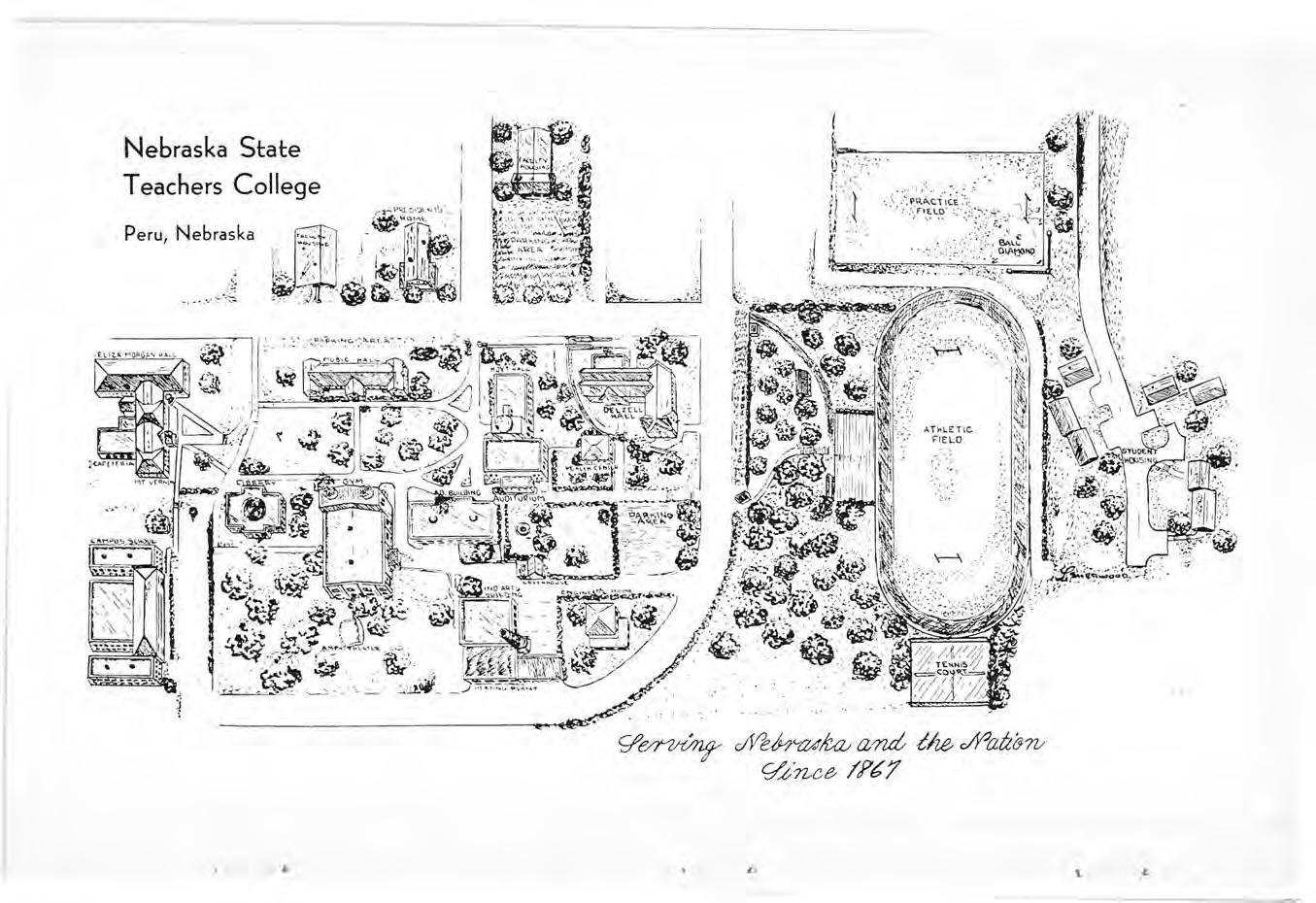
ADMINISTRATION BUILDING. The administration, business, personnel, special services, and professional services offices, as well as classrooms and instruytors' offices, are housed in the Administra'tion building Also the campus post office which handles incoming and outgoing mail is located on the main floor.
AUDITORIUM. Main floor and balcony of the Auditorium has a seating capacity of 1,200. It is used for convocations, musical recitals and operettas, dramatic productions, and as an assembly room for conferences and clinics. Classrooms for the modem language department are housed in the Auditorium . Classic pictures and statues of Greek and Roman art objects, gifts ·of the Fortnightly Art Club, early-day Peru organization are placed throughout the building.
DELZELL HALL. The men's residence hall at the College is Delzell Hall, which was completed in the fall of 1939. The men's residence hall's facilities include lounge, recreation, and television rooms. The dormitory counselor's quarters are on the main floor. Laundry facilities are available for residents of the hall.
MORGAN HALL. The women's residence hall, Morgan Hall, provides comfortable living accommodations for women students. Adjacent to the lobby is an attractive comfortable lounge where the residents receive guests. Other facilities available to residents of the hall include recreation room, study room, laundry and kitchen. The dormitory counselor has an apartment on the main floor.
MOUNT VERNON HALL. One of the oldest buildings on the campus is Mount Vernon Hall which was built in 1897. It includes the college dining room, rooms for students, the Student Union with recreational rooms and snack bar, and a manager's apartment. The editorial room of the College yearbook, The Peruvian, along with the offices of The Pedagogian, student newspaper ; are also in Mount Vernon Hall.
GYMNASIUM. Reconstructed in 1949 on the site of the original Chapel, the Gymnasium has an overall dimension of 100 feet by 156 feet and a seating capacity of 2,500. The facilities include two basketball floors, tile swimming pool, indoor track, locker and shower rooms for men and women. The building houses physical education offices and classrooms.
SCIENCE BUILDING. Designed especially for the teaching of science, the Science building houses well-equipped laboratories and accompanying classrooms and offices. Complete facilities for the instruction of astronomy, botany, zoology, chemistry, geology, geography, physics, and health are included in the three-story structure. An observatory with a six-inch refractor telescope used in the instruction of astronomy is located on the roof.
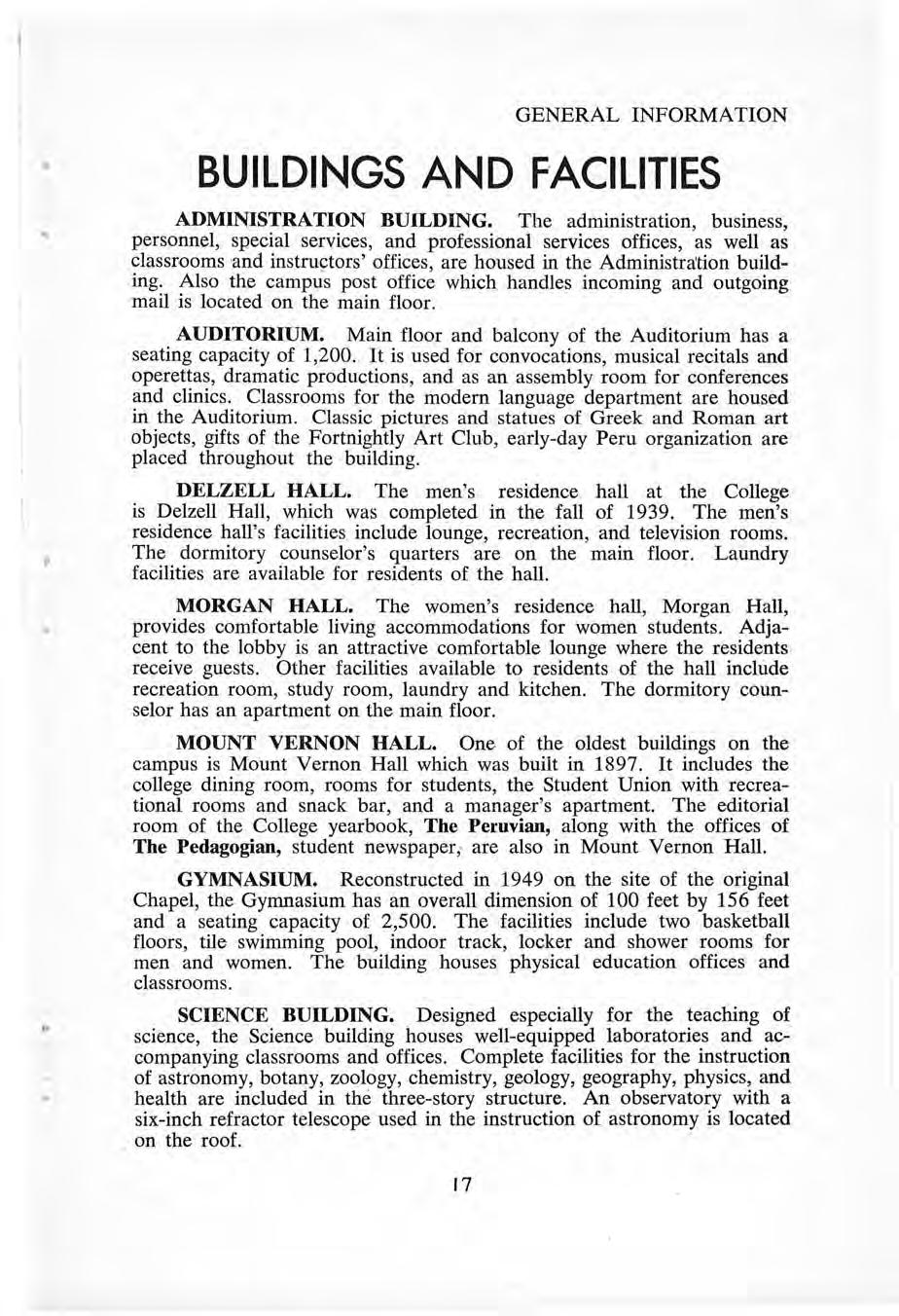
An extensive collection of biological and mineral specimens displayed in the Science building is available for student study. Each year school children and adult groups from a wide area view these displays.
INDUSTRIAL ARTS. The work in this area is housed in two buildings. Well-equipped woodworking shops and complete drafting facilities are located in the Industrial Arts building . Metal work including machine shop practice, sheet metal, welding, farm and home mechanics, arts and crafts, general electricity, electronics, and related areas are all located on the first floor of the campus school which complete the facilities for the training of industrial arts teachers.
HEALTH CENTER. The Student Health Service, which provides first aid treatment and hospitalization for students needing emergency medical care, operates in the Health Center. The facilties include, besides infirmary and treatment rooms, the college nurse ' s apartment and a suite of rooms used by the Well Child Conference. A registered nurse is in charge of the Health Center-working under the direction of the College physician and College Student Health Committee. The Well Child Conference, operated jointly by the State Department of Health and the College, gives free physical examin a tion s to any child, regardless of residence, providing the prescribed schedule of examinations is followed.
LIBRARY. One of the first established in Nebraska, the College Library is centrally located on the College Campus. It houses reading rooms, the Children's Library, study carrels, work rooms, and in addition to the library proper, the Little Theater and art classrooms.
COLLEGE BOOKSTORE. The College Bookstore is housed in the first floor of Mount Vernon Hall. Current textbooks are carried in stock and available for purchase:
MUSIC HALL. On the first floor of the Music Hall are individual sound-proof practice rooi:ns, group rehearsal room, classrooms and studios. A small auditorium ·used for recitals , a choir rehearsal room, two classrooms, and two studios are located oq 'the second floor
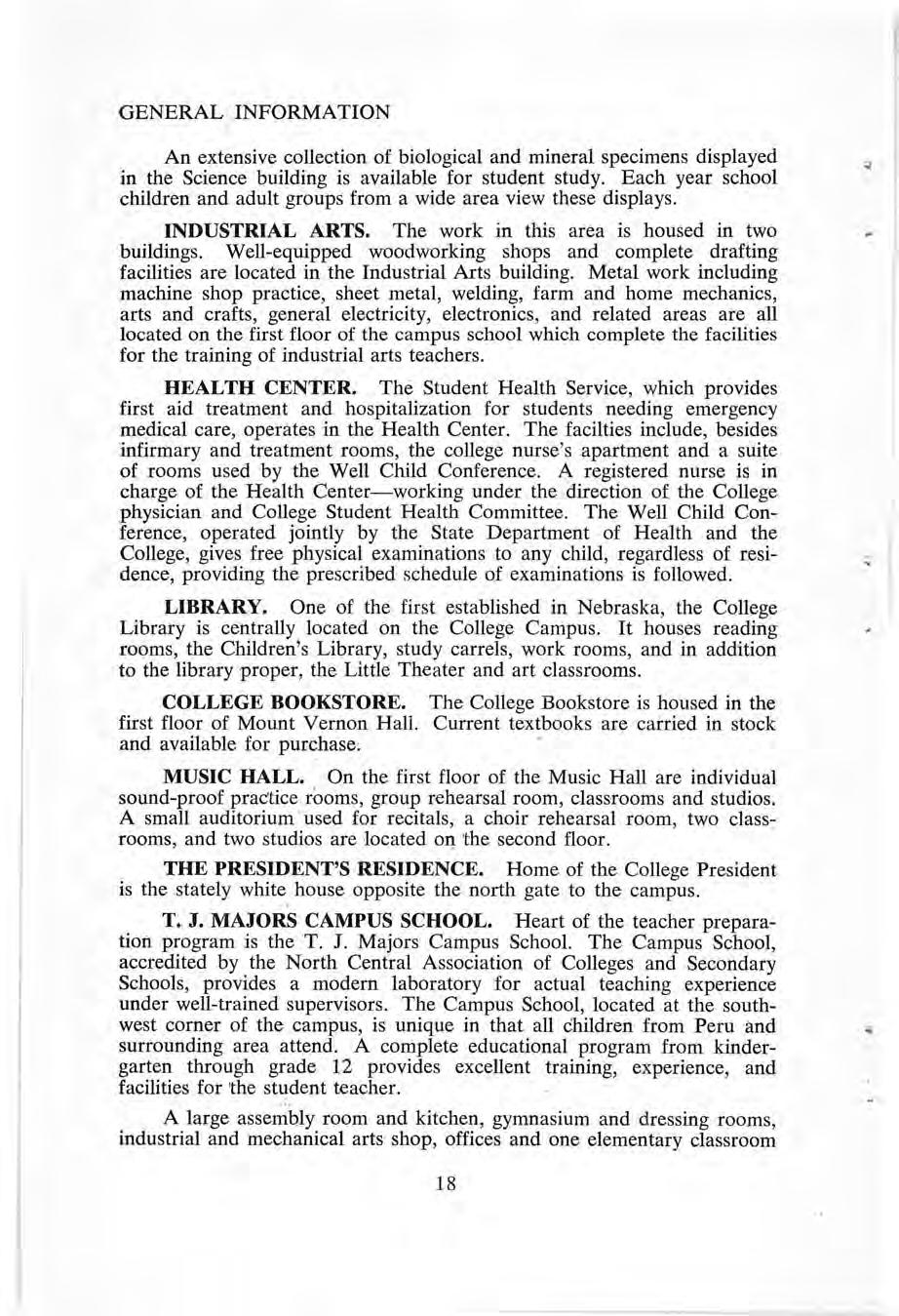
THE PRESIDENT'S RESIDENCE. Home of the College President is the stately white, house opposite the north gate to the campus.
T. J. MAJORS CAMPUS SCHOOL. Heart of the teacher preparation program is the T. J. Majors Campus School. The Campus School, accredited by the North Central Association of Colleges and Secondary Schools, provides a modern laboratory for actual teaching experience under well-trained supervisors. The Campus School, located at the southwest corner of the campus, is unique in that all children from Peru and surrounding area attend. A complete educational program from kindergarten through grade 12 provides excellent training, experience, and facilities for 'the student teacher.
A large assembly room and kitchen, gymnasium and dressing rooms, industrial and mechanical arts shop, offices and one elementary classroom
are located on the ground floor. The first floor houses the offices of the director and supervisors and elementary classrooms . High school classrooms and library, auditorium, science laboratories, and supervisors' offices are on the second floor. The south wing of the second floor houses the modern home economics department. The facilities include four unit kitchens, sewing laboratory with living-room area, and classroom and facilities for home, nursing practice ·
MARRlED STUDENT HOUSING. Five new housing units for married students were completed for occupancy September 1, 1956 . These housing units are located amid the park-like setting of some of Peru's thousand oaks just east of the Oak Bowl. Two of the units contain four two-bedroom apartments and three of the "units contain two onebedroom apartments . A stove, refrigerator, automatic washer and drier are furnished in each apartment. The apartments . are heated by gas furnaces.
FACULTY HOUSING. Two units for faculty apartments were completed during the summer of 1956 One of the units, a split level type structure, contains two two-bedroom apartments and two one-bedroom apartments. The second unit contains two two-bedroom apartments and two three-bedroom apartments .
OAK BOWL. The College' s natural bowl with its concrete stadium seating 2,500 is known throughout a wide area as the Oak Bowl. An elevated parking lot accommodating 60 automobiles provides additional seating accommodations for spectators at athletic events. A modern press box and concession stand are locatel:l on the stadium side of the bowl. Cement tennis courts are in an area south of the Oak Bowl. During the fall and winter of 1956-57 the area north of the Oak Bowl, formerly the site of Vetville, wa s converted into football practice fields and a baseball diamond. ·
NEW ACADEMIC BUILDING. Plans and specifications for a new Industrial Arts building to be located south of the Campus School are nearing completion. It is hoped the new building, which will house all Industrial Arts activities, will be re ady for occupancy' by the beginning of the second semester of the 1960-61 academic year . ·
NEW HOUSING FACILITIES. Ground will be broken for a new men's dormitory and an addition to ;Morgan Hall for women in the fall ,of 1959. The new facilities will provide accommodations for 90 men ~nd 68 women, increasing the normal capacity by one-third. These new hous:ing facilities should be ,.ready for occupancy by January 1, 1961.
NEW STUDENT UNION. As a companion building to the dormitories, a new Student Union building should be ready for occupancy sometime during the first semester of the 1960-61 academic year. This new, completely air-conditioned facility will house the college cafeteria, snack bar, general and faculty lounges, meeting _' rooms, publication offices, bookstore, private dining and party rooms. To make room for the new Student Union building and the addition to Morgan Hall , Mount Vernon Hall will be razed .
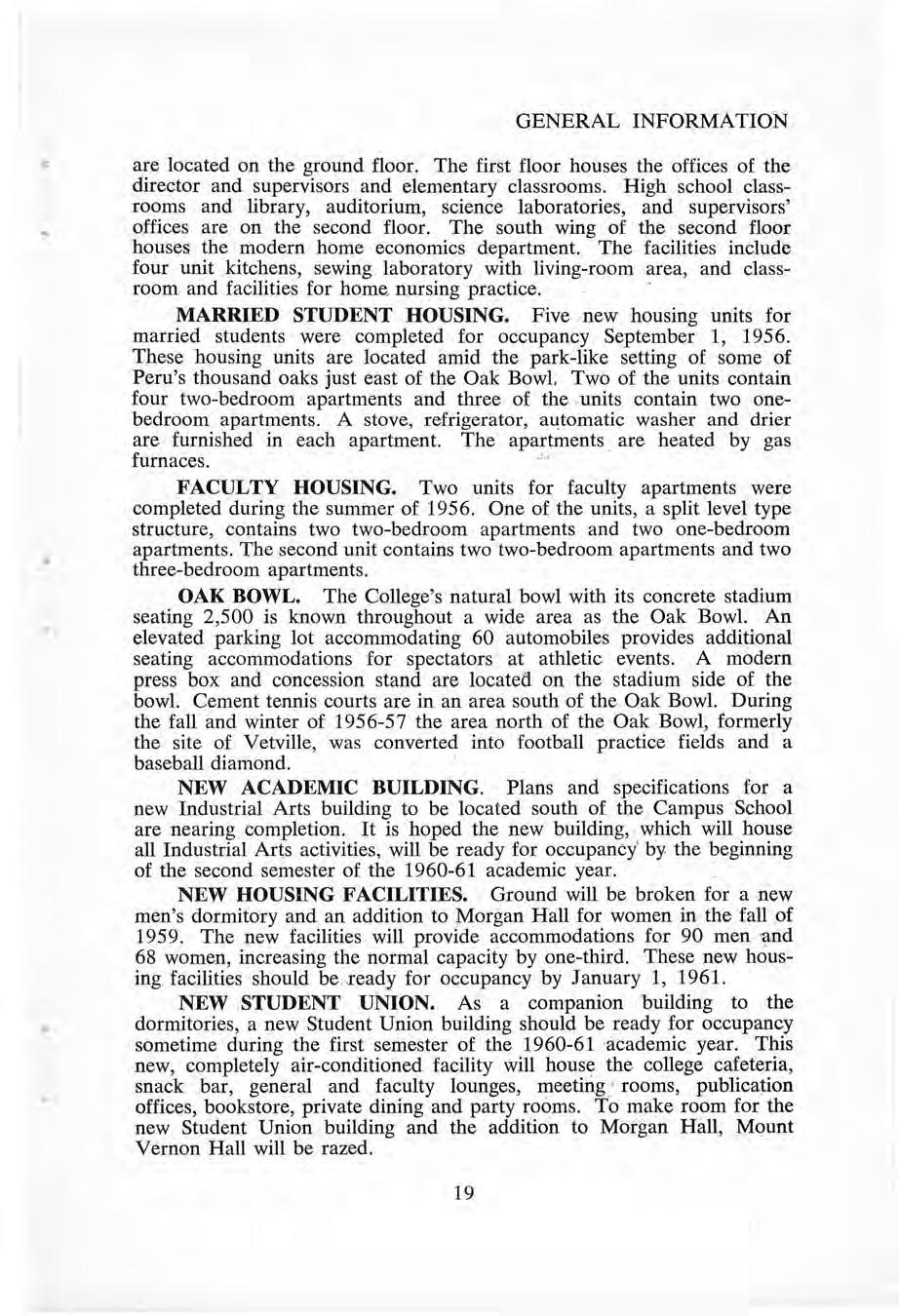
Peru Alumni Association membership includes all graduates and / or former resident students of Peru State College. (All members of the Peru Alumni Corporation, now dissolved , are members.) The Association sponsors luncheons, receptions and reunions during each academic year. Local Alumni Chapters, organized in Omaha and Lincoln in 1955, in Denver in 1957 and in Berkeley, Calif., in - 1958, sponsor activities for Peruvians in their area with the assistance of the alumni office at the College. Reunions of the 50-year class of the College are one of the highlights of commencement week activities. It is not uncommon for returning alumni each year to travel a total of 24,000 miles to return to the Campus of a Thousand Oaks and meet with their classmates.
The governing body of the association is the Alumni Executive Council, which is a working body for the promotion of college and alumni interests. Officers of the council are elected annually at Homecoming. Present members, elected in October, 1958, are:
President -----··- -
First Vice-President ·-----
Second Vice-President
-----·-··---··- - Al Stiers , ' 56, Johnson
- Harvey S. Ideus, '56, Hiawatha, Kans.
Ron Witt, '58, Millard
Secretary
Mrs. Doris Shearer Wuster, '57, Belgrade
Mary Ann Fuerst, '57, Superior Treasurer
Immediate past officers (1957 -58) include: President, Dell Miller, '52, Columbus; First Vice-President, Ned Eckman, ' 55, Tecumseh; Second Vice-President, Bill Bednar, '53, Tecumseh; Secretary, Lloyd Darrow, ' 49, Omaha; Treasurer, Bob Perry, '56, Elk Creek.
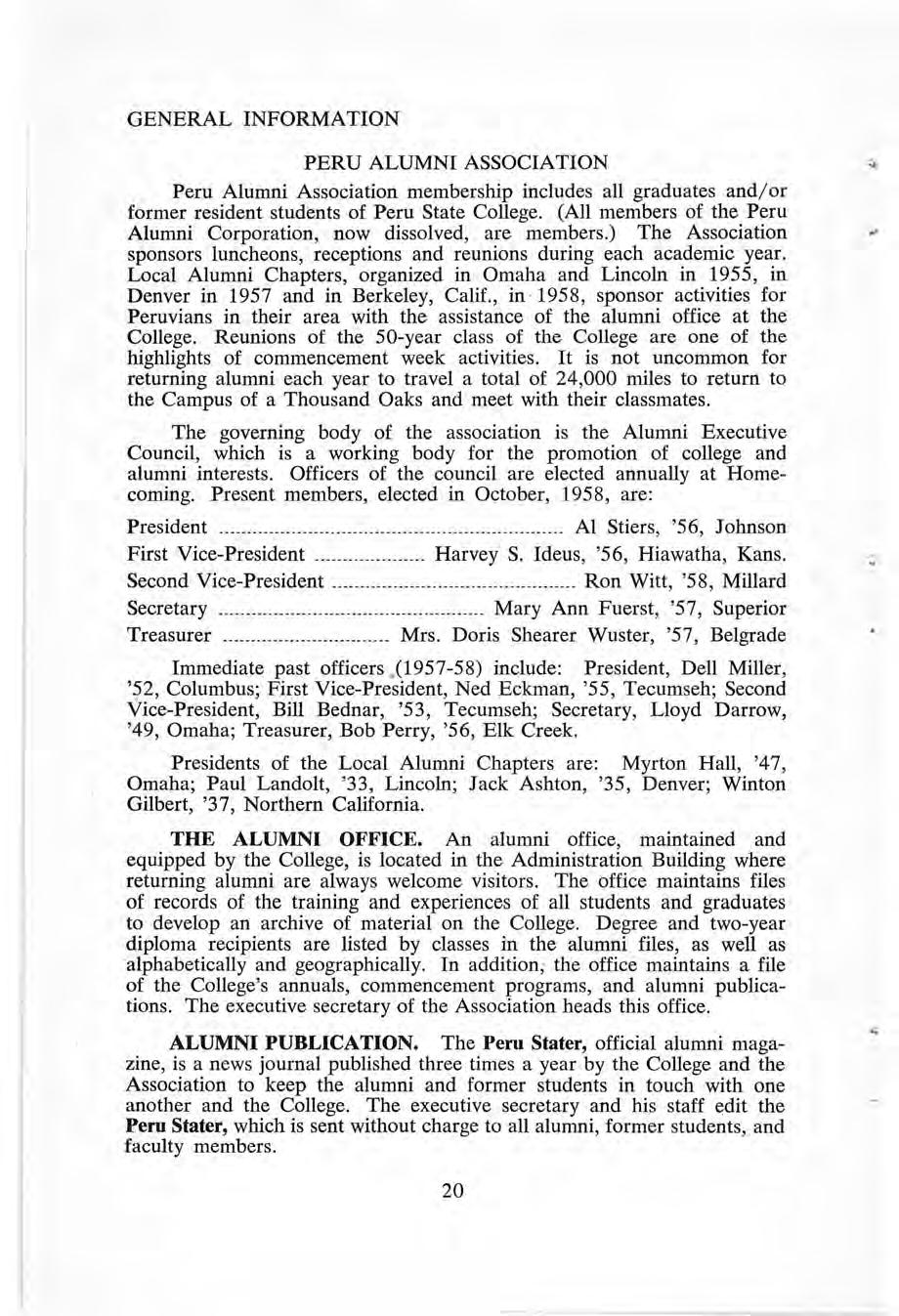
Presidents of the Local Alumni Chapters are: Myrton Hall , '47, Omaha; Paul Landolt, ' 33 , Lincoln; Jack Ashton, ' 35, Denver; Winton Gilbert, '37, Northern California.
THE ALUMNI OFFICE. An alumni office, maintained and equipped by the College, is located in the Administration Building where returning alumni are always welcome visitors The office maintains files of records of the training and experiences of all students and graduates to develop art archive of material on the College. Degree and two-year diploma recipients are listed by classes in the alumni files, as well as alphabetically and geographically. In addition ; the office maintains a file of the College's annuals, commencement programs, and alumni publications. The executive secretary of the Association heads this office.
ALUMNI PUBLICATION. The Peru Stater, official alumni magazine, is a news journal published three times a year by the College and the Association to keep the alumni and former students in touch with one another and the College. The executive secretary and his staff edit the Peru Stater, which is sent without charge to all alumni, former students, and faculty members.
Various graduating classes and other organizations have presented gifts to the college in the form of memorials. An early-day Peru group, the Fortnigh'tly Art Club, contributed a frieze, statuary and other works of art. A statue of Horace Mann, housed in the Auditorium with the gifts of the Fortnightly Art Club, was given by the class of 1898. The class of 1903 contributed the clock in the library. A picture of the Shaw Memorial, which hangs in the rear of the Auditorium, was the gift of the class of 1908. The outdoor drinking fountain was given by the class of 1911, the campus lighting system was presented by the class of 1914, and the brick portals at the north entrance to the campus were contributed by the class of 191'5. The sun dial and fountain in the formal garden east of the Administration building were the gifts of the classes of 1920 and 1929, respectively, and the walks from the campus to the Oak Bowl were given by the class of 1924. The bell system was presented to the College by the classes of 1927, 1928 and 1930 and the Philomathean Literary society . The fans in the Library and Auditorium were the gifts of the classes of 1931, 1932, 1933, 1934 and 1935. The drinking fountain in the Science building was given by the class of 1936.
The College Library is considered one of the best college library collections in the state. It consists of approximately 60 ,000 volumes, including standard reference works, periodical guides and indexes, and special collections. Both book and non-book material is available for use Two hundred twenty-five periodicals are received regularly by subscription, with a large number bound for permanency. The Library subscribes to several leading metropolitan newspapers and many weekly Nebraska newspapers. Emphasis is placed on the field of education in both book and non-book acquisitions, however, the needs of other sub ject areas included in the college curriculum are not slighted.
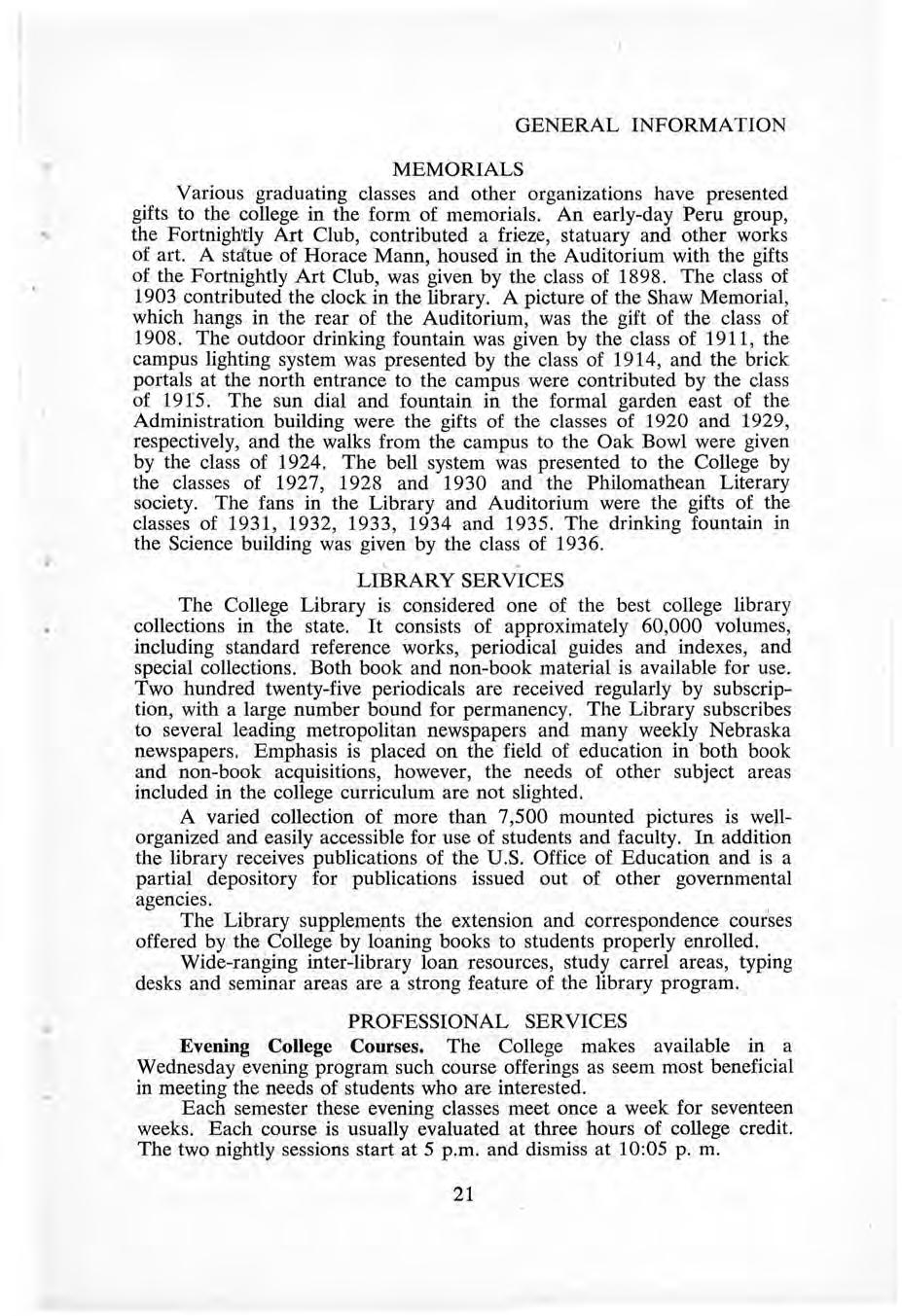
A varied collection of more than 7 ,500 mounted pictures is wellorganized and easily accessible for use of students and faculty. In addition the library receives publications of the U.S. Office of Education and is a partial depository for publications issued out of other governmental agencies
The Library suppleme,nts the extension and correspondence cour'ses offered by the College by loaning books to students properly enrolled. Wide-ranging inter-library loan resources, study carrel areas, typing desks and seminar areas are a strong feature of the library program.
Evening College Courses. The College makes available in a Wednesday evening program such course offerings as seem most beneficial in meeting the needs of students who are interested.
Each semester these evening classes meet once a week for seventeen weeks. Each course is usually evaluated at three hours of college credit. The two nightly sessions start at 5 p.m. and dismiss at 10:05 p. m.
Day College students are not eligible except by consent of the Dean of the College.
Graduate College Courses. Courses for graduate credit are offered on Wednesday evenings or Saturday mornings, whichever tiQJ.e meets the desires of a majority of the students who are interested.
Off-Campus Courses. Off-campus courses are made available at study center sites within the geographical service area of the College. The best practice in organizing a study center class is to work through the office of the County Superintendent of Schools. The courses which are available depend upon priority of requests and the available instructional personnel. Such information is publicized by County School Superintendents and by direct mail at the beginning of each semester. Undergraduate credit, only, is offered.
Speakers and Entertainment Services. Schools, civic, and educational organizations are invited to make use of speakers and entertainment made available through the College. Faculty members are available to speak throughout the year, as well as for commencement addresses in high schools. Musical and dramatic programs, demonstrations, debates and lecture s also may be arranged through the College.
Teacher Placement. Peru State College maintains a Placement Office where the primary motive is to render the best pos si ble service to students and alumni who wish to find desirable teaching positions. While graduates are not guaranteed positions , in recent years the office has received many more calls for Peru-trained teachers than can be met. Graduates have come to look upon the Pl acement Office as a quick and economical means of finding the best possible teaching situation.
Commercial Placement. The College maintains contact with business and indu stry in order to find openings for Peru students who are trained for careers in business.
Each year that vacancy listings are sent to Placement Bureau members a charge of two dollars is made. This fee also includes cost of mailing credentials to prospective employers. Vacancies are sent out periodically to those registered for this service. It is the responsibility of Placement Bureau members to keep their credentials up-to-date with additional references, experience, and college work completed since last active enrollment in the Bureau. A form on which to add new information to credentials will be sent upon request.
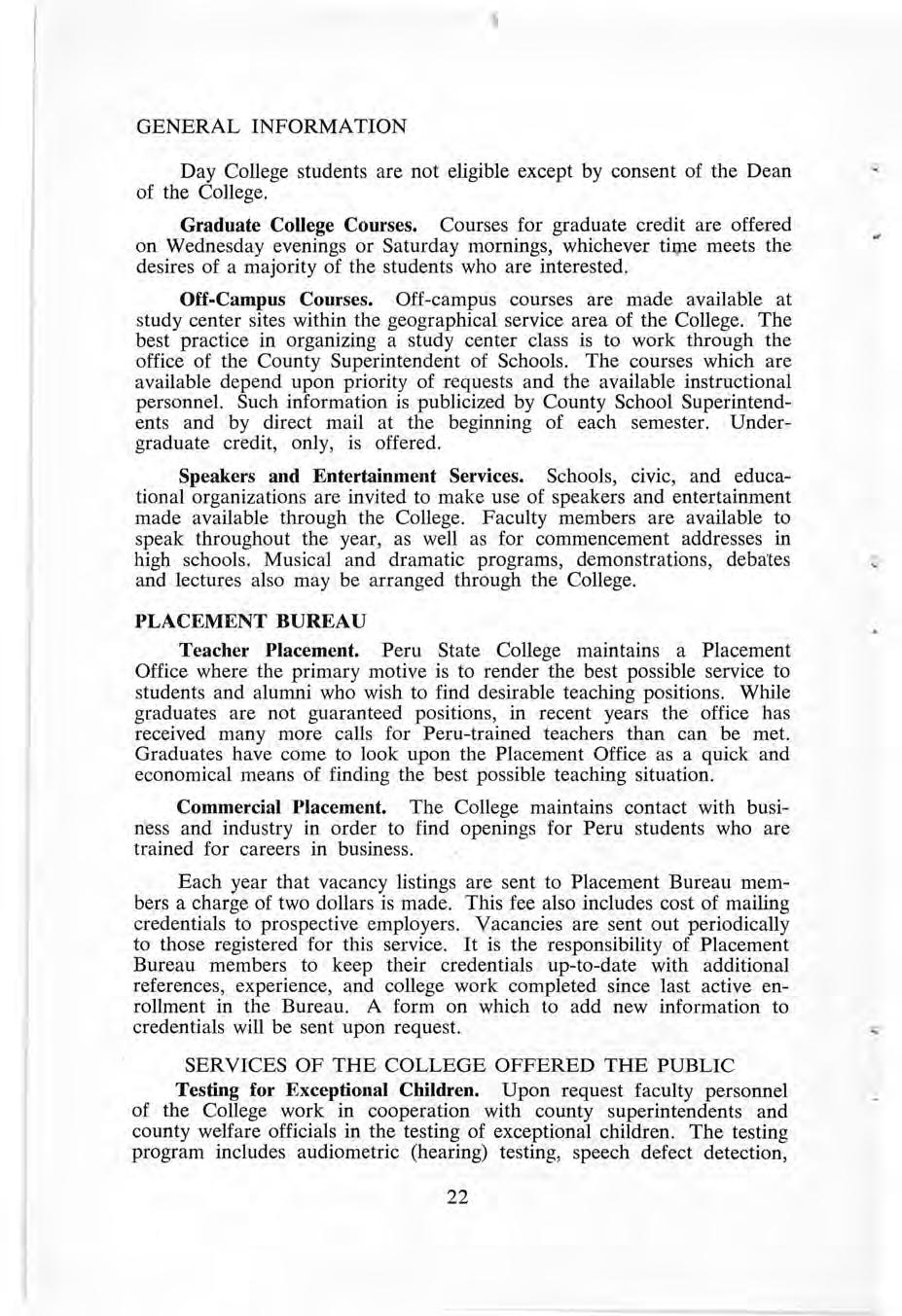
for Exceptional Children. Upon request faculty personnel of the College work in cooperation with county superintendents and county welfare officials in the testing of exceptional children. The testing program includes audiometric (hearing) testing , speech defect detection ,
administration of Stanford-Binet mental tests, achievement, personality and vocational interest tests. Inquiries about this service should be directed to Dean of the College. ·
Testing of Pre-School Children. Late each summer the counseling and guidance staff administers tests to pre-school children in the area to determine if the child is ready for entry into kindergarten before the age of five, as prescribed by law. The tests are given in county seats in the area and at the College by appointment. Further information may be received by writing the Dean of the College
Well Child Conference. Any child, from six months to six years of age , regardless of residence, whos~ parents will bring the child for regularly-scheduled examinations, is eligible to attend the Well Child Conference conducted on the Peru State College campus . The clinic is held the first and third Tuesdays of each month. Conducted by the College in cooperation with the State Department of Health, the conference is one of the first in the nation to be u sed as a training center for student teachers . The fact that Peru State student teachers assist with its operation has brought observers from health and educational institutions throughout the nation to study the setup. Details of the program may be obtained by \¥ riting Well Child Conference , Peru State College.
Identification of Science Specimens. The science faculty aids the public in the identification of plants, animals and geological specimens brought or sent to the college laboratories .
Film and Record Service. An educational film and record library is main'tained by the College for the us e of schools, civic and educational groups in the area as well as the College. More than 210 films and 100 record albums are available to these groups. A catalog of available records and films may be obtained by writing to the director of audiovisual services .
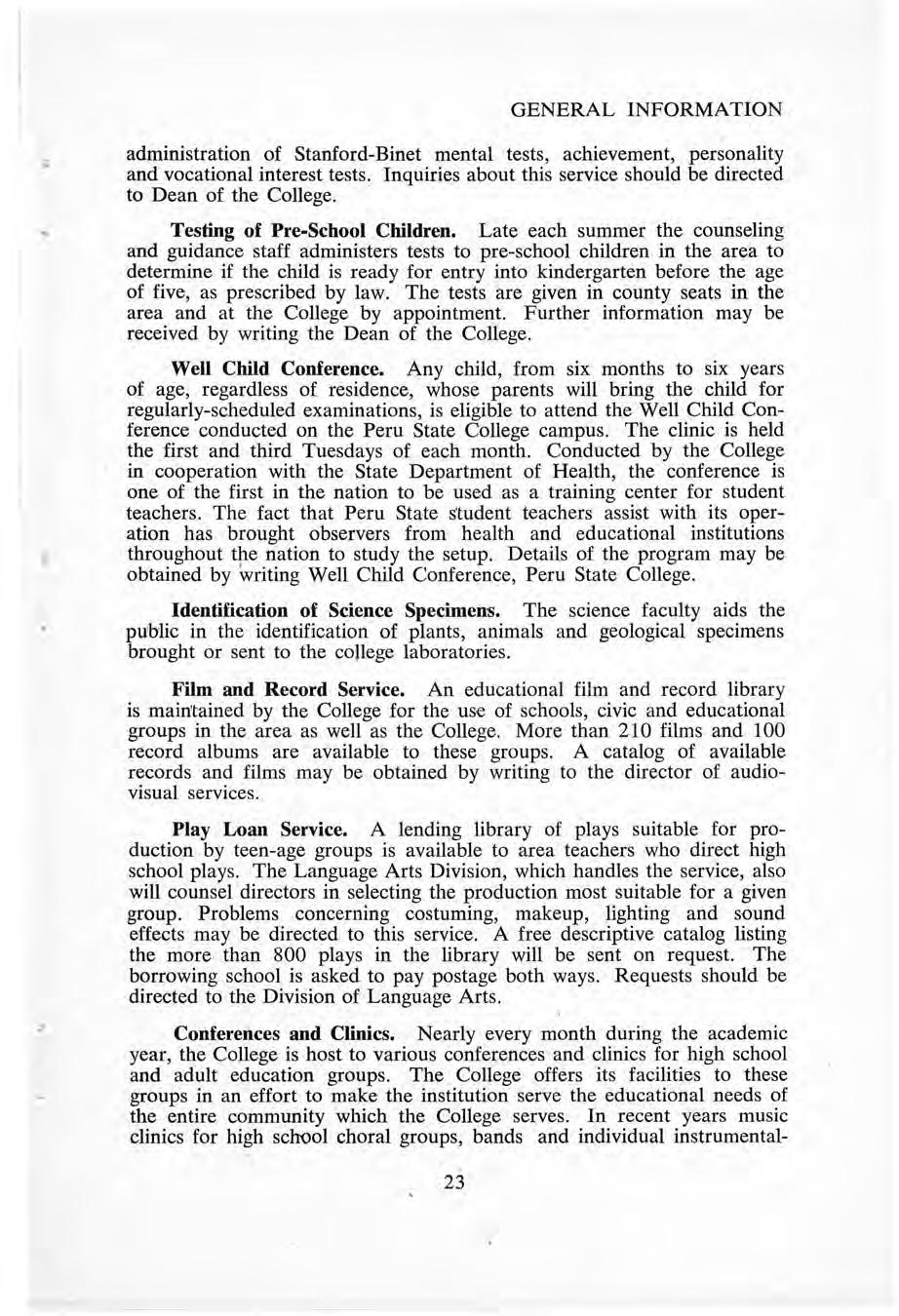
Play Loan Service. A lending library of plays suitable for production by teen-age groups is available to area teachers who direct high school plays . The L a nguage Arts Division, which handles the service, also will counsel directors in selecting the production most suitable for a given group. Problems concerning costuming, makeup, lighting and sound effects may be directed to this service. A free descriptive catal0g listing the more than 800 plays in the library will be sent on request . The borrowing school is asked to pay postage both ways. Requests should be directed to the Division of Language Arts.
Conferences and Clinics. Nearly every month during the academic year, the College is host to various conferences and clinics for high school and adult education groups. The College offers its facilities to these groups in an effort to make the institution serve the educational needs of the entire community which the College serves In recent years music clinics for high school choral groups, bands and individual instrumental-
ists; clinics in speech and dramatics; conferences and meetings of fraternal and civic groups, women ' s social and educational organizations, the Rural Youth of America organization, and special interest groups, such as swimming pool operators, have been held on the campus. The students from the State School for the Blind at Nebraska City make regular use of the College swimming pool and other recreational facilities in the Gymnasium.
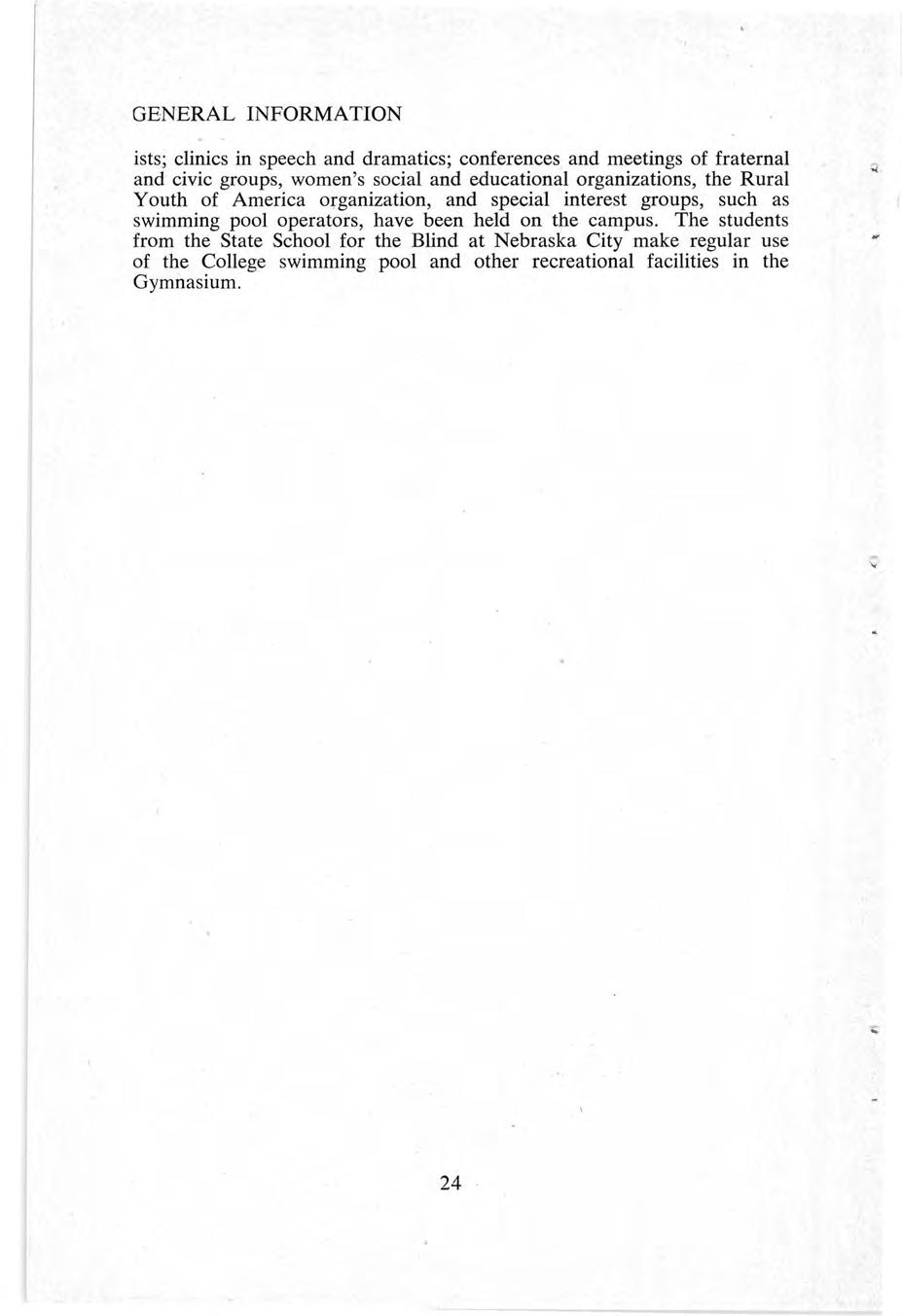
Students seeking admission to the College should write to the Registrar for official forms. The forms)nclude the Application for Adminission to be prepared by the s'tudent and the uniform Nebraska Transcript of High School Record form to be completed in duplicate by the high school principal. These completed forms should be returned well in advance of the time of registration to facilitate arrangements before the student arrives.
Full Admission. High school graduates may receive full admission to freshman standing with a minimum of 160 high school semester hours (16 units) from a four-year high school and the recommendation of the high school principal or superintendent. Although no specific distribution of entrance units is necessary, it is recommended that at least half of the units earned represent work in English, foreign language, mathematics, natural science and socia'l st udie s.
Conditional Admission. Students who have 150 high school semester hours (15 units) or the equivalent for high school graduation, are admitted to freshman standing on condition that their work proves satisfactory during the fitst year in college. Appropriate college courses may be recommended in fields where the student is deficient upon admission. Mature individuals who are not high school graduates, who are otherwise prepared and recommended for college work, may be admitted as special students. A college aptitude test and the GED (General Education Development) tests are administered . in judging the individual's qualifications for admission.
Advanced Standing. This implies attainment beyond the minimum for admiss ion to the college. This status may be acquired by, (1) presenting work completed in another college; (2) demonstrating proficiency in a certain field, thus removing the requirement of certain prerequisites. The latter may be with or without credit.
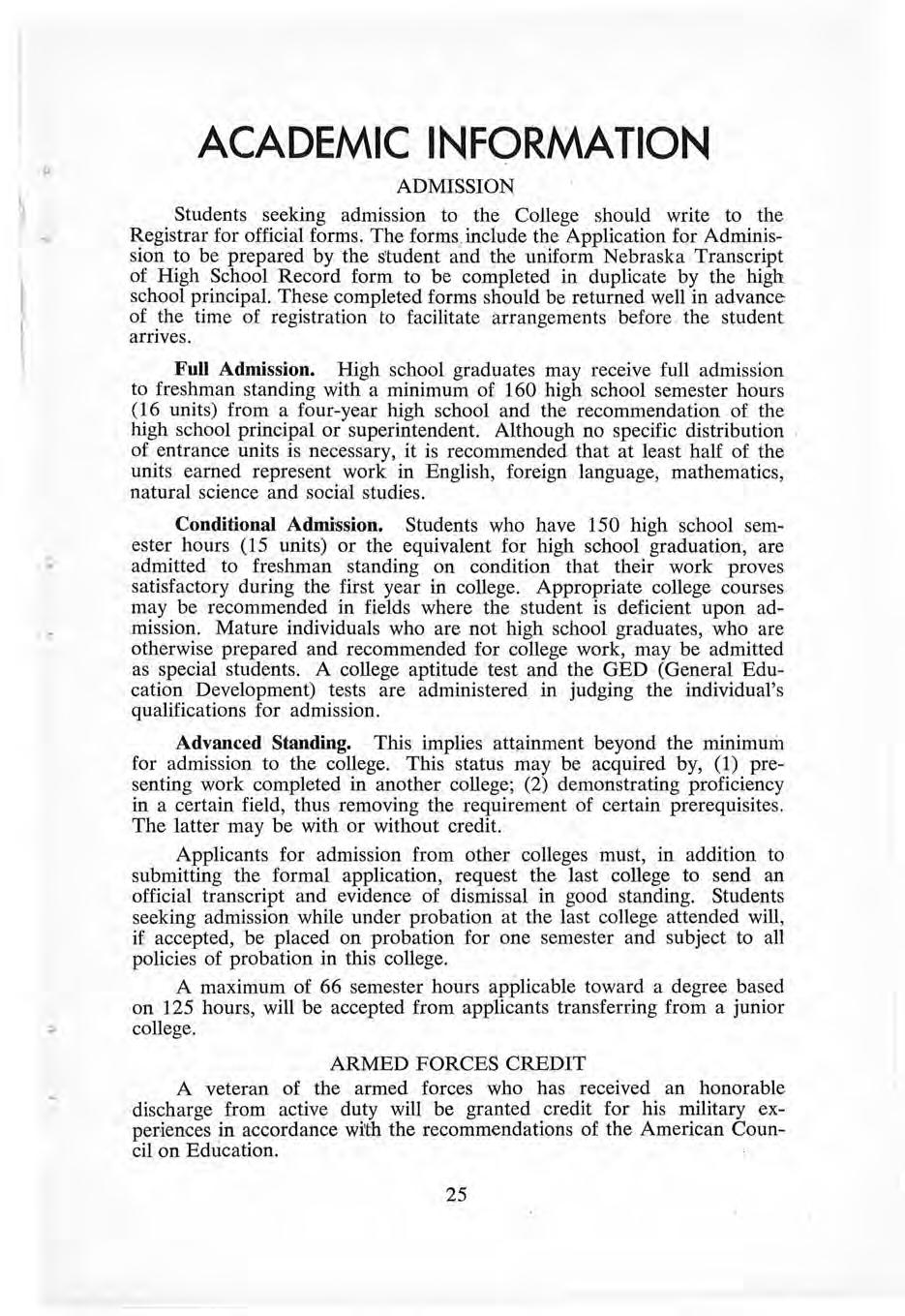
Applicants for adm is sion from other colleges must, in addition to submitting the formal application, request the last college to send an official transcript and evidence of dismissal in good standing. Students seeking admission while under probation at the last college attended will, if accepted, be placed on probation for one semester and sub ject to all policies of probation in this college.
A maximum of 66 semester hours applicable toward a degree based on 125 hours, will be accepted from applicants transferring from a junior college.
A veteran of the armed forces who has received an honorable discharge from active duty will be granted credit for his military experiences in accordance with the recommendations of the American Council on Education.
An example of the personal interest shown each student at Peru is · found in the College's cooperation with officials of the Nebraska Vocational · Rehabilitation Program for the physically handicapped. The program helps those persons over 16 years of age, who have some handicapping condition, to become more economically sufficient. It provides necessary financial aid for further training, counseling, job placement and follow-up help.
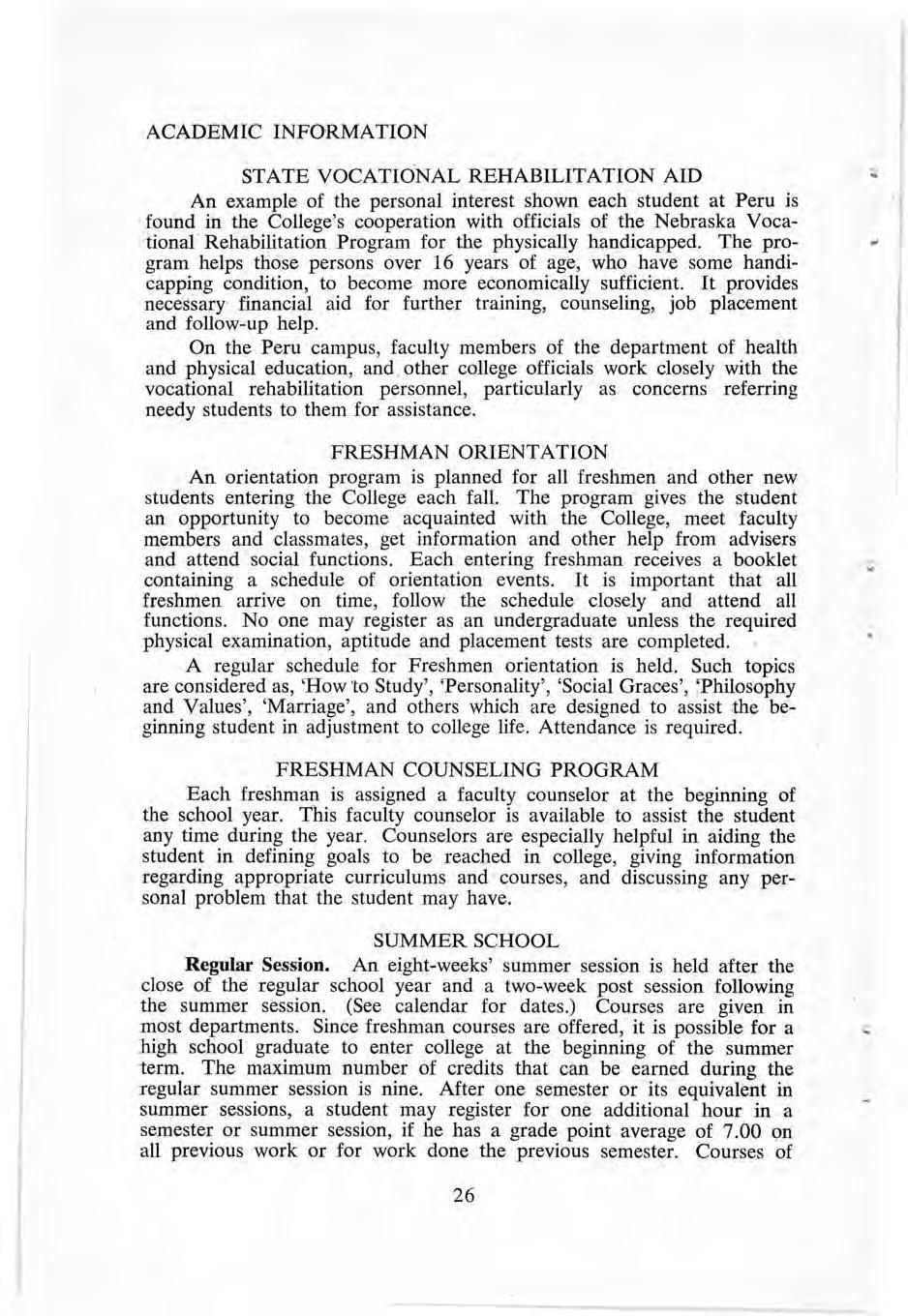
On the Peru campus, faculty members of the department of health and physical education, and . other college officials work closely with the vocational rehabilitation personnel, particularly as concerns referring needy students to them for assistance.
An orientation program is planned for all freshmen and other new students entering the College each fall. The program gives the student an opportunity to become acquainted with the College, meet faculty members and dassmates, get information and other help from advisers and attend social functions. Each entering freshman receives a booklet containing a schedule of orientation events. It is important that all freshmen arrive on time, follow the schedule closely and attend all functions. No one may register as ,an undergraduate unless the required physical examination , aptitude and placement tests are completed.
A regul ar schedule for Freshmen orientation is held. Such topics are considered as, 'How 'to Study' , 'Personality', 'Social Graces' , 'Philosophy and Values' , 'Marriage', and others which are designed to ass ist the beginning student in adjustment to college life . Attendance is required.
Each freshman is assigned a faculty counselor at the beginning of the school year. This faculty counselor is available to assist the student any time during the year. Counselors are especially helpful in aiding the student in defining goals to be reached in college, giving information regarding appropriate curriculums and courses, and discussing any personal problem that the student may have. ·
Regular Session. An eight-weeks' ·summer session is held after the close of the regular school year and a two-week post session following the summer session. (See calendar for dates.) Courses are given in most departments. Since freshman courses are offered, it is possible for a high school graduate to enter college at the beginning of the summer term. The maximum number of credits that can be earned during the regular summer session is nine. After one semester or its equivalent in summer sessions, a student may register for one additional hour in a semester or summer session, if he has a grade point average of 7 .00 on all previous work or for work done the previous semester. Courses of
special interest to teachers also are offered. Some of these courses are not obtainable during the regular school year. Copies of the summer school catalog may be secured from the Registrar or the Department of Special Services.
Post Session.. A post session is available for those students who wish to earn more than nine hours of credit during the summer period or those who may be able to attend only a short time . A maxirpurii of three semester hours of credit may 1be earned in the two~week ' post session. The courses offered are determined by the demand of the people interested.
Graduate Program. A graduate program is offered during only the • summer session. A student may qualify for a Master of Science in Education or a Master of Arts in Education. The program of studies includes elementary education, secondary education, public school administration and supervision, and psychology and guidance. Details of the graduate program are described in the catalog of graduate study. Further information may be obtained by writing the Dean of College.
Correspondence study (extension) is offered to a limited extent for employed individuals who cannot conveniently avail themselves of resident study facilities. However, it is recommended that a student should first have established a satisfactory record for a semester or more in resident study before planning correspondence study . Not more than one-eighth of the total hours required for a diploma or a degree may be earned by correspondence. Regular day students carrying a full load cannot be approved for correspondence study at the same time . For bulletin on course offerings and more complete information write to the Office of the Registrar.
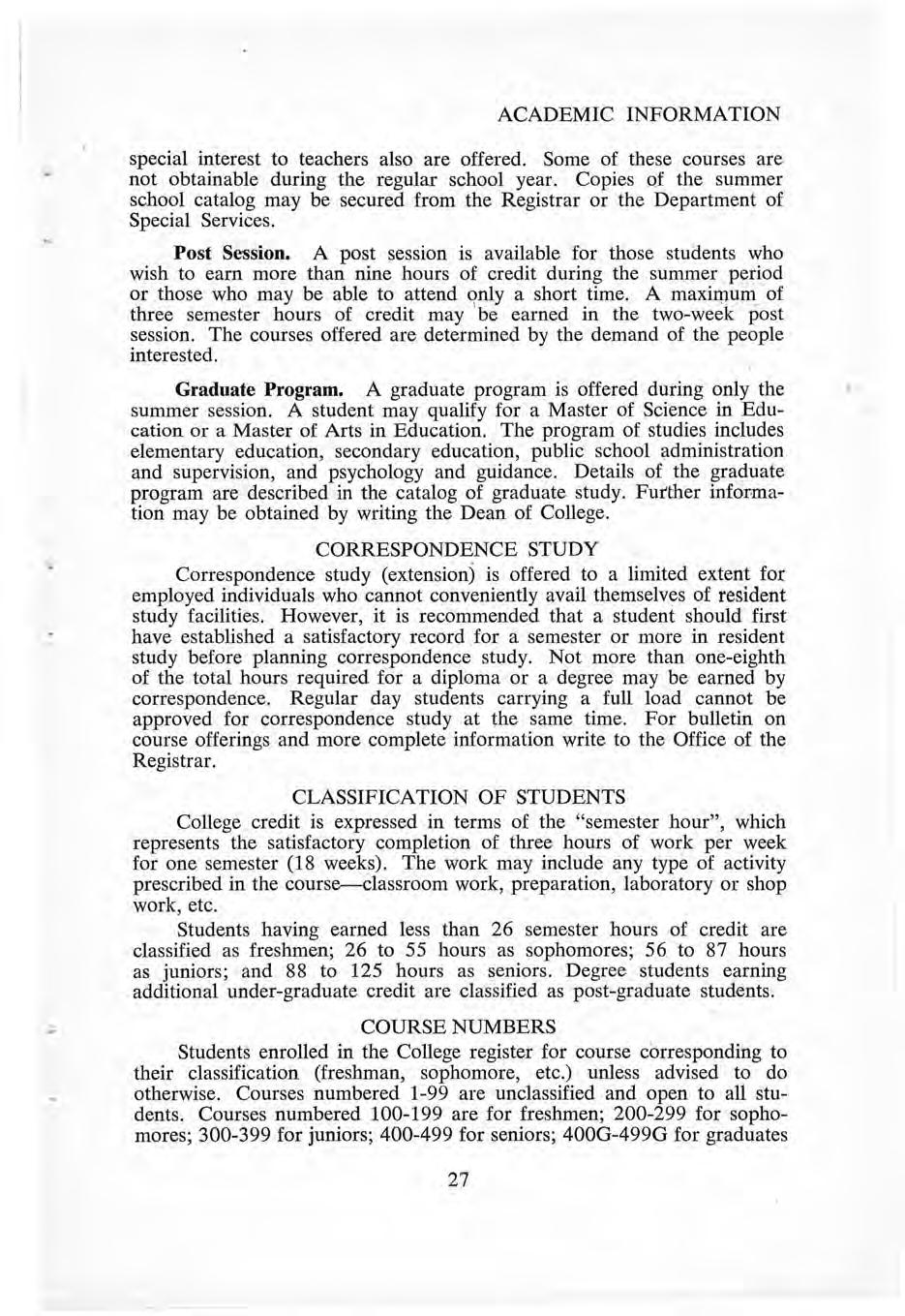
College credit is expressed in terms of the "semester hour", which represents the satisfactory completion of three hours of work per week for one semester (18 weeks). The work may include any type of activity prescribed in the course-classroom work, preparation, laboratory or shop work, etc.
· Students having earned less than 26 semester hours of credit are classified as freshmen; 26 to 55 hours as sophomores; 56 to 87 hours as juniors; and 88 to 125 hours as seniors. Degree students earning additional under-graduate credit are classified as post-graduate students.
Students enrolled in the College register for course corresponding to their classification (freshman, sophomore, etc .) unless advised to do otherwise. Courses numbered 1-99 are unclassified and open to all students . Courses numbered 100-199 are for freshmen; 200-299 for sophomores; 300-399 for juniors; 400-499 for seniors; 400G-499G for graduates
and seniors; 500-599 for graduates. Upper division students, in courses denoted by dual numbers (i.e., Ed. 201/301) are automatically required to do the work for the higher number.
Maximum number of hours credit which may be earned by a freshman during the first full semester is 17; nine is the load limit for a freshman in a summer session. After one semester (or its equivalent in summer sessions) a student may register for one additional hour in a semester or in a summer session, if he has obtained a 7.00 grade point average on all previous work done in the College, or for work done the previous semester.
Departmental Assistants are positions open to students in their field of concentration. Generally these pos,itions are intended for students who will enter graduate study directly upon graduation from Peru. As an Assistant, the student assists with preparation, administration, and elvaluation of tests in lower division classes , and assists with various other classroom activities which will give him first hand experience. . The position of Departmental Assistant carries no hours of credit . However, the experience is recognized by being placed upon the student's permanent record and becoming a part thereof.
'Students are expected to attend ·classes regularly, arrive punctually and do all assigned work in each class The student agrees to this when he registers for a course. Attendance is a privilege and a responsibility represented not only by the student's investment but also a considerable investment by the State.
Whenever the absences of a student reach the point of being detrimental to the student's standing in a class , the instructor will report same to the Dean of Students . The Dean of Students will hold a conference with the instructor and the student a't which time it will be determined whether or not the student will be allowed to continue in the class .
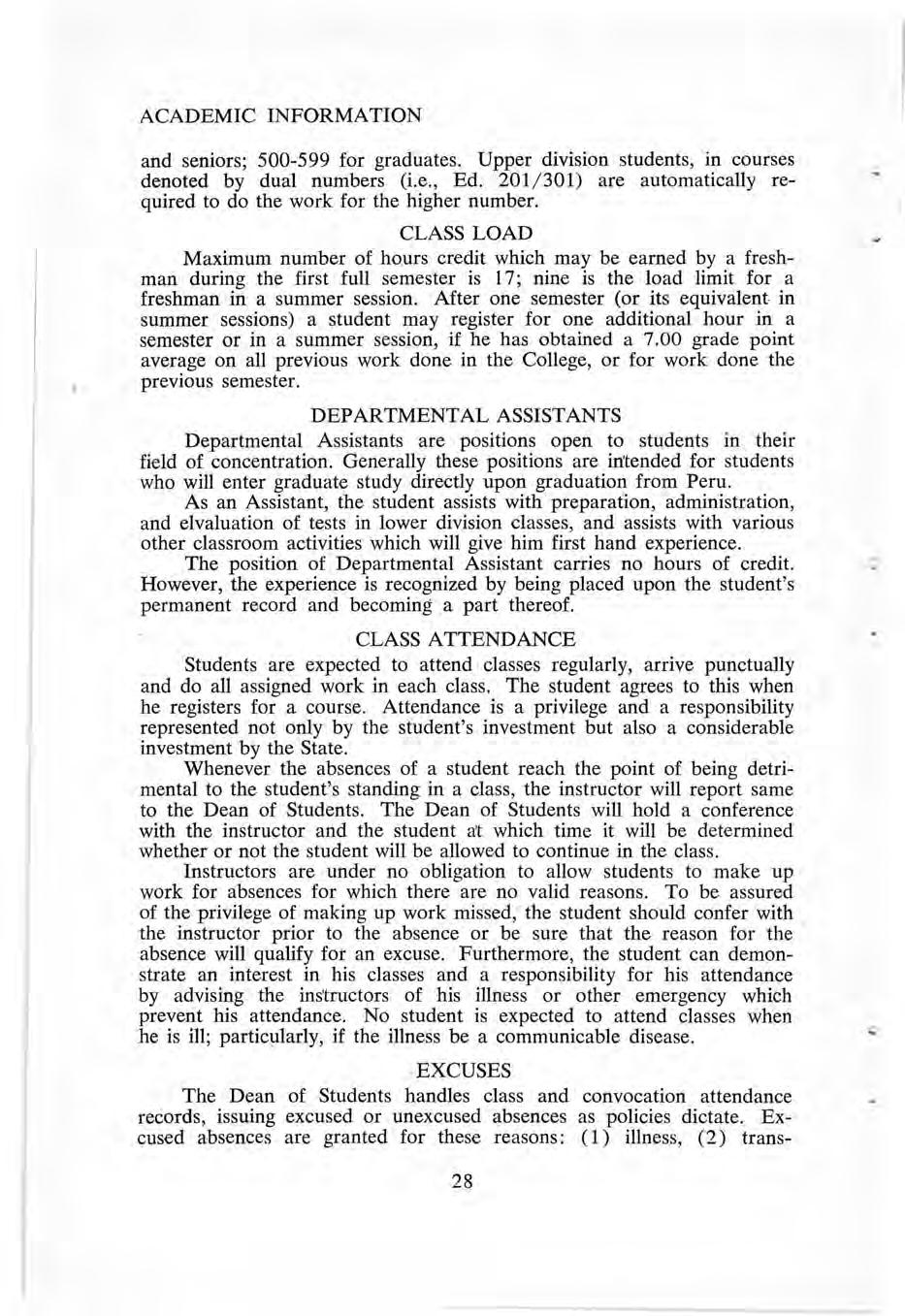
Instructors are under no obligation to allow students to make up work for absences for which there are no valid reasons. To be assured of the privilege of making up work missed ; the student should confer with the instructor prior to the absence or be sure that the reason for the absence will qualify for an excuse. Furthermore, the student can demonstrate an interest in his classes and a responsibility for his attendance by advising the ins'tructors of his illness or other emergency which prevent his attendance. No student is expected to attend classes when be is ill ; particµlarly, if the illness be a communicable disease.
The Dean of Students handles class and convocation attendance records, issuing excused or unexcused absences as policies dictate. Excused absences are granted for these reasons:
(1) illnes s, (2) trans-
portation difficulties, (3) college-sponsored activities ,- (4) illness in immediate family, (5) funerals, (6) service-connected orders, e. g., reporting for physical examinations . Students are expected to notify their instructors and the Dean of Students of anticipated absences. Illness permits from the college nurse or physician are presented directly to the Dean of Students
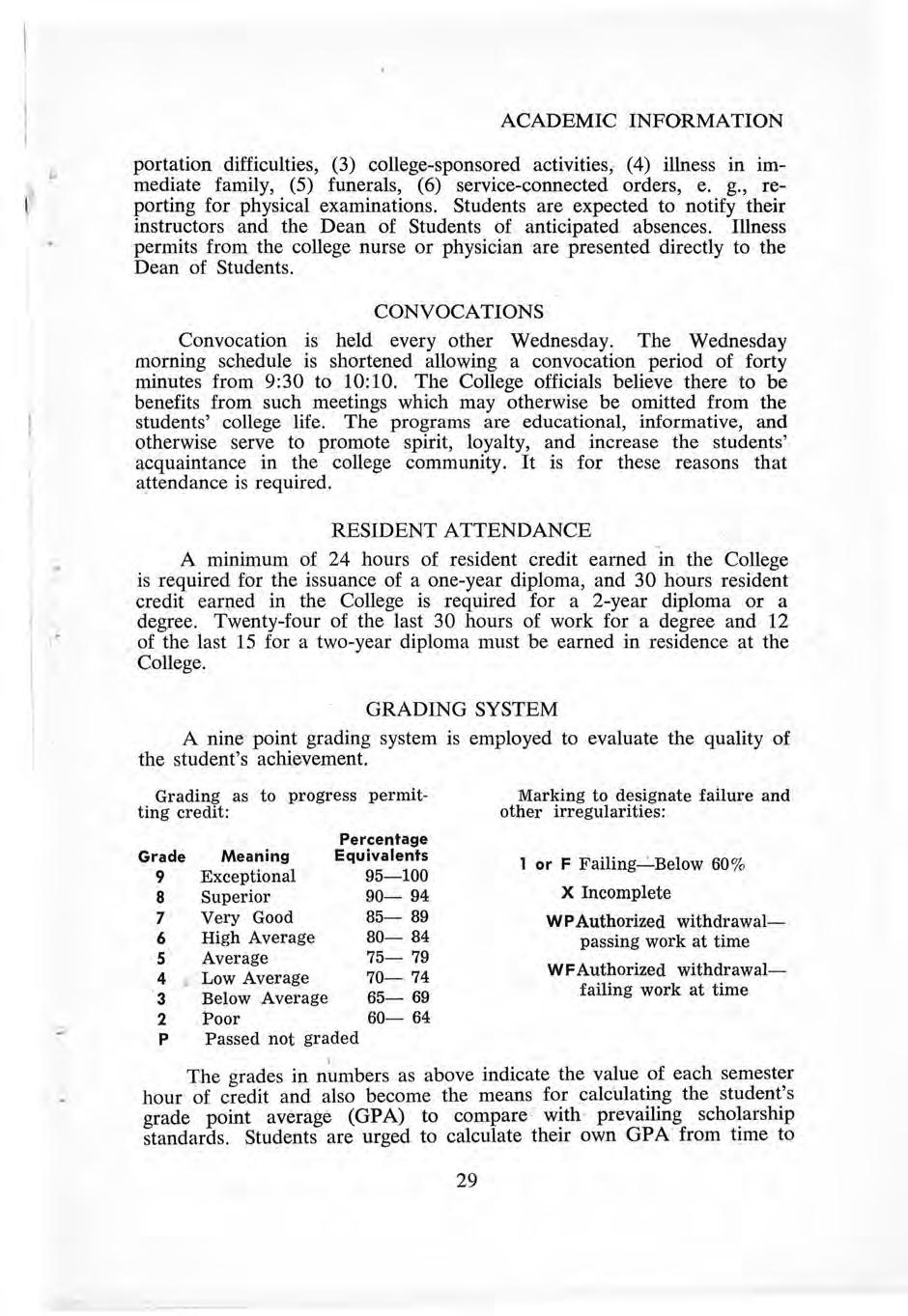
Convocation is held every other Wednesday. The Wednesday morning schedule is shortened allowing a convocation period of forty minutes from 9:30 to 10: 10. The College officials believe there to be benefits from such meetings which may otherwise be omitted from the students' college life. The programs are educational, informative, and otherwise serve to promote spirit, loyalty, and increase the students' acquaintance in the college community. It is for these reasons that attendance is required.
A mm1mum of 24 hours of resident credit earned in the College is required for the issuance of a one-year diploma, and 30 hours resident credit ear1,1ed in the College is required for a 2-year diploma or a degree. Twenty-four of the last 30 hours of work for a degree and 12 of the last 15 for a two-year diploma must be earned in residence at the College.
A nine point grading system is employed to evaluate the quality of the student' s achievement.
Grading as to progress permitting credit:
Marking to designate failure and other irregularities:
or F Failing...'....Below 60 %
X Incomplete
WP Authorized withdrawalpassing work at time
W F Authorized withdrawalfailing work at time
The grades in numbers as above indicate the value of each semester hour of credit and also become the means for calculating the student's grade point average (GPA) to compare with · prevailing scholarship standards Students are urged to calculate their own GPA from time to
time and realize their own status. The following two examples will be valuable in understanding .the calculations :
GPA = 117+16 = 7.31
(This GPA subjects the students
(This GP A at close of term rates to Probation.) ,:, This effects a lower GPA since distinction.) credit value is par t of divisor.
*When credit is ungraded, it is If WP the credit value is not not included in divisor for GPA. used.
Incomplete (X) work may be completed and cleared through the instructor to earn a passing mark , and this must be done within the next semester of full-time enrollment or the record will show 1 or F (Failing).
The Personnel and Scholarship Committee follows the educational progress of all students, provides assistance and ene0uragement, and makes recommendation on the disposition of unusual cases. Grades are reviewed at the end of each nine-week period. Freshman students who, at the end of either the first or second semester, have a grade point average of less than 3.00 for the minimum 12-hour load are placed on scholastic probation the following semester . Students above freshman classification having a grade point average of le ss than 3.50 at the end of any semester are likewise placed on scholastic probation .
Probation., At the close of a semester when ftnal reports are in the Registrar 's office from all instructors , scholastic probation is placed over those students who have not reached the minimum GPA as ab9ve on their classification. This probation applies to the following semester and the student may not enroll for more th an 15 hours. During this semester on probation it is hoped that he will maintain a GPA of 3.00 ot 3.50 and higher as to his classification to restore him to good standing. In case he fails to meet the ,i required GPA during the se mester, he may be suspended for one semester or for an indefinite period by the Personnel and Scholarship Committee. When a student is readmitted after a period of suspension, he must show satisfactory progress or the next suspension becomes permanent . A transfer student, whose record reveals dismissal or probation as 'to another institution, may be admitted on probation for a semester and be limited to a 15-hour registration wherein be must show a GPA of 3.00 or 3.50 as to his classification ~n order to continue in good standing.
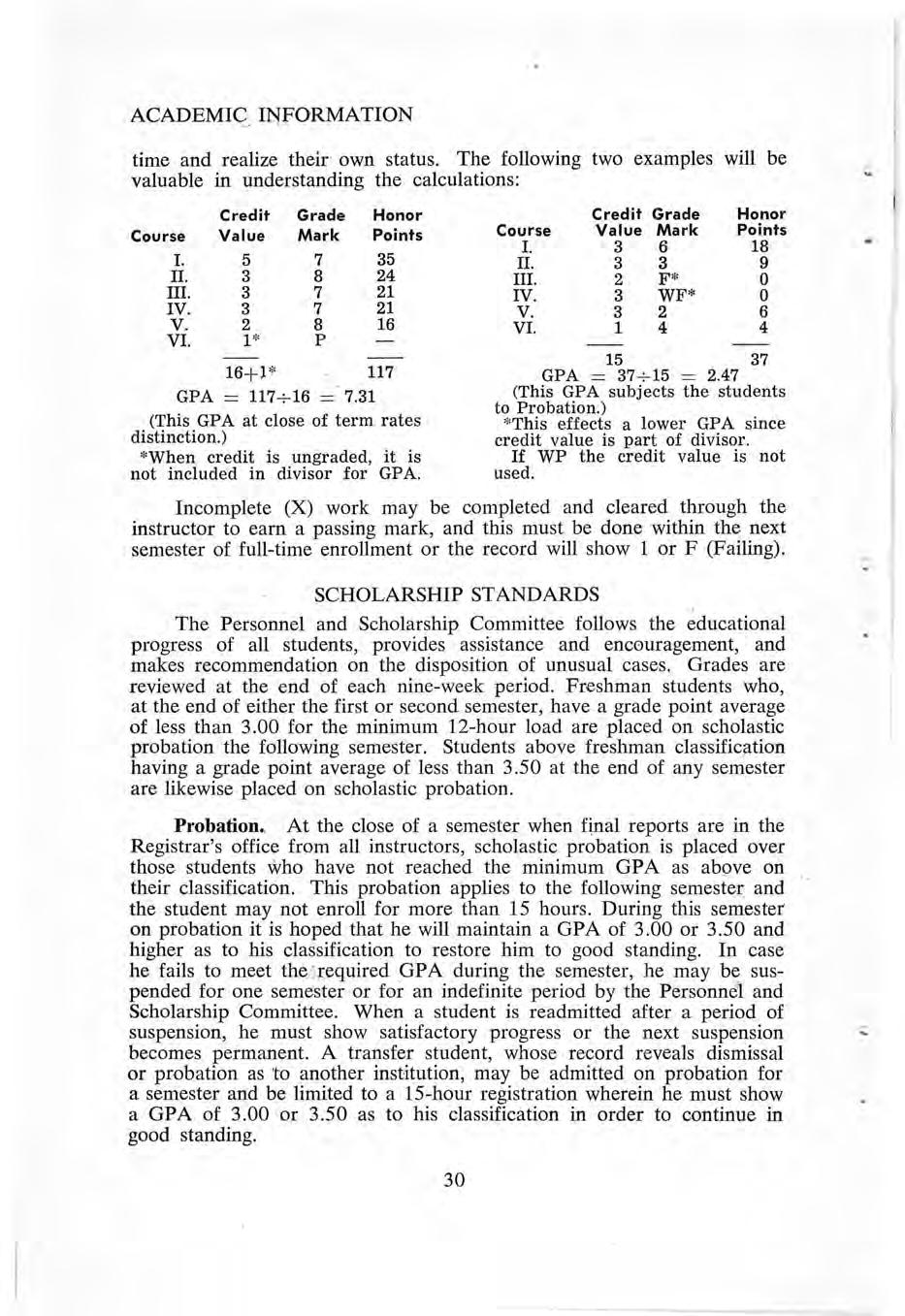
Teacher Preparation. In addition to employing counseling procedures to guard against unproductive educational programs, the College maintains fixed minimum standards of scholarship for teacher-preparation curriculums. For admission to the teacher-preparation curriculum the student's record at the time must show a GPA of 5.00, or the equivalent, if transfer grades must be considered .
Graduation and Certification. To qualify for graduation and being recommended by the College for certification, the student's cumulative record on all graded hours in the College must show a GPA of 4.00 or higher. As to the student's fields of concentration approved for the degree, he must have a GPA of 5.00 on each field of concentration with no grade below 4.00.
Students, who by reason of experience and / or personal improvement, may qualify for credit in courses through the procedure of an interview and a written examination. The student must, through an interview, satisfy a faculty committee that he has had a formal or informal experience whereby the course content may have been acquired. If the committee feels the above conditions have been met , the student will be given a written comprehensive examination.
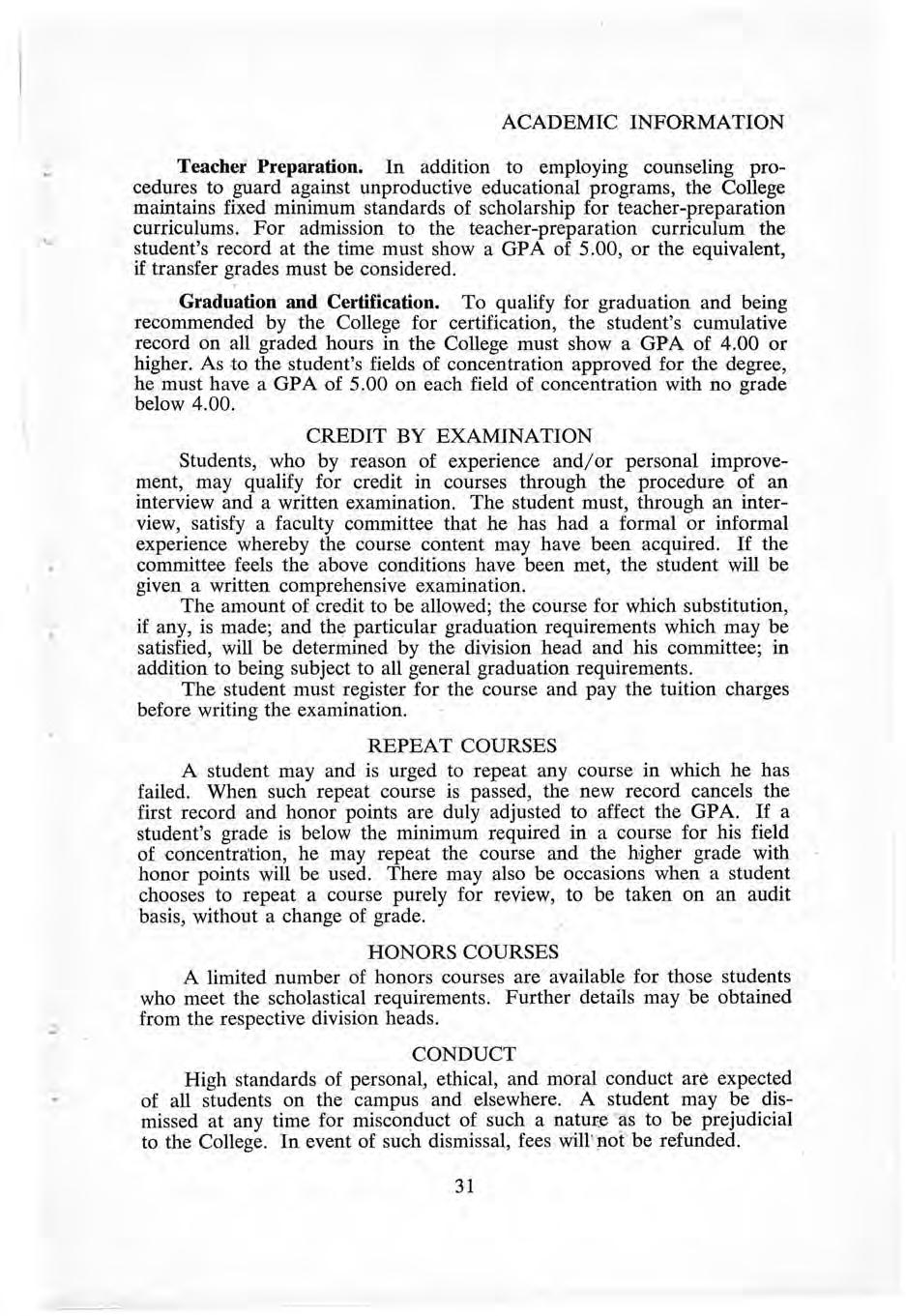
The amount of credit to be allowed; the course for which substitution, if any, is made; and the particular graduation requirements which may be satisfied, will be determined by the division head and his committee; in addition to being subject to all general graduation requirements.
The student must register for the course and pay the tuition charges before writing the ex amination.
A student may and is urged to repeat any course in which he has failed. When such repeat course is passed , the new record cancels the first record and honor points are duly adjusted to affect the GP A. If a student's grade is below the minimum required in a course for his field of concentration, he may repeat the course and the higher grade with honor points will be used. There may also be occasions when a student chooses to repeat a course purely for review, to be taken on an audit basis, without a change of grade.
A limited number of honors courses are available for those students who meet the scholastical requirements . Further details may be obtained from the respective division heads.
High standards of personal, ethical , and moral conduct are expected of all students on the campus and elsewhere . A student may be dismissed at any time for misco~duct of such a nature ·~s to be prejudicial to the College. In event of such dismissal , fees will ''aot be refunded.
When a student finds it necessary to add and/or drop courses following his registration, he should make his request known in the Registrar's office. A forin •for a change in registration, which is available in the Registrar's office, is prepared to show the change and is submitted by the student to his counselor for approval. After the first . five days of classes a fee of $ 1.00 must be paid in connection with the . change. Adding a new class is not permitted after two weeks of classes and in cases of withdrawal after this time, the student's record will show either WP (withdrew passing) or WF (withdrew failing). Unless a student clears officially for each course dropped, his record will show "O", failure in the course.
When a student must cancel his registration and withdraw from the College, he should submit his request in writing on a form available in die Registrar's office. The student then presents this request to the Dean of College , Dean of Students, Librarian , counselor , instructors, and others to whom be bas been responsible. Finally, bis status is determined and payment is made in the Bursar's office. His record of withdrawal is then filed in the ·Registrar 's office.
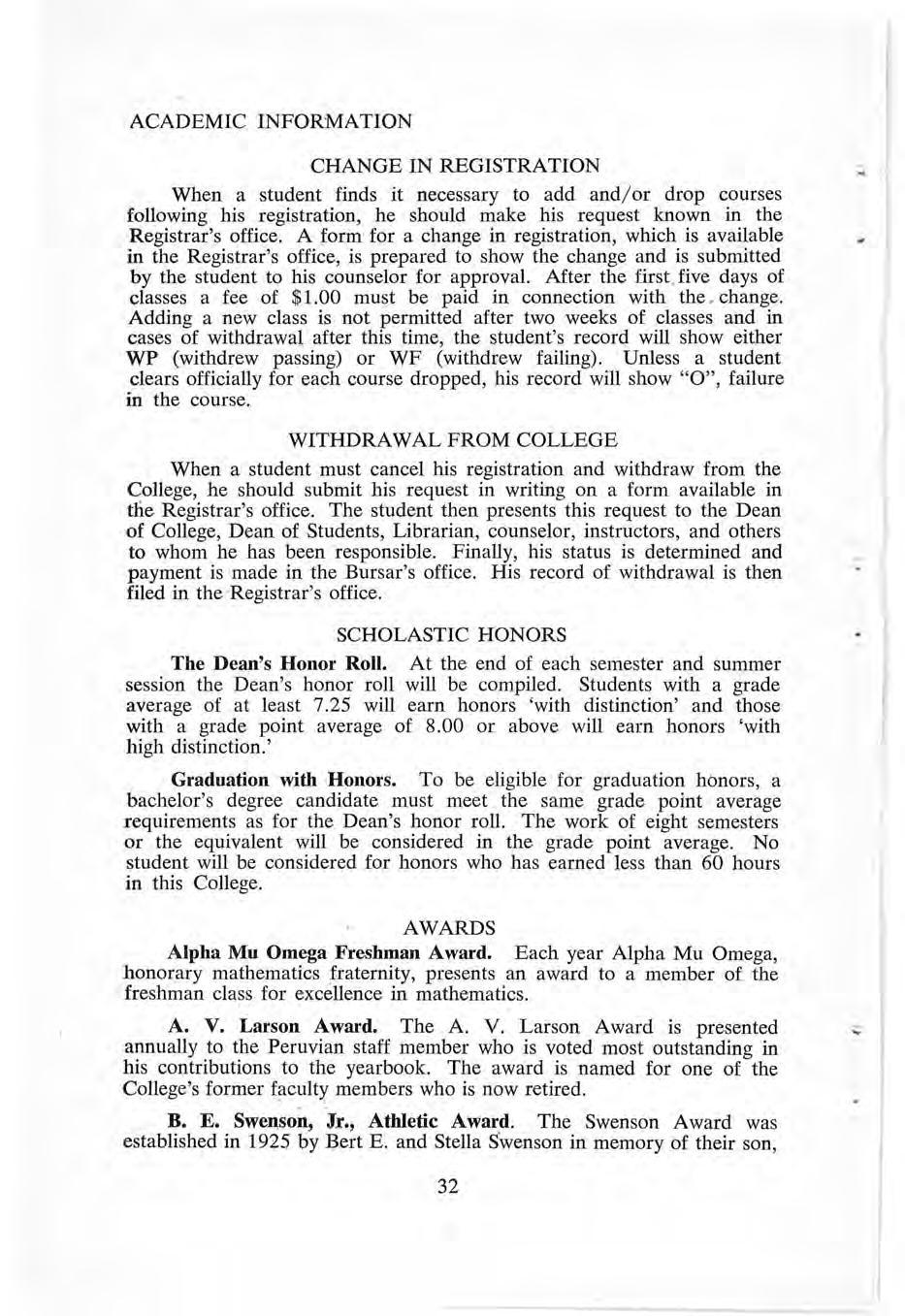
The Dean's Honor Roll. At the end of each semester and summer session the Dean's honor roll will be compiled. Students with a grade average of at least 7.25 will earn honors 'w ith distinction' and those with a grade point average of 8.00 or above will earn honors ' with high distinction .'
Graduation with Honors. To be eligible for graduation honors , a bachelor 's degree candidate must meet the same grade point average requirements as for the Dean's honor roll . The work of eight semesters or the equivalent will be considered in the grade point average. No student will be considered for honors who has earned less than 60 hours in this College .
Alpha Mu Omega Freshman Award. Each year Alpha Mu Omega, honorary mathematics ,raternity, presents an award to a member of the freshman class for excellence in mathematics.
A. V. Larson Award. The A V. Larson Award is presented annually to the Peruvian staff member who is voted most outstanding in his contributions to the yearbook. The award is named for one of the College's former f~culty members who is now retired
B. E. Swenson, Jr., Athletic Award . The Swenson Award was established in 1925 by Bert E. and Stella Swenson in memory of their son,
B. E , Jr. , and their parents who made possible their early education at Peru . Juniors and seniors are eligible and no student shall receive the award more than once. Basis for judging: 100 points. GeneralCharacter and personality, 15; Scholarship, 15; Loyalty to school traditions, 20. Athletics-Must receive school letter in at least two different sports , including either major or minor sports and the two letters need not be earned in any one year, 50 points .
Dramatic Club Awards. The Dramatic Club Awards are made each year to the senior man and senior woman who have contributed most to dramatics during the four years in the College.
Kappa Delta Pi Educational Award. The Beta Mu chapter of Kappa · Delta Pi, national honorary educational fraternity, annually presents a suitable award to the freshman whose scholarship and professional attitude are outstanding .
Louise Mears Geographical Medal. Miss Louise Mears, a former Peru State College faculty member, has established a medal to be awarded for achievement in geography. The medal is awarded each year to the upperclassman who contributes the most outstanding original investigation of some phase of Nemaha County geography . The medal award carries with it a grant to cover the expense of the manuscript . A copy of the research material is filed with the State Historical Library and the Nemaha County Library.
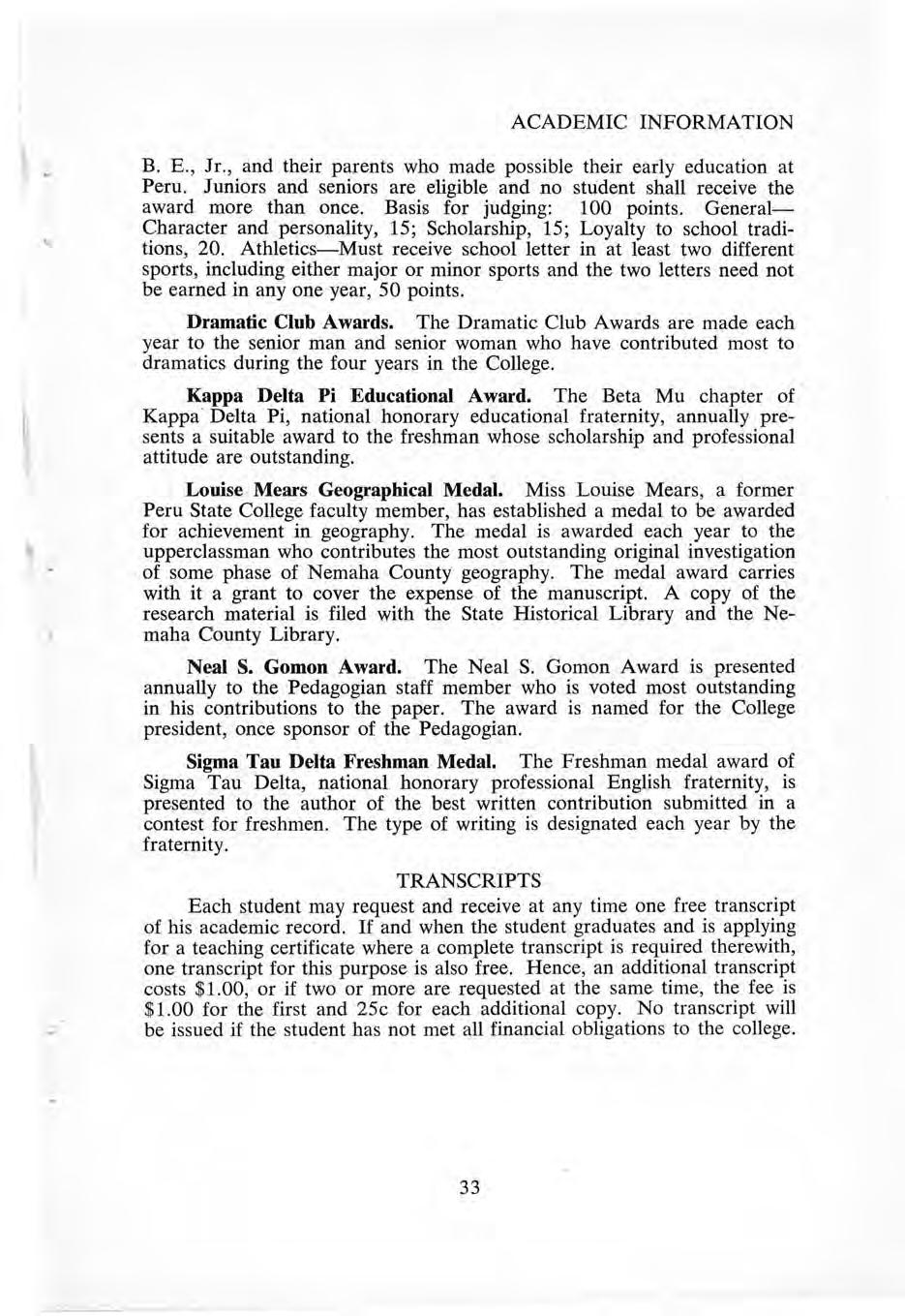
Neal S. Gomon Award. The Neal S. Gomon Award is presented annually to the Pedagogian staff member who is voted most outstanding in his contributions to the paper The award is named for the College president, once sponsor of the Pedagogian.
Sigma Tau Delta Freshman Medal. The Freshman medal award of Sigma Tau Delta, national honorary professional English fraternity, is presented to the author of the best written contribution submitted in a contest for freshmen. The type of writing is designated each year by the fraternity .
Each student may request and receive at any time one free transcript of his academic record . If and when the student graduates and is applying for a teaching certificate where a complete transcript is required therewith, one transcript for this purpose is also free. Hence, an additional transcript costs $ 1.00, or if two or more are requested at the same time, the fee is $ 1.00 for the first and 25c for each additional copy. No transcript will be issued if the student has not met all financial obligations to the college.
Fees must be paid at the time of registration. There is no provision for the granting of credit at registration time; students should come prepared to pay the semester fees at registration time. No individual may enroll in classes or take any examination until his fees are paid in full. Students are urged to retain all receipts issued by college officials.
At the conclusion of a term, the business office will issue to each student a check for any monies due the students. Claims for amounts \ due the College which are to be charged against the student's deposit also will be processed in the business office, after which a check for the amount due the student will be issued and forwarded to the student.
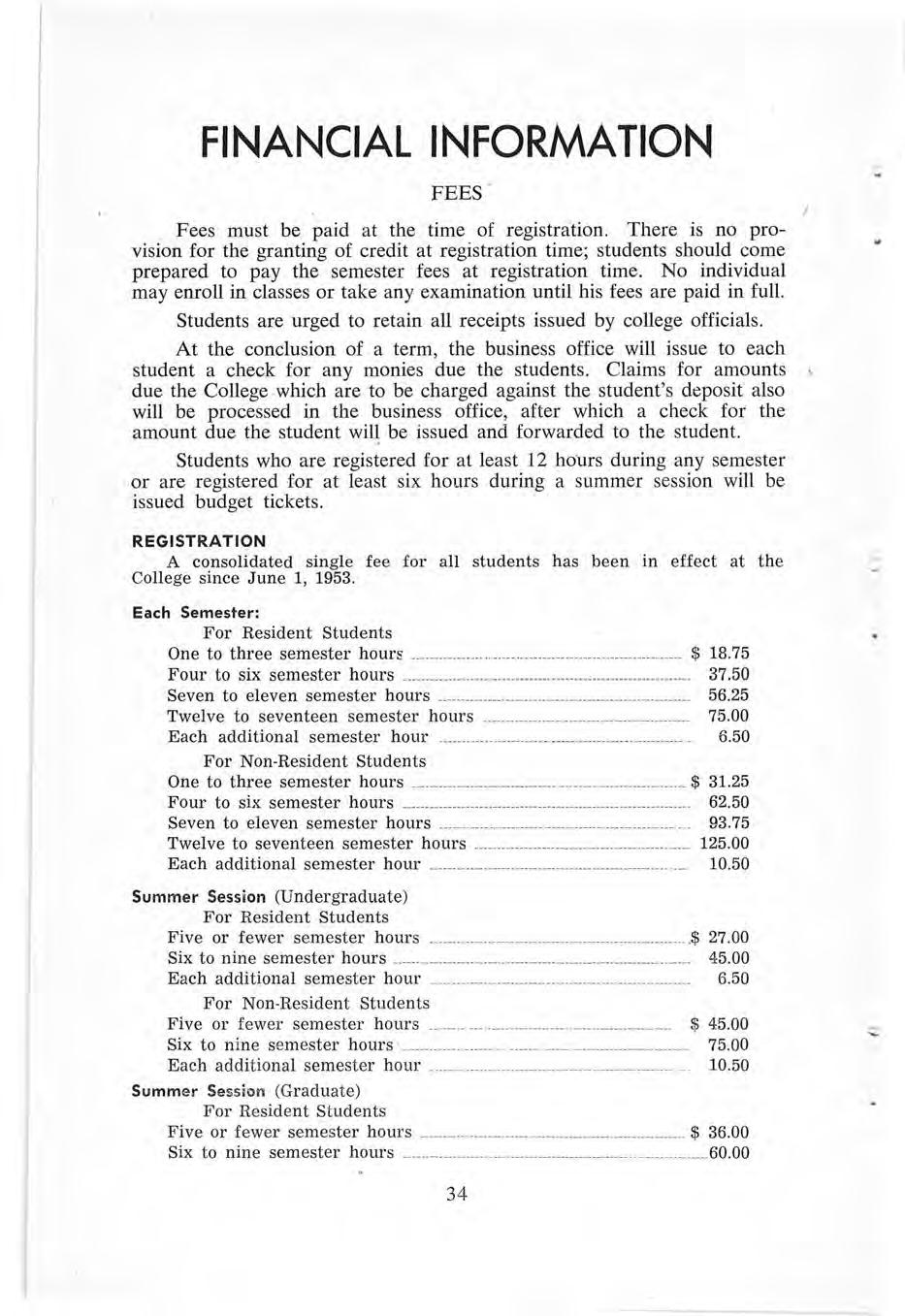
Students who are _registered for at least 12 hours during any semester or are registered for at least six hours during a summer session will be issued budget tickets.
A consolidated single fee for all students has been in effect at the College since June 1, 1953.
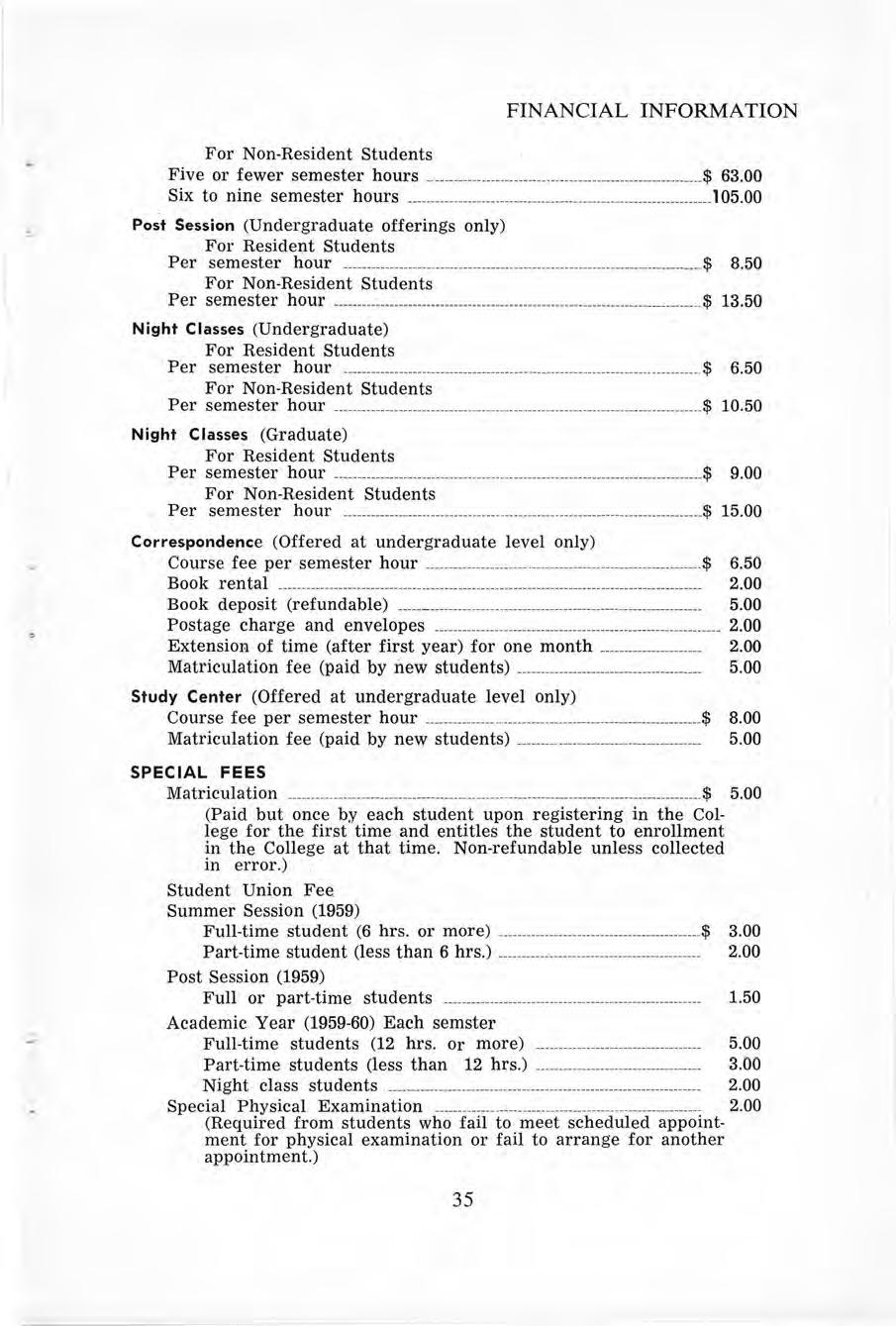
(Paid but once by each student upon registering in the College for the first time and entitles the student to enrollment in the College at that time. Non-refundable unless collected in error.)
(Required from
who fail to meet scheduled appointment for physical examination or fail to arrange for another appointment.)
Note: All fees are subject to change by action of the Board
Education of State Normal Schools at any time.
The consolidated fee includes all charges of applied music necessary to meet the minimum requirements of a field of concentration in music. Private lessons in excess of the minimum requirements are not included in the consolidated fee. Music students are entitled to one or two lessons per weekdepending upon the extent of concentration in music.
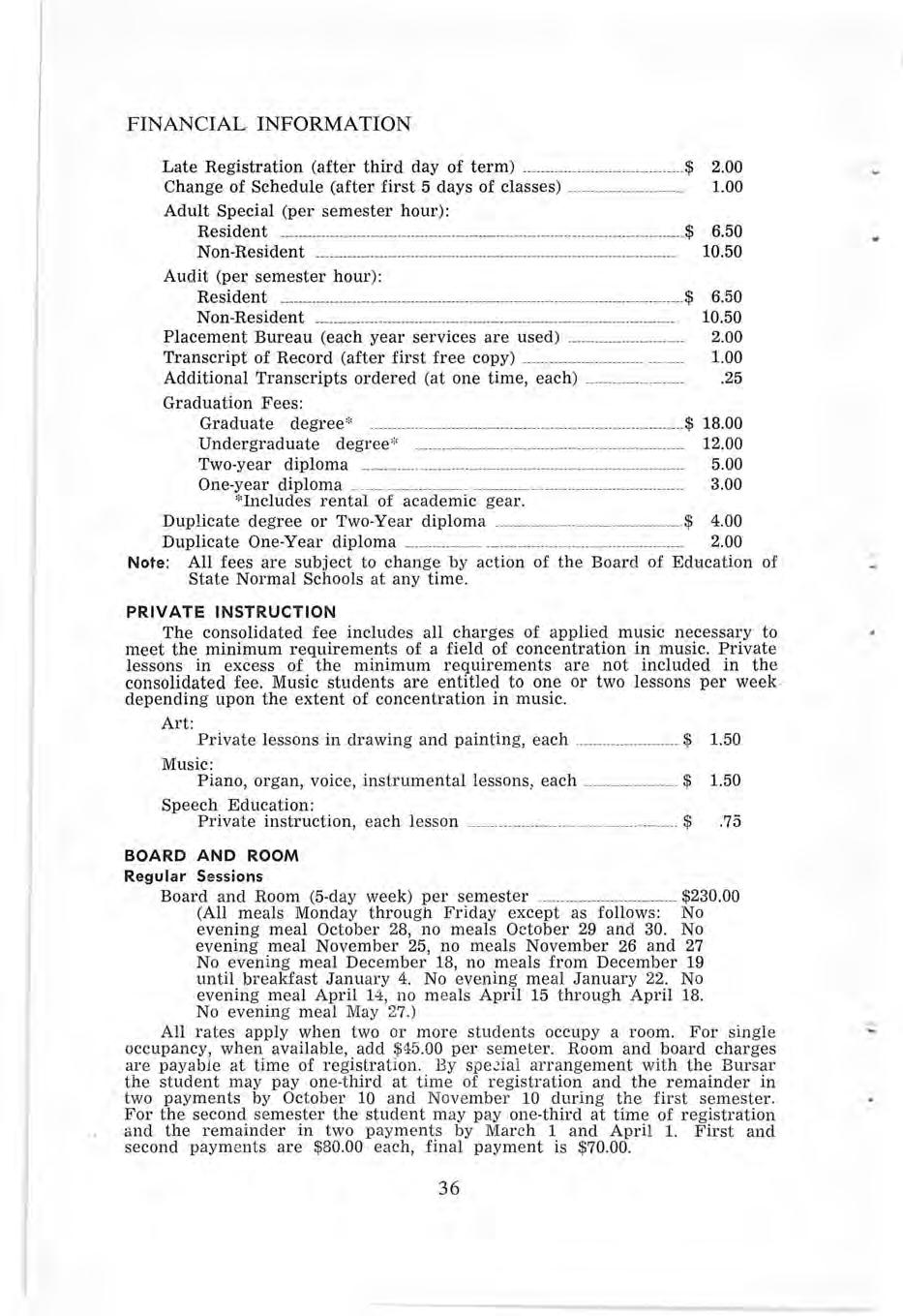
in drawing and painting, each _______________ $ 1.50
Music: Piano, organ, voic e , instrumental lessons, each _____________________ $ 1.50
Speech Education: Private instruction, ea ch lesson -- $ .75
Regular Sessions
Board and Room (5-day week) per semester ---·----------- - - $230.00
(All meals Monday through Friday except as follows : No
evening meal Octob er 28, no meals October 29 and 30 No
evening meal November 25, no meals November 26 and 27
No evening meal Decemb er 18, no m ea ls from December 19 until breakfast January 4. No eve ning me al January 22 No evening meal April 14, no m e als April 15 through April 18. No evening meal May 27.)
All rates apply when two or more st ud e nts occupy a room For single occupancy, when available, add $15 .00 per s emeter . Room and board charges ar e pay a ble at time of re g istration. By spe~ia l ar ran ge ment with the Burs ar the student ma y pay one-third at tim e of r egi stra tion and the remainder in two paym e nts by Octob er 10 a nd Nove mbe r 10 durin g th e first semester. For the second semester the student m ay p ay on e -third at tim e of registration a nd the remaind er in two pa ym ents by March 1 a nd April 1. First and second pa y m e nts are $80.00 each , final p ay ment is $70.00.
Summer Session
Board and Room (5-day week) 8-week session --··········
(All meals Monday through Friday)
Meals are served daily Monday through Friday.
Post Session
$105.00
Board and Room (7-day week) 2-week session ··························-·
(All meals except Sunday breakfast)
$ 40.00
All rates app l y when two or three students occupy a room . For single occupancy, when available, add $25.00 for regular session and $10.00 for post session . Board and room are due and payable at time of registration. By special arrangements with the Bursar, students may pay one-half of charge for regular session on registration day and the balance by July 1. The full amount for Post Session is due at time of registration.
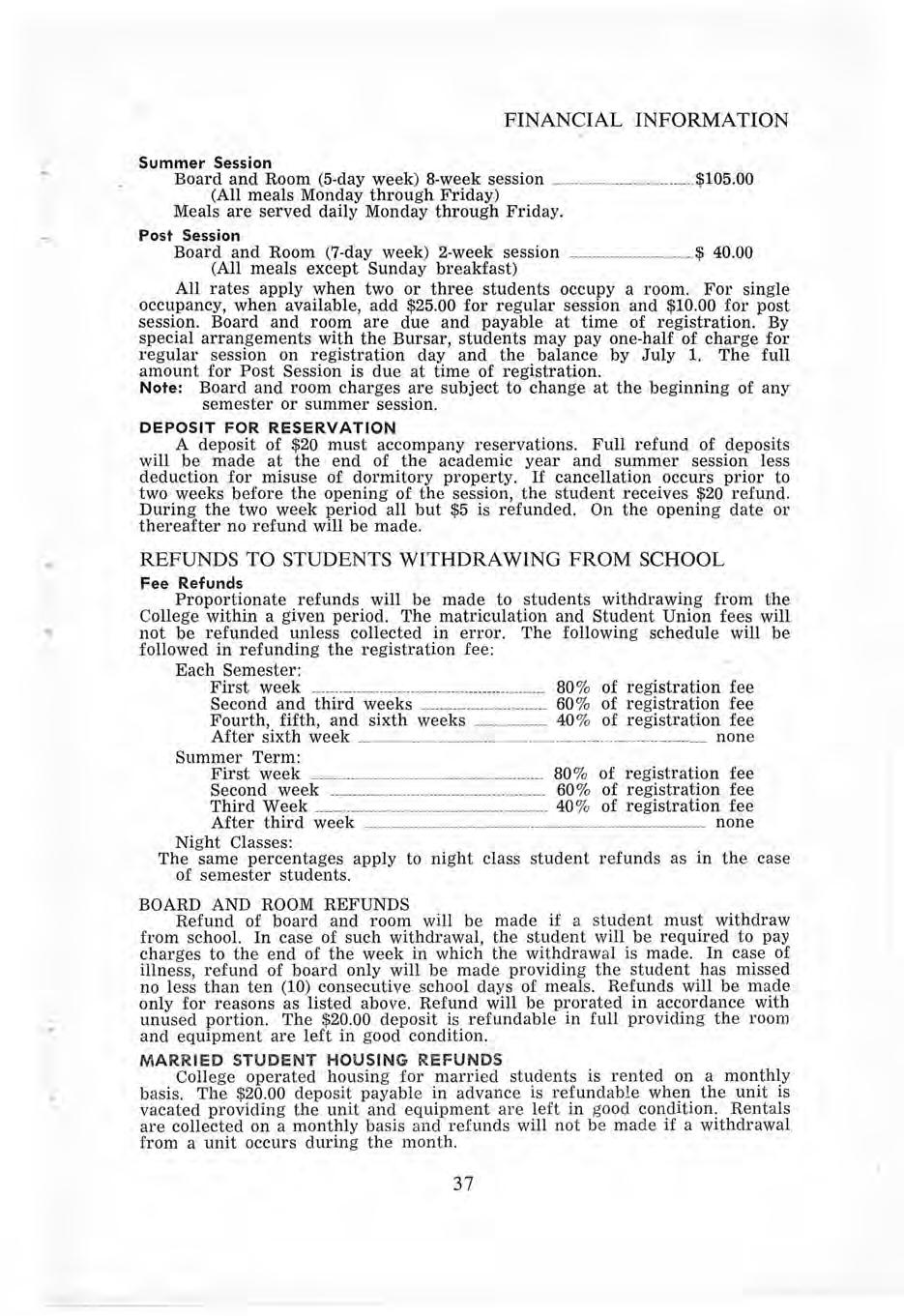
Note: Board and room charges are subject to change at the beginning of any semester or summer session
DEPOSIT FOR RESERVATION
A deposit of $20 must accompany reservations Full refund of deposits will be made at the end of the academic year and summer session less deduction for misuse of dormitory property. If cancellation occurs prior to two weeks before the openin g of the session, the student receives $20 refund . During the two week period all but $5 is refunded. On the opening date or thereafter no refund will be made.
Fee Refunds
Proportionate refunds will be made to students withdrawing from the Co llege within a given period . The matriculation and Student Union fees will not be refunded unless collected in error. Th e following schedule will be followed in refunding the registration fee:
The same percentages apply to night cl ass student r
as in the case of semester students.
Refund of board and room will be made if a st ud e nt must withdraw from school. In case of such withdrawal , the student will be required to pay char ges to the end of the week in which the withdraw a l is made In case of illness, refund of board only will be made providing the student has missed no l ess than ten (10) consecutive sc hool days of meal s. Refunds will b e made only for reasons as listed above. Refund will be prorated in accordance with unused portion. The $20.00 deposit is refundable in full providing the room and equipment are left in good condition.
MARRIED STUDENT HOUSING REFUNDS
College operated housin g for married students is rented on a monthly basis . The $20.00 deposit payable in advance is refundable when the unit is vacated providing the unit and equipm e nt are lef t in good condition. Rentals are collected on a monthly ba sis and r ef unds will not b e ma de if a withdrawal from a unit occurs during the month.
The consolidated single fee plan, plus the college-operated residencehalls and the non-profit food service at Peru State College, makes a college education financially possible for most young people.
The single ($ 75 00 for resident or $ 125.00 for non-resident) fee each semester covers admission to all college activities , health care, yearbook and school paper subscriptions, and all tuition and fees, including private music, art, or speech lessons that are required in a curriculum . A matriculation fee of $5 is paid only one time-at the first registration at the College.
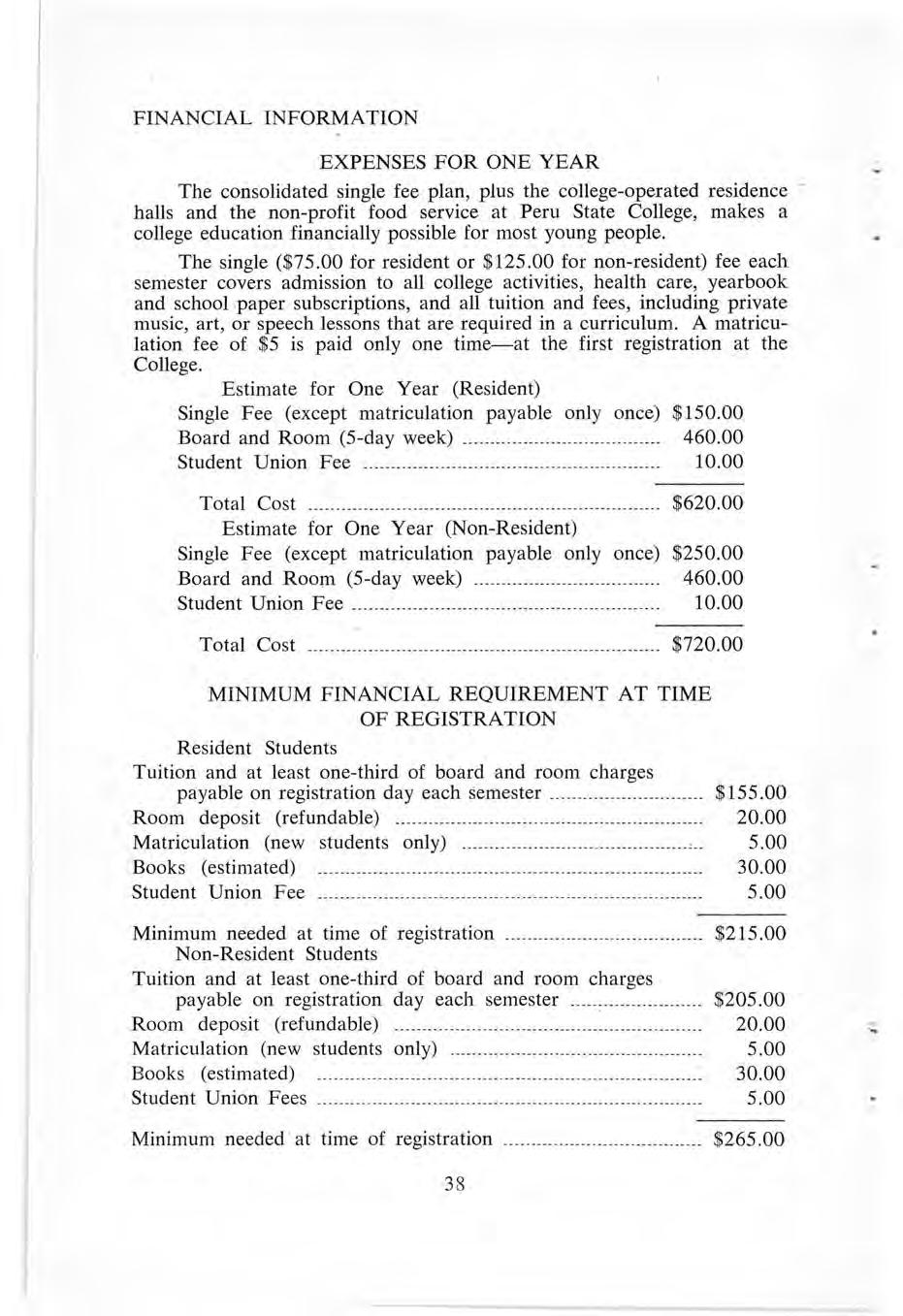
A nuniber of part-time job opportunities are available to st udent s attending the College. Many students are hired each semester to help with the. operation and upkeep of the College and are placed in jobs in offices, the cafeteria, student union, heating plant, shops, and grounds maintenance. A limited number of jobs also are available off-campus. Students who plan to earn a considerable portion of their expenses should expect to take less than a full class ,load. A student should have sufficient funds available to meet initial expenses and afford some margin for emergencies. Applications for part-time student emplo yment should be directed to Dean of Students.
The class of 1913 established what is known as the Student Loan Fund with an initial gift of $ 50. Contributions by other graduating classes, the Nebraska State P. E. 0. in 1929, and interest accumulations have increased the fund until it now totals approximately $ 3,500.
Loan applications are received and acted upon by a faculty committee headed by the Dean of Students. Prompt payment is necessary in order that help may be given to as many college students as possible. Teachers in service or persons wishing to attend other colleges are not eligible for the fund.
In order to receive the approval of the committee , the applicant for a loan must show (1) that he is enrolled in the College, (2) that he is planning to teach, (3) that he is in need of the money , and (4) that he is , unable to secure it elsewhere. The borrowing student must present a note signed by himself and a financially responsible co-maker. A reasonable interest charge is made. The fund is in the custody of the Bu~sar, to whom applications should be directed.
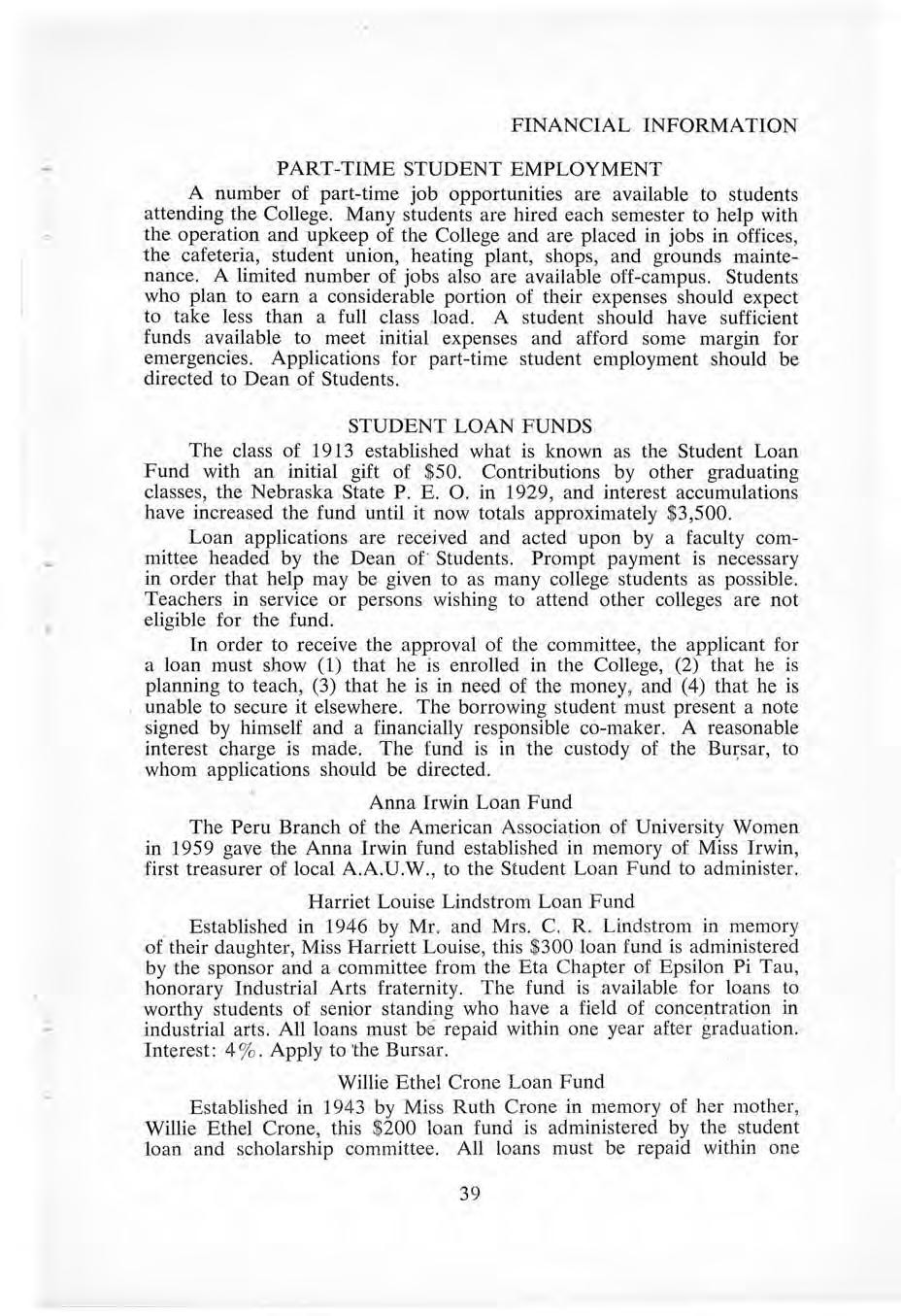
The Peru Branch of the American Association of University Women in 1959 gave the Anna Irwin fund established in memory of Miss Irwin, first treasurer of local A.A.U.W ., to the Student Loan F und to administer.
_ Established in 1946 by Mr. and Mrs. C. R. Lind strom in memory of their daughter, Miss Harriett Louise, this $ 300 loan fund is administered by the sponsor and a committee from the Eta Chapter of Epsilon Pi Tau, honorary Industrial Arts fraternity. The fund is availab le for loans to worthy students of senior standing who have a field of conceµtration in industrial arts . All loans must b e repaid within one year after gradu a tion .Interest: 4 %. Apply to 'the Bursar.
Established in 1943 by Mi ss Ru th Crone in memory of h e r mother , Willie Ethel Crone, this $ 200 loan fund is administered by the student loan and scholarship committee. All loans must be repaid within one
year after the student leaves school. Applications must have junior standing or above. They must be deserving, industrious, of good mind and good character , and must be making some helpful contribution toward campus affairs, i.e., having served or be serving in one major or two minor College organization offices. Interest: 3 % from date of note; 6 % after matm;ity. Apply to the Bursar.
Board of Education for State Normal Schools Scholarships.. Fouryear scholarships valued at $320 are granted to the graduating seniors of Nebraska high schools. The scholarships are granted on the basis of one scholarship for each school with fifty or fewer graduating seniors . Schools with larger classes of graduating seniors are granted scholarships on the basis of one scholarship for each fifty seniors or major fraction thereof. Two-year scholarships valued at $160 are granted to graduates of Nebraska Junior Colleges on the same basis of number as above. All scholarships are granted by the Board of Education of State Normal Schools. Recipients of these grants must ran,k in the upper 25 % of their graduating class. Selection of the scholarship winner is left to the discretion of the superintendent or principal and the board of education of the high school.
The scholarship entitles the holder to exemption from fees in any one of the four Nebraska State Teachers Colleges in the amount not to exceed $40 each semester for not more than eight semesters for high school graduates and not to exceed $40 each semester for not more than four semesters for junior college graduates. Fee exemptions for the scholarship holder shall not exceed $23.50 for a regular term of summer school._ The scholarship will not be honored unless presented within two years after high school graduation and may be withdrawn for misconduct or failure in any subject. Should the holder fail during any year to maintain a grade up to the medium grade of his class, the scholarship will be withdrawn. If the student drops out of school for more than one calendar year, 'the scholarship expires, unless the interruption is due to the illness of the student or a member of his family, or unless the student is called into the armed forces.
Pearl A. Kenton Foreign Language Scholarship.. Established by Miss Alice Kenton in memory of her sister, Miss Pearl A . Kenton ,. associate professor of foreign languages from 1924 to 1944, this grant provides for an annual award of $50 to an outstanding student in the foreign la~guage department.
Nebraska Congress of Parents and Teachers Scholarships. Scholarships are granted by the Nebraska Congress of Parents and Teachers to full-time students of the Nebraska State Teachers Colleges who are Nebraska residents training to become elementary teachers. In order to be eligible for these scholarships-which vary in number with available funds-the student must be enrolled in either one-, two- , or four-year
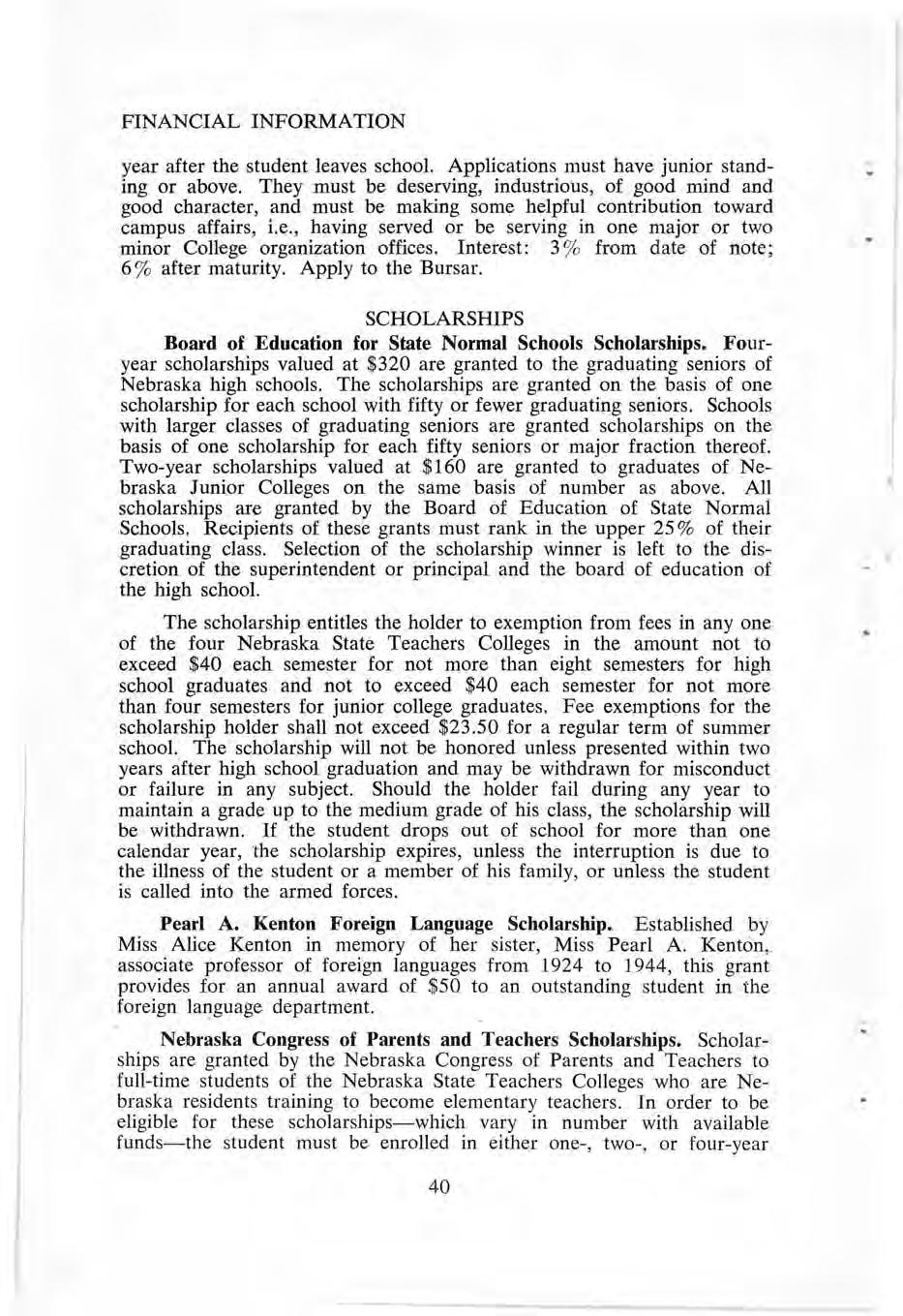
teaching curriculums, have a pleasing personality, have high moral and social standards, and show an aptitude for teaching.
Peru Achievement Foundation. As a result of the work of a group of Peru State Teachers College Alumni the Peru Achievement Foundation was officially organized upon filing its Articles of Incorporation on June 20, 1955.
As stated in the Articles, it will be the purpose of the Corporation to aid Peru State College . . . "by the solicitation of gifts, grants, devises and bequests . . . of real property or personal property . . . and to hold and administer the same as trustee thereof for the use and benefit of Nebraska State Teachers College at Peru, Nebraska ."
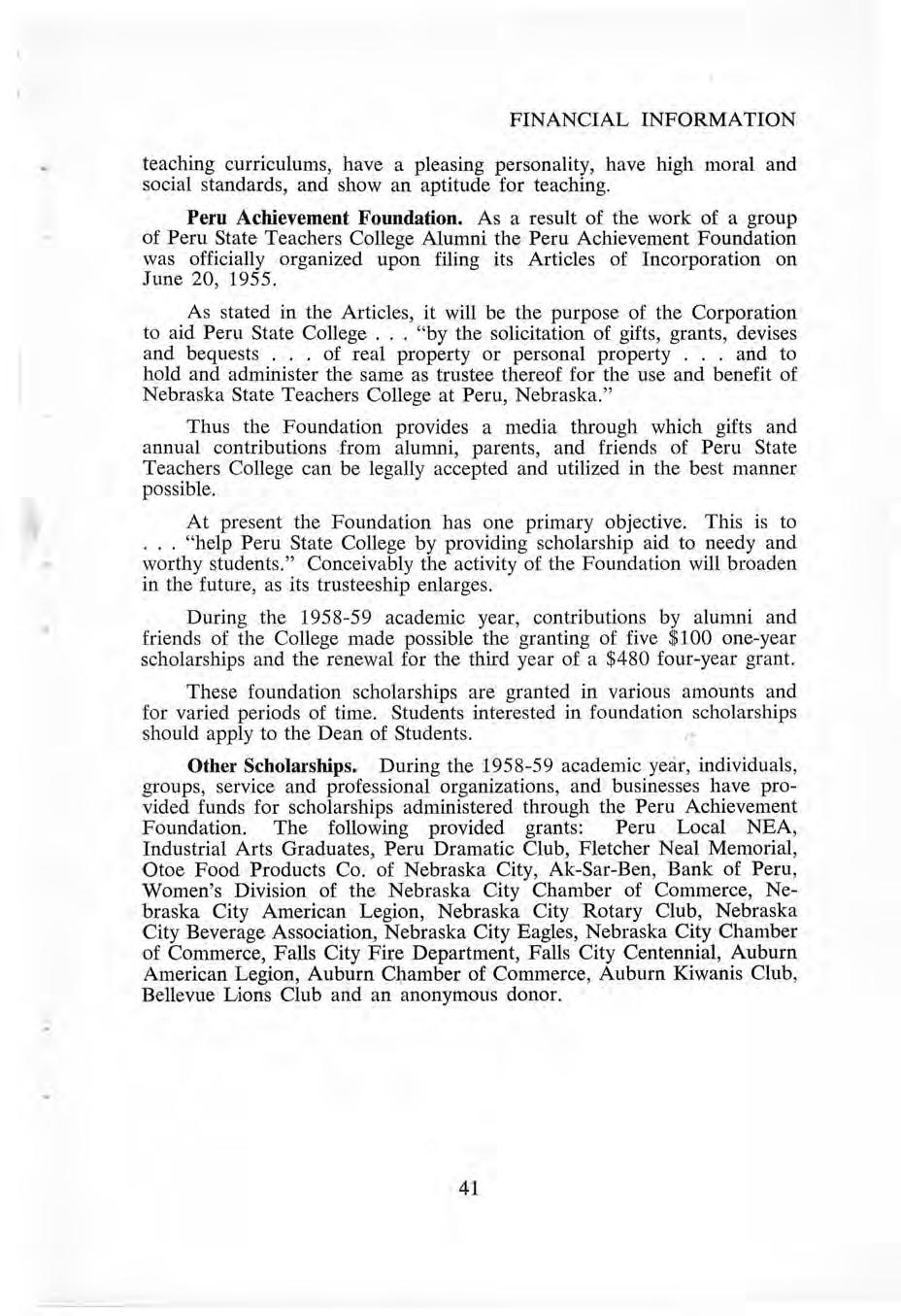
Thus the Foundation provides a media through which gifts and annual contributions .from alumni, p arents , and friends of Peru State Teachers College can be leg ally accepted and utilized in the best manner possible.
At prese nt the Foundation has one primary objective. This is to . . . "help Peru State College by providing scholarship aid to needy and worthy students." Conceivably the activity of the Foundation will broaden in the future, as its trusteeship enlarges.
During the 1958-59 academic year , contributions by alumni and friends of the College made possible the granting of five $ 100 one-year scholarships and the r enewal for the third year of a $480 four-year grant.
These foundation scholarships are granted in various amounts and for varied periods of time. Students interested in foundation scholarships should apply to the Dean of Students.
Other Scholarships.. During the 1958-59 academic year, individuals , groups, service and professional organizations , and businesses have provided funds for scholarships administered through the Peru Achievement Foundation The following provided grants: Peru Local NEA, Industrial Arts Graduates , Peru Dramatic Club, Fletcher Neal Memorial , Otoe Food Products Co. of Nebraska City, Ak-Sar-Ben , Bank of Peru , Women's Division of the Nebraska City Chamber of Commerce, Nebraska City American Legion, Nebraska City Rotary Club, Nebraska City Beverage Association, Nebraska City Eagles , Nebraska City Chamber of Commerce, Falls City Fire Department, Falls City Centennial, Auburn American Legion, Auburn CIJ,amber of Commerce, Auburn Kiwanis Club , Bellevue Lions Club and an anonymous donor.
The College has as its constant goal the best possible adaptation of its educational opportunities to the interest, needs, and abilities of each individual student. The performance of this service to the student is. under the direction of the Director of Guidance.
A faculty counselor conversant with the student' s majo r interests is. assigned to aid with hi s particular problems. Students needing advice before the opening of the college year are invited to arrange a conference. with the Director of Guidance or the Registrar of the College by definite appointment. The student needing personal or vocational counseling may see at any time his faculty counselor, Dean or Associate Dean of Students , Director of Guidance, or other members of the staff who are especially qualified.
All requests for information concerning living accommodations and reque sts for room reservations in one of the residence halls should be directed to either the Dean of Students (men) or the Associate Dean of Students (women). Students, in Women 's resident halls having radios in their rooms must use transformers since the electric current is 200 volt, A.C. Schedule of room and board rates is listed in the Financial Information Section.
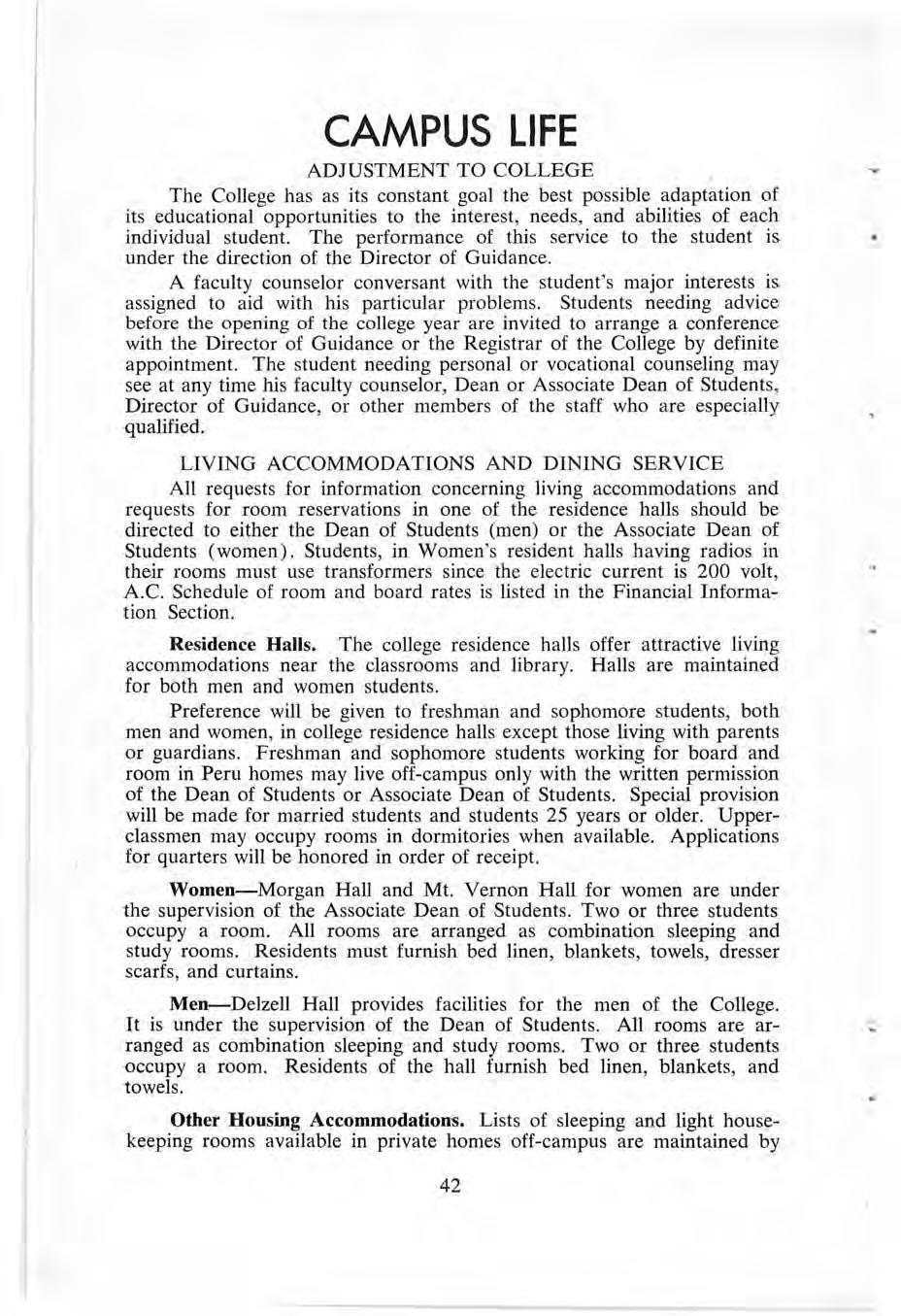
Residence Halls. The college residence halls offer attractive living accommodations near the classrooms and library. Halls are maintained for both men and women students.
Preference will be given to freshman and sophomore students , both men and women, in college residence halls except those living with parents or guardians. Freshman and sophomore students working for board and room in Peru homes may live off-campus only with the written permission of the Dean of Students or Associate Dean of Students. Special provision will be made for married students and students 25 years or older . Upperclassmen may occupy rooms in dormitories when available. Applications for quarters will be honored in order of receipt.
Women-Morgan Hall and Mt. Vernon Hall for women are under the supervision of the Associate Dean of Students. Two or three students occupy a room. All rooms are arranged as combination sleeping and study rooms . Residents must furnish bed linen, blankets , towels, dresser scarfs, and curtains.
Men-Delzell Hall provides facilities for the men of the College. It is under the supervision of the Dean of Students. All rooms are arranged as combination sleeping and study rooms . Two or three students occupy a room . Residents of the hall furnish bed linen , blankets , and towels.
Other Housing Accommodations. Lists of sleeping and light housekeeping rooms available in private homes off-campus are maintained by
the · Dean of Students. These accommodations are approved and supervised by the College. Students may not live in housing other than that approved by the College (This includes students working for board, or living with relatives other than parents or guardians).
Married Student Housing. Housing units for married couples are available in Oak Hill as described on page 19. A $20.00 deposit is required on each unit. This deposit is refundable at the end of the rental period providing the property is left in good condition.
Dining Services. The air-conditioned college dining room is located in Mount Vernon Hall and - is open to all students. The Bob Inn Snack Bar, located in Mount Vernon Hall, is open for lunches and ·snacks at stated hours. Students who do not live in the residence halls may purchase meals at a nominal rate .
Dress. It is not the intent of the college staff or any member thereof to dictate or to inspect the clothes worn by students. However, it is the opinion of the staff and the Student Senate that there is an obligation to advise students as to appropriate dress. Appropriateness of dress does not require expensive clothes. The essential requirements are that the clothing be clean, not torn, and reasonably well fitted.
For women students , skirts and sweaters or blouses and dresses are appropriate for the classroom and cafeteria. Sport and dress shirts and slacks or trousers are appropriate for men students in classoom and cafeteria. T-shirts, sweat-shirts, and jeans are appropriate in certain classes · such a gym and shop.
Special occasions-rec;eptions, church, parties, dances, teas, and dates-are naturally dress-up occasions . More informal attire is appropriate at the proper time and place.
Students are reminded that as one dresses is a cue as to what he thinks of himself and a cue as to what other s think of him. The importance you give to yourself will be reflected in your manner of dress.
Required Health Examination. In order to safeguard students who may have unknown physical weaknesses and in order to protect the college community, all students are required to take a health examination at the time of matriculation. A student's registration is not completed until the examination has been taken .
Failure to report for the physical examination at the appointed time, unless arrangements are made for another appointment, may result in exclusion from class until the examination is completed. A fee of $2.00 will be charged for special examinations. Students participating in physical activities such as football, basketball, baseball, track, swimming, and tennis must be certified as physically fit by the college physician at the beginning of the activity.
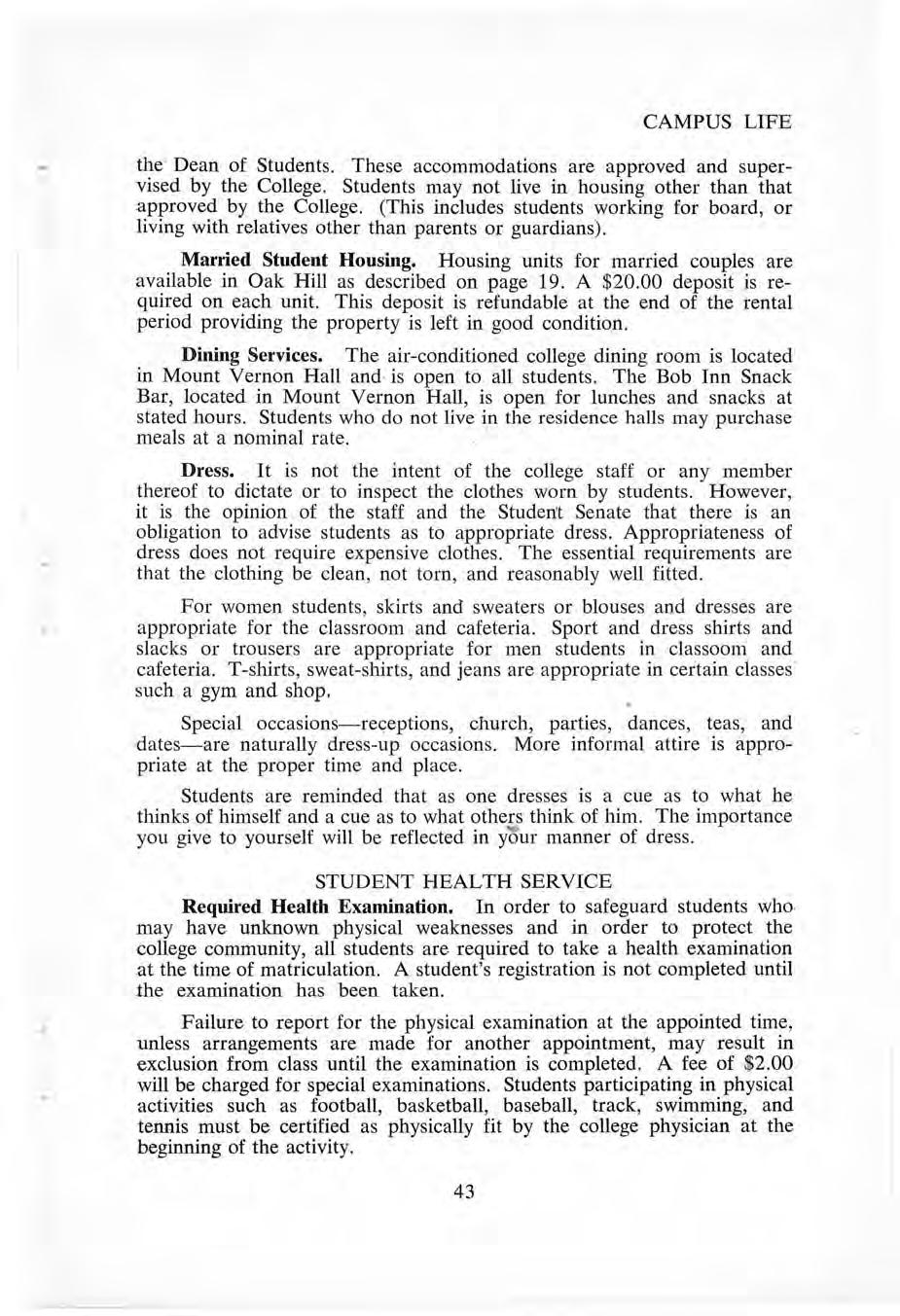
Each student is required to take an X-ray for tuberculosis, when the mobile unit of the State Department of Health is on campus each year.
Health Care. The Student Health Service receives a portion of the consolidated fee that is paid by each student. From this fee , the student receives infirmary care, X-ray, diathermy treatment, and certain medicines. The type of service available is decided by the college health committee and the college physician, and may not exceed an established maximum .
Special prescriptions, glasses, and routine dentistry are not covered by the infirmary fee The College 's responsibility for medical expenses is limited to the general services by the college physician and college nurse, and care in the infirmary. The College does not accept responsibility for special consultant, special nursing, and specialized treatment. Student s who have served in the armed force·s of the United States will receive no treatment for illnesses arising in whole or in part from such service. Care and treatment in such cases will be limited to the same responsibilities as to the non-veteran student. The health committee and the college physician will make all final decisions as to what expenses will be met by the College.
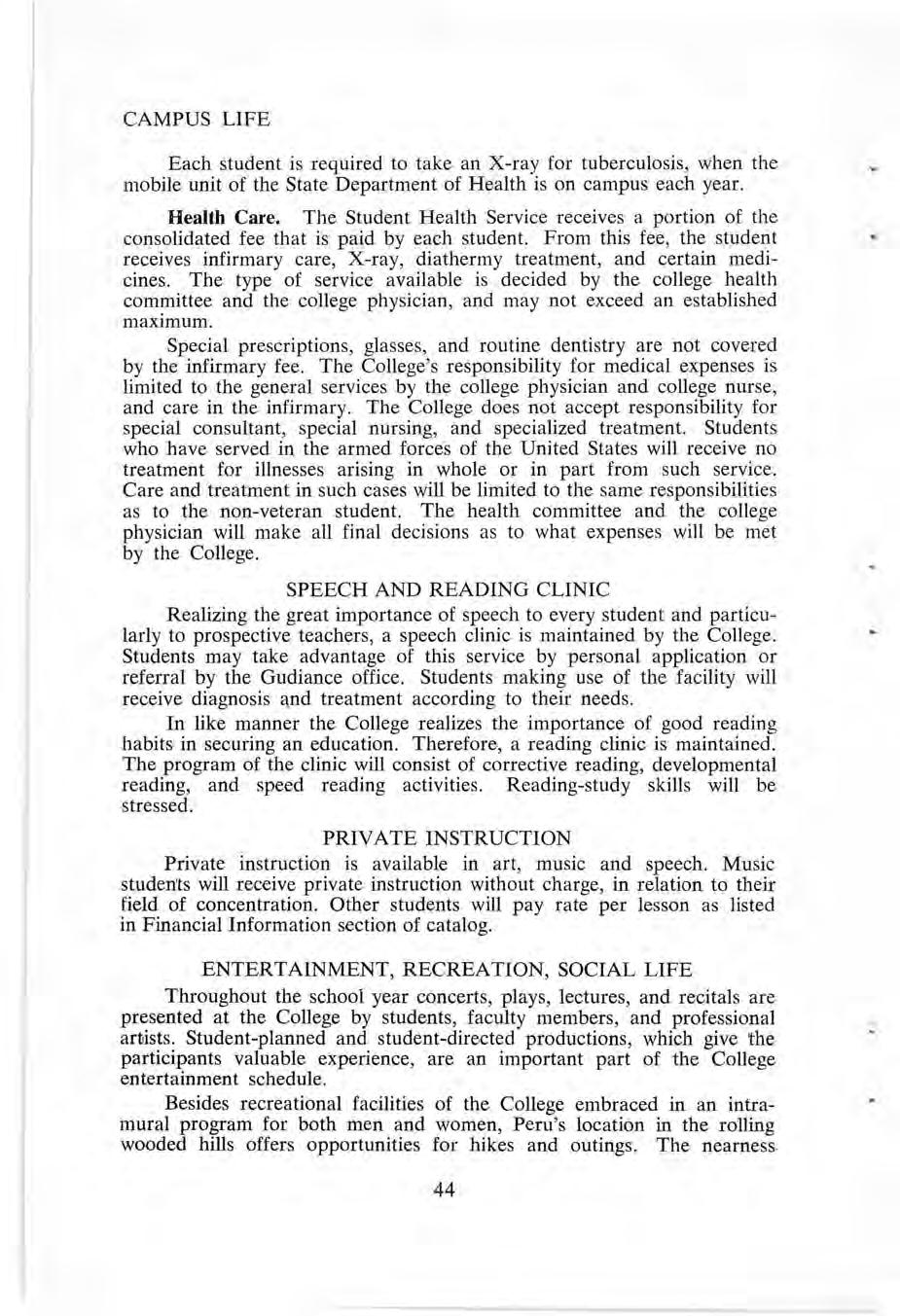
Realizing the great importance of speech to every student and particularly to prospective teachers, a speech clinic is maintained by the College. Students may take advantage of this service by personal application or referral by the Gudiance office. Students making use of the facility will receive diagnosis ::tnd treatment according to their needs .
In like manner the College realizes the importance of good reading habits in securing an education. Therefore, a reading clinic is maintained. The program of the clinic will consist of corrective reading, developmental reading, and speed reading activities. Reading-study skills will be stressed .
Private instruction is available in art , music and speech . Music students will receive private instruction without charge, in relation to their field of concentration. Other students will pay rate per lesson as listed in Financial Information section of catalog.
Throughout the school year concerts, plays, lectures, and recitals are presented at the College by students, faculty members, and professional artists. Student-planned and student-directed productions, which give 'the participants valuable experience, are an important part of the College entertainment schedule.
Besides recreational facilities of the College embraced in an intramural program for both men and women, Peru's location in the roiling wooded hills offers opportunities for hikes and outings. The nearness
of the Missouri River makes the College an ideal place for the nimrod and angler. Laura Neal Memorial Park , a few blocks south of the campus, is the scene of many student, faculty, and alumni meetings. Other parks in the area where Peruvians gather are Coryell Park near Brock, the city parks at Auburn and Nebraska City, and the Arbor Lodge State Park , also in Nebraska City . The summer months find many Peru Staters enjoying the outdoor municipal swimming pools in Auburn and Nebraska City.
The social season at the College centers around five events-Homecoming, Thanksgiving, Christmas , Valentine Day, and May Fete-when all-college dances are given. Other social activities are sponsored by various student organizations. These groups give dances, teas, parties, receptions, and picnics for their members and guests . Faculty organizations include the faculty women's club, and a branch of the American Association of University Women
The STUDENT SENATE, a representative organization of the student body, serves to coordinate the efforts of the students and faculty members for the best interests of the College. Its membership includes 12 students-two elected from each of the four classes and four elected from the student body at large. The Senate provides student representation on certain college committees, supports college-wide activities, and · sponsors Homecoming and the May Fete. To be eligible for membership, students must maintain a sufficiently high scholastic record in addition to possessing high qualities of citizenship, character, and leadership.
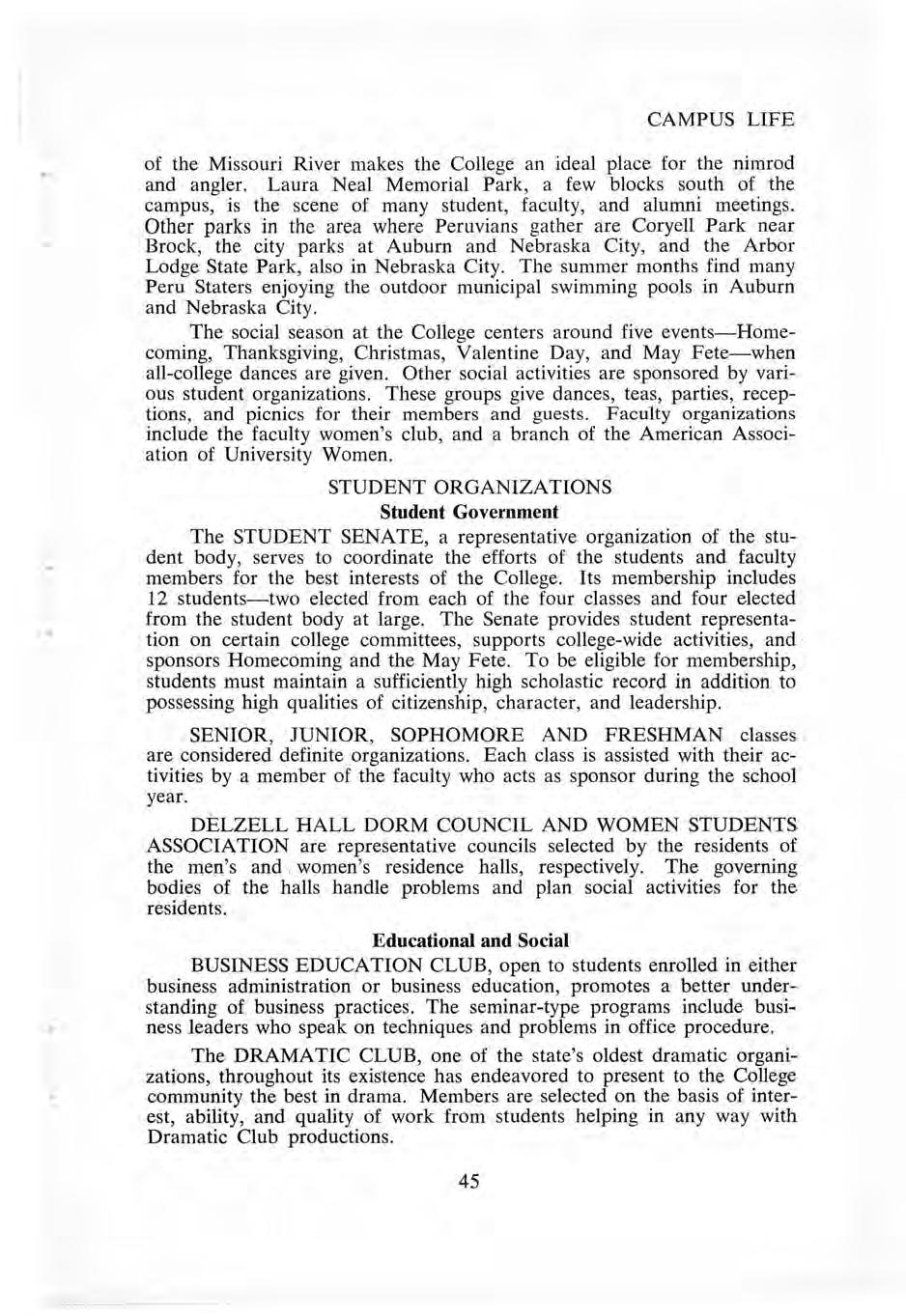
SENIOR, JUNIOR, SOPHOMORE AND FRESHMAN classes are considered definite organizations. Each class is assisted with their activities by a member of the faculty who acts as sponsor during the school year.
DELZELL HALL DORM COUNCIL AND WOMEN STUDENTS
ASSOCIATION are representative councils selected by the residents of the men's and , women ' s residence halls, respectively. The governing bodies of the halls handle problems and plan social activities for the residents.
BUSINESS EDUCATION CLUB, open to students enrolled in either business administration or business education, promotes a better understanding of business practices. The seminar-type programs include business leaders who speak on techniques and problems in office procedure.
The DRAMATIC CLUB, one of the state's oldest dramatic organizations, throughout its exis'tence has endeavored to present to the College community the best in drama. Members are selected on the basis of interest, ability, and quality of work from students helping in any way with Dramatic Club productions.
FOREIGN LANGUAGE CLUB is open to all students who study foreign languages. Generally they are all members of the club The origins of the club go back to the German Club organized by Professor E. A. Wittenack in 1909. Through the years this organization, under the guidance of Dr. Selma Koenig, developed into what is now known as the Foreign Language Club. The aim of the club is to give to the students and the instructor an opportunity to become more acquainted with one another, to speak the languages, to show films of foreign countries, to sing songs in different languages, and to have an hour of social fellowship with one another. One language group is usually in charge of the meeting.
HOME ECONOMICS CLUB. Young women interested in home economics are eligible for membership in the Home Economics Club. This organization offers opportunities for development of personality and for stimulation of interest in homemaking and the professional field. It is affiliated with the National Home Economics Association.
INDUSTRIAL ARTS CLUB is devoted to promoting intere st in the Industrial Arts and Vocational Education. Affiliated with the American Industrial Arts Association, the organization's members receive the national publication, "The Industrial Arts Teacher, " published five times yearly. Membership is open to all students.
INTERNATIONAL RELATIONS CLUB. Students interested in . international affair s are eligible for membership in the International Relations Club. Materials for stud y are furnished b y the Carnegie Endowment for International Peace.
SOCIAL COUNCIL. The membership of this group is made up of the Student Senate and the presidents of all student organizations on campus. The function of the council is to plan and coordinate the social activities.
STUDENT EDUCATION ASSOCIATION OF NEBRASKA is an organization for potential teachers. It is affiliated with the Nebraska State Teachers Association and is devoted to the improvement of education in the United States. Membership is restricted to those stl)dents who have been accepted into the teacher education curriculum .
VETERANS CLUB. The Peru State Veterans Organization is open to all male and female veterans of any of the military services released under honorable conditions. It is organized to encourage veterans of the area to choose Peru State as their College , to act as a service club , and to produce a more varied social life on the campus, in addition to providing information to veterans on current laws or benefits which affects them as veterans.
In September of 1956 , the Chapters of the Young Men's Christian Association and the Young Women' s Christian Association , along with the Student Fellowship Club , were combined into one religious club which is
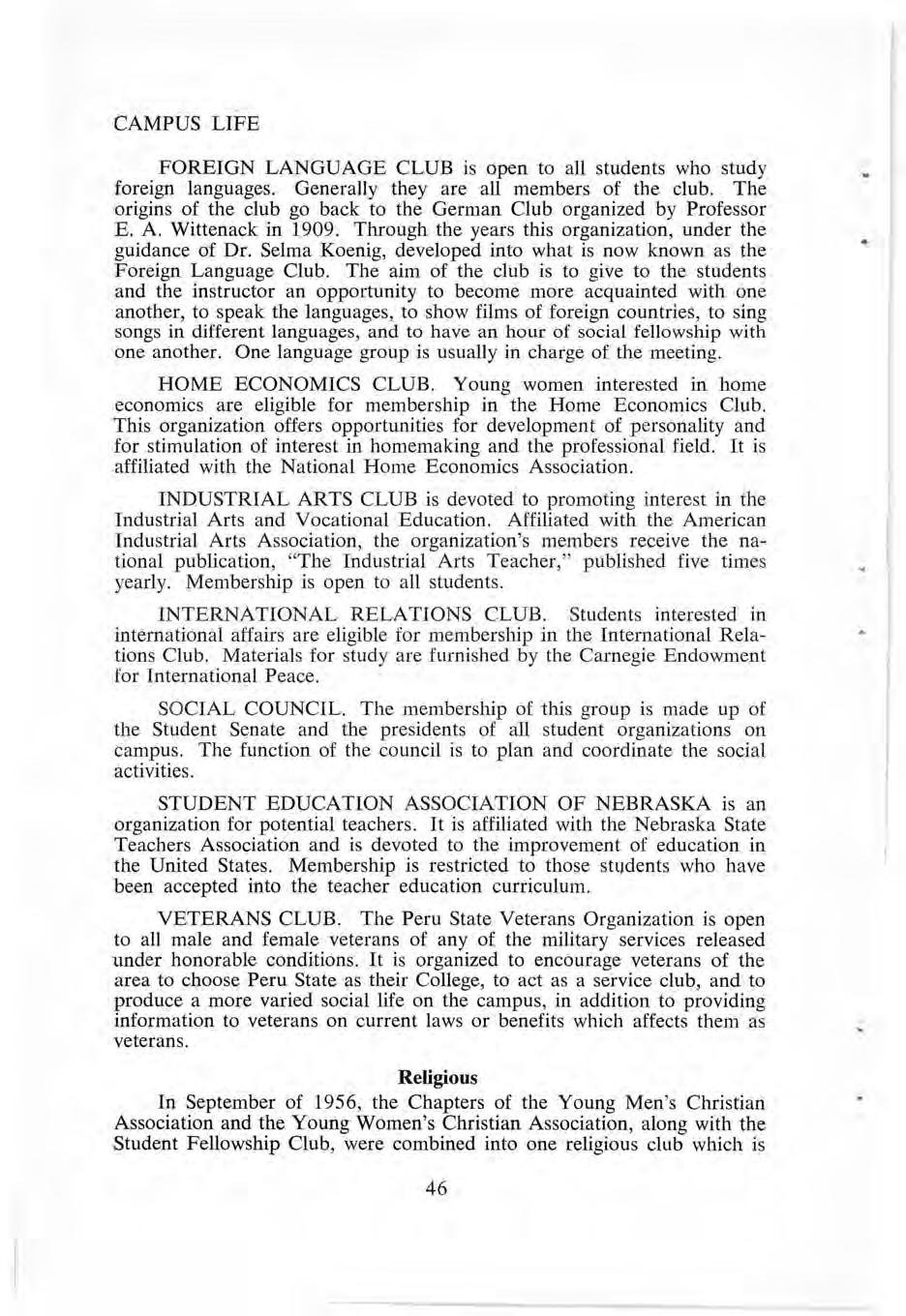
now known as the Student Christian Fellowship . This group includes Methodist , Christian, Baptist, and other denominations.
Other religious clubs serve the interests of Peru State students. These include : Lutheran Club (Missouri Synod); Lutheran Students Association (United Lutheran); Newman Club (Catholic).
The PERU CHORUS, open to all students, is devoted to the study and performance of good choral literature. One semester hour credit may be earned by chorus members by registering for Music 19, Chorus.
The COLLEGE ORCHESTRA is open to all students who play instruments . Members may earn one semester hour credit by registering for Music 20, Orchestra.
The BAND is primarily a marching organization during football season. During the remainder of the school year the concert band presents concerts both on- and off-campus. Members may earn one semester hour credit by registering for Music 21, Band.
ORGAN INSTRUCTION . A Connsonata Electric Organ is available in the College Auditorium for recitals , practice purposes, and various college functions. The purchase of the organ was made possible in part through a contribution from the _ Peru Alumni Association.
The addition of organ instruction to the college curriculum was a· most important step in the rapidly growing department of Fine Arts.
The MUSIC CLUB , an affiliate of the Nebraska Music Educators Association and the Music Educators National Conference, is open to students interested in music. The threefold membership of the club gives the students the advantages of a professional relationship as future music teachers. The club annually sponsors instrumental and _ vocal clinics and various musical productions, which give its members excellent training for handling such events as teachers of music.
The " P " CLUB membership is made up of Peru State College men who have lettered in any inter-collegiate sport. The fostering of good sportsmanship is the club's purpose.
The WOMEN'S ATHLETIC ASSOCIATION is open to women students interested in women's physical education. The group's activities are directed by the Director of Physical Education for women.
The BLUE DEVILS , men's pep organization, was organized in 1946to stimulate interest in not only athletic but also other student events. The group honors the football and basketball squads and their coaches with banquets following each season . Second semester freshmen or above
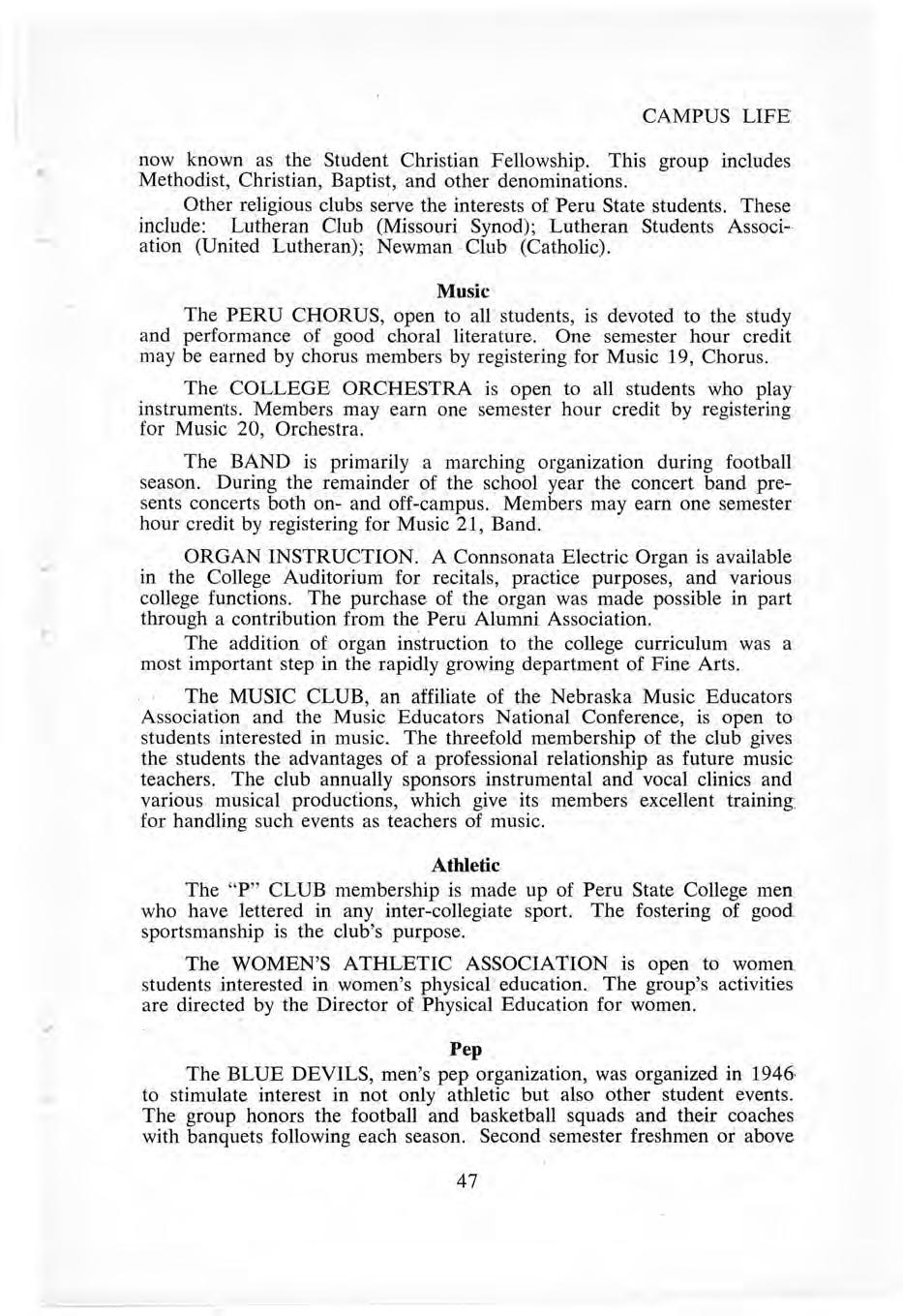
may pledge membership into the organization. In cooperation with the White Angels, women's - pep organization, 'the Blue Devils purchase varsity awards and provide scholarships with the revenue from the concessions at athletic events.
The WHITE ANGELS, women's pep organization, was organized in 1948 to promote good sportsmanship and school spirit on the campus. Only women with a grade point average of 5 are eligible. A branch club , the CHERUBS, sponsored by the White Angels, was organized in 1958 for the same purpose except that all women on the campus are eligible for membership.
ALPHA MU OMEGA, honorary mathematics fraternity, aims to develop and promote interest in the study of mathematics. Students who have or are currently enrolled in analytical geometry with above average grades in mathematics are eligible for membership. The monthly meetings, planned and conducted under student leadership, include investigations of subjects of mathematical interest not presented in the classroom. The fraternity is officially recognized as a branch of the National Council of Mathematics Teachers.
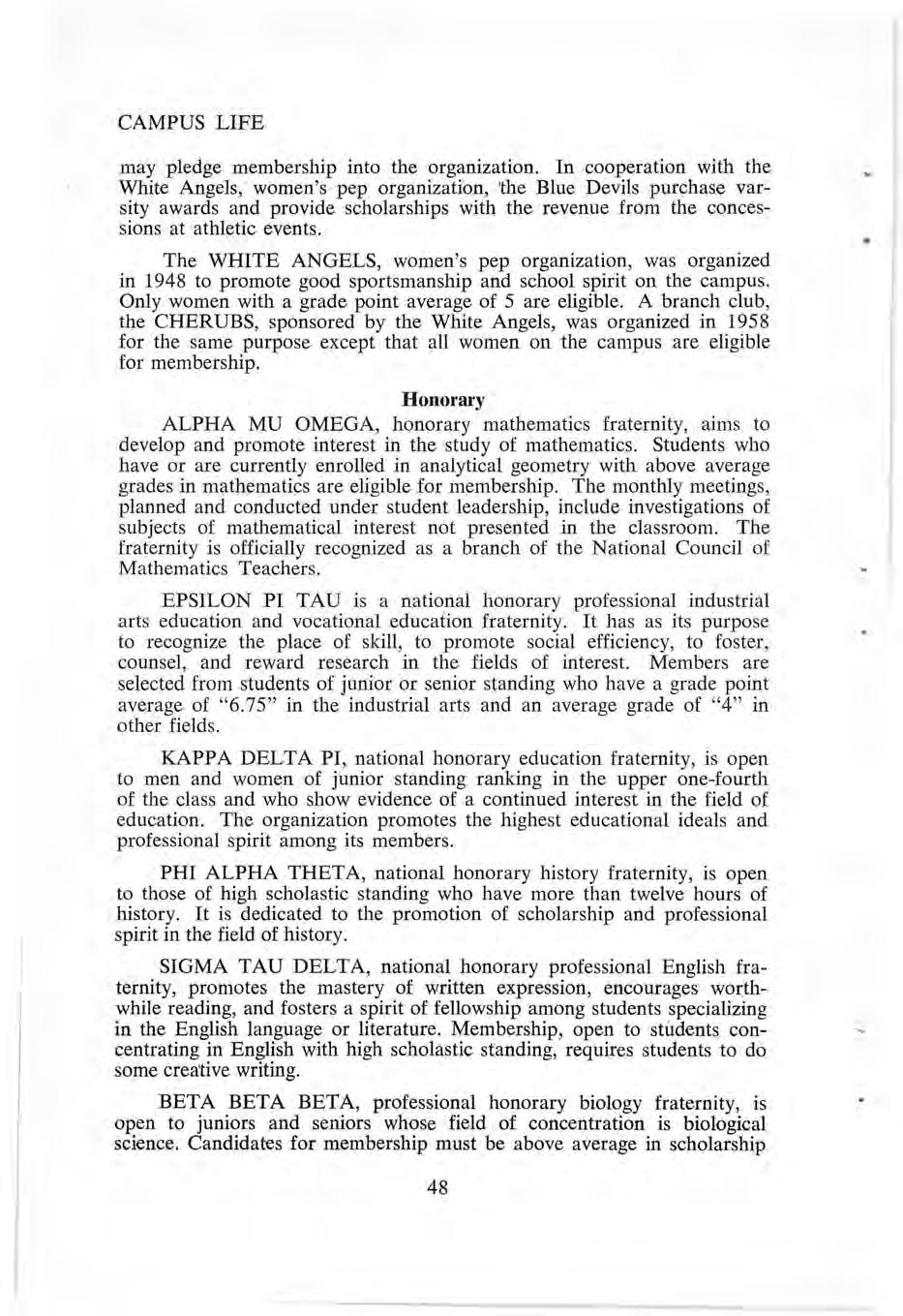
EPSILON PI TAU is a national honorary professional industrial arts education and vocational education fraternity. It has as its purpose to recognize the place of skill, to promote social efficiency, to foster, counsel, and reward research in the fields of interest. Members are selected from students of junior or senior standing who have a grade point average of "6.75 " in the industrial arts and an average grade of " 4 " in other fields .
KAPPA DELTA PI, national honorary education fraternity, is open to men and women of junior standing ranking in the upper one-fourth of the class and who show evidence of a continued interest in the field of education. The organization promotes the highest educational ideals and professional spirit among its members.
PHI ALPHA THETA, national honorary history fraternity, is open to those of high scholastic standing who have more than twelve hours of history . It is dedicated to the promotion of scholarship and professional spirit in the field of history.
SIGMA TAU DELTA, national honorary professional English fraternity, promotes the mastery of written expression, encourages worthwhile reading, and fosters a spirit of fellowship among students specializing in the English language or literature. Membership, open to students concentrating in English with high scholastic standing, requires students to do some crea'tive writing.
BETA BETA BETA, professional honorary biology fraternity, is open to juniors and seniors whose field of concentration is biological science. Candidates for membership must be above average in scholarship
and must plan to make biology their permanent interest. The fraternity promotes 'the study of biological problems and creates an interest in the field of biology as a profession.
WHO'S WHO Among Students in American Universities and Colleges annually determines the number of students who may be selected from students with senior standing in the College. These honorees are selected by a committee of students and faculty on the basis of scholarship, leadership and participation in academic and extracurricular activities, citizenship and service to the College, and promise of future usefulness in business and society.
THE PEDAGOGIAN, student newspaper, is edited and published by students under the supervision of a sponsor and the Board of Student Publications. It is issued bi-monthly during the school year. The staff is selected by the faculty advisor with the approval of the Board of Student Publications . The staff is reorganized with the beginning of each semester and summer session. The paper affords an excellent laboratory for students interested in the field of journalism as a profession or for the teacher of journalism.
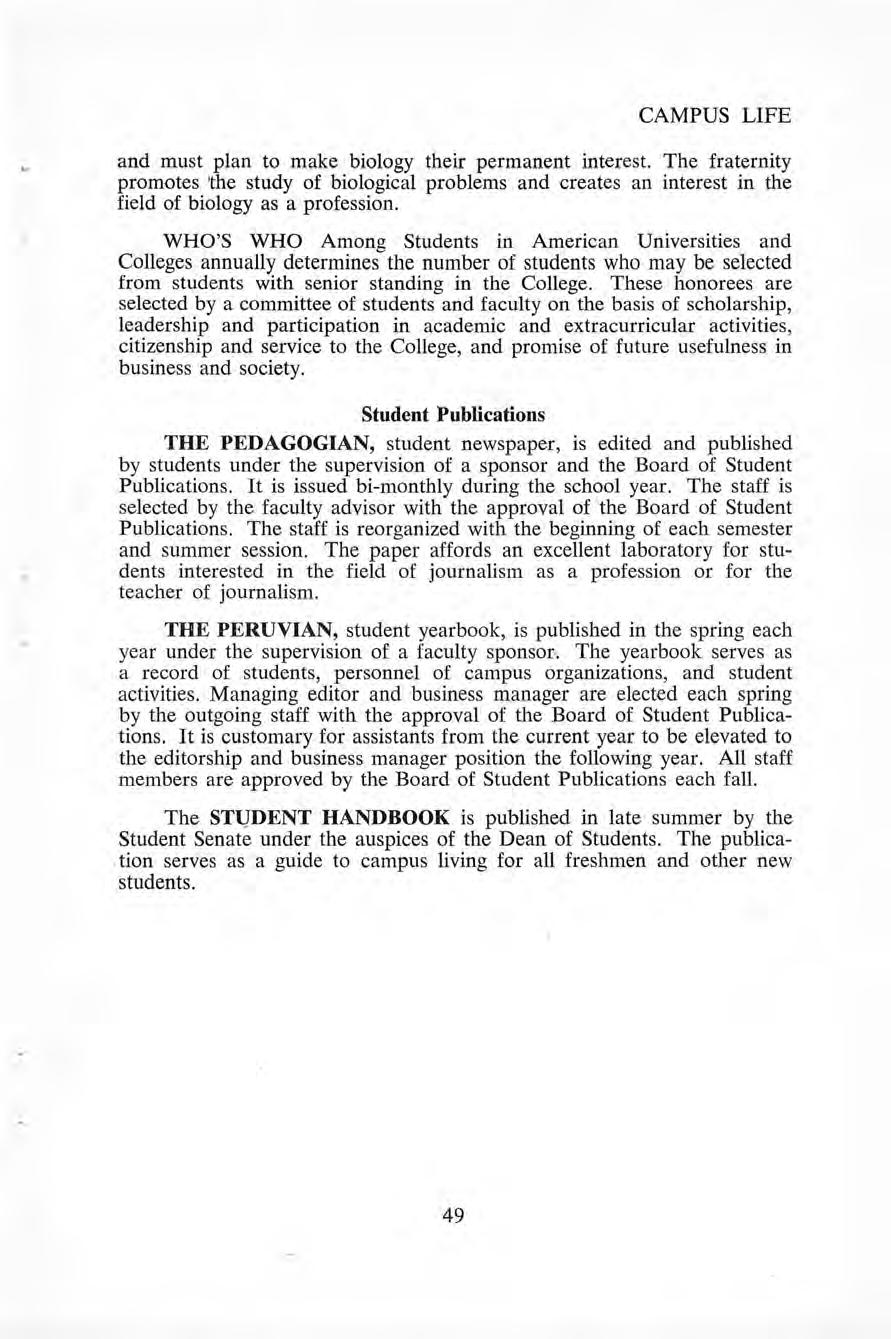
THE PERUVIAN, student yearbook, is published in the spring each year under the supervision of a faculty sponsor The yearbook serves as a record of students, personnel of campus organizations, and student activities. Managing editor and business manager are elected each spring by the outgoing staff with the approval of the Board of Student Publications. It is customary for assistants from the current year to be elevated to the editorship and business manager position the following year. All staff members are approved by the Board of Student Publications each fall .
The ST(JDENT HANDBOOK is published in late summer by the Student Senate under the auspices of the Dean of Students. The publication serves as a guide to campus living for all freshmen and other new students.
(1958-1959)
Alpha Mu Omega (honorary mathematics)
Arval Bohn
Beta Beta Beta (honorary biological) _ John C. Christ
Blue Devils (men ' s pep)
Commercial Club
Dr ama tics
Epsilon Pi Tau (honorary industrial arts)
Foreign Language Club
Albert 0 Brady
Glen Sheely
Hazel Weare
D
Moore
Owen Harlan
George Rath
Home Economics Club - Ina Sproul
Industrial Arts Club --
International Relations Club
Kappa Delta Pi
Lutheran Club
Lutheran Student Association
Music Educators National Conference
Newman Club
"P" Club
Dee V. Jarvis
George Schottenhamel
Alma Ashley
Rev. Leland Teuscher
Rev
Rathkamp
Gilbert Wilson
Rev. Zycmund Rydz
Jack McIntire
Phi Alpha Theta (honorary history) _ George Schottenhamel
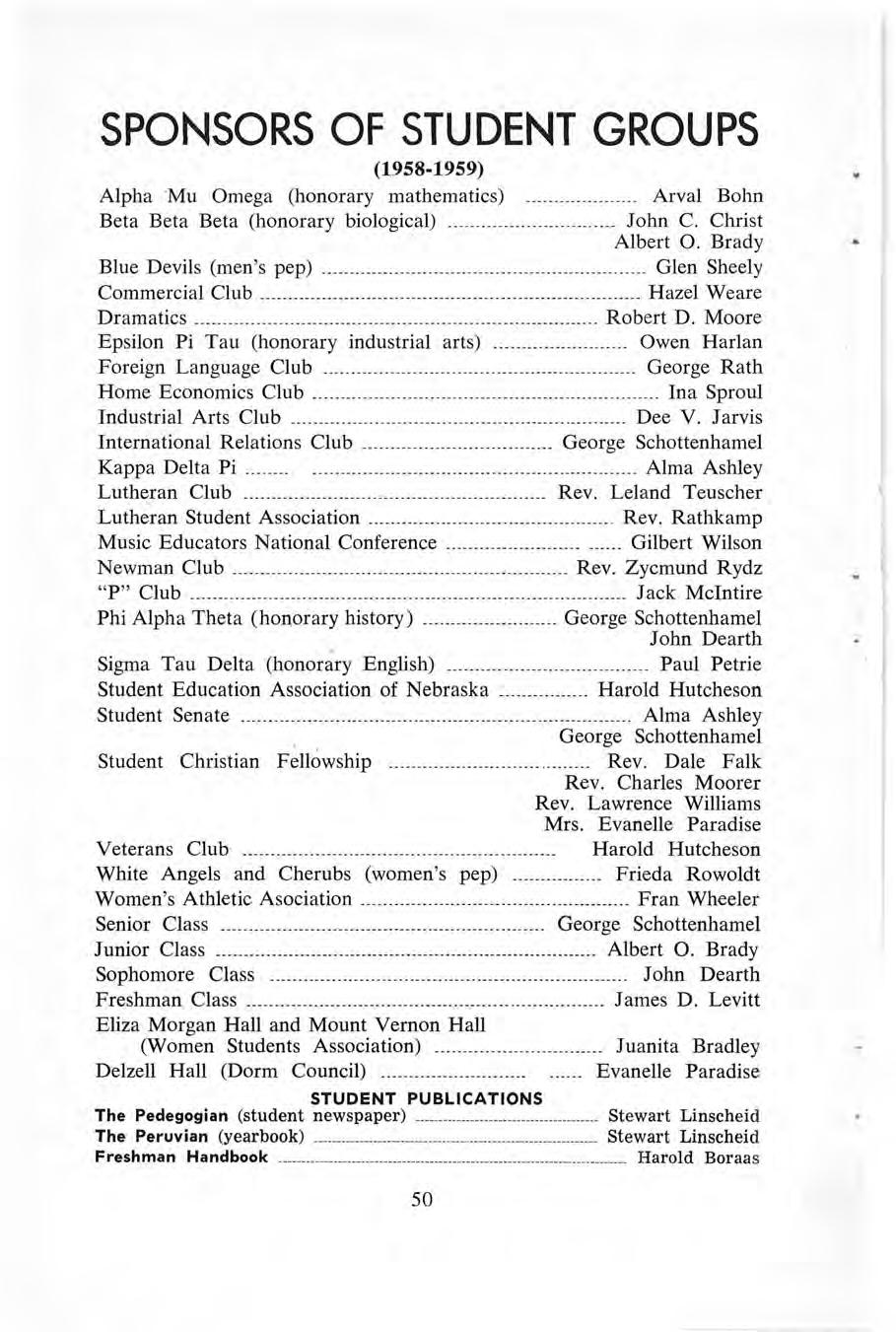
Sigma Tau Delta (honorary English)
Student Education Association of Nebraska
Student Senate
Student Christian Fellowship
John Dearth
Paul Petrie
Harold Hutcheson
Alma Ashley
George Schottenhamel
Rev . Dale Falk
Rev_ Charles Moorer
Rev. Lawrence Williams
Mrs. Evanelle Paradise
Veterans Club
White Angels and Cherubs (women's pep)
Women 's Athletic Asociation
Senior Class
Junior Class
Sophomore Class
Freshman Class
Eliza Morgan Hall and Mount Vernon Hall (Women Students Association)
Delzell Hall (Dorm Council) ------------------
STUDENT PUBLICATIONS
The Pedegogian (student newspaper) ---
The Peruvian (yearbook) - -
Freshman Handbook - -
Harold Hutcheson
Frieda Rowoldt
Fran Wheeler
George Schottenhamel
Albert 0. Brady
John Dearth
James D. Levitt
Juanita Bradley
Evanelle Paradise
Stewart Linscheid
Stewart Linscheid
Harold Boraa s
The College is supported by the state of Nebraska for the purpose of meeting the educational needs at the college level of the citizens of the state. Its chief purpose is to prepare men and women to serve in the elementary and secondary schools as teachers and for higher study in preparation as supervisors and administrators. The College also provides a general liberal education, pre-professional education, or terminal vocational education.
The instructional programs of the College consist of seven interrelated divisional programs under the captions of Division of Education
Division of Fine Arts
Division of History and Social Science
Division of Health and Physical Education
Division of Language Arts
Division of Practical Arts
Division of Science and Mathematics
To serve the students of the College with reference to the above program s, the courses offered under the several divisions are organized into curriculums, a term applied to a group of courses designed for an individual or for a group of individuals having a common purpose. The studies offered by the College include four-year professional curriculums in elementary education and in secondary education; a four-year liberal arts program flexible enough to satisfy a variety of interests; and a number of one-year and two-year terminal and pre-professional curriculums, including one-year and two-year curriculums in elementary education.
In general, the various curriculums offered by the College consist partly of general education courses and partly of specialized courses. The general education courses are those set forth and required by all individuals for effective living, regardless of their vocations. The specialized courses are those that prepare specifically for teaching or other vocations, or satisfy special avocational or cultural interests.
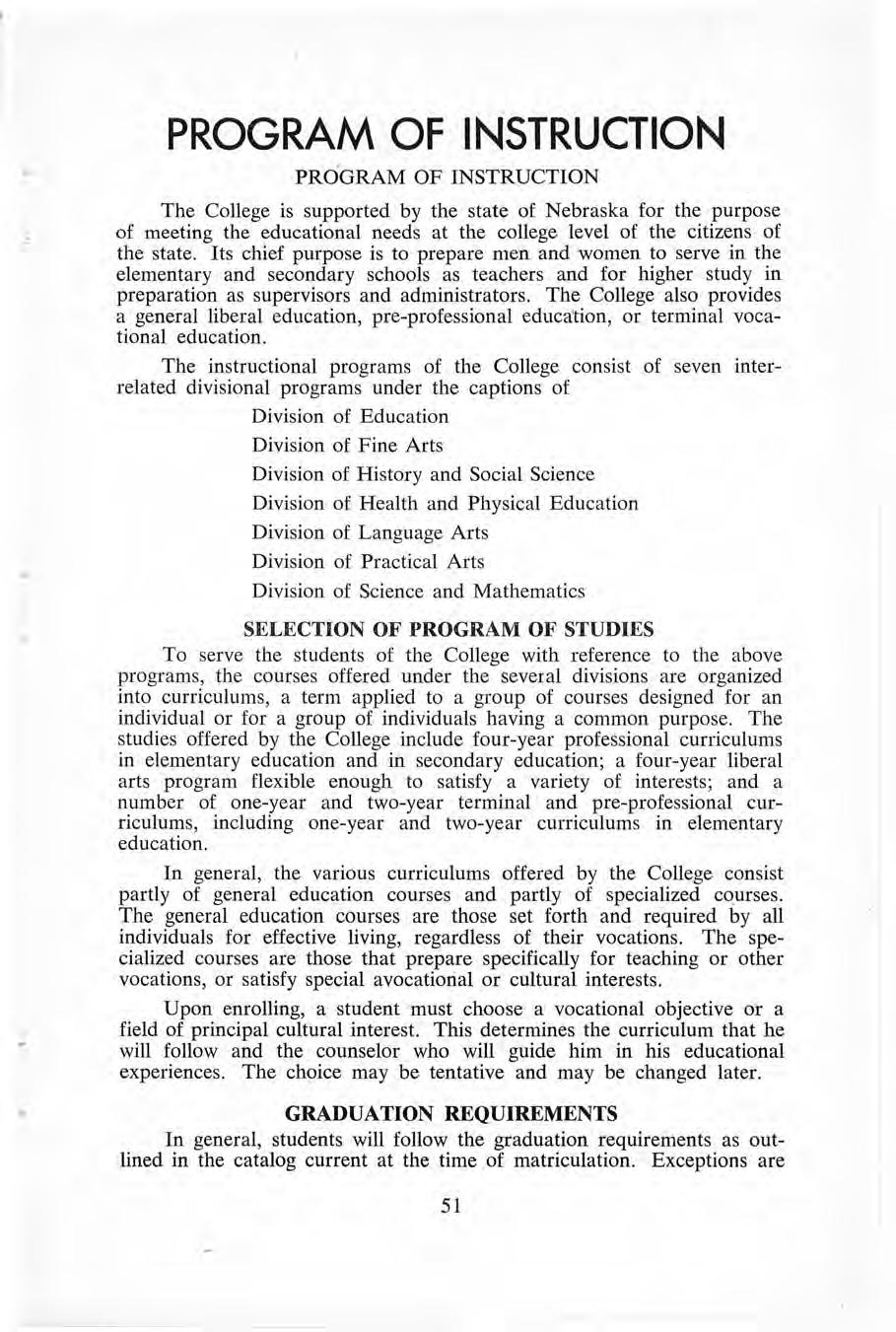
Upon enrolling, a student must choose a vocational objective or a field of principal cultural interest. This determines the curriculum that he will follow and the counselor who will guide him in his educational experiences The ch9ice may be tentative and may be changed later.
In general, students will follow the graduation requirements as outlined in the catalog current at the time of matriculation. Exceptions are
as follows: (1) students whose progress toward a degree has been irregular or interrupted to a point of five years or more since 'the date of matriculation will meet the requirements of graduation in the most recent catalog; (2) students for whom a progress sheet has been made and who are making normal progress toward a degree will continue in their original catalog.
Students matriculating on or after September 1957 are required to meet the requirement of two fields of concentration as described on page of this catalog.
The College is authorized by law and rules of the State Board of Education to issue the following degrees and diplomas:
Master of Science in Education (M.S. in Educ.)
Master of Arts in Education (M.A. in Educ,)
Bachelor of Arts in Education (A.B. in Educ.).This degree is given to candidates whose field of concentration is in one of the following divisions: Fine Arts, History and Social Science or Language Arts.
Bachelor of Music in Education (B. Mus. in Educ.)
Bachelor of Science in Education (B.S. in Educ.) This degree is given to candidates whose field of concentration is in one of the following divisions: Health and Physical Education, Practical Arts, Mathematics and Science, Elementary Education or Library Education .
Bachelor of Arts (A.B.) This degree is given to candidates without regard to field of concentration and without the professional education requirements.
Two-Year Diploma (Eligibility for Nebraska Junior Elementary Certificate)
One-Year Diploma (Eligibility for Nebraska General Elementary Certificate)
Students who complete satisfactorily the prescribed courses for the degree of Bachelor of Arts or Science in Education, or the two- or one-year diploma course, are eligible for recommendation for the certificate to which the curriculum completed entitles them. The office of the Registrar has the necessary information and forms relative to certification in Nebraska and will advise students. The Nebraska Commissioner of Education, upon receipt of properly executed application, transcript of college record, and recommendation, will issue the Nebraska certificate to which the applicant is entitled. The following is a brief summary of information relative to certificates issued by the Commissioner of Education in Nebraska:
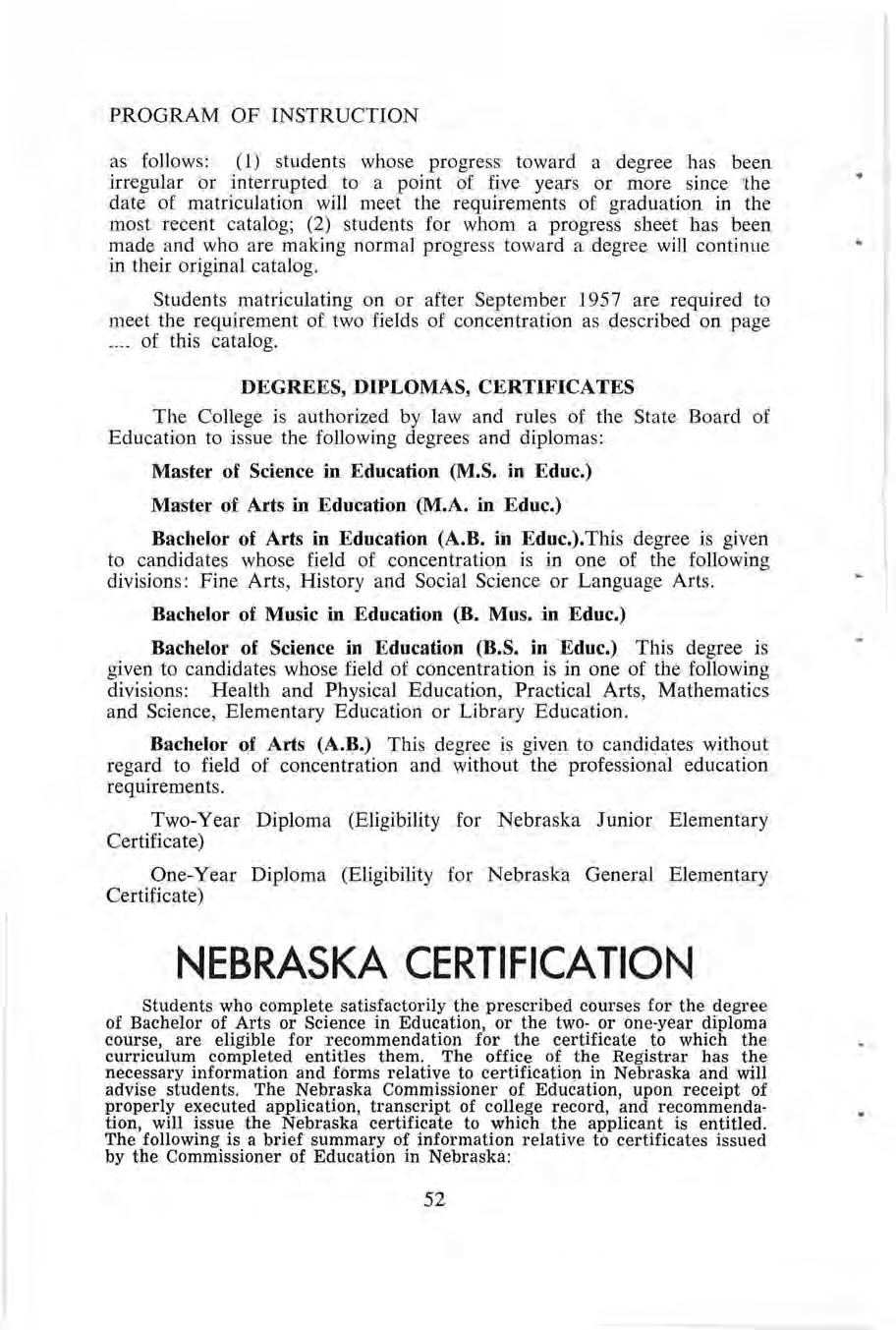
1. General Elementary Certificate. Requires the completion of the oneye ar rural education progr a m and the recomm e ndation of the colle ge. Valid for a one-year term in Class I Rural Districts. Renewable up to four times or until requirements have been met for the Junior 1£l e me ntary Certificate
2. Junior Elementary Certificate. Re quires the completion of th e twoyear elementary education program and th e recommendation of the college. Valid for a three-year term in all schools in kinder garten through grade eight. Ren e wable any number of times until the requirements for a degr ee are completed
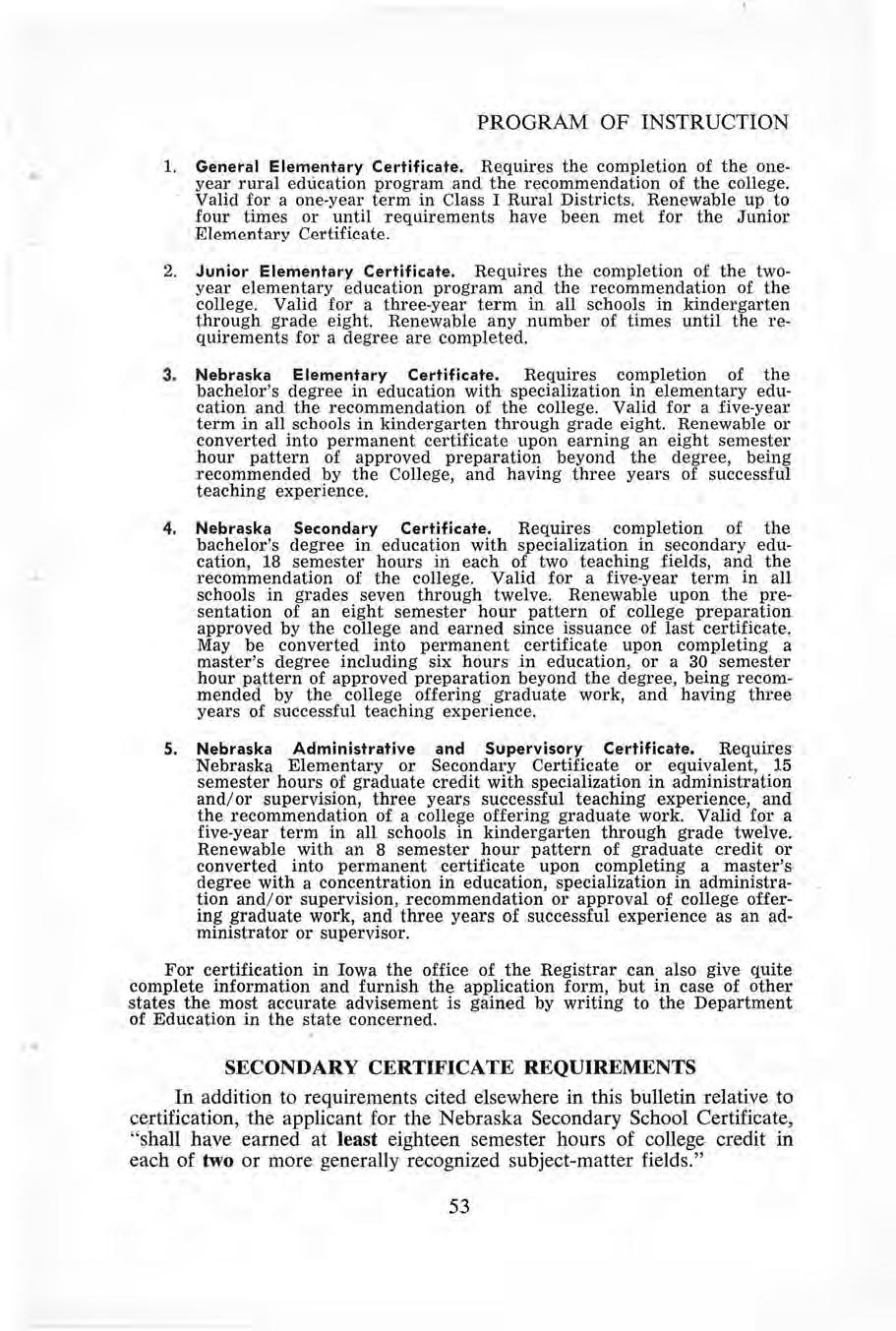
3. Nebraska Elementary Certificate. Requires completion of the bachelor 's degree in educ a tion with specialization in elementary education and the recommendation of the college. Val.id for a five-year term in all schools in kind e rgarten through grad e eight. Renewable or converted into permanent certificate upon earning an eight semester hour pattern of approved preparation beyond the degree, being recommended by the College, and h a vin g three years of successful teaching experience.
4 . Nebraska Secondary Certificate. Requires completion of the bachelor's degree in education with specialization in secondary education, 18 semester hours in each of two teaching fields, and the recommendation of the college . Valid for a five-year term in all schools in grades seven through twelve Renewable upon the presentation of an eight semester hour pattern of college preparation approved by the college and earned since issuance of last certificate. May be converted into permanent certificate upon completing a master ' s degree including six hours in education, or a 30 semester hour pattern of approved prep aration beyond the degree, being recommended by the college offering graduate work, and having three years of successful teachin g experience .
S. Nebraska Administrative and Supervisory Certificate. Requires Nebraska Elementary or Secondary Certificate or equivalent, 15 semester hours of graduate credit with specialization in administration and / or supervision , three years successful teaching experience, and the recommendation of a college offering graduate work. Valid for a five-year term in all schools in kindergarten through grade twelve. Renewable with an 8 semester hour pattern of graduate credit or converted into permanent certificate upon completing a master ' s degree with a concentration in education, specialization in administration and / or supervision, recommendation or approval of college offering graduate work, and three years of successful experience as an administrator or supervisor.
For certification in Iowa the office of the Registrar can also give quite complete information and furnish the application form, but in case of other states the most accurate advisement is gained by writing to the Department of Education in the state concerned .
In addition to requirements cited elsewhere in this bulletin relative to certification , the applicant for the Nebraska Secondary School Certificate , " shall have earned at least eighteen semester hours of college credit in each of two or more generally recognized subject-matter fields."
The generally recognized fields for Nebraska Secondary School Certification are:
Agriculture
Art
Biological or Life Science
Business Education
Elementary Education
English
Foreign Language
General Science
Health and Physical Education
History
Homemaking
Industrial Arts
Library Science
Mathematics
Music
Physical Science
Social Science or Studies
Speech
Special Education
If the candidate does not have 18 semester hours of college credit in each of two or more of the above generally recognized subject-matter fields, but has 18 semester hours of college credit in each of two related subjects such as English and Literature; or Vocal and Instrumental Music; or Chemistry and Physics; or Political Science and Geography, then the candidate must have also completed a planned program of general education of not less than forty semester hours.
According to Nebraska Teacher Certification laws, the College has the responsibility of recommending qualified persons for certificates. This responsibility has been delegated to the Policies Committee and means that this Committee must pass on the applicant's academic and professional qualifications, his character , and competence as a teacher. All applicants are hereby advised that by meeting graduation or shorter term scholastic requirements does not mean that one will be automatically recommended for certification.
In order to facilitate the action of the above committee, it is necessary that all applications be presented not less than three (3) weeks prior to the end of any term. All conditions and procedures described above must be met by all applicants seeking an initial certificate to be in force as of September, 1958, and is retroactive so far as any date of matriculation is concerned.
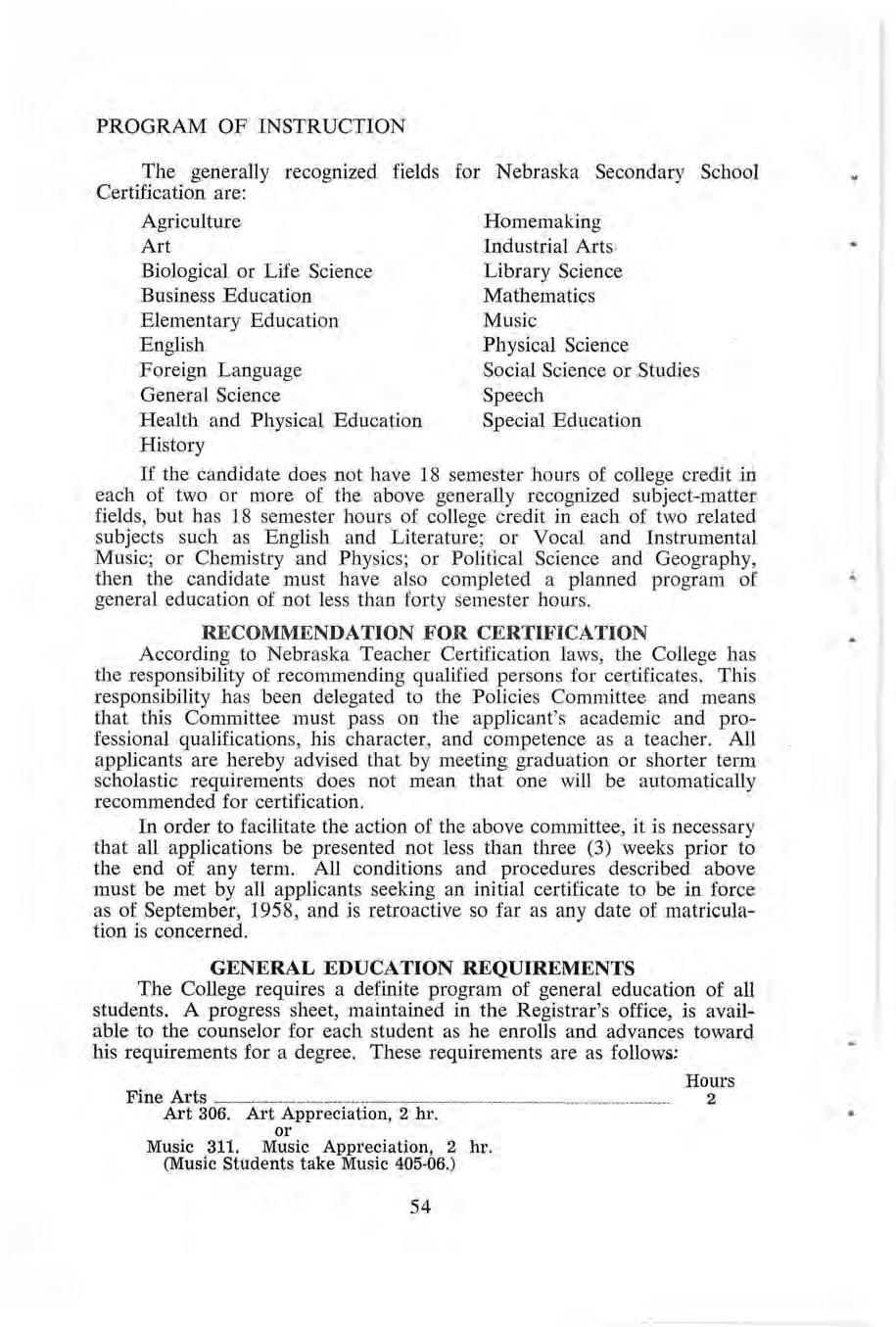
The College requires a definite program of general education of all students. A progress sheet, maintained in the Registrar's office, is available to the counselor for each student as he enrolls and advances toward his requirements for a degree. These requirements are as follows:
Fine Arts
Art 306. Art Appreciation, 2 hr. or Music 311. Music Appreciation, 2 hr. (Music Students take Music 405-06.)
Hours
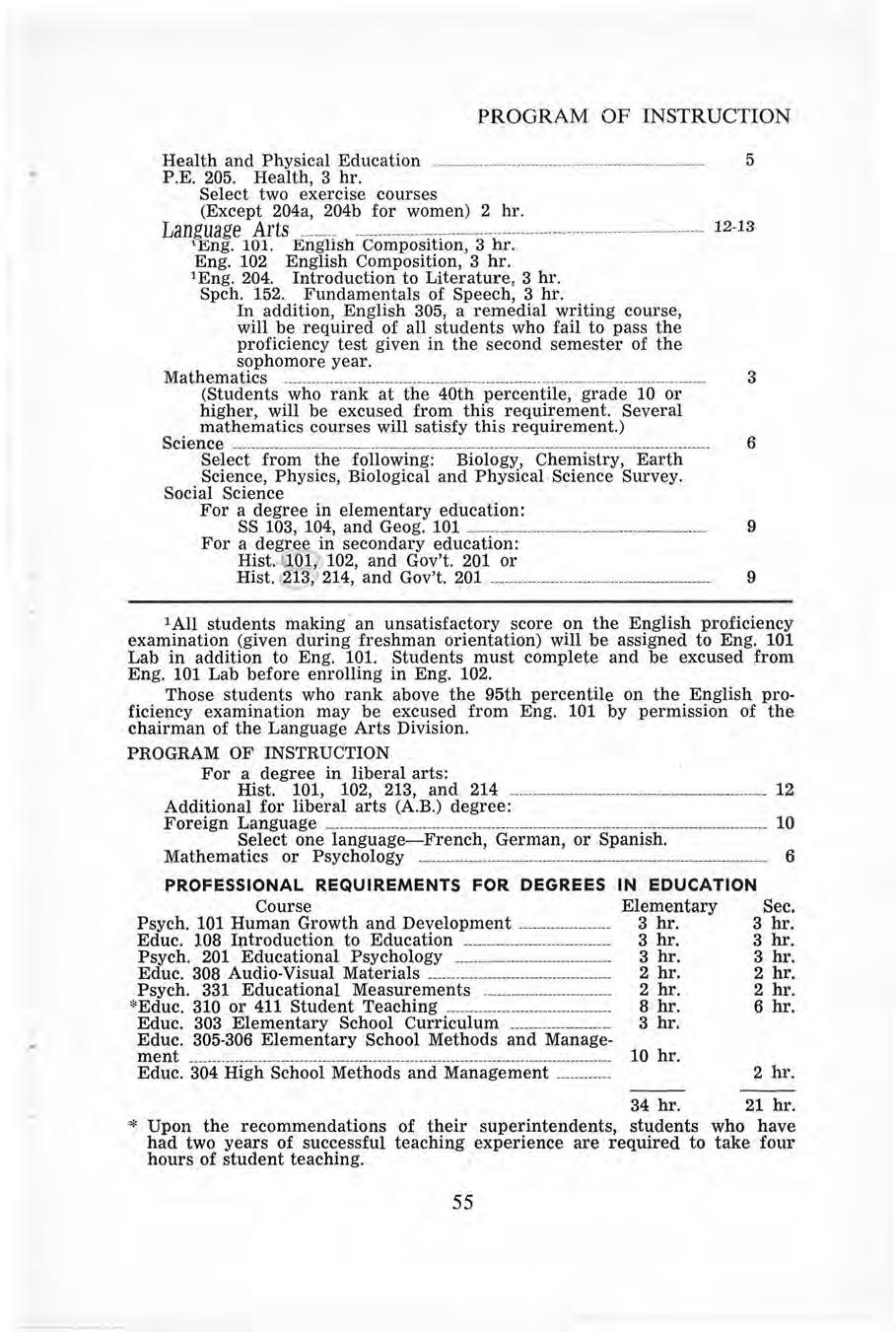
Health a nd Physical Education -
P .E. 205. H ea lth, 3 hr.
Select two exercise courses (Except 204a, 204b for women) 2 hr.
'En g . 101. English Composition, 3 hr .
· Eng. 102 English Composition, 3 hr.
1 Eng. 204. Introduction to Literature , 3 hr . Speh. 152 Fundam e ntals of Sp ee ch, 3 hr
In addition, En glish 305, a remedial writing course, will be required of all students who fail to pass the proficiency t es t given in the second semester of the sophomore year.
(Students who rank at the 40th percentile, grade 10 or hi gher , will be excused from this requirement. Several mathem a tics courses will satisfy this r e quirem e nt.)
Select from the following : Biology, Chemistry, Earth Science, Physics, Biological and Physical Science Survey.
For a degree in elementary education:
103, 104, and Geog . 101 -
1 All students making ·an uns a tisfactory score on the English proficiency examination (giv e n during freshman orientation) will be assigned to Eng. 101 Lab in addition to Eng . 101. Students must complete and be excused from Eng. 101 Lab before enrolling in Eng. 102.
Those students who rank above the 95th percentile on the English proficiency examination may be excused from Eng . 101 b y permission of the chairman of the Language Arts Division.
For a degree in liberal arts:
102, 213, and 214
(A.B.) degree:
* Upon the recommendations of their superintendents, students who have had two years of successful teaching experience are required to take four hours of student teaching.
SPECIAL
In addition to the above, 12 or more hours in each of four academic fields are required .
In addition to the professional requirements listed above, a course for two or more hours credit in special methods of teaching must be earned. These courses are given by the various academic divi sions
Total Hours. A candidate for a degree must earn 125 semester hours of course credits.
Upper-Level Credit. For the education degree s th e total must include 40 hours of upper-level credit (300 and 400 series). All 400 courses with a -suffix of G carry either graduate or undergraduate credit.
Grade Point Average. A minimum grade average of 4.00 is required for all undergraduate degrees
Resident Credit. A student who has not been enrolled in on-campus classes within the ten years prior to application for graduation, must earn a minimum of nine hours of on-campus credit in order to qualify for a diploma or degree. The resident credit must be to the extent of 24 hours of the last 30 hours on the degree, and a corresponding proportion thereof as to a one-year or two -ye ar diploma. By decision of the Sta te Board of Education , this resident requirement may be waived in cases where any of the required resident credit is earned in any one of the four Nebraska State Teachers Colleges
Correspondence and Extension Credit. Not more than one-fourth of the total requirements for a diploma or a degree may be satisfied through correspondence study and extension classes, and of this number the correspondence study alone cannot exceed one-eighth of the total hours . While studycenter or off-campus classes are considered as extension classes, this college will honor the same as equivalent to the campus evening classes for undergraduate credit and so carry resident credit if the classes are conducted by this college.
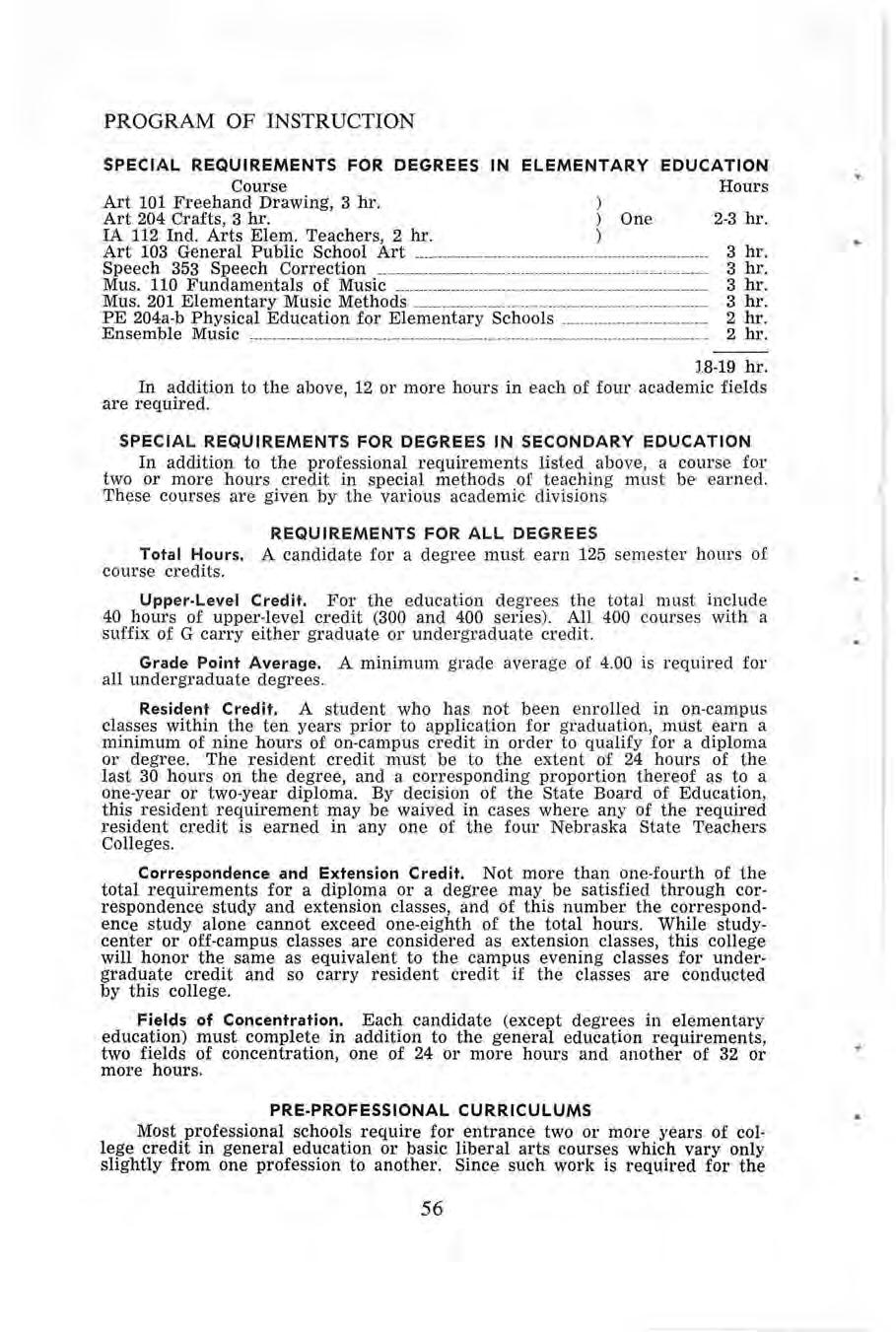
Fields of Concentration. Each candidate (except degrees in elementary education) must complete in addition to the general education requirements , two fields of concentration, one of 24 or more hours and another of 32 or more hours.
Most professional schools require for entrance two or more years of college credit in general education or basic liberal arts courses which vary only slightly from one profession to another. Since such work is required for the
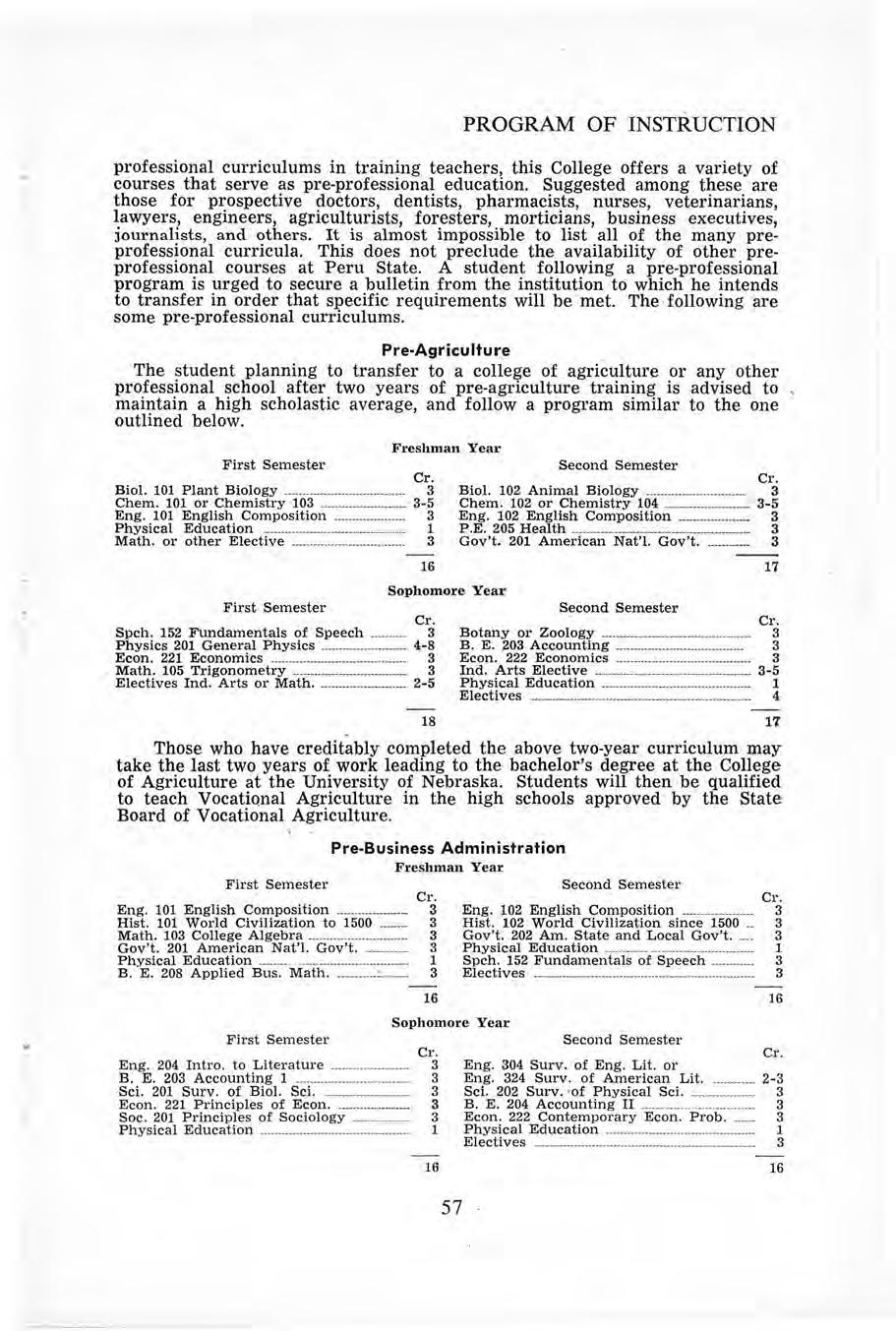
professional curriculums in training teachers, this College offers a variety of courses that serve as pre-professional education. Suggested among these are those for prospective doctors, dentists, pharmacists, nurses, veterinarians, lawyers, engineers, agriculturists, foresters, morticians, business executives, journalists, and others. It is almost impossible to list all of the many preprofessional curricula. This does not preclude the availability of other preprofessional courses at Peru State . A student following a pre-professional program is urged to secure a bulletin from the institution to which he intends to transfer in order that specific requirements will be met. The -following are some pre-professional curriculums.
The student planning to transfer to a college of agriculture or any other professional school after two years of pre-agriculture training is advised to maintain a high scholastic average, and follow a program similar to the one outlined below.
Those who have creditably completed the above two-year curriculum may take the last two years of work leading to the bachelor's degree at the College of Agriculture at the University of Nebraska. Students will then be qualified to teach Vocatiqnal Agriculture in the high schools approved by the State Board of Vocational Agriculture.
Students interested in the study of law should examine carefully ·the requirements for admission into the law college to which they expect to transfer. Some law colleges require the baccalaureate degree for admission, some require three years of general college, and others require only two years for tidmission.
The following program of studies is desigJJ.ed to meet the above various requirements Following the completion of three years at Per u and the successful completion of one year in an accredited law college, a student may be awarded the B A. degree
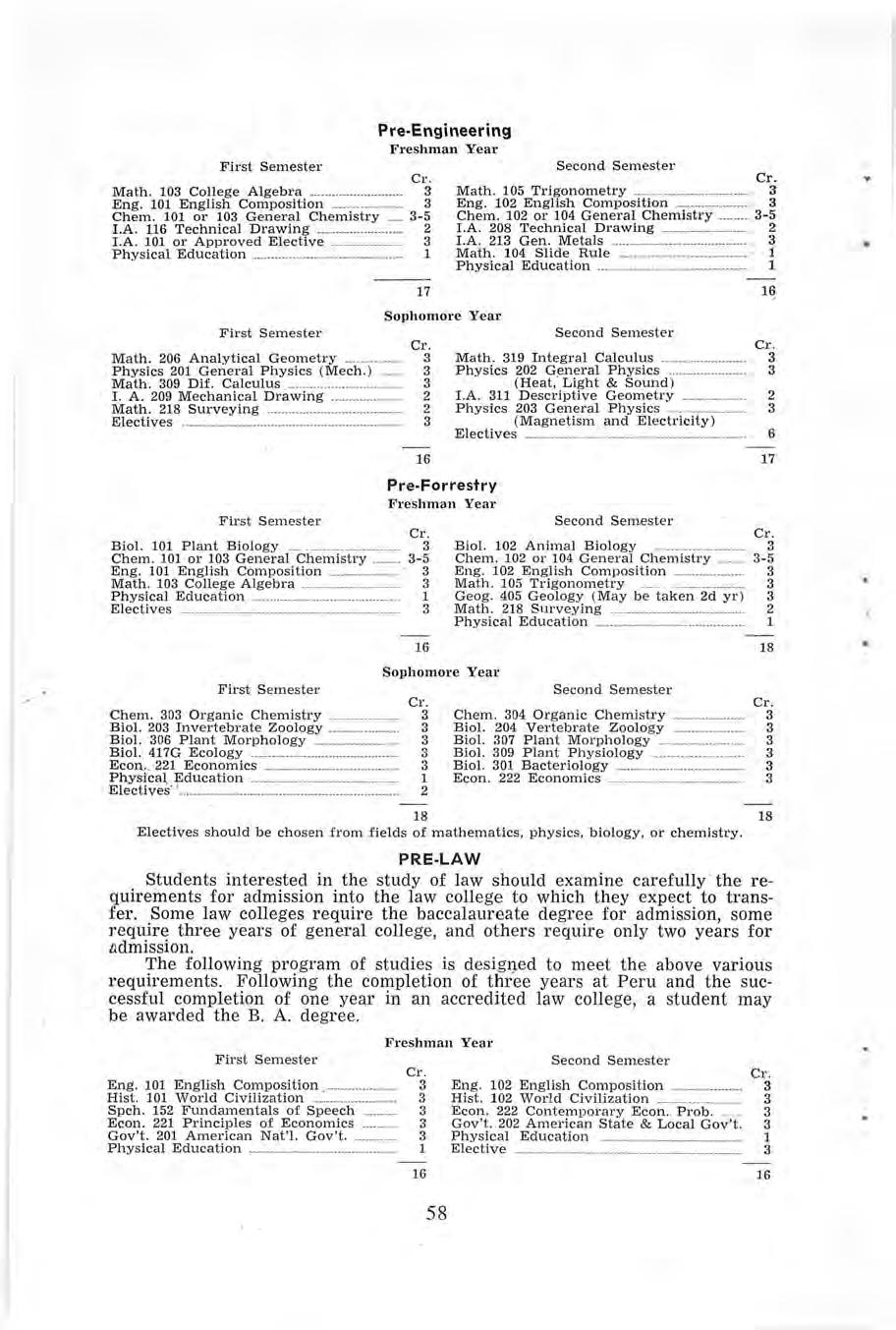
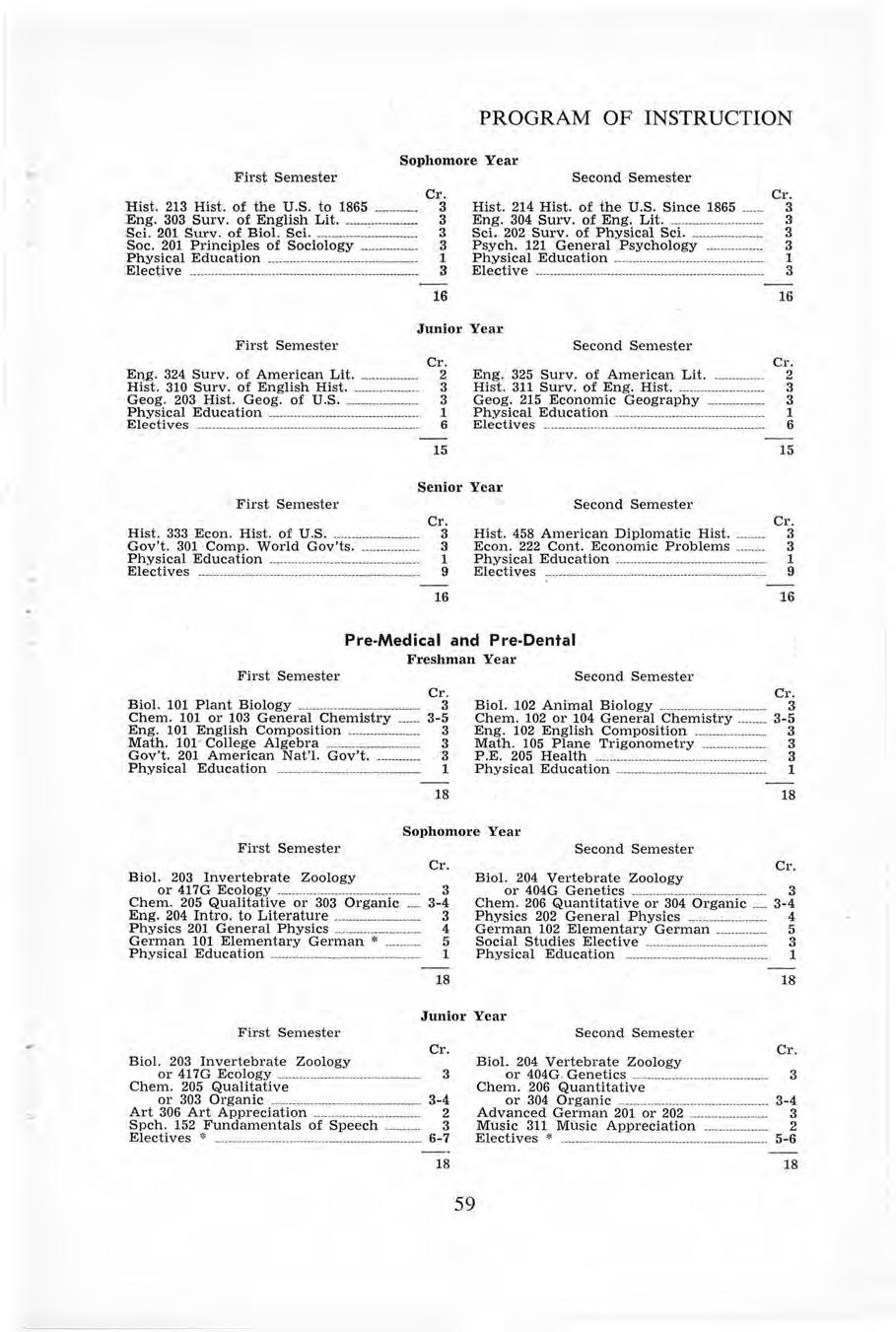
Senior Year
First Semeste r
Finish all required courses not taken previously.
M ee t all loc a l requirem e nt s for the B.A D egree.
Total course s t a ken mu s t not exceed 18 semester hours.
Second Semester
F inish a ll required courses not t a ken pr eviously
Mee t all local requirements for the B.A Degree ·
S e lect cultural courses as El e c t ives .
• S e l e ct electives to gain a w id e cultura l program . Courses in the f ie ld s of botan y, psychology, so cial studies, hi story, music , or the hum a niti es are ex cellen t. Choos e cours es not related to spe cific medica l requirements in order to acquire a broad cultur a l b ac kground. Sup e rior work i s e xpe cte d of a ll pr e -medic a l st ud ents in all courses. P erso n s with poor s chola rs hip are no t accepted in medic a l or dental s chool s.
Some Colleges of Nursing require two years (60 semester hours) of prenursing, others require les s. Students following a pre-nursing curriculum should know the requir e ments of the particular School of Nursing to which they will transfer . The program below, ba sed on two semesters and one summer, will me e t the requir e ments to enter the University of Ne braska School of Nursing.
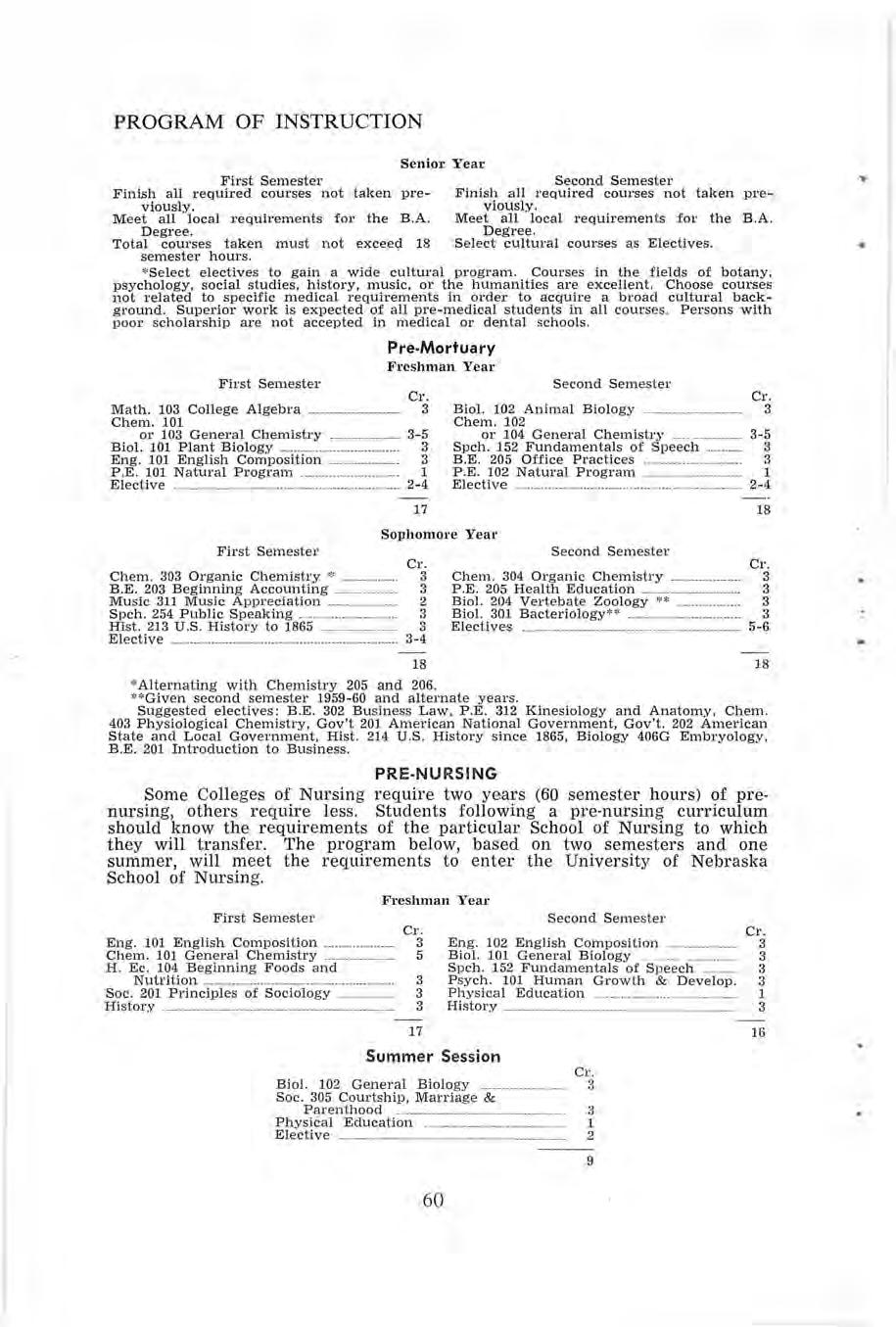
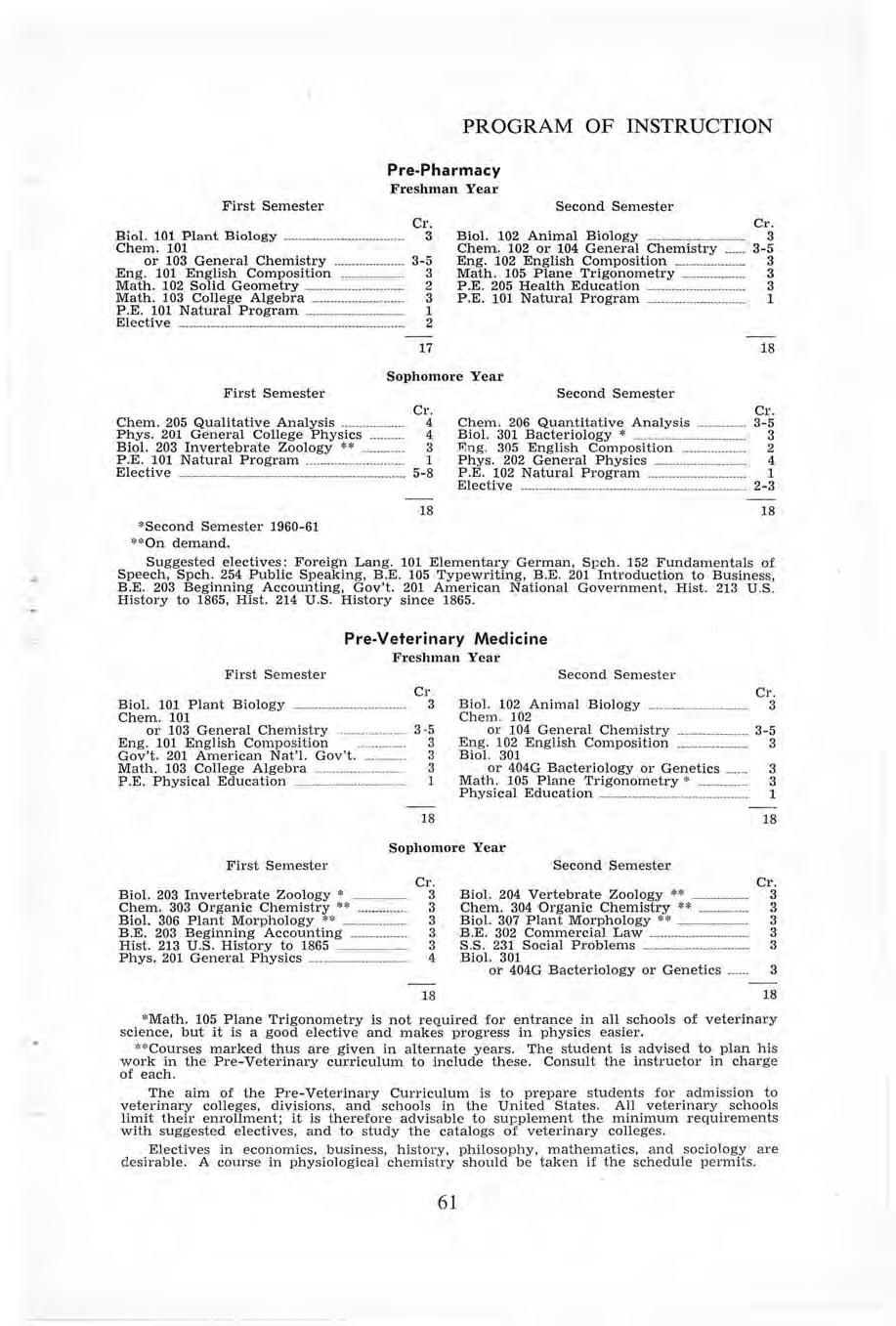
*Math. 105 Plane Trigonome try is not required for e ntr ance in all schools of veterinary sc ienc e, but it is a goo d e l ec tiv e and makes progress in ph ys ics easier.
'''* Courses marked thu s are given in alternate years. The st ud ent is a dvi sed to plan his work in the Pre- V eterinary curriculum to include th ese. Consult the instructor in charge of each.
Th e aim of the P re - Veterinary Curriculum is to prepare s tudent s for admission to veterinary colleges, divisions, and s chool s in th e Unit ed States. All vet eri nary schools limit their enro llm ent; it is therefore advisabl e to supp le ment the minimum requir ements with s uggested e l ect iv es, a nd to st ud y the catalogs of veterinary colleges.
El e ctives in economics, business, h istory, philosophy, mat h emat ic s, a nd s ociology· a re desirab l e. A course in physiological chemistry shou ld be take n if the sched ul e p e rmi ts
SEMI-PROFESSIONAL AND TERMINAL
Students who are unable to attend college four years or more and wish to prepare for vocations requiring less time in preparation will find a variety of educational opportunities in this College. There are increa si ng opportunities today for young people in the occupational area classified as semi-professional. Examples of these are Medical Technology and X-Ray Technology which are described below A student interested in an occupation in the above classification should know the requirements of the particular professional or technical school to which he will transfer. It will then be possible for a counselor to assist him in making a parallel program of the required formal college courses.
In the Education Division are these curriculums:
Two-Year Curriculum in Elementary Education.
One-Year Curriculum in Rural Education.
(Complete descriptions of curriculums in education reqmrmg less than four years are outlined under the Education Division .)
To qualify for admission to a College of Technology, students are required to ea rn 60 semester hours of college credit. The program for the first two years as outlined below meets the above requirement. Also, a student may wish to qu a lify for a degree in which case he should follow the suggested program for the third year. This, however, should be approved and cleared with the Registrar before following a degree program.
The following course is recommended for students who may wish to b e X-Ray Technicians and also earn a Bachelor of Science degree. Upon completion of the program su ggeste d b e low, the student may transfer to a College of Radiolo gy.
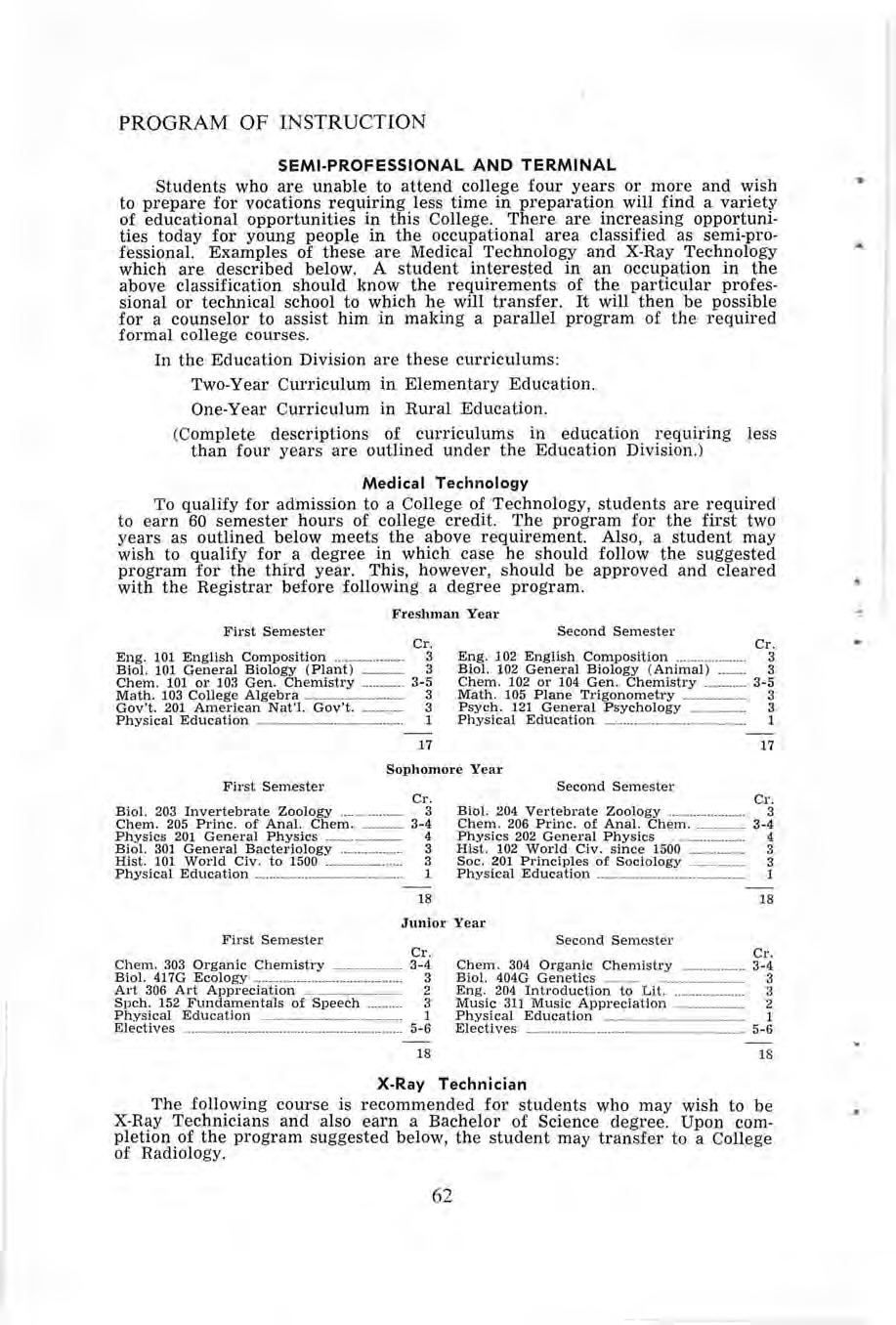
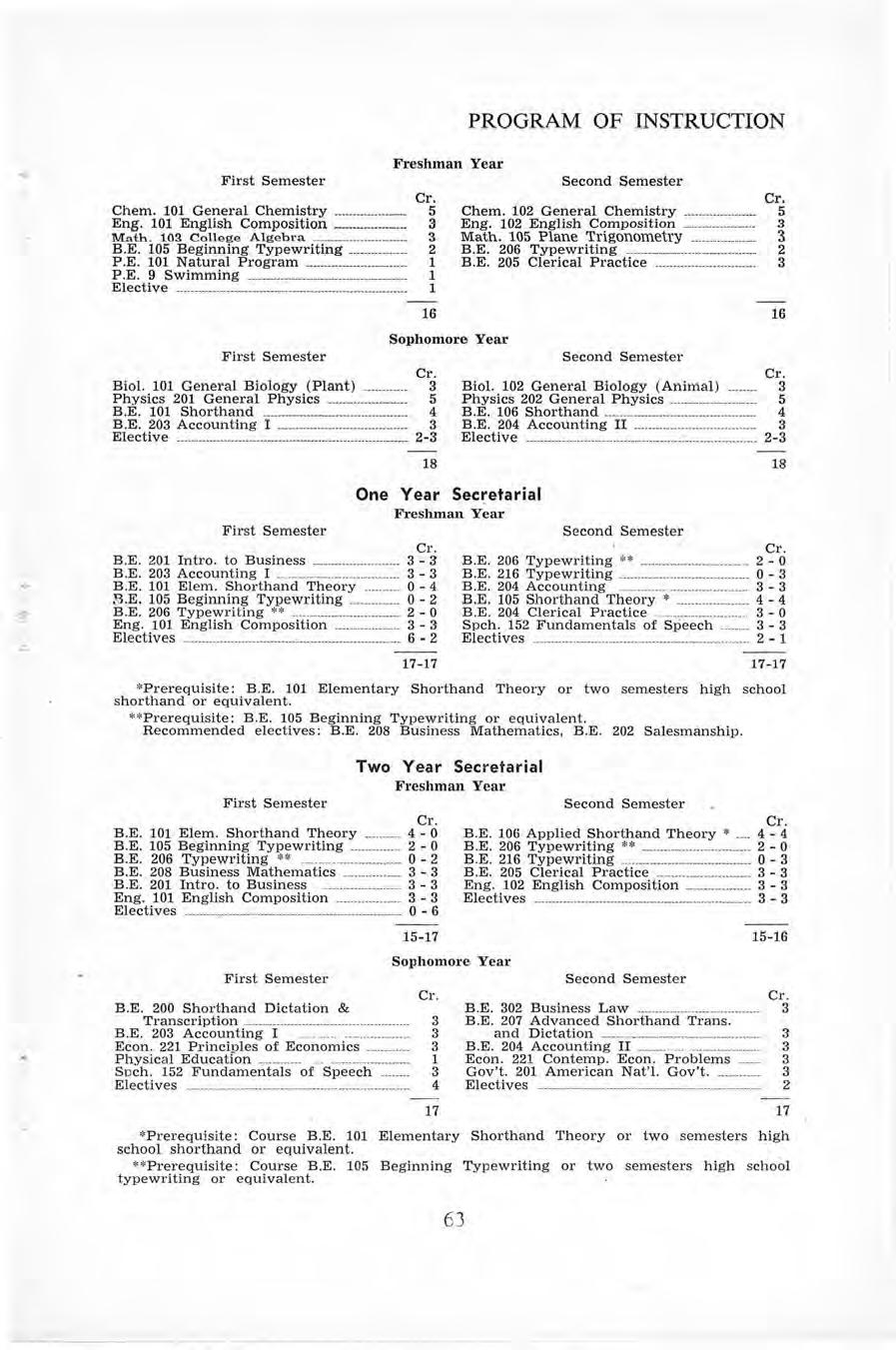
*Prerequisite: B.E. 101 Elementary Shorthand Theory or two semesters high school shorthand or equivalent .
** Pr e requisite: B .E 105 Beginning Typewritin g or eq uivalent. Recomm en ded
: B E. 208 Business Mathematics , B.E. 202 S a lesmanship.
Other Terminal Courses
With the asistance of counselors, students also may elect courses which will prepare them in one or two years for the following fields of work :
1. All students who desire to be recommended for a ·teacher's certificate must make application for admission to the teacher education curricula.
2. All one-year teacher candidates will apply for admission to teacher education curricula during the first month of their freshman year; two-year teacher candidates will make such application before the end of the first nine weeks of the second semester of their freshman year; four-year teacher candidates, before the end of the second semester of their sophomore year. Transfer students of junior or senior standing must make an application for admission to the teacher education curicula during the first month after matriculation.
3. Applications should be filed in the office of the Chairman, Committee on Admission to the Teacher Education Curricula .
4 . Each applicant for admission into teacher education curricula will be evaluated as a prospective teacher. The evaluation of the candidate will be made in terms of health, emotional stability, intellectual vigor, personality, and character traits . The evaluation will include tests, references, scholastic records, and personal interviews. A grade point average of 5.00 or better is essential for admi ssion.
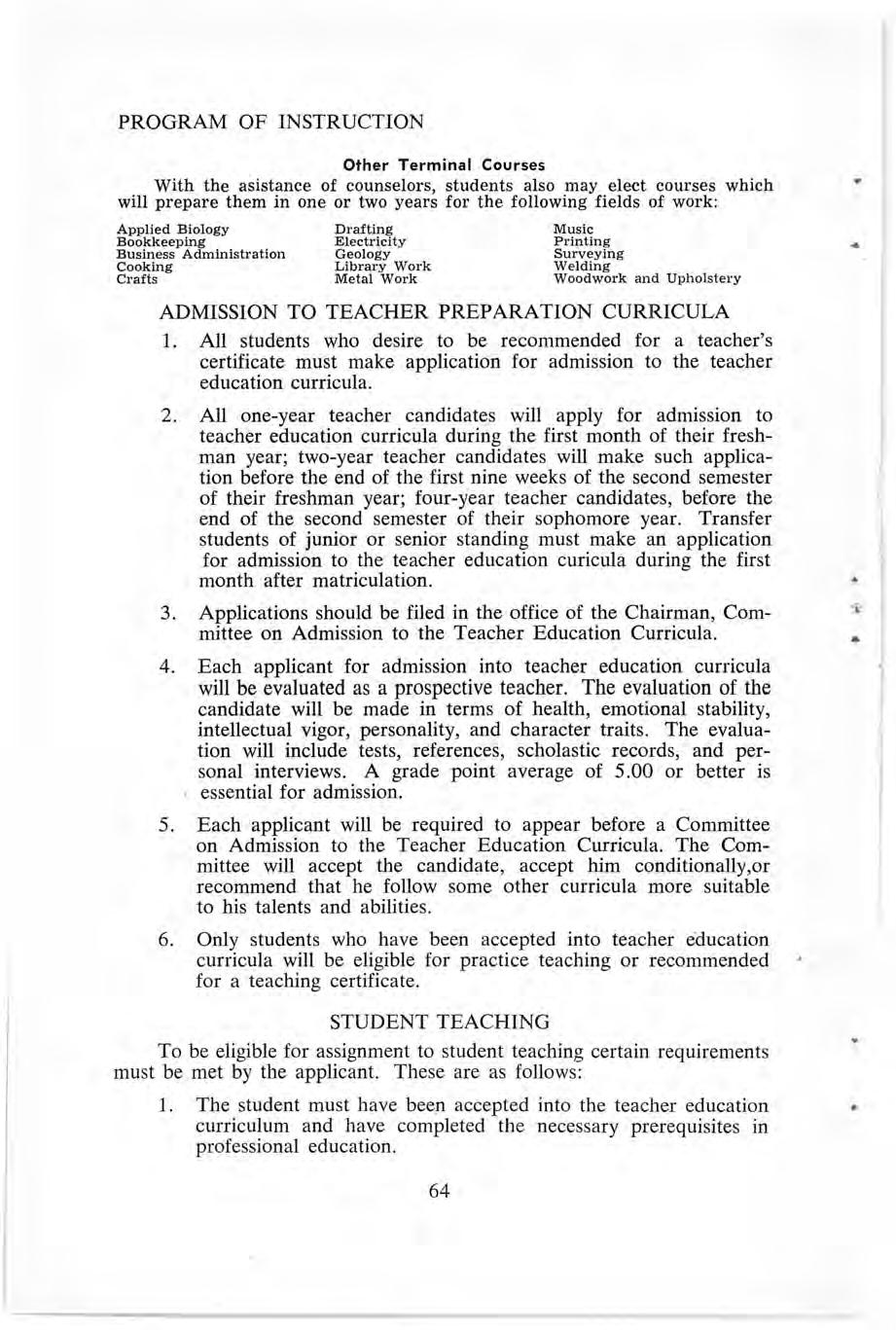
5. Each applicant will be required to appear before a Committee on Admission .to the Teacher Education Curricula. The Committee will accept the candidate, accept him conditionally,or recommend that he follow some other curricula more suitable to his talents and abilities.
6. Only students who have been accepted into teacher educat ion curricula will be eligible for practice teaching or recommended for a teaching certificate. ·
To be eligible for assignment to student teaching certain requirements must be met by the app licant. These are as follows:
1. The student must have bee n accepted into the teacher education
curriculum and have completed the necessary prerequi sites in professional education.
2. The student must have earned a grade point average of at least 5 .00 on all college work attempted, and have earned a grade of 5.00 or better in each course which is applied to a field of concentration, and be in good standing.
3. The student in both the two-year and four-year curriculums must present evidence that he will have sufficient credits for the two-year diploma or degree, respectively , one calendar year from the date of the first assignment to student teaching
4 . He must obtain approval from hi s counselor , the Chairman of the Personnel and Scholarship Committee , the Heads of the Divisions of his teaching fields , and the Director of Student Teaching.
5 . Student teaching at Peru is done in a full-time " block" . Student teachers in the elementary school devote nine weeks to teaching one or more grades. Secondary school student teachers spend six weeks fulltime in teaching high school classes . Student teachin g is done both in the T J Majors Campus School and in approved off-campus school s .
6. Upon the recommendation of their superint endents , students who . have had two years of successful teaching experience are required to take four hours of student teaching .
A faculty enactment on December 1, 1958 authorized the establishment of a plan to be known as a 'Professional Seme ster ' for prospective teachers at the secondary school level. The plan is to be in effect, starting in September 1960 . It is imperative that the program of studies for all junior and sophomore students in secondary education for the 1959-1960 academic year , be made with the greatest care and consideration for the time that these students will be in the ' Profes sional Semester ' of their senior year .
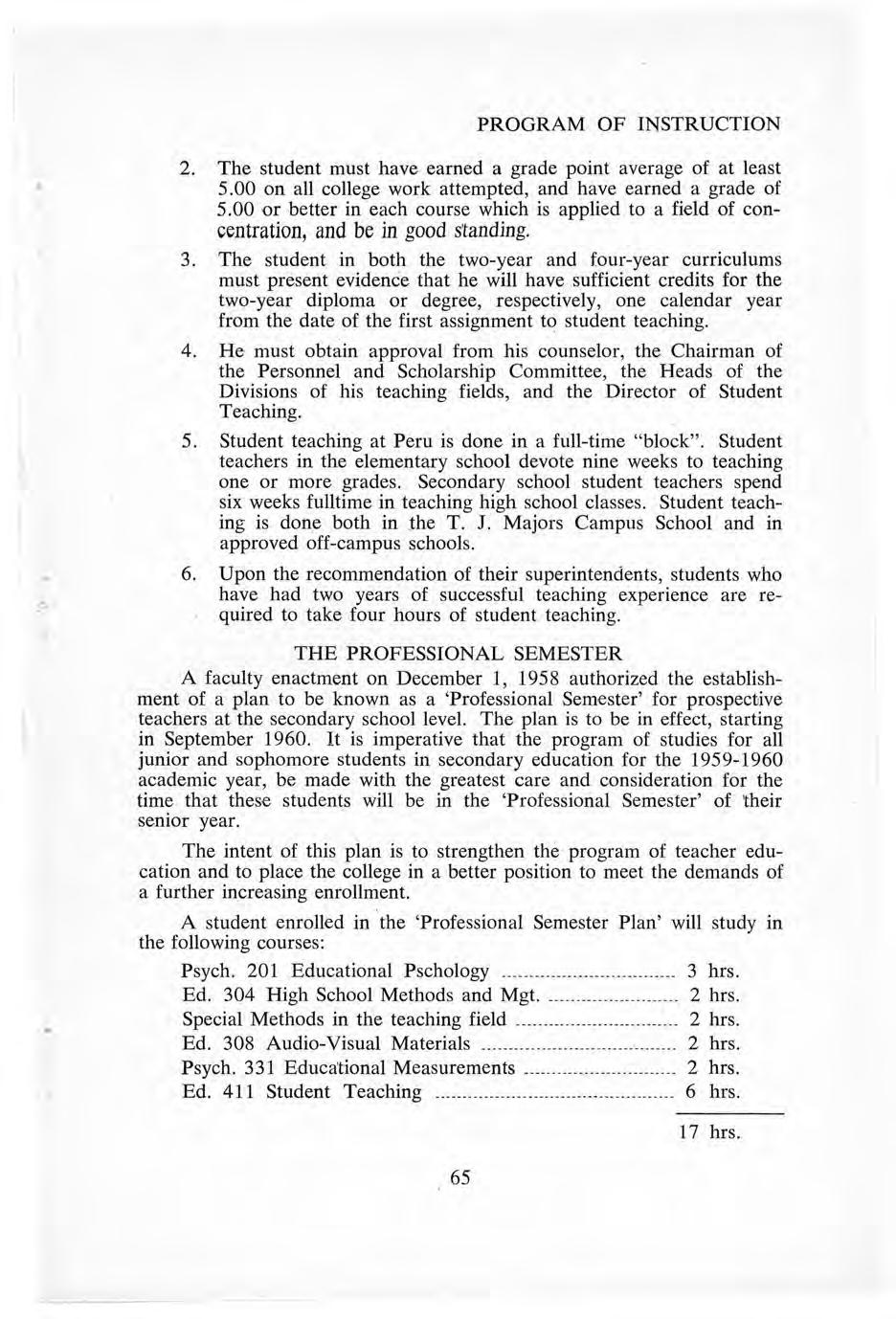
The intent of this plan is to strengthen the program of teacher educa tion and to place the college in a better position to meet the demands of a further increasing enrollment.
A student enrolled in the ' Professional Semester Plan' will study m the following courses:
The first three weeks of the semester will be spent in class work, after which the group will be divided into Sections A and B. Section A will spend the next six weeks student teaching while Section B will continue with class work. At this point, some of the students will be placed in cooperating secondary schools in the area served by the college. During the next six weeks period, Sections B and A will be reversed - Section B will practice teach while Section A will return for class room instruction The last three weeks of the semester will be spent evaluating the student teaching experience.
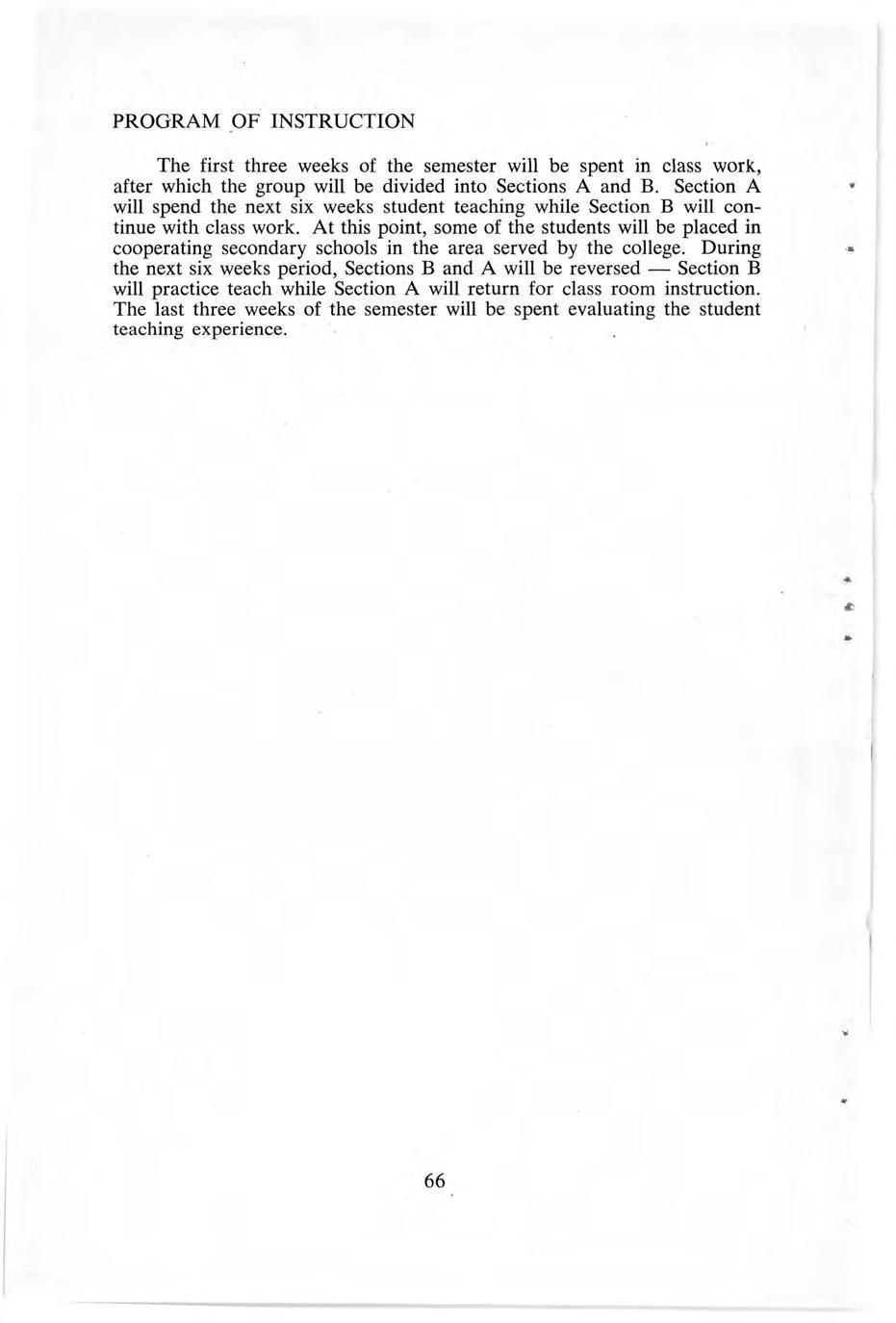
Maryon Adams
Alma Ashley
Uarold Doraas
Juanita Bradley
Ruth S. Brown
Lillian Christ
Mary Clarke
Charlotte Davies
Virgil DeZwarte
B. A. Eddy
Doroth y Iversen
Harold Johnson
Max Lan g ham
Frank Masek
Keith L . Melvin Frieda Rowoldt
Glen Sheely
Richard Van Pelt
Geraldine Straw
Darrell Wininger
Zelma Wonderly
The Division of Education has as its major function the preparation of the best possible teachers for Nebraska elementary and secondary schools. Readiness to teach is conditioned by a variety of factors. One of the most important of these factors is provided by the other divisions of the college: i.e , mastery of the subject matter to be taught. . Other important factors, although of interest to all divisions of the college, are prim arily the responsibility of the Division of Education. Among these are:
1. Und ersta nding of human growth and development.
2. Good mental health and rational behavior.
3. Awareness of the teacher candidate of his own problems, the way in which these problems affect his pupils, and how he can adapt his behavior to minimiz e the neg a tive consequences of these problems.
4. Sensitivity to factors which influence learning.
5. Sufficient poise and self-confidence for classroom l ea dership.
6. Skill in cooperation
7. Professional attitude .
8. Knowledge and ability to apply basic principles of learning in the classroom
Students compl e tin g the suggested curriculums will, with the recommendation of the school, qualify for certification to teach in the schools of Nebraska and in other states.
The following teacher eJucaUon programs are offered :
Four-Year Program in Elementary Education .
Two-Year Program in Elementary Education
One -Year Program in Rural Education.
Four-Year Program in Secondary Education .
Four-Year Prog,ram in Elementary Education
The following program will need to be taken by students entering the four-year curriculum in September, 1959.
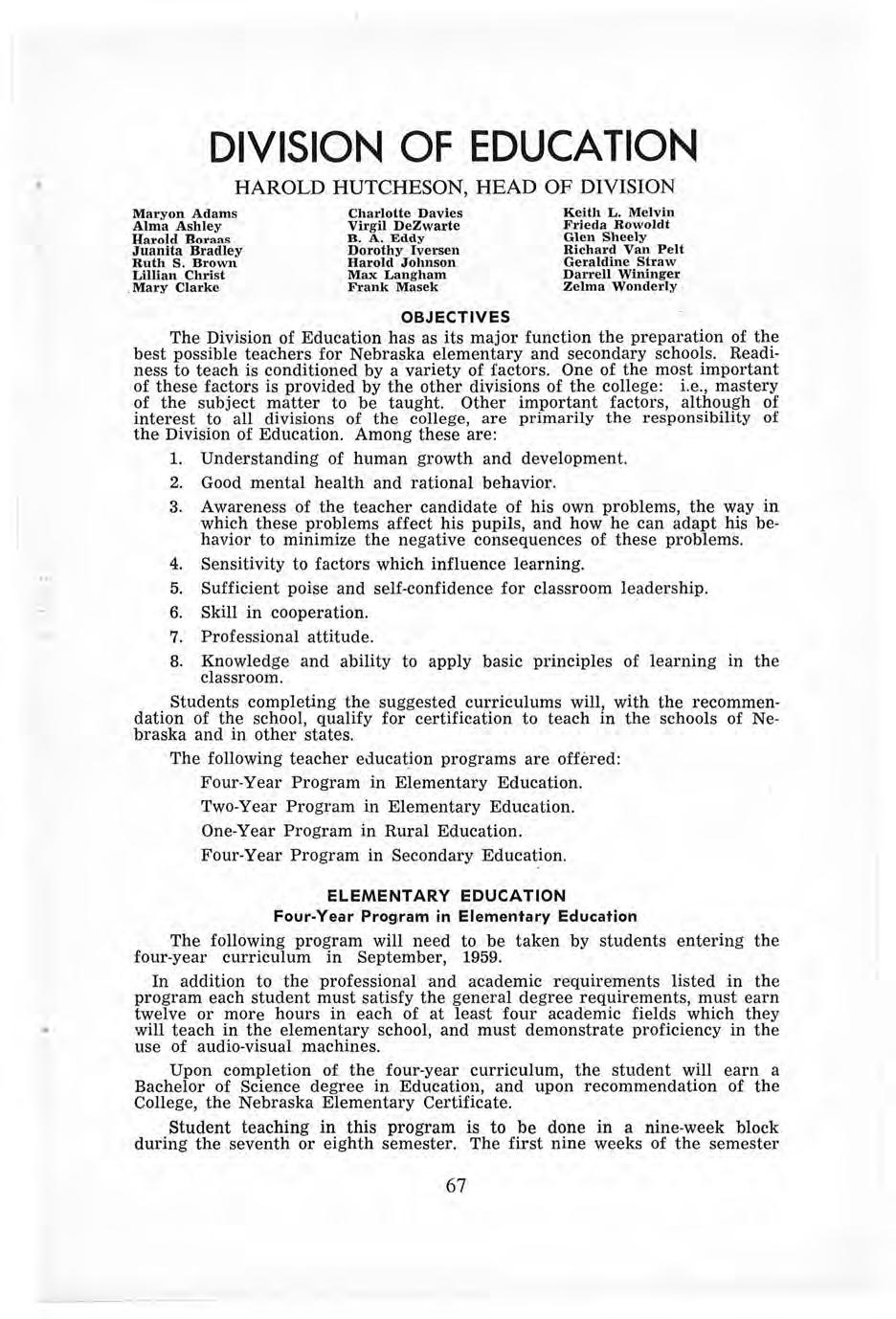
In addition to the professional and academic requirements listed in th e program each student must satisfy the general degree requirements, must earn twelv e or more hours in each of at least four academic fields which they will teach in the elementary school, and must demonstrate proficiency in th e us e -of audio-visual machines.
Upon completion of the four-year curriculum, the student will earn a Bachelor of Science de gree in Education, and upon recommendation of the College, the Nebraska Elementary Certificate.
Student teaching in this program is to be done in a nine-week .block during the seventh or eighth semester. The first nine weeks of the semester
will be spent on courses in methods and management while the entire time of following nine weeks will be devoted to student teaching.
Upon completion of this curriculum, the student will earn a two-year diploma, and if recommend e d by the college, the Nebraska Junior Elementary Certificate. Students will be admitted to this curriculum in their freshman year. Two-year elementary teachers must enroll in either Group A or Group B for student teaching
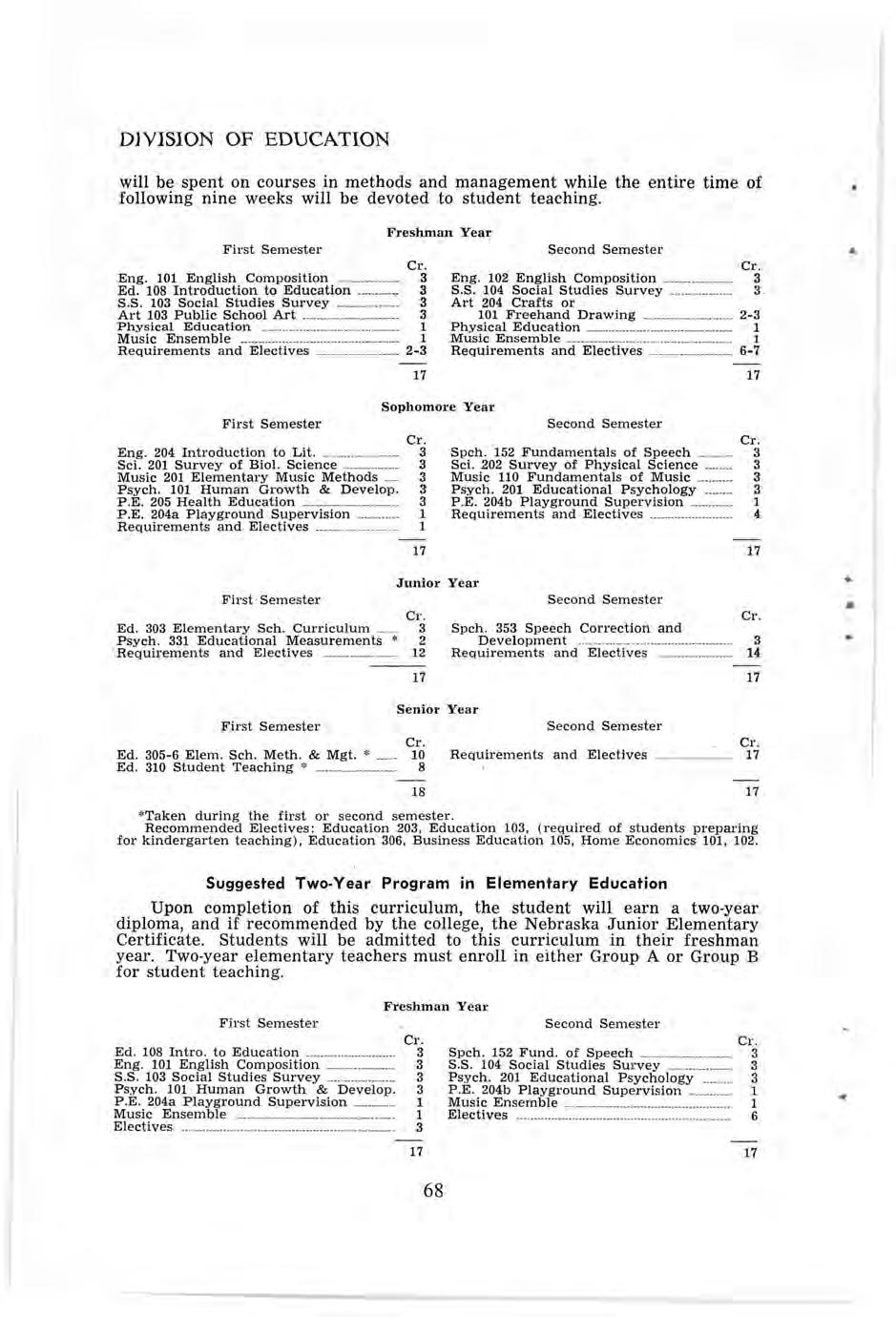
Education 305-306, Elementary School Methods and Management is organized in the following units:
Education 305 : 5 hours.
Unit I-Reading and other Language _ Arts. Unit II-Social Studies and Language Arts .
Education 306: 5 hours
Unit III-Ma thematics and Science. Unit IV-Management.
Th ese units are scheduled a s follow s :
II I IV
1 :00 Unit III III I
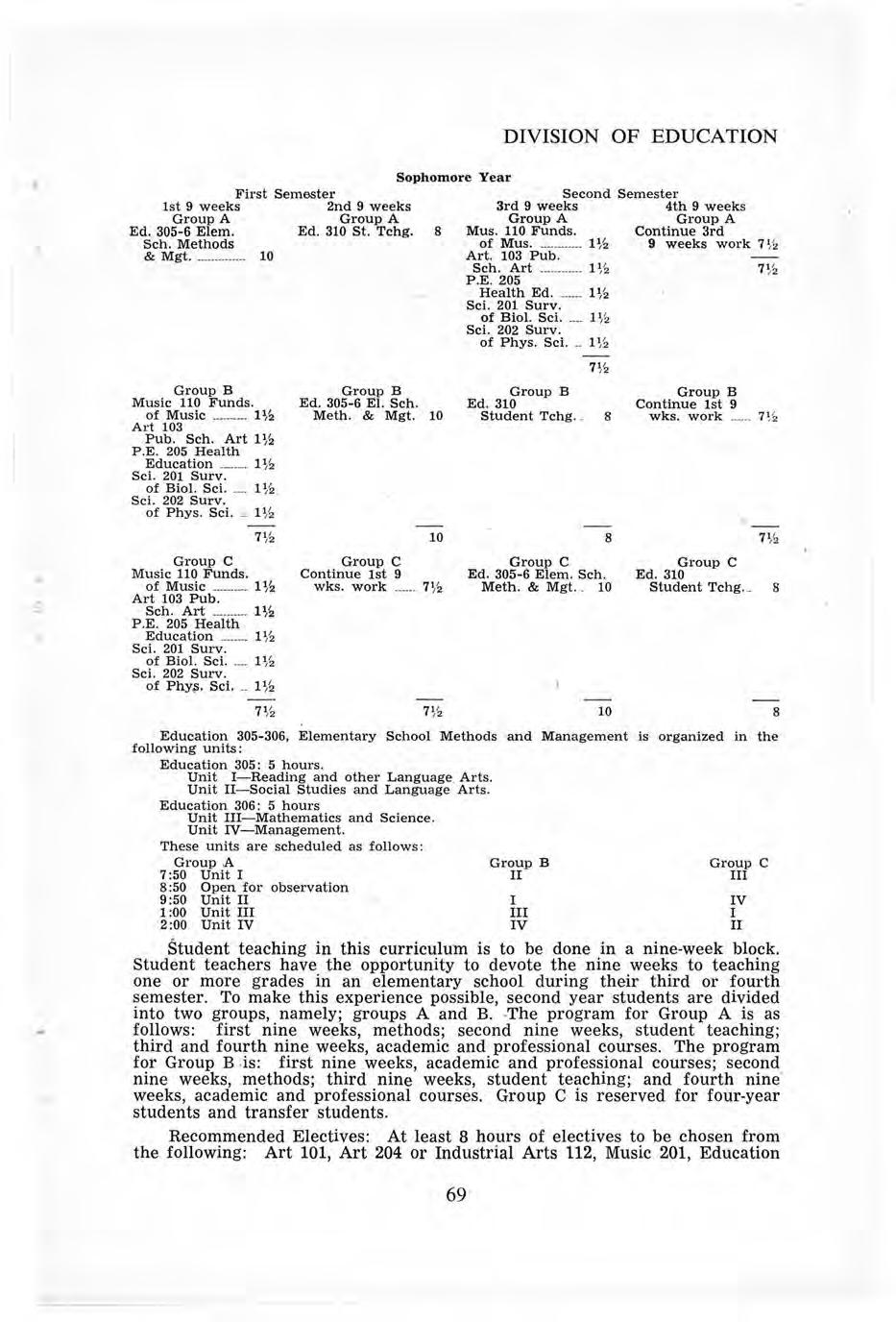
2 :00 Unit IV IV II
Student teaching in this curriculum is to be done in a nine-week block Student teachers have the opportunity to devote the nine weeks to teaching one or more grades in an elementary school during their third or fourth semester . To make this experience possible, second year students are divided into two groups, namely; gro ups A and B. -The program for Group A is as follows: first nine weeks, methods; second nine weeks, student teaching; third and fourth nine weeks, academic and professional courses. The program for Group B is: first nine weeks, academic and professional courses; second nine weeks, methods; third nine weeks, student teaching; and fourth nine· weeks, academic and professional courses. Group C is reserved for four-year students and transfer students .
Recommended Electives: At least 8 hours of el ectives to be chosen from the following: Art 101, Art 204 or Industrial Arts 112, Music 201, Education
203, Business Education 105, Home Ee. 101 or 102, or Education 103, which is required of students preparing for kindergarten teaching.
Suggested One-Year Program in Rural Education
After completion of the following curriculum and the fulfillment of the requirement in the use of audio-visual machines, the student will earn a oneyear diploma. With th e recomm endation of the College, the student will also earn a Nebraska General Elementary Certificate valid for one year in Nebraska rural (class 1) schools. Students must apply for admission to this curriculum immediately after matriculation.
It should be noted th a t the One-Year Program requires the completion of one full year of work (two semesters and one summer).
The program below is to be taken by students entering the four-year curriculum in September, 1959 .
In addition to the professional and academic requirements listed in the program, each student must satisfy the general degree requir e ments and complete the requirements for two teachin g fields. Requirements are listed under the several divisions A minimum of twenty-four hours must be earned in one teaching field and a minimum of 32 credit hours must b e ea rned in another teaching field.
Upon the completion of the four-year curriculum, the student will earn a Bachelor of Arts in Education or Bachelor of Science in Education degree and, upon recommend a tion of the College, the Nebraska Secondary School Certificate.
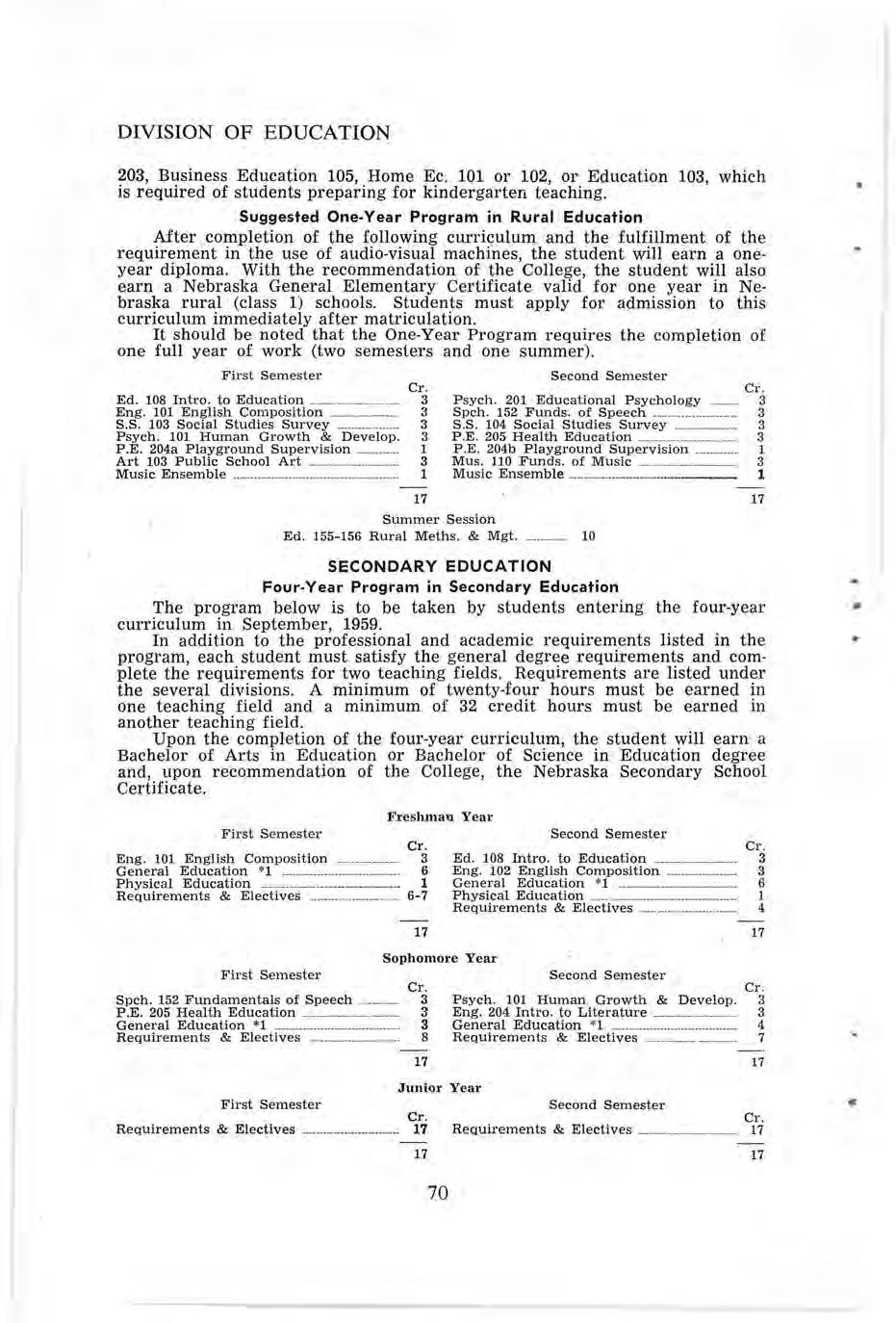
*1 Broad courses in fine and applied arts, social sciences, natural sciences, or l a nguage arts. P art of cre dit can also apply on fields of concentration
*2 The Professiona l Semester in Secondary Education consists of the following courses:
All students who intend to be certified as secondary teachers are cautioned that the courses in the professional semester are integrated with student teaching and should not be taken in previous semesters. Educational
Although educational psychology and guidance is not a teaching field, a sequence of courses is offered for those wishing to prepare for personnel work in the public schools . · In addition to completing the work required for the four-year program in elementary or secondary education, the student must follow a pattern of work chosen with the assistance of his counselor. Nineteen hours are suggested for a sequence of courses in educational psychology and guidance as follows:
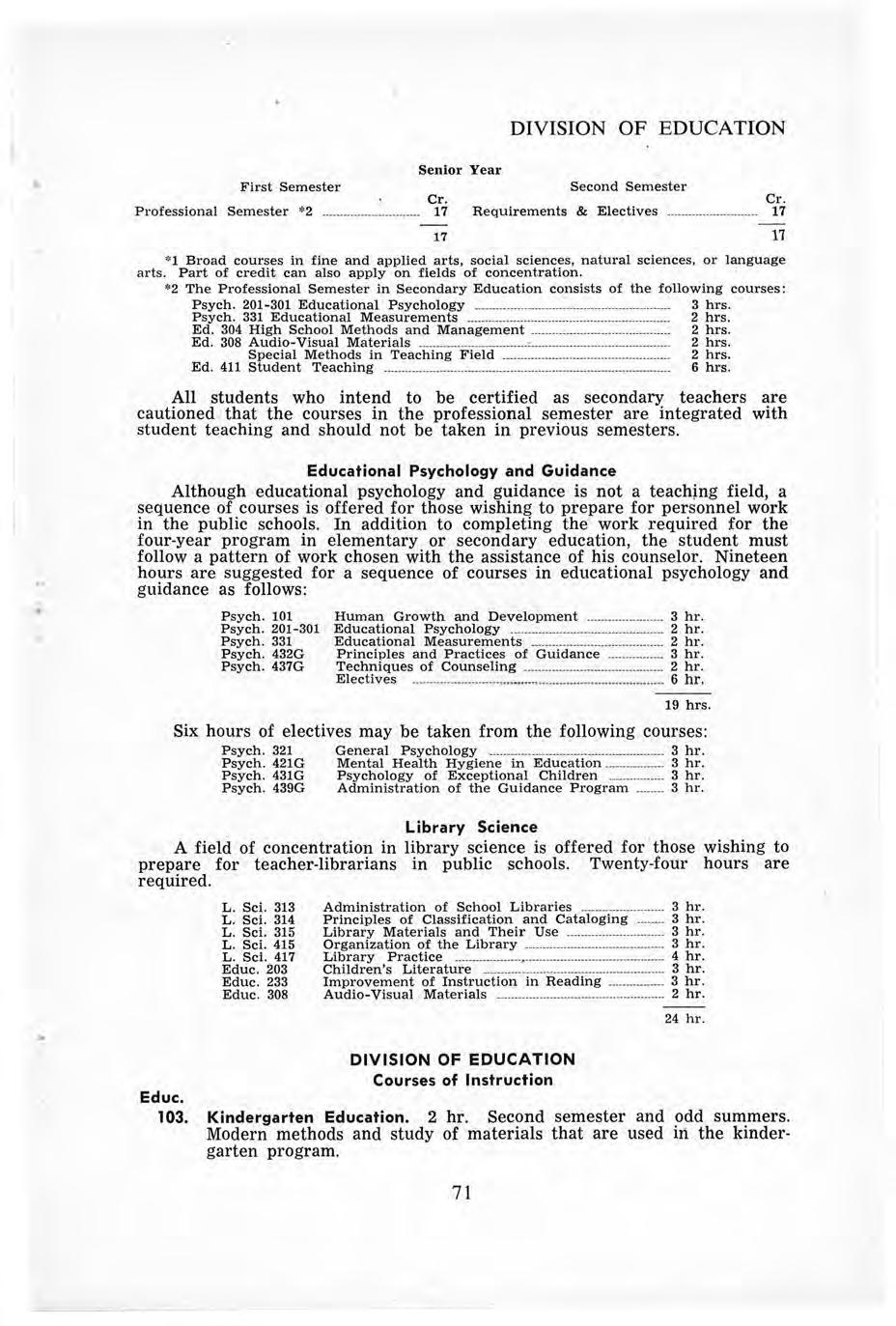
A field of concentration in library science is offered for those wishing to prepare for teacher-librarians in public schools Twenty-four hours are required .
Education. 2 hr. Second semester and odd summers. Modern methods and study of materials that are used in the kindergarten program.
108. Introduction to Education. 3 hr Each semester and summer. An orientation course in education. It deals primarily with the objectives, principles, history, and comparative aspects of the democratic American sc hool system.
155. Rural School Methods and Management. 5 hr. Summer only. Methods of teaching the content of our school subjects, as well as the organization and management of a rural school. State courses of study for elementary schools serve as basic guides for the course
156. Rural School Methods and Management. 5 hr. Summer only A continuation of Educ. 155.
203. Children's Literature. 3 hr . First semester and even summers. A survey of children's literature tracing the history from earliest times to modern liter at ur e. Emphasis on many ways to present literature to children of a ll ages. ·
222. Improvement of Instruction in the Social Studies. _ 3 hr . On demand. A study center course designed to help teachers improve their social studies teaching. An attempt is made to r 'e late the course work to the actual teaching of those who take the course.
233. Improvement of Instruction in Reading. 3 hr. On demand . A study center course planned for improving the teaching of reading of teachers in the field. Course work is designed to relate to the actual teaching of those taking the course .
234. Improvement of Instruction in the Communication Arts. _ 3 hr . On demand. A workshop course planned for improvin g the teaching of the communication arts of teachers in the field. Course work relates to the actual teaching of those taking the course. Emphasis is placed on grammar and spelling ·
303. Eleme.ntary School Cur,riculum . 3 hr . First semester, even years, and odd summers. The elementary school curriculum and its place in meeting the needs of children. Actual experience in planning units of instruction and in examining and evaluating various courses of study and textbooks .
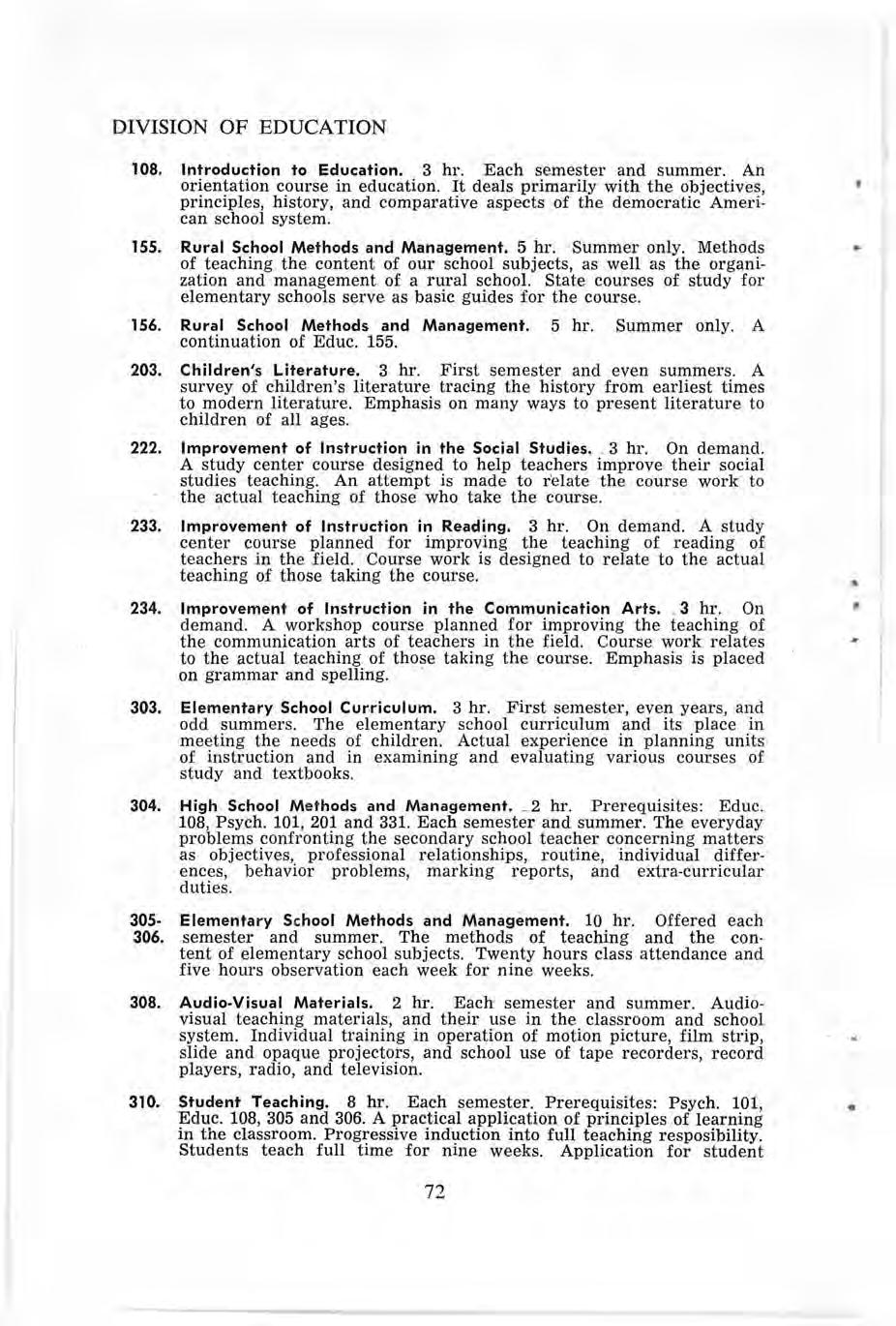
304. High School Methods and Management . _ 2 hr Prerequisites: Educ 108, Psych. 101, 201 and 331. Each semester and su mmer The everyday problems confronting the secondary school teacher concerning matters as objectives, professional relationships, routine, individual differences, behavior problems, marking reports, and extra-curricul ar duties.
305- Elementary School Methods and Management. 10 hr. Offered each 306. semester and summer. The methods of teaching and the content of elementary school subjects. Twenty hours class atte ndance and five hours observation each week for nine weeks
308. Audio-Visual Materials. 2 hr. Each semester and summer Audiovisual teaching materials, and their use in the classroom and school system. Individual training in operation of motion picture, film strip, slide and opaque projectors, and school use of tape recorders, record players, radio, a nd television.
310. Student Teaching. 8 hr. Each semester. Prerequisites: Psych. 101, Educ . 108 , 305 and 306. A practical application of principles of learning in the classroom. Progressive induction into full teaching resposibility Students teach full time for nine weeks. Application for student
teaching should be made nine weeks prior to the opening of the semester in which the student desires to teach.
310s. Student Teaching Seminar for Elementary Teachers. __ 4 hr. Summer only. Prerequisites: Two years of successful teaching- experience and 45 hours of college work. One of the two years experience must have been during the past five years, or two years within the past ten years. This experience must - be certified by the city or county superintendent of schools with whom -the candidate has worked . This course may be substituted for four hours of student teaching credit to meet the requirement. Application should be made to the Director of Student Teaching 18 weeks prior to registration .
312. Scout Mastership. 2 hr . On demand . The relationship of the objective of the Boy Scout movement to the problem of adolescence, the techniques of Scouting, and educational principles governing the m e thods e mploy ed in developing the Scout program . National Boy Scout Certificate of Training is issued upon completion .
352. Secondary School Curriculum. 3 hr . Second semester, even years . The place of general education, vocational training, vocational education, life adjustment, subject matter, core, and fusion in curriculum building.
408. Workshop. 1 to 6 hr. Summer only. Work on practical educational problems of special interest to the students. The individual or group is expected to make a written report of his finished project which will be duplicated and made available to other members of the Workshop. ·
411. Student Teaching. 6 hr Each semester. Prerequisite : Psych. 101 and 201, and Educ. 108. Experience in the application of sound educational theory by actually teaching students in the secondary school. Application for student teaching should be made to the Head of Division of Education 18 weeks prior to the opening of semester in which the student desires to teach. Student teaching will be done in a professional semester beginning with the fall term, 1960-61.
412. Student Teaching. 1 to 6 hr. Each Semester. Prerequisites: Educ 108 and 304, Psych . 101, 201 and 331. Elective for a limited number of students who will teach in high school.
424. History and Principles of Education. 3 hr . First semester and summer Prerequisite: Senior college standing The evolution and the development of educational thought and practices with a view toward better understanding of present-day problems in education Particular attention is given to the development of American education
426. - Principles of Elementary . Education. 3 hr. On demand . Prerequisites: Psych . 101 , 201 and 331 , Educ . 108, 305 and 306. A critical summary of previous professional courses in elementary education
450G. Seminar in Education for Visually Handicapped. 3 to 6 hr. On demand . Philosophy, programs, methods, and materials in the education of the visually handicapped; causes and effects of blindness ; curriculum development; use of resources; evaluation and other problems of organization and management.
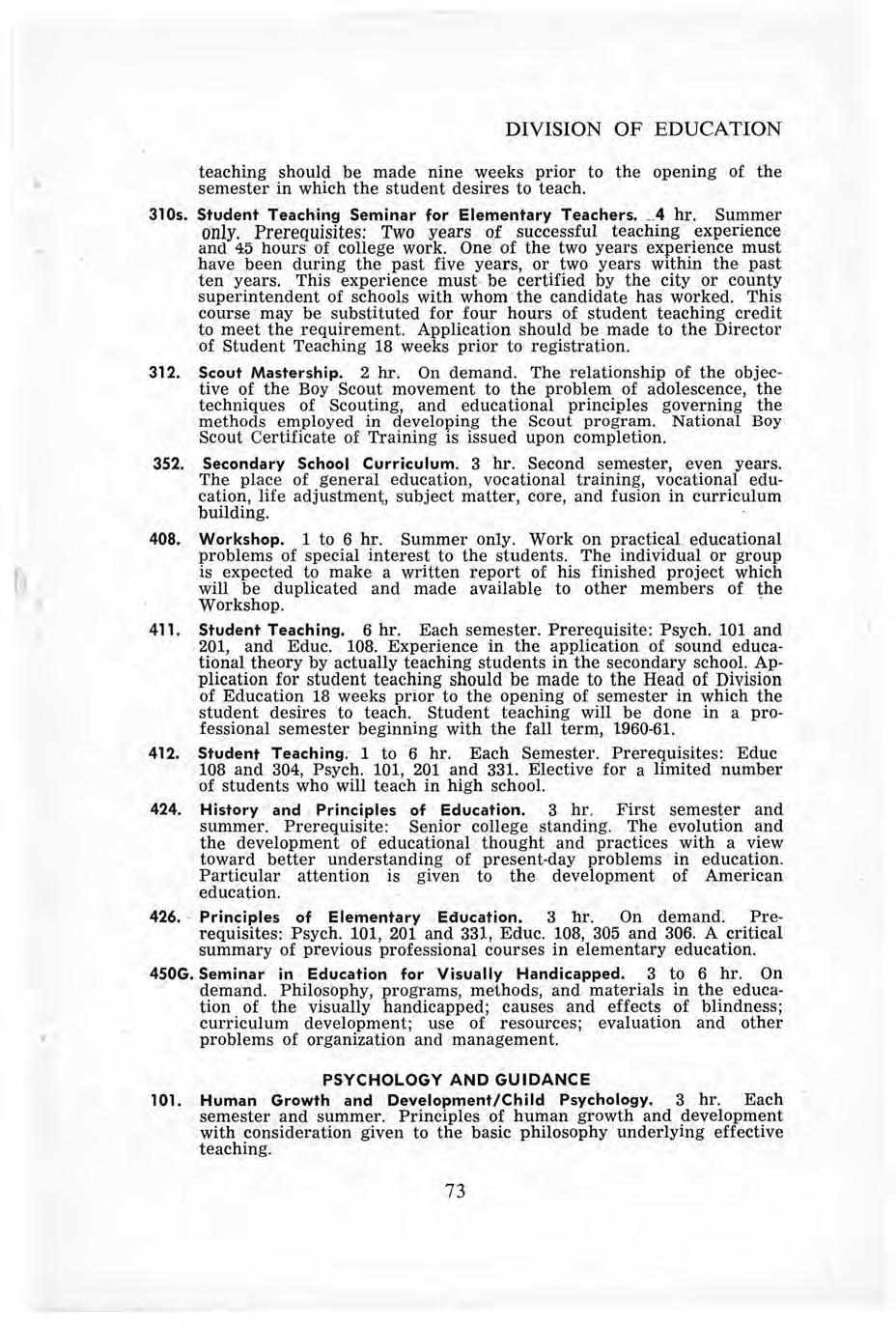
101. Human Growth and Development/Child Psychology. 3 hr. Each semester and summer Principles of human growth and development with consideration given to the basic philosophy underlying effective teaching.
201- Educational Psychology. 3 hr. Each semester and summer. Pre301. r.equisites: Psych. 101 and Educ. 108. Personality and the learning process. The principles of psychology applied to educational practice.
121- General Psychology. 3 hr. Second semester, even years, and odd 321. summers. Basic explanations of why human beings act as they doto individual problems of effective study, learning and maturation, motivation, perception, emotional control, and personality development. ·
331. Educational Measurements. 2 hr. Prerequisites: Educ . 108, Psych . 101 and 201. Each semester and summer. Tests with experience in constructing, administering, interpreting, and making use of various evaluative devices .
421G. Mental Health Hygiene in Education. 3 hr. First semester , odd years, and even summers. Prerequisites: Psych. 101 and 331. Home, school, and community factors in the hygienic adjustment of individuals.
431 G. Psychology of Exceptional Children. 3 hr. Second semester, even years, and odd summers. Prerequisite: Psych. 101 and 331. A survey course covering the types, characteristics, problems, and needs of children who are in some way exceptional.
432 G Principles and Practices of Guidance. 3 hr. First semester and even · summers. Prerequisites: Psych. 101 and 201. A general overview of the total guidance program. Principles and techniques employed in establishing and maintaining an effective guidance program ar e emphasized.
437G. Techniques of Counseling. 2 hr Second semester and odd summers Various techniques of counseling and experience in using these techniques .
439G. Administration of a Guidance Program. 2 hr. On demand . Prereqisite: Psych. 331. This course includes the setting up of a guidance program and the selecting and directing of the guidance personnel.
The following courses are offered to prepare students to become teacherlibrarians in public schools.
L. Sci.
313. Administration of School Libraries. 3 hr. First semester, odd years , and even summers Principles and procedures involved in the administration of elementary and secondary school libraries.
314. Principles of Classification and Cataloging. 3 hr . First s emester, even years, and odd summers . . Classification according to the Dewey Decimal System and the use of Sear ' s List of Subject Headings, A. L. A Cataloging Rules, and Library of Congress Rules for Descriptive Cataloging.
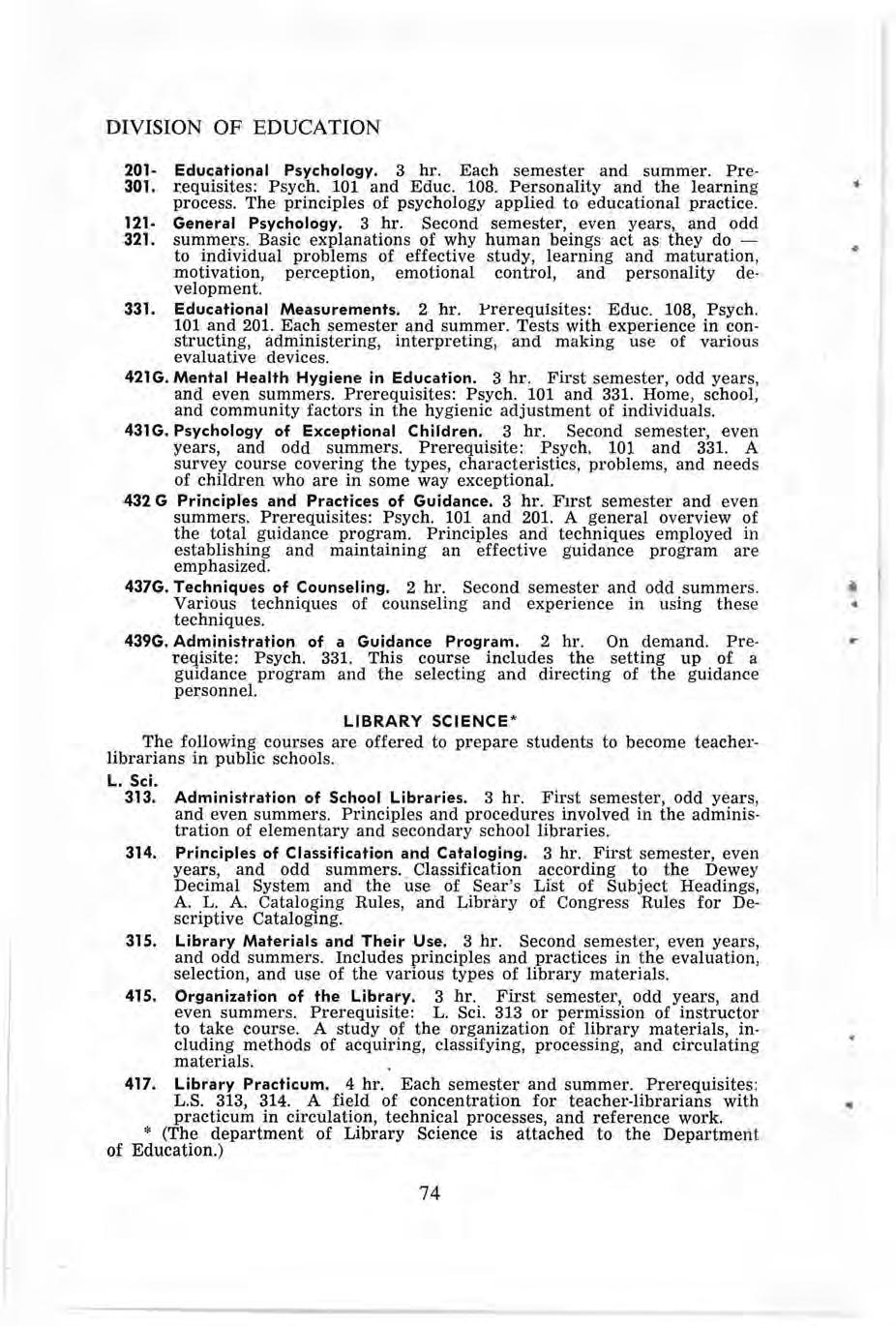
315. Library Materials and Their Use. 3 hr. Second semester, even years, and odd summers . Includes principles and practices in the evaluation, selection, and use of the various types of library materials.
415. Organization of the Library. 3 hr. First semester, odd years, and even summers. Prerequisite: L . Sci . 313 or permission of instructor to take course A study of the organization of library materials, including methods of acquiring, classifying, processing, and circulating materials.
417. Library Practicum. 4 hr. Each semester and summer. Prerequisites: L.S. 313, 314. A field of concentration for teacher-librarians with practicum in circulation, technical processes, and reference work.
* (The department of Library Science is attached to the Department of Education.)
The offerings of the Fine Arts Division include courses in art and music education
The courses give students an opportunity to learn methods for teaching art, to develop skills, and to cultivate an appreciation for art.
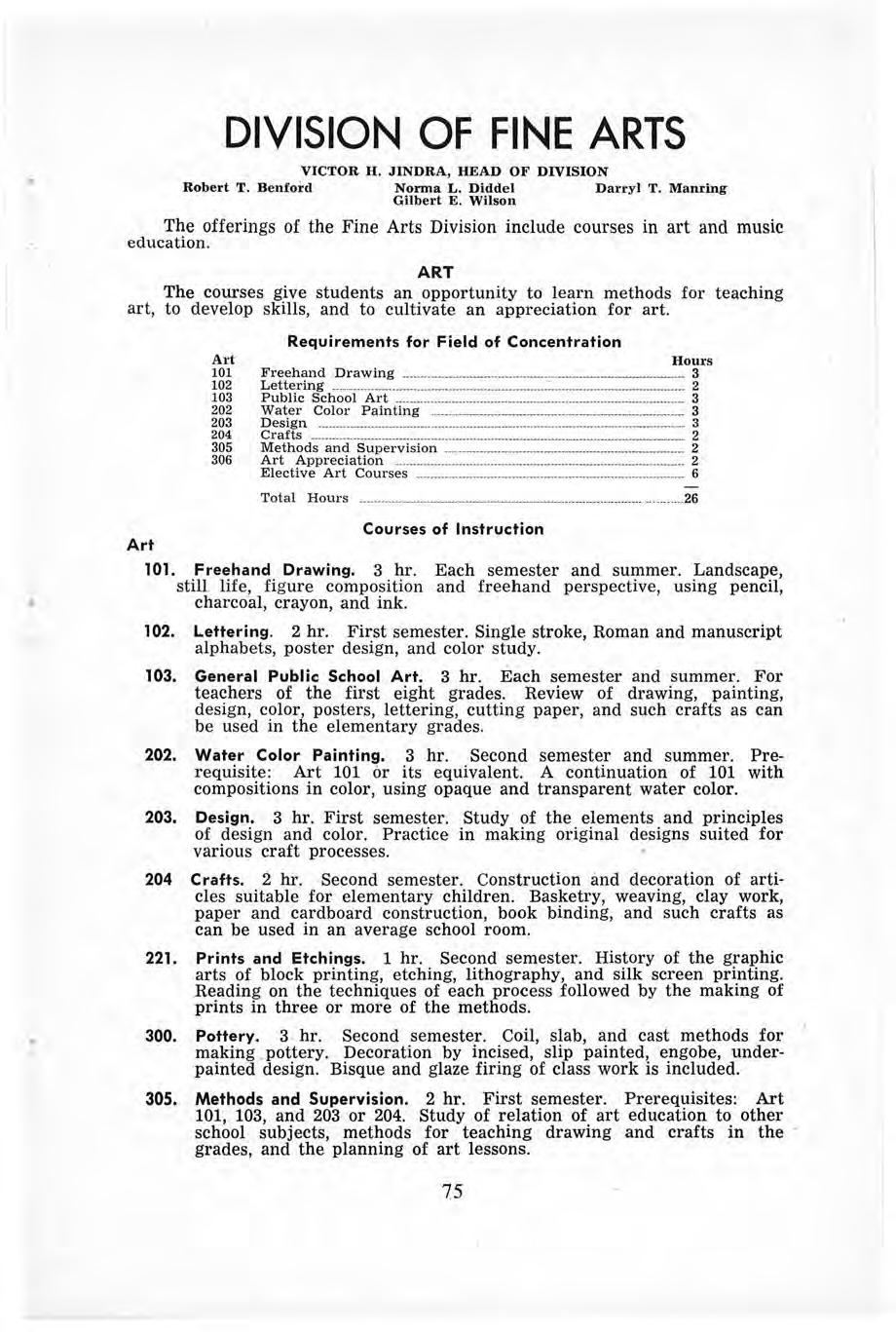
101. Freehand Drawing. 3 hr . Each semester and summer . Landscape, still life, figure composition and freehand perspective, using pencil, charcoal, crayon, and ink.
102. Lettering. 2 hr First semester. Single stroke, Roman and manuscript alph a bets, poster design, and color study .
103. General Public School Art. 3 hr Each semester and summer For teachers of the first eight grades. Review of drawing, painting, design, color, posters, lettering, cutting paper, and such crafts as can be used in the elem e ntary grades.
202. Water Color Painting, 3 hr. Second semester and summer Prerequisite : Art 101 or its equivalent. A continuation of 101 with compositions in color, using opaque and transparent water color.
203, Design. 3 hr. First semester. Study of the elements and principles of design and color. Practice in making original designs suited for various craft processes.
204 Crafts. 2 hr . •Second semester. Construction and decoration of articles suitable for elementary children . Basketry, weaving, clay work, paper and cardboard construction, book binding, and such crafts as can be used in an average school room.
221. Prints and Etchings. 1 hr Second semester History of the graphic arts of block printing, etching, lithography, and silk screen printing. Reading on the techniques of each process followed by the making of prints in three or more of the methods.
300. Pottery. 3 - hr . Second semester . Coil, slab, and cast methods for making _pottery. Decoration by incised, slip painted, engobe, underpainted design. Bisque and glaze firing of class workis included.
305. Methods and Supervision. 2 hr. First semester. Prerequisites: Art 101, 103, and 203 or 204 . Study of relation of art education to other school subjects, methods for teaching drawing and crafts in the grades, and the planning of art lessons.
306. Art Appreciation . 2 h r Each semester Planned to give some standards of measurement for art. Stu dy of art principles in connection wit h crafts, painting, sculpture, and arc h itect ure .
307. Art Hi s tory. 3 h r. Second semester. Survey of important periods of a r t history with relat ion to art of the present time.
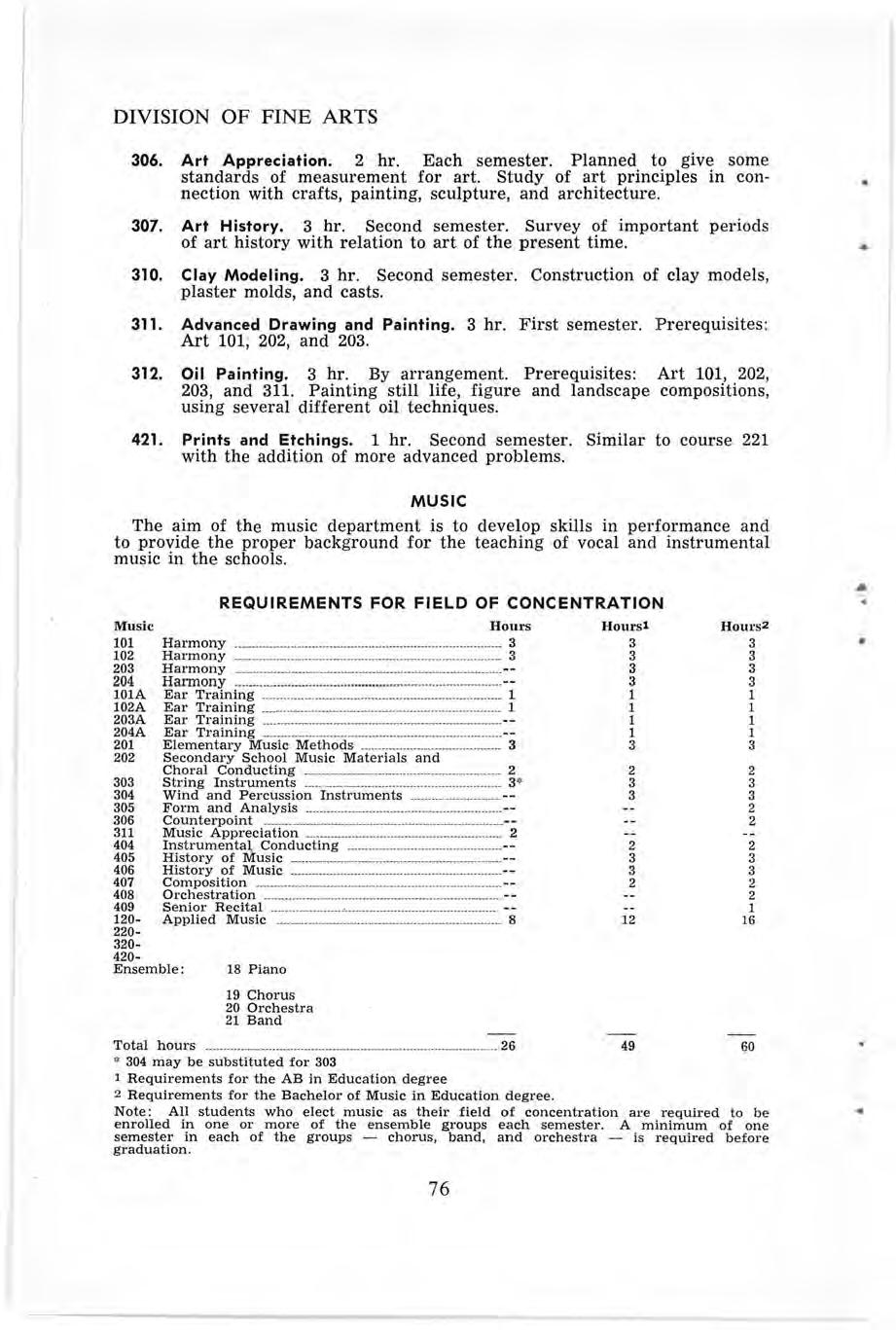
310 . C lay Modeling . 3 hr. Second semester . Construction of cl ay models, p l aster molds, and casts.
3 11. A dv anced D rawin g a nd Painting . 3 hr First semester Prereq u isites : Art 10 1, 202, and 203.
31 2 . O i l Pa inting . 3 hr. By arrangement. Prerequisites: Art 101, 202, 203, and 311. Pai n ting still life, figure and l andscape compositions, using several different oil techniques.
42 1. Print s a nd Et c hing s. 1 hr. Second semester. Similar to course 221 wit h t h e addition of more advanced prob l ems.
The aim of t h e music department is to develop skills in performance and to provide the proper background for t h e teachi n g of vocal and instrumental music in the schools.
-Note: All students who elect music as their field of concentration are required to b e enrolled in one or more of the ensemb l e groups each semester. A minimum of one semester in each of the groups - chorus, band, and orchestra - is required b e fore graduation.
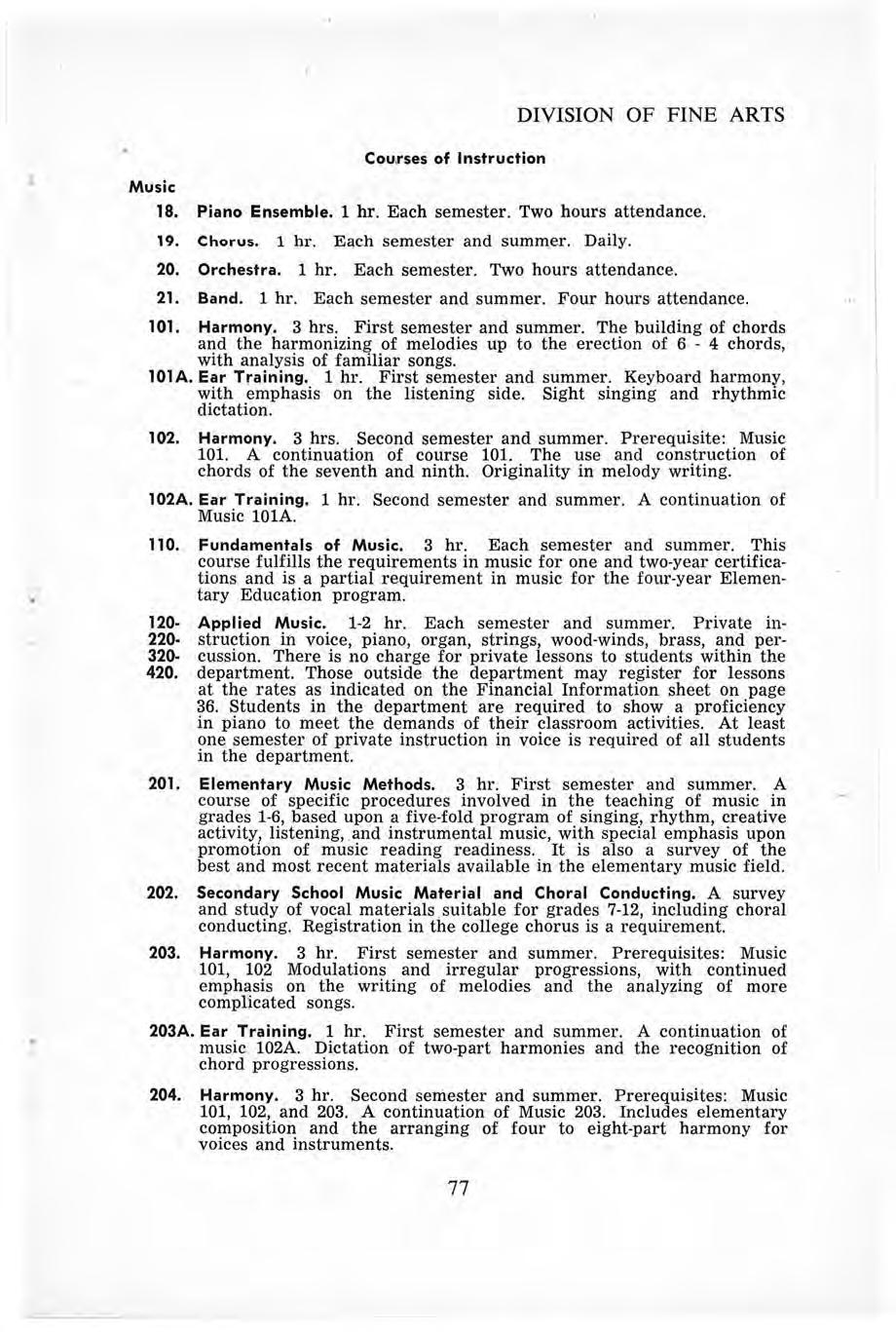
18. Piano Ensemble. 1 hr. Each semester. Two hours attendance.
19. Chorus. 1 hr. Each semester and summer Daily.
20. Orchestra. 1 hr. Each semester Two hours attendance.
21. Band. 1 hr. Each semester and summer Four hours· attendance.
101. Harmony. 3 hrs. First semester and summer. The building of chords and the harmonizing of melodies up to the erection of 6 -4 chords, with analysis of familiar songs.
101A. Ear Training. 1 hr. First semester and summer . Keyboard harmony, with emphasis on the listening side. Sight singing and rhythmic dictation .
102. Harmony. 3 hrs. Second semester and summer Prerequisite: Music 101. A continuation of course 101. The use and construction of chords of the seventh and ninth Originality in melody writing.
102A. Ear Training. 1 hr . Second semester and summer. A continuation of Music 101A.
110. Fundamentals of Music. 3 hr. Each semester and summer. This course fulfills the requirements in music for one and two-year certifications and is a partial requirement in music for the four-year Elementary Education program .
120- Applied Music. 1-2 hr. Each semester and summer . Private in220- struction ifl voice, piano, organ, strings, wood -winds, brass, and per320- cussion. There is no charge for private lessons to students within the 420. department. Those outside the department may register for lessons at the rates as indicated on the Financial Information sheet on page 36. Students in the department are required to show a proficiency in piano to meet the demands of their classroom activities. At least one semester of private instruction in voice is required of all students in the department.
201. Elementary Music Methods. 3 hr. First semester and summer. A course of specific procedures involved in the teaching of music in grades 1-6, based upon a five-fold program of singing, rhythm, creative activity, listening, .and instrumental music, with special emphasis upon promotion of music reading readiness. It is also a survey of the best and most recent materials available in the elementary music field .
202. Secondary School Music Material and Choral Conducting. A survey and study of vocal materials . suitable for grades 7-12, including choral conducting. Registration in the college chorus is a requirement.
203. Harmony. 3 hr. First semester and summer . Prerequisites: Music 101, 102 Modulations and irregular progressions, with continued emphasis on the writing of melodies and the analyzing of more complicated songs.
203A. Ear Training. 1 hr First semester and summer. A continuation of music 102A. Dictation of two-part harmonies and the recognition of chord progressions.
204. Harmony. 3 hr . Second semester and summer. Prerequisites: Music 101, 102, and 203 A continuation of Music 203 Includes elementary composition and the arranging of four to eight-part harmony for voices and instruments.
204A. Ear Training. 1 hr . Second semester and summer. A continuation · of Music 203A Includes dictation of three and four voiced harmonies and the recognition of more complicated chord progressions .
303. String Instruments. 3 hr First semester, 1960-61 and eac h alternate year. A knowledge of string instruments with actual playing experience
304. Wind and Percussion lnst.ruments. 3 hr Second semester, 1960-61 and each alternate year. A study of wood-wind, brass, and percussion instruments, with actual playing experience
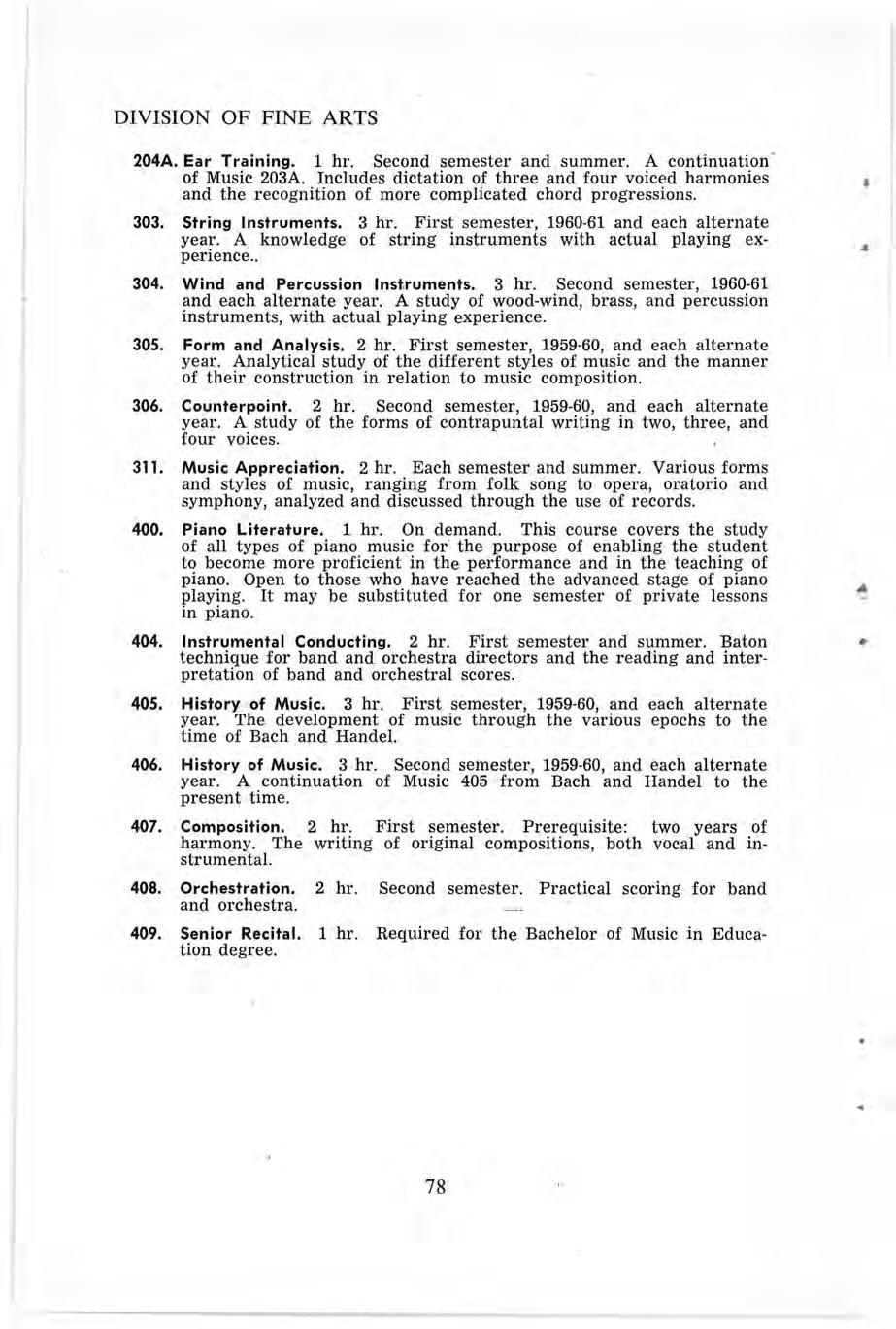
305. Form and Analysis. 2 hr . First semester, 1959-60, and each alternate year Analytical study of the different styles of music and the manner of their construction in relation to music composition .
306. Counterpoint. 2 hr. Second semester, 1959-60, and each alternate year . A study of the forms of contrapuntal writing in two, three, and four voices.
311. Music Appreciation. 2 hr Each semester and summer Various forms and styles of music, ranging from folk song to opera, oratorio and symphony, analyzed and discussed through the u se of records.
400. Piano Literature. 1 hr. On demand. This course covers the study of all types of piano music for" the purpose of enabling the student to become more proficient in the performance and in the teaching of piano . Open to those who have reached the advanced stage of piano playing. It may be substituted for one semester of private le ssons in piano.
404. Instrumental Conducting. 2 hr. First semester and summer . Baton technique for band and orchestra directors and the reading and interpretation of band and orchestral scores .
405. History of Music. 3 hr. First semester, 1959-60, and each alternate year. The development of music through the various epoc hs to the time of Bach and Handel.
406. History of Music. 3 hr. Second semester, 1959-60, and each alternate year. A continuation of Music 405 from Bach and Handel to the present time.
407. ·Composition. 2 hr. First semester. Prerequisite: two years of harmony The writing of original compositions, both vocal and instrumental.
408. Orchestration. 2 hr . Second semester. Practical scoring for band and orchestra.
409. Senior Recital. 1 hr Required for the Bachelor of Music in Education de gree .
The Inter-Collegiate program at Nebraska State Teachers College at Peru ' is designed, conducted, and administered for the love of the sport, the general welfare of the player, the enjoyment of the student body, and the specific training of the young men who expect to enter the coaching and teaching profession. The main emphasis is in producing better teachers, coaches, and citizens to build a stronger nation.
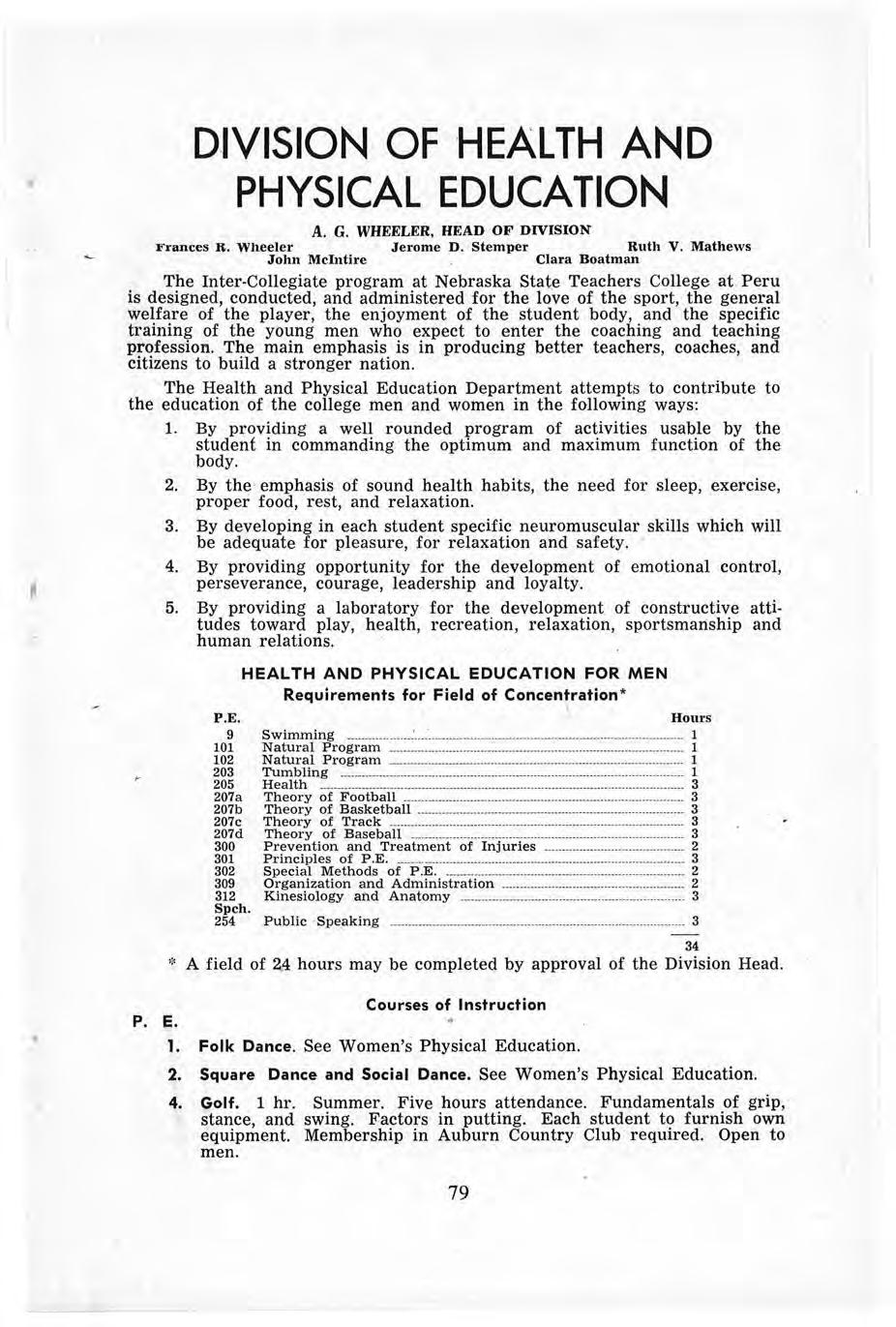
The Health and Physical Education Department attempts to contribute to the education of the college men and women in the following ways:
1. By providing a well rounded program of activities usable by the student in commanding- the optimum and maximum function of the body.
2. By the - emphasis of sound health habits, the need for sleep, exercise, proper food, rest, and relaxation.
3 By developing in each student specific neuromuscular skills which will be adequate for plea sure, for relaxation and safety. ·
4. By providing opportunity for the development of emotional control, perseverance, courage , leadership and loyalty
5. By providing a laboratory for the development of constructive attitudes toward play, health , recreation, relaxation, sportsmanship and human relations
A field of 24 hours may be completed by approval of the Division Head .
Courses of Instruction
Folk Dance. See Women's Physical Education.
Square Dance and Social Dance. See Women's Physical Education . Golf. 1 hr. Summer. Five hours attendance . Fundamentals of grip, · stance, and swing . Factors in putting. Each student to furnish own equipment. Membership in Auburn Country Club r e quired. Open to men.
9. Swimming. 1 hr. Each semester and summer. Three hours attendance . Aquatic games, life-saving, diving, crawl stroke, back stroke, side stroke, and the methods of teaching swimming.
10. Tennis. Summer. 1 hour daily. Open to men. Technique and basic strokes, fundam e ntals of singles and doubles . Each student furnishes racket and balls .
101. Natural Program. 1 hr First semester. Three hours attendance Activities course . Volleyball, speed ball, soccer, boxing, wrestling, tumbling, badminton, and playground ball.
102. Natural Program. 1 hr. Second semester. Three hours attendance. Continuation of Course 101.
203. Tumbling. 1 hr . First and second semester. Three hours attendance . Tumbling and stunts, some apparatus work in line with ability of the class .
205. Health . 3 hrs Each semester and summer Aims to prepare prospective teachers to contribute to the development of health education and health service programs in schools and communities . Includes a study of the function and care of the human body in health and disease, and the harmful effects of stimulants and narcotics. Acquaints the student with instructional materials and equipment and with available local, state, and national resources for health education.
207a. Theory of Football. 3 hr. First semester and summer. Two hours class attendance, two hours lab.
207b. Theory of Basketball. 3 hr. First semester and summer. Two hours class attendance, two hours lab.
207c. Theory of Track. 3 hr. Second semester. 'l;'wo hours class attendance and two hour lab.
207d. Theory of Baseball. 3 hr Second semester Two hours class attendance and two hours lab.
300. Prevention and T,reatment of Injuries. 2 hr . Second semester. (Primarily for men.) Nature and causes of injuries incident to the physical activities of children and athletes. Infections, their care and prevention ; first-aid treatment for hemorrhages, bruises, strains, sprains, dislocations, fractures, and use of protective equipment.
301. Principles of Physical Education. 3 hr. First semester. Scope of the field of physical education and its relation to modern educational theory; history: principles of physical education furnished by the basic sciences and philosophies of physical education. Study of the principles which should govern the instructional, interscholastic, intramural, play day , and corrective programs.
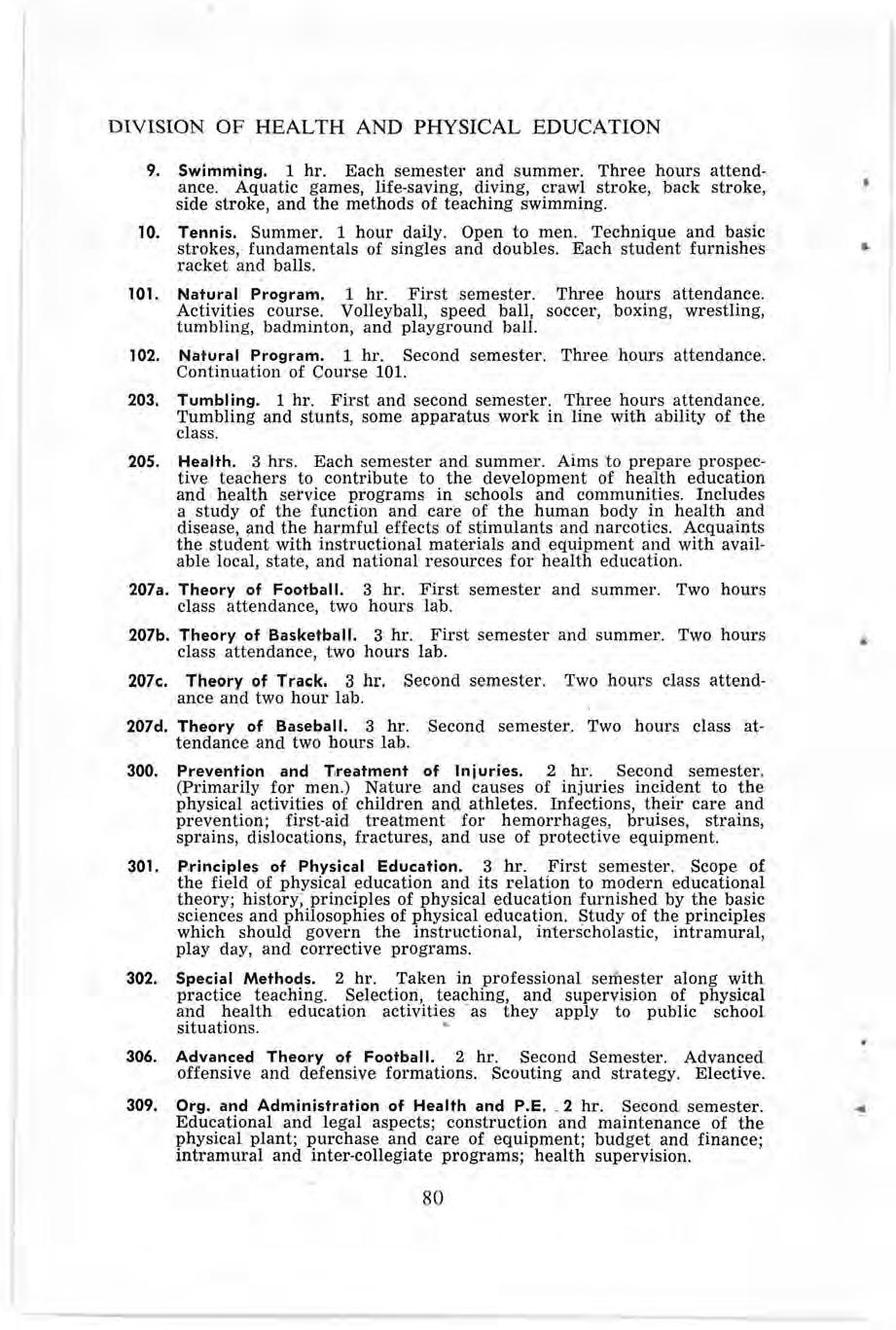
302. Special Methods. 2 hr . Taken in professional semester along with practice teaching. Selection, teaching, and supervision of physical and health education activities ·as they apply to public school situations. •
306. Advanced Theo,ry of Football. 2 hr. Second Semester. Advanced offensive and defensive formations . Scouting and strategy. Elective .
309. Org. and Admin.istration of Health and P.E. _ 2 hr. Second semester. Educational and legal aspects; construction and maintenance of the physical plant; purchase and care of equipment; budget and finance; intramural and inter-collegiate programs; health supervision.
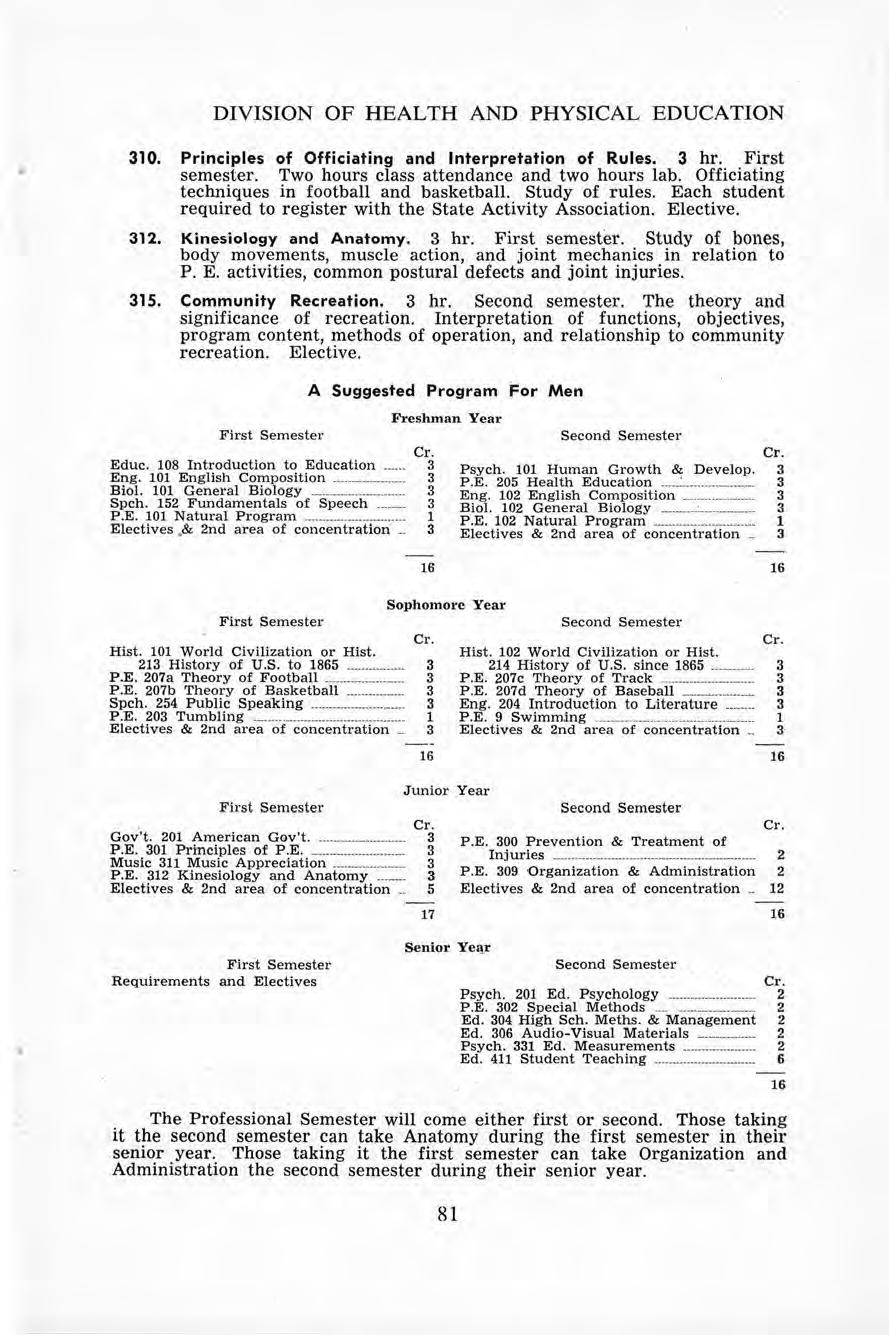
310. Principles of Officiating and Interpretation of Rules. 3 hr. First semester. Two hours class a ttendance and two hours lab Officiating techniques in football and basketball. Study of rules. Each student required to register with the State Activity Association . Elective.
312. Kinesiology and Anatomy. 3 hr. First se mester Study of bones, body movements, muscle action, and joint mechanics in relation to P. E. activities, common postural defects and joint injuries.
315. Community Recreation. 3 hr Second semester. The theory and significance of recreation. Interpretation of functions, objectives, program content, methods of operation, and relationship to community recreation. Elective
The Professional Semester will come either first or second. Those taking it the second semester can take Anatomy during the first semester in their senior year. Those taking it the first semester can take Organization and Administration the second semester during their senior year.
• In addition to the abov e, six hours of supporting credit in Biology is recommended
Each student must furnish her own gymnasium suit and gym shoes. The student furnishes swimming cap and suit. A deposit of $2.00 is required for rental of leotard for Modern Dance; $1.00 refunded when is it returned .
1. Folk Dance. 1 hr . Second semester . Three hours attendance . Open to both men and women.
2. Square and Social Dance. 1 hr . First semester. Three hours attend• ance . Open to men and women .
3. Modern Dance. 1 hr. Second semester Three hours attendance Fundamental rhythmic techniques and their application in creative dance.
6. Sports - Individual. 1 hr Three hours attendance. Badminton , archery, paddle tennis, deck tennis and shuffleboard . Offered alternate years. First semester 1960 .
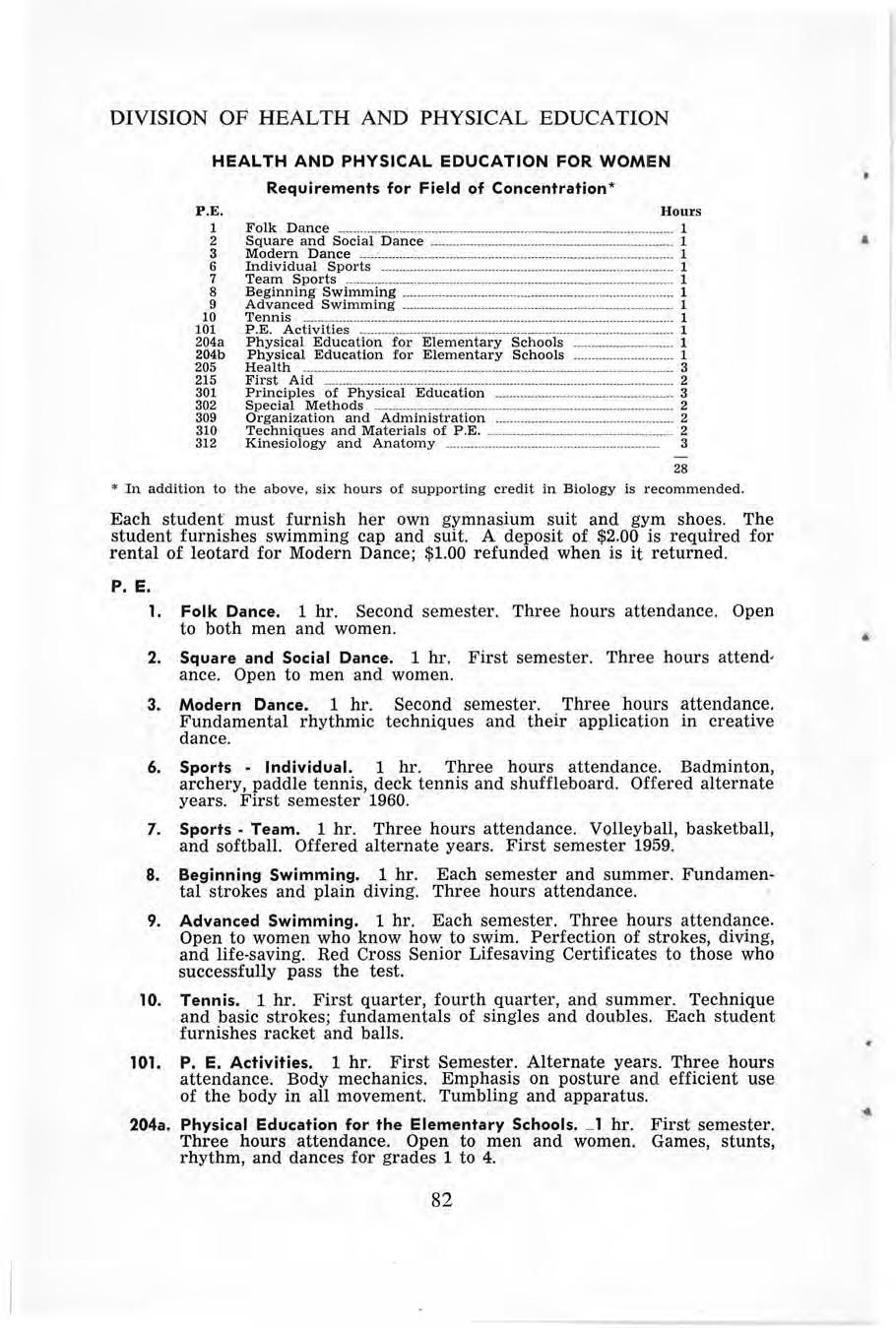
7. Sports - Team. 1 hr. Three hours attendance. Volleyball, basketball , and softball. Offered alternate years. First semester 1959.
8. Beginning Swimming. 1 hr . Each semester and summer. Fundamental strokes and plain diving Three hours attendance.
9. Advanced Swimming. 1 hr . Each semester . Three hours attendance. Open to women who know how to swim. Perfection of strokes, diving, and life-saving. Red Cross Senior Lifesaving Certificates to those who successfully pass the test.
10. Tennis. 1 hr. First quarter, fourth quart e r, and summer Technique and basic strokes; fundamentals ·of singles and doubles . Each student furnishes racket and balls.
101. P. E. Activities. 1 hr. First Semester. Alternate years. Three hours attendance. Body mechanics Emphasis on posture and efficient use of the body in all movement. Tumbling and apparatus
204a. Physical Education for the Elementary Schools. __ 1 hr First semester. Three hours attendance. Open to men and women. Games, stunts, rhythm, and dances for grades 1 to 4.
204b. Physical Education for Elementary Schools. 1 hr . Second semester. Three hours attendance. Open to men and women. Games, stunts, rhythms, and dances for grades 5 to 8.
205. Health. (See H. and P. E. Section for Men 205).
215. First Aid. 2 hr. Second semester 1959·60 American Red Cross Standard First Aid Course. Offered alternate years .
301. Principles of P. E. (See H. and P. E. for Men 301) . I
309. Organization and Administration. (See H. and P. E. for . Men 309).
310. Techniques and Materials of P. E. for Women. 2 hr Offered alternate years. Second semester 1958-59. Underlying principles govern• ing selection and presentation of materials and activities in the field of P. E. for Women.
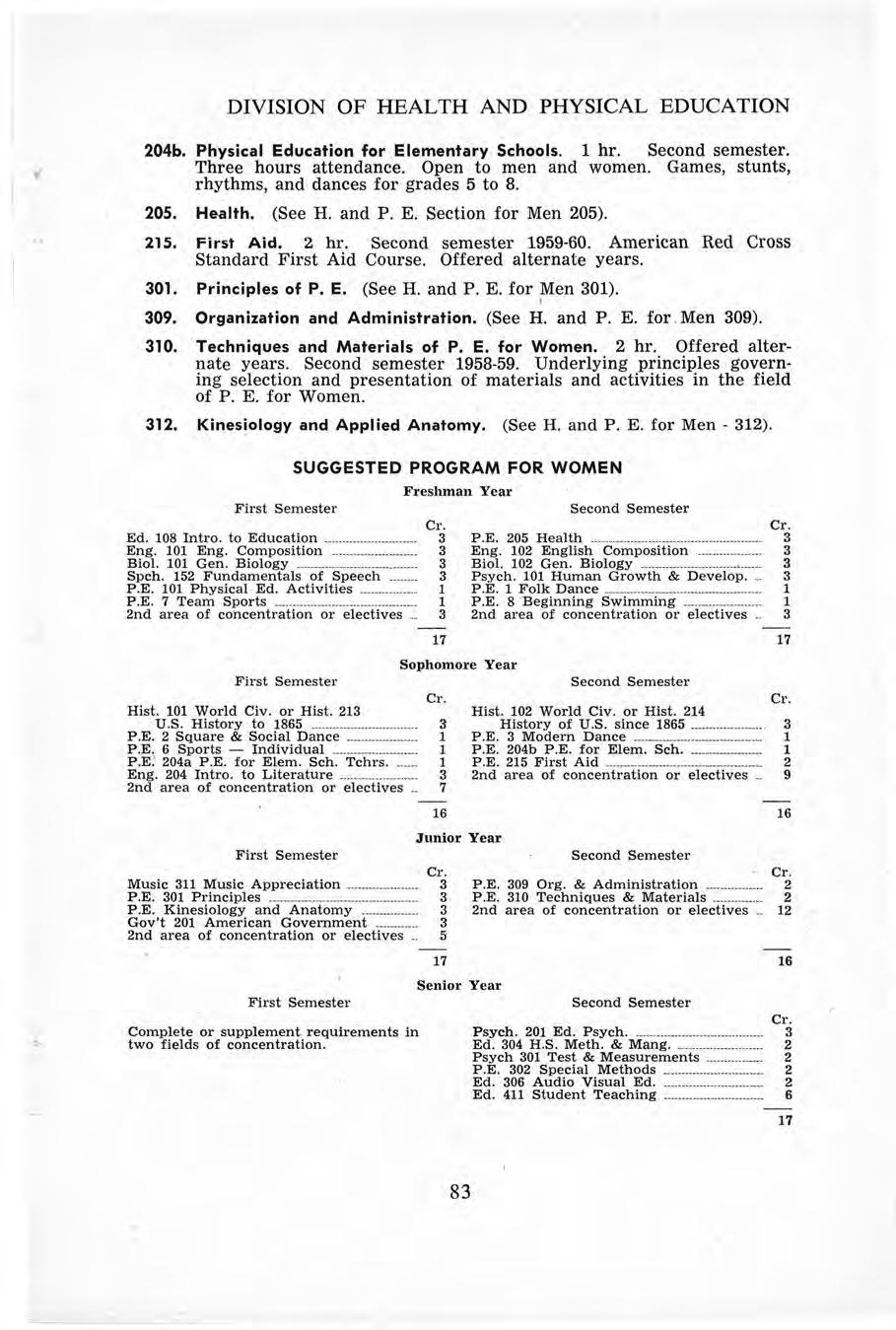
312. Kinesiology and Applied Anatomy. (See H and P. E. for Men• 312)
SUGGESTED PROGRAM FOR WOMEN
The Division of History and Social Science offers courses in the following subjects : economics, government, history, sociology, and composite courses in these areas. The offeriqgs in this division are designed to furnish students the information and techniques requisite for teaching Social Science in the elementary and secondary schools, to create an understanding of and respect for our democratic way of life, and to develop a capacity for s ound scholarship, community leadership , and useful citizenship .
Fields of concentration for the A .B. or B.S. in Education or A. B. degrees are offered in Geography, History and Social Science.
Students intending to do gra duate work in t he social sciences should acquire a readin g knowledge of a foreign lan gua ge, and should plan their undergraduate work with the assistance of their counselors in order -to prepare as carefully as possible for such advanced work.
Students who intend to enter a Graduate School of Social Work or the welfare field as a case worker in the State Department of Assistance and Child Welfare should plan to take at least 40 semester hours in social and biological sciences Distribution of courses should be approximately as follows: Principles of Sociology, at least 6 each in government and economics, a nd not more than 10 in history.
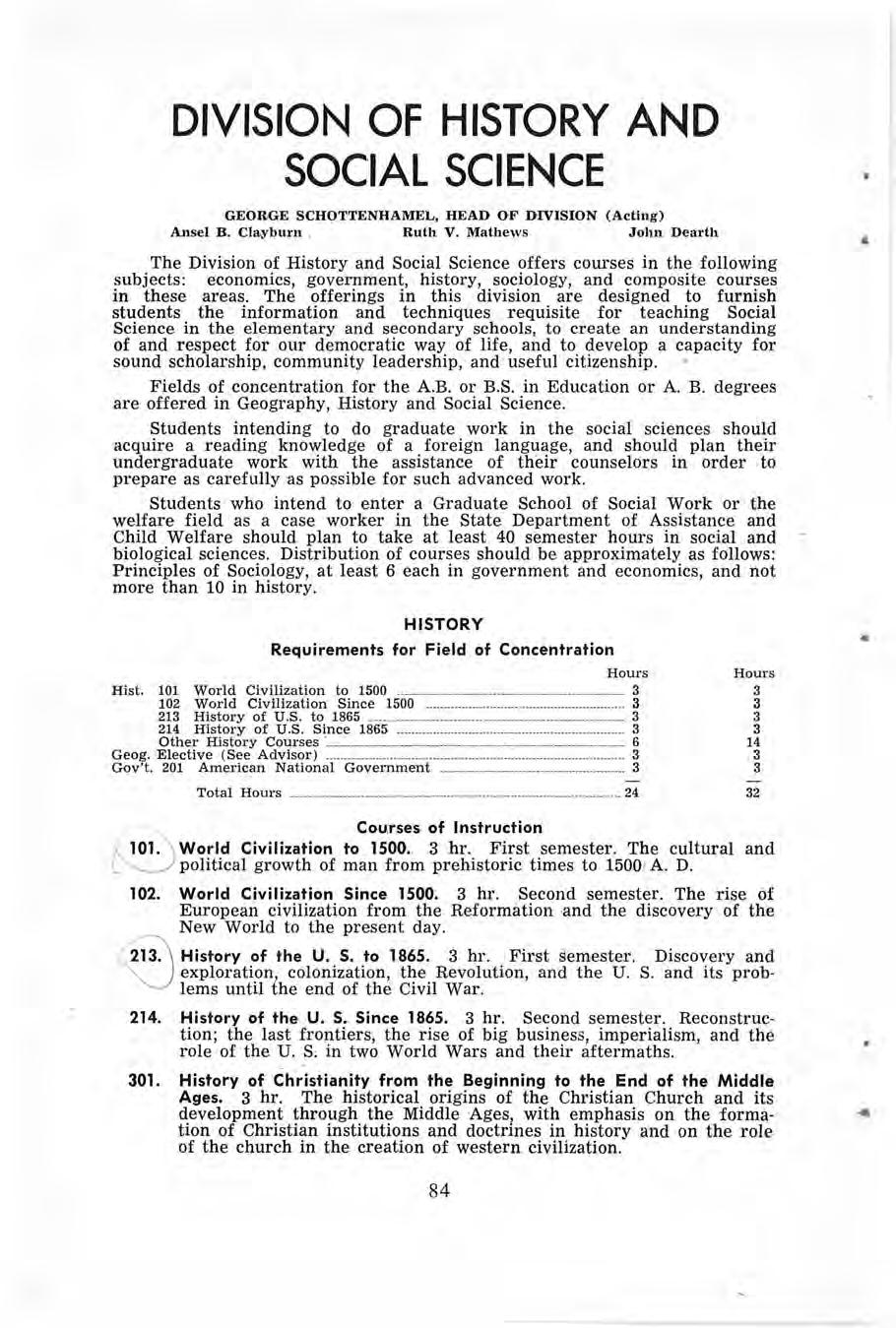
World Civilization Since 1500. 3 hr .
semester. The rise of European civilization from the Reformation -and the discovery of the New World to the pr esen t day .
~~ 13. History of the U. S. to 1865. 3 hr. First se mester Discov e ry and exploration, colonization, the Revolution, and the U. S and its problems until the end of the Civil War.
214. History of the U. S. Since 1865. 3 hr. Second semester Reconstruction; the last frontiers, the rise of big business, imperialism, and the role of the U. S; in two World Wars and th e ir afterm at hs.
301. History of Christianity from the Beginning to the End of the Middle Ages. 3 hr. The historical ori gins of the Christian Church and its development through the Middle Ages, with emphasis on the formation of Christian institutions and doctrines in history and on the role of the church in the creation of western civiliza tion .
302. History of Christianity .from the Reformation to the Present. _ 3 hr. The historical development of the Christian Churches since the end of the Middle Ages, with emphasis on the formation of Christian institutions and doctrines in history and the roles of the church in the development of the modern world.
310. Survey of English History to 1688. 2 hr. England from pre-Roman times to the Glorious Revolution. ·
311. Survey of English History Since 1688. 2 hr. England from the establishment of parliamentary supremacy to modern times.
312. Survey of Russian ' History. 2 hr Political history of Russia from Rurik to the Communist Empire .
325. The Ame.rican Frontier. 3 hr. The importance of the frontier in American history from colonial times to the 20th Century
326. History of Colonial Latin America. 3 hr. Discovery, exploration, and colonization of Latin America, with emphasis upon its institutions and culture, and the events leading to its wars of independence.
327. History of Independent Latin America. 3 hr. The evolution of the states of modern Latin America following their independence, their political and economic development, and their international relations .
333. Economic History of United States. 3 hr A survey of U. S. economic history from colonial times to the present.
401 G. Greek History. 2 hr. An examination of the beginnings of civilization and history, followed by an analysis of Greek history from Homeric times to the Diadochi.
402G. Roman History. 2 hr The political and cultural history of Rome from earliest times to the fall of the Western Empire.
404G. The Renaissance. 2 hr.· The re-awakening of learning in Europe, as shown in the political and cultural achievements of the period.
405G. The Reformation. 2 hr. Europe from Erasmus to the end of the Thirty Year's War, with special attention given to the causes and nature of the religious struggles of the perioa .
407. Nineteenth Century Europe. 2 hr. From the Congress of Vienna to the alignment of powers that prefaced World War I, with emphasis upon the formation of the German Empire and the unification of Italy .
408. Twentieth Century Europe. 2 hr. The crisis leading to World Wars I and II, the outcomes of those wars, the rise of totalitarianism, and the problems now facing Europe.
420G. American Colonial History. 3 hr Colonial rivalry between the Spanish, French, English, and Dutch in North America; the Revolution, and U. S. history to 1823.
421G. The United States in the Nineteenth Century . 3 hr. The U. S. from 1823 through Manifest Destiny and the Civil War down to the War with Spain.
422G. The United States in the Twentiet.h Century. 3 hr. The U. S. in modern times, with emphasis upon the changing social and economic theories of the period, and the internal and exte rnal forces that influenced its development.
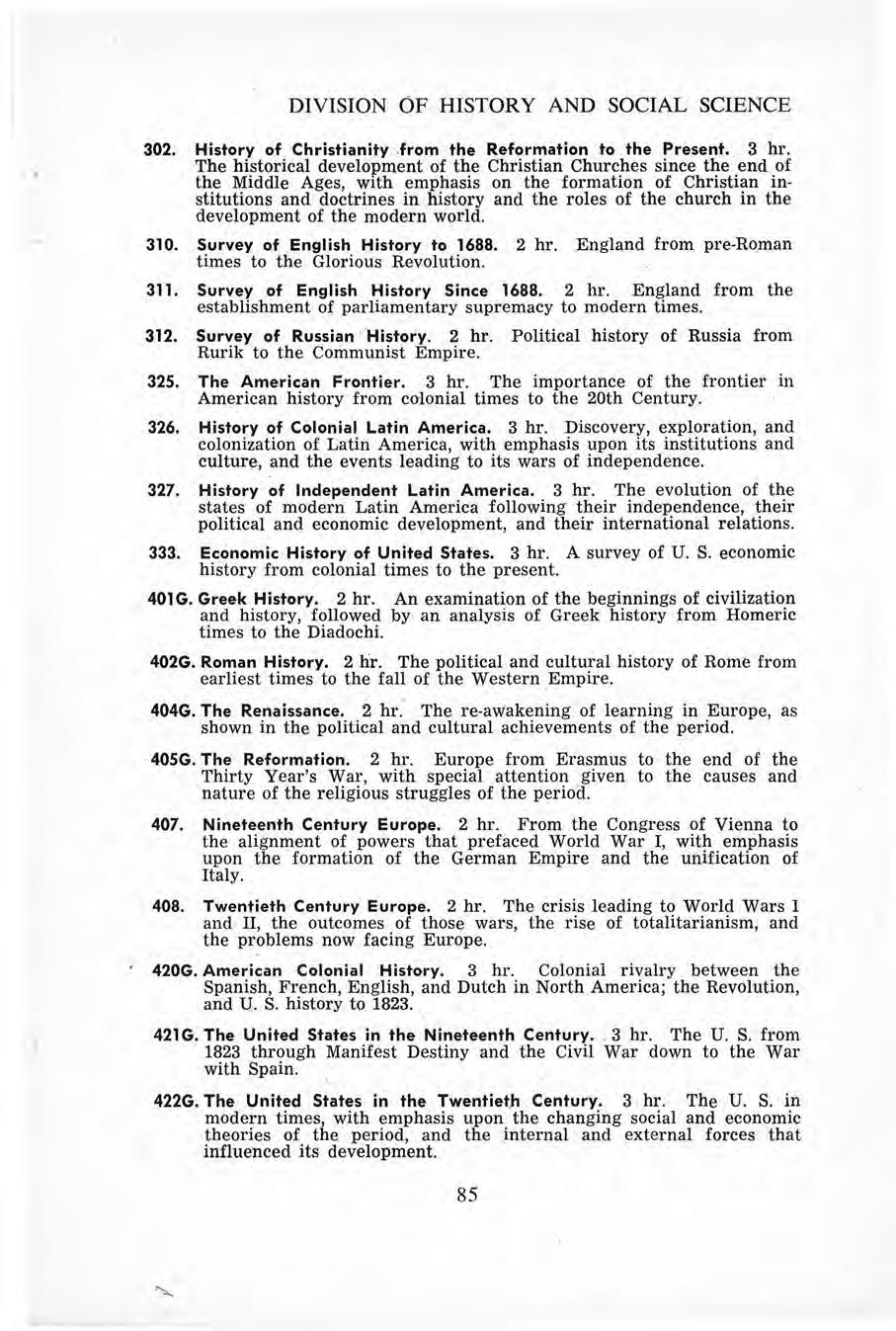
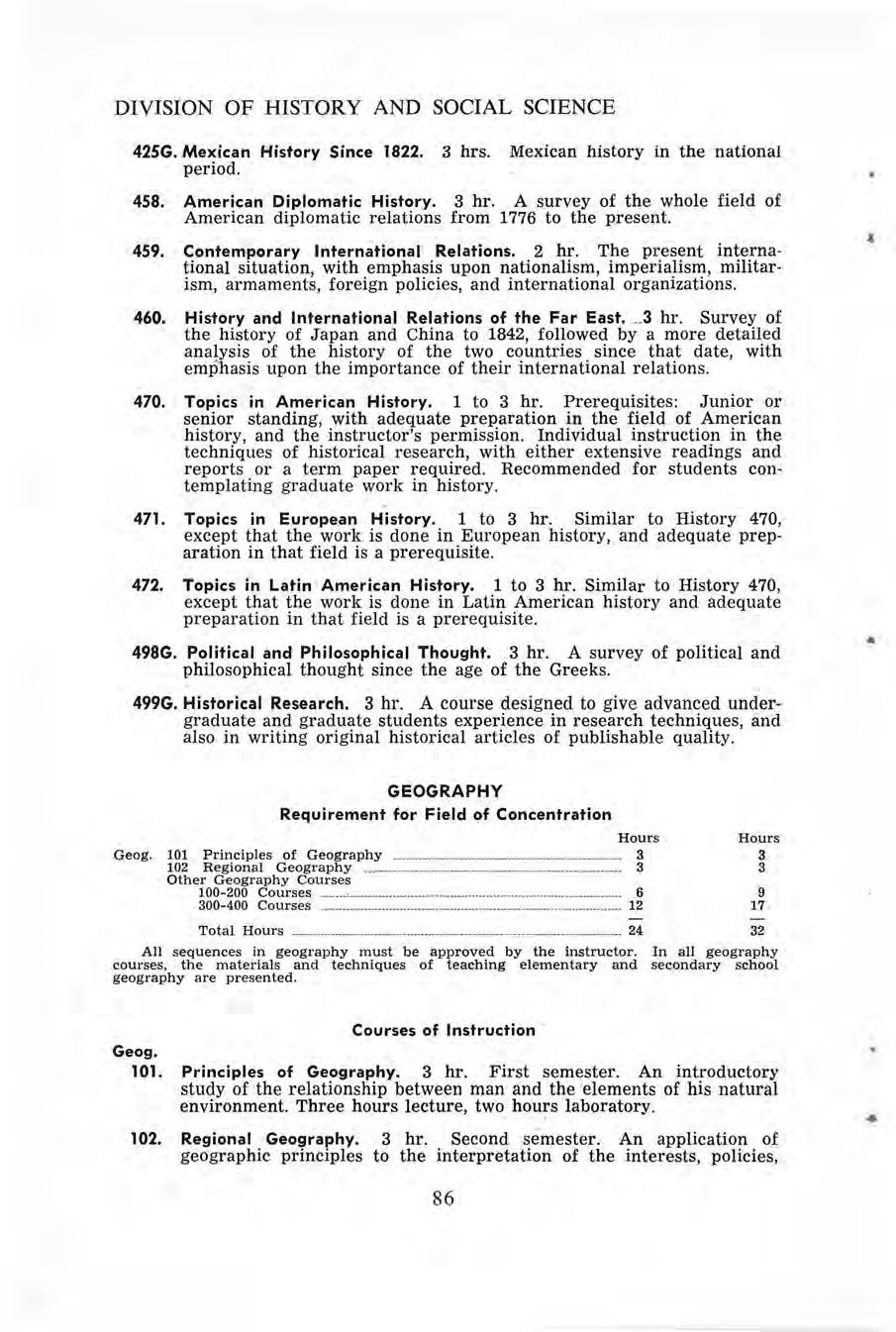
425G. Mexican History Since 1822. 3 hrs . Mexican history in the national period.
458. American Diplomatic History. 3 hr A survey of the whole field of American diplomatic relations from 1776 to the present.
459. Contemporary International Relations. 2 hr. The present international situation, with emphasis upon nationalism, imperialism, militarism, armaments, foreign policies, and international organizations
460. History and International Relations of the Far East. __ 3 hr. Survey of the history of Japan and China to 1842, followed by a more detailed analysis of the history of the two countries since that date, with emphasis upon the importance of their international relations.
470. Topics in American History. 1 to 3 hr Prerequisites: Junior or senior standing, with adequate preparation in the field of American history, and the instructor's permission. Individual instruction in the techniques of historical research, with either extensive readings and reports or a term paper required. Recommended for students contemplating graduate work in history
47-1. Topics in Europe.an History. 1 to 3 hr . Similar to History 470, except that the work is done in European history, and adequate preparation in that field is a prerequisite.
472. Topics in Latin ·American History. 1 to 3 hr . Similar to History 470, except that the work is done in Latin American history and adequate preparation in that field is a prerequisite.
498G. Political and Philosophical Thought. 3 hr. A survey of political and philosophical thought since the age of the Greeks.
499G. Historical Research. 3 hr. A course designed to give advanced undergraduate and graduate students experience in research techni9.ues, and also in writing original historical articles of publishable quahty
All sequences in geography must be approved by the instructor. In all geography courses, the materials and techniques of teaching elementary and secondary school geography are presented.
Geog. 101. 102.
Courses of Instruction · Principles of Geography. 3 hr. First semester . An introductory study of the relationship between man and the elements of his natural environment. Three hours lecture, two hours laboratory.
Regional Geography. 3 hr. Second se.mester. An application of geographic principles to the interpretation of the interests, policies,
and activities of the peoples in significant regions of the world Three hours lecture, two hours laboratory .
201. General Geology (Physical). 3 hr . First semester. An introduction to the theories of the earth's origin, with the physiography, structure, and hi story 0£ the earth as revealed in its rocks Three hours lecture , two hours laboratory .
202. General Geology (Historical). 3 hr. Continental evolution, emphasizing the origin and nature of important geologic formations throughout the world, and a survey of the evolution of 'organisms ancestral to the earth' s present flora and fauna Two hours lecture, ·three hours laboratory.
203. Historical Geography of the United States. 3 hr First semester. The environment relationships invo1ved in the development of the Am e rican nation, with emphasis upon the results of different environments upon an expanding people and population .
206. Geograph,y of Nebraska. 2 hr. The· relationship between the natural environment of Nebraska and its agriculture, industries , and social conditions
215. Economic Geography. 3 hr. Second semester . Each year . The occurrence, natur-e, distribution, utilization, and conservation of mineral and power resources with an evaluation of the geographic factors affecting land utilization a nd world trade
226. Conservation of Natural Resources. 3 hr An evaluation of th e extent of our natural resources and plans for their utilization , with discussions on current problems and projects of conservation.
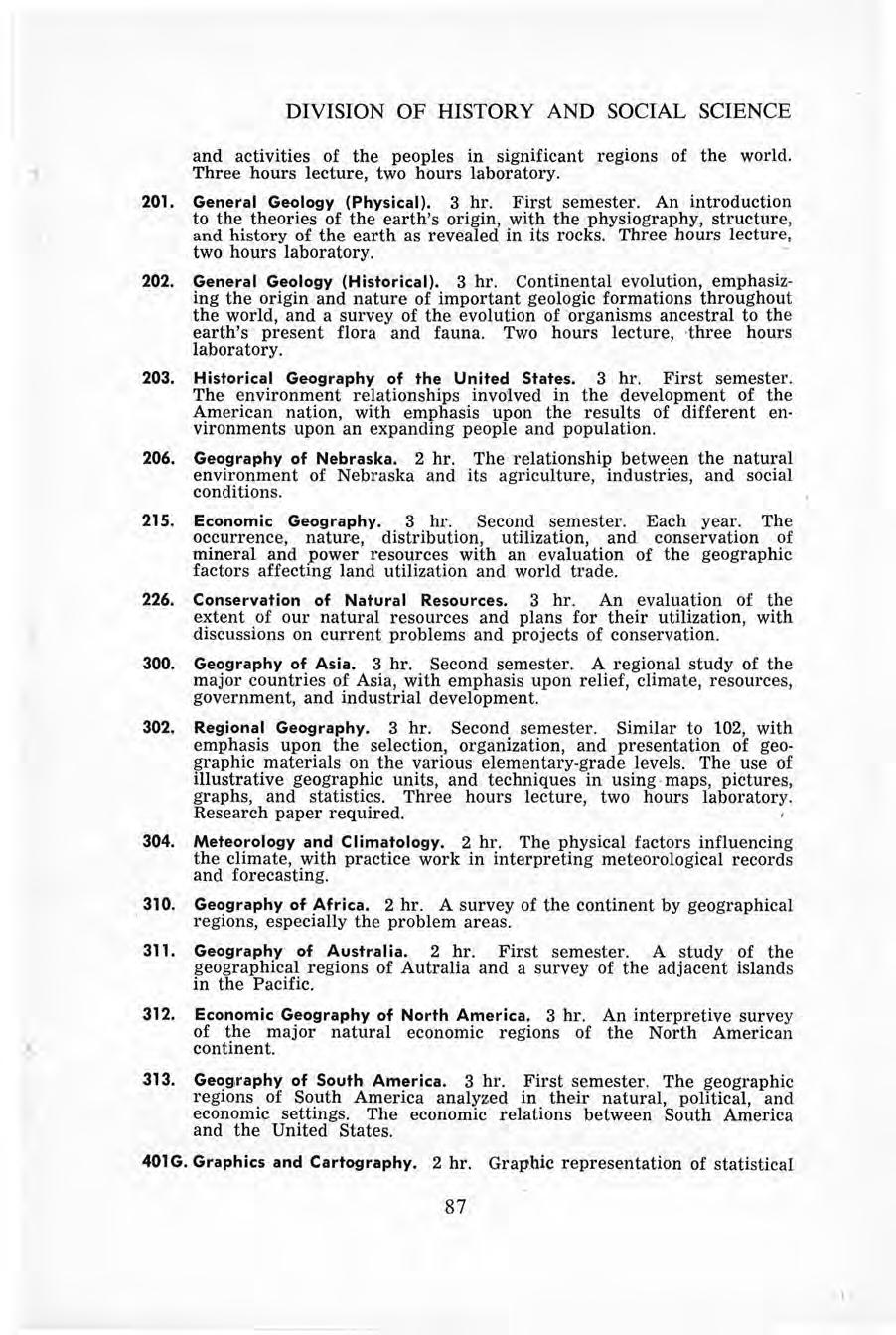
300. Ge,ography of Asia. 3 hr. Second semester. A regional study of the major countries of Asia, with emphasis upon relief, climate, resources , government, and industrial development.
302. Regional Geography. 3 hr Second semeste r Similar to 102, with emphasis upon the selection, organization, and presentation of geographic materials on the various elementary-grade levels The use of illustrative geo graphic units, and techniques in using -maps, pictures, graphs, and sta tistics. Three hours lecture, two hours laboratory . Research paper required.
304. Meteorology and Climatology. 2 hr . The physical factors influencin g the climate, with practice work in interpretin g meteorological record s and forecasting.
310. Geography of Africa. 2 hr. A survey of the continent by geographical regions, especially the proble m areas.
311. Geography of Australia. 2 hr First seme ster. A study of the geographical regions of Autralia and a survey of the adjacent island s in the Pacific.
312. Economic Geography of North America. 3 hr . An interpretive surveyof the major natural economic regions of the North American continent.
313. Geog,raphy of South America. 3 hr First semester The geographic regions of South America analyzed in their natural, political, and economic settings . The economic relations between South America and the United States.
401G. Graphics and Cartography. 2 hr. Graphic representation of statistical
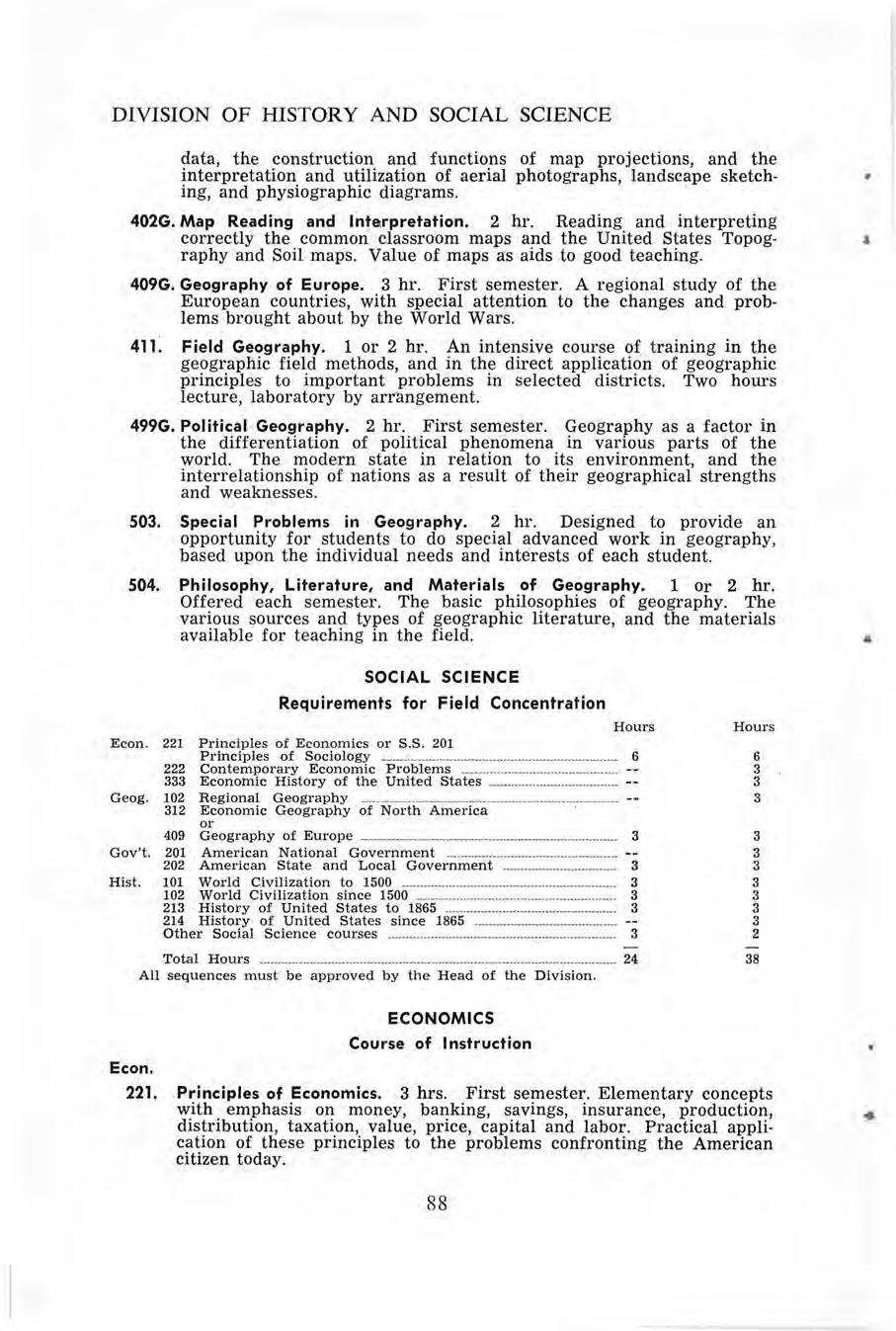
data, the construction and functions of map projections, and the interpretation and utilization of aerial photographs, landscape sketching, and physiographic diagrams.
402G. Map Reading and Interpretation. 2 hr. Reading and interpreting correctly the common classroom maps and the United States Topography and Soil maps . Value of maps as aids to good teaching.
409G. Geography of Europe. 3 hr . First semester. A regional study of the European countries, with special attention to the changes and problems brought about by the World Wars.
411 : Field Geography. 1 or 2 hr An intensive course of t raining in the geographic field methods, and in the direct application of geographic principles to important problems in selected districts. Two hours lecture, laboratory by arr'lmgement.
499G. Political Geography. 2 hr. First semester. Geography as a factor in the differentiation of political phenomena in various parts of the world. The modern state in relation to its environment, and the interrelationship of nations as a result of their geographical strengths and weaknesses.
503. Special Problems in · Geography. 2 hr. Desig ned to provide an opportunity for students to do special advanced work in geography, based upon the individual needs and interests of each student.
504. Philosophy, Literature, and Materials of Geography. 1 or 2 hr. Offered each semester. The basic philosophies of geography. The various sources and types of geographic literature, and the materials available for teaching in the field.
221. Principles of Economics. 3 hrs . First semester. Elementary concepts with emphasis on money, banking, savings, insurance, production, distribution, taxation, value, price, capital and labor. Practical application of these principles to the problems confronting the American citizen today.
222. Contemporary Economic Problems. 3 hr. Second semester. Analysis of major economic problems relating to wage and income distribution , money and credit, business cycles, domestic and international trade and tariffs.
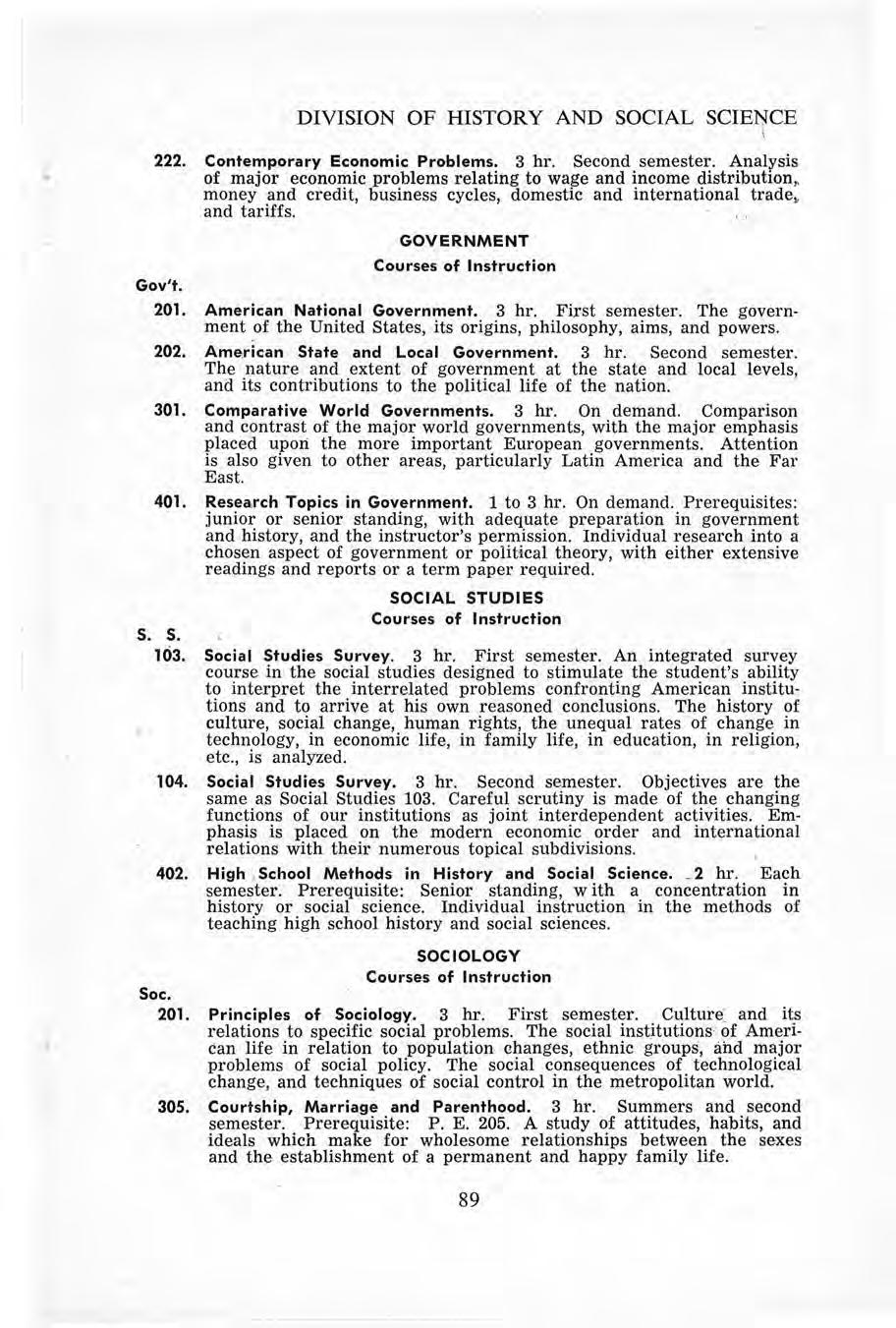
201. American National Government. 3 hr. First semester. The government of the United States, its origins, philosophy, aims, and powers.
202. Ame.rican State and Local Government. 3 hr. Second semester The nature and extent of government at the state and local levels, and its contributions to the political life of the nation :
301. Comparative World Governments. 3 hr. On demand . Comparison and contrast of the major world governments, with the major emphasis placed uport the more important European governments. Attention is also given to other areas, particularly Latin America and the Far East.
401. Resea,rch Topics in Government. 1 to 3 hr . On demand. Prerequisites : junior or senior standing, with adequate preparation in government and history, and the instructor 's permission. Individual research into a chosen aspect of government or political theory, with either extensive readings and reports or a term paper required
Social Studies Survey. 3 hr. First semester. An integrated survey course in the social studies designed to stimulate the student's ability to interpret the interrelated problems confronting American institutions and to arrive at his own reasoned conclusions. The history of culture, social change, human rights, the unequal rates of change in technology , in economic life, in family life, in education, in religion , etc., is analyzed.
Social Studies Survey. 3 hr. Second semester. Objectives are the same as Social Studies 103. Careful scrutiny is made of the changing functions of our institutions· as joint interdependent activities. Emphasis is placed on the modern economic order and international relations with their numerous topical subdivisions.
High , School Methods in. History and Social Science . .. 2 hr. Each semester. Prerequisite: Senior standing, with a concentration in history or social science Individual instruction in the methods of teaching high school history and social sciences.
Principles of Sociology. 3 hr. First semester Culture: and its relations to specific social problems . The social institutions : of American life in relation to population changes, ethnic groups, ahd major problems of social policy The social consequences of technological change, and techniques of social control in the metropolitan world.
Courtship, Marriage and Parenthood. 3 hr. Summers and second semester. Prerequisite: P. E. 205. A study of attitudes, habits, and ideals which make for wholesome relationships between the sexes and the establishment of a permanent and happy family life.
The Division of Language Arts includes English language and literature, journalism, speech education, and modern languages.
The program in English language and literature has five major objectives, as follows : (1) To teach studen.ts to use the English lan g uage as an effective means of oral and written communication; (2) to assist in cultivating the desire to read literature with understandin g and appreciation ; (3) to familiarize students with many of the great books that constitute the literary heritage of mankind; (4) to discover and foster the development of individual literary skills and talents; (5) to provide special direction and instruction for students who are planning to e a rn a living by following occupations in which literary knowledge and skill will be especially helpful.
*Not required for the A B. Deg re e It is advisabl e for stude nts who conce ntr a te in Englis h to supplement the required courses with work in dram a tics and deb a te. They are a lso encou ra g e d t o d ev ote at leas t one y ea r 's s e rvic e on th e college n e w spap e r or yearbook
Eng.
101.
English Composition. 3 hr. First semester and summer 1959 . A study of the principles of clear and effective expression as applied to the sentence, paragraph, and the whole composition . Constant drills in punctuation, correct usage, and effective expression . Training in organization, and writing of short a nd lon g pap e rs . Required course for all freshmen.
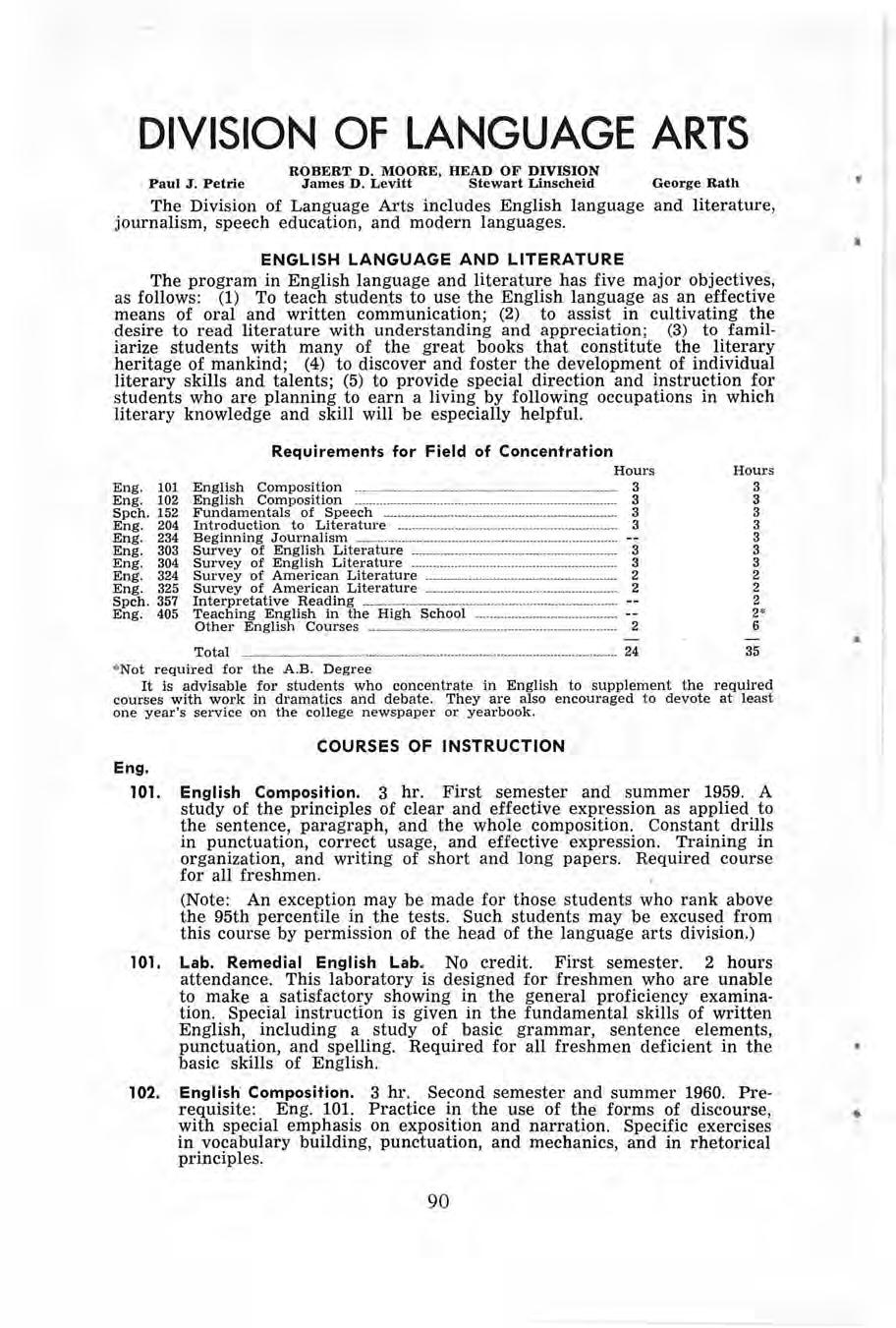
(Note : An exception may be made for those students who rank above the 95th p e rcentile in the tests. Such students may be excused from this course by permission of the head of the language arts division.)
101.
Lab. Remedial English Lab , No credit. First semester 2 hours attendance . This laboratory is designed for freshmen who are unable to make a satisfactory showing in the general proficiency examination . Special instruction is given in the fundamental skills of written English, including a study of basic grammar, sente nce elements, punctuation, and spelling Required for all freshmen deficient in the basic skills of English .
102. English Composition. 3 hr Second semester and summer 1960 Prerequisite : Eng. 101. Practice in the use of the forms of discourse, with special emphasis on exposition and narration. Specific exercises in vocabulary building , punctuation, and mechanics, and in rhetorical principles
204. Introduction to Literature. 3 hr. Each semester and summer. The appreciative study of literature in its various forms with reading and class discussion of specimens of_ poetry, drama, and prose . This course seeks to induce a pleasure in good literature and to develop discrimination and critical judgment. The relationship of literature to life and to the other arts is studied and an interest in ideas encouraged.
234. Beginning Journalism. 3 hr. Each semester and summer. A practical course in the writing and editing of news copy, covering minimum essentials. Members of the class do the reporting for the college newspaper, The Pedagogian. A basic course for those interested in journalism as a vocation. Open to those of sophomore standing or above.
435. Advanced Journalism. 3 hr. Second semester. Two hours a ttendance, two hours laboratory . Prerequisite: Eng. 234. Continuation of practical experience in writing and editing n ews copy . Special. emphasis on techniques in sponsorship of high school publications and school news publicity releases. Major positions on staff of college newspaper , The Pedagogian, filled from membership in this class ,
235. Newspaper Editing. Credit not to exceed two hours in any semester or four hours in the aggregate may be allowed to appointed editor or editors of the college newspaper , The Ped 1agogian.
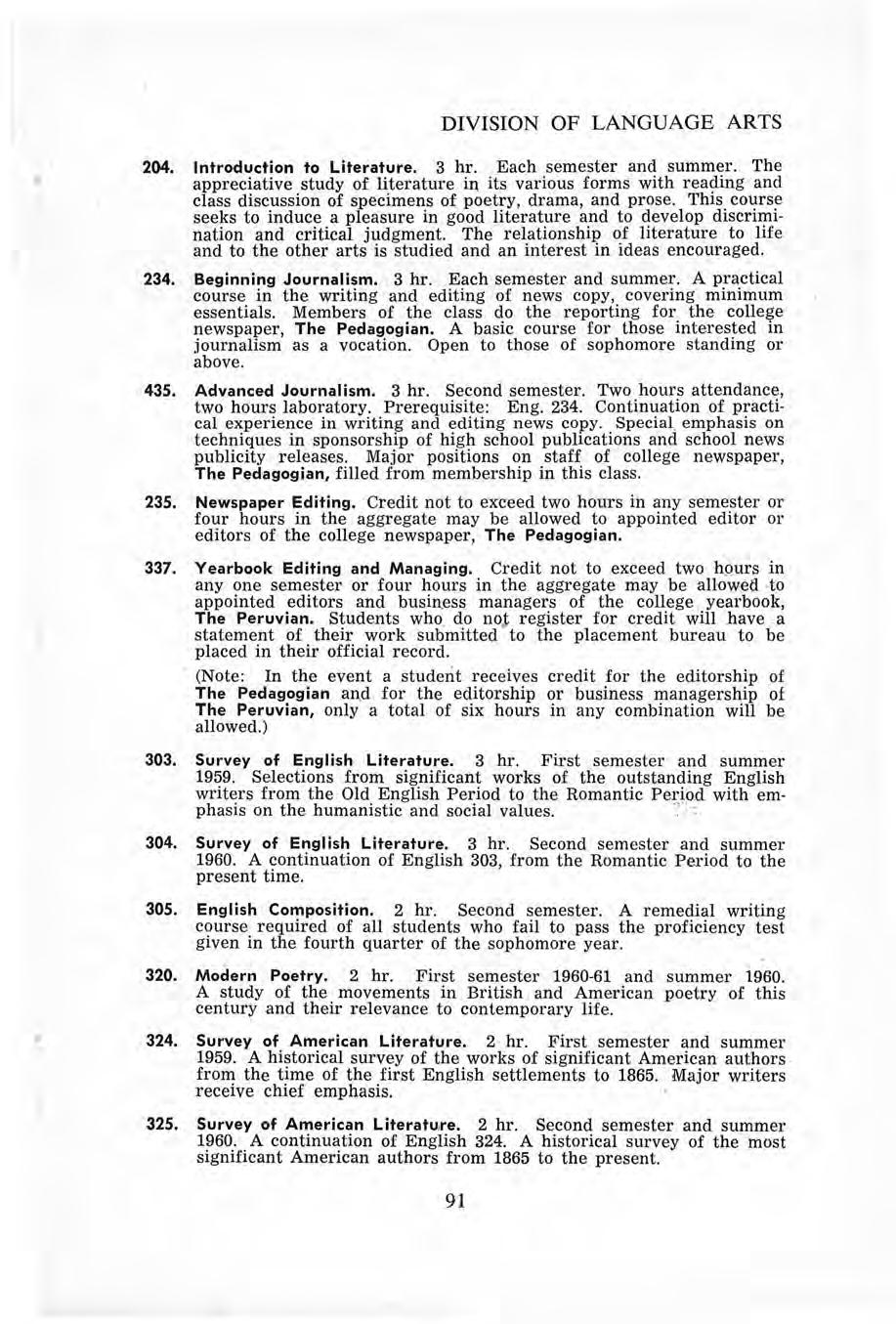
337. Yearbook Editing and Managing. Credit not to ex,ceed two h_qurs in any one semester or four hours in the aggregate may be allowed -to appointed editors and busin.es&, managers of the college . yearbook, The Peruvian. Students who. do no register for cr e dit will -have .a statement of their work submitted to the placement bureau to be placed in their official record.
(Note: In the event a student receives credit for the editorship of The Pedagogian an d for the editorship or business managership of The Peruvian, only a total of six hours in any combination will be allowed.)
303. Survey of English Literature. 3 hr First semester and summer 1959 Selections from significant works of the outstanding English writers from the Old En glish P eriod to the Romantic Period with emphasis on the humanistic and social values. ·· '·;
304. Survey of English Literature. 3 hr . Second semester and summer 1960. A continuation of English 303, from the Romantic Period to the present time.
305. English Composition. 2 hr Second semester. A remedial writing course required of all students who fail to pass the proficiency test given in the fourth quarter of the sophomore year.
320. Modern Poetry. 2 hr. First semester 1960-61 and summer 1960 A study of the movements in British and American poetry of this century and their relevance to contemporary life.
324. Survey of American Literature. 2 hr First semester and summer 1959 A historical survey of the works of significant American authors from the time of the first English settlements to 1865 Major writers receive chief emphasis. •
325. Survey of American Literature. 2 hr . Second semester and summer 1960. A continuation of English 324. A historical survey of the most significant American authors from 1865 to the present.
403G. Modern Fiction. 2 hr. Summer 1959 and second semester 1960-61. Prerequisite: senior standing. A consideration of fiction, from 1865 to the present.
405. Teaching English in the High School. 2 hr . On demand. This course is a study of the aims, objectives, and scope of English in the curriculum. Resources such as textbooks, film lists , special equipment, supplies, records, charts, and tests are examined and evaluated. Attention is given to special techniques for teaching the subject. Special materials and activities for "slow" and "g ifted" students are examined.
417. Shakespeare. 2 hr. second semester 1959-60 and summer 1959 . An interpretation of the plays by oral and silent readin g with respect to the Elizabethan stage and lan g ua ge
440G. The Mod~rn Drama. 2 hr. First semester 1959-60. Prerequisite : senior standing , Interpretation of plays by Continental, British, and American dramatists as "so mething that happens on a stage."
450. Great Books. 3 hr. On demand.
Speech is a code made up of audible and visible symbols which a person uses to express his thoughts and feelings, communicate his ideas, and adjust to that most fluid and unpredictable part of his environment, other people. In the speech department we try to r ealize the successful use of the items mentioned in the above definition. Attention is given to the defective, the adequate, and skilled. All pha ses of speech are covered including correction, interpretation, conversation, individual and conference speaking, and the special fields of drama and debate.
Requirements for Field of Concentration*
Fundamentals of Speech. 3 hr. Each semester and summer. The principles of speech. Development of bodily freedom, distinct utterance, and improved oral communication. Includes fundamental processes of speech correction and development with emphasis on the development of excellent speech habits and the diagnosis and treatment of elementary speech defects. Required course for all freshmen.
Public Speaking. 3 hr. Each semester and summer 1960. Training in effective methods of adapting composition and delivery to various types of audiences. A study is made of the forms of address, impelling motives, speech ends, speech organization, composition, and delivery . Practice is given in gathering, choosing, working, and mastering speech materials Direct and purposeful conversational delivery for the purpose of communication is stressed
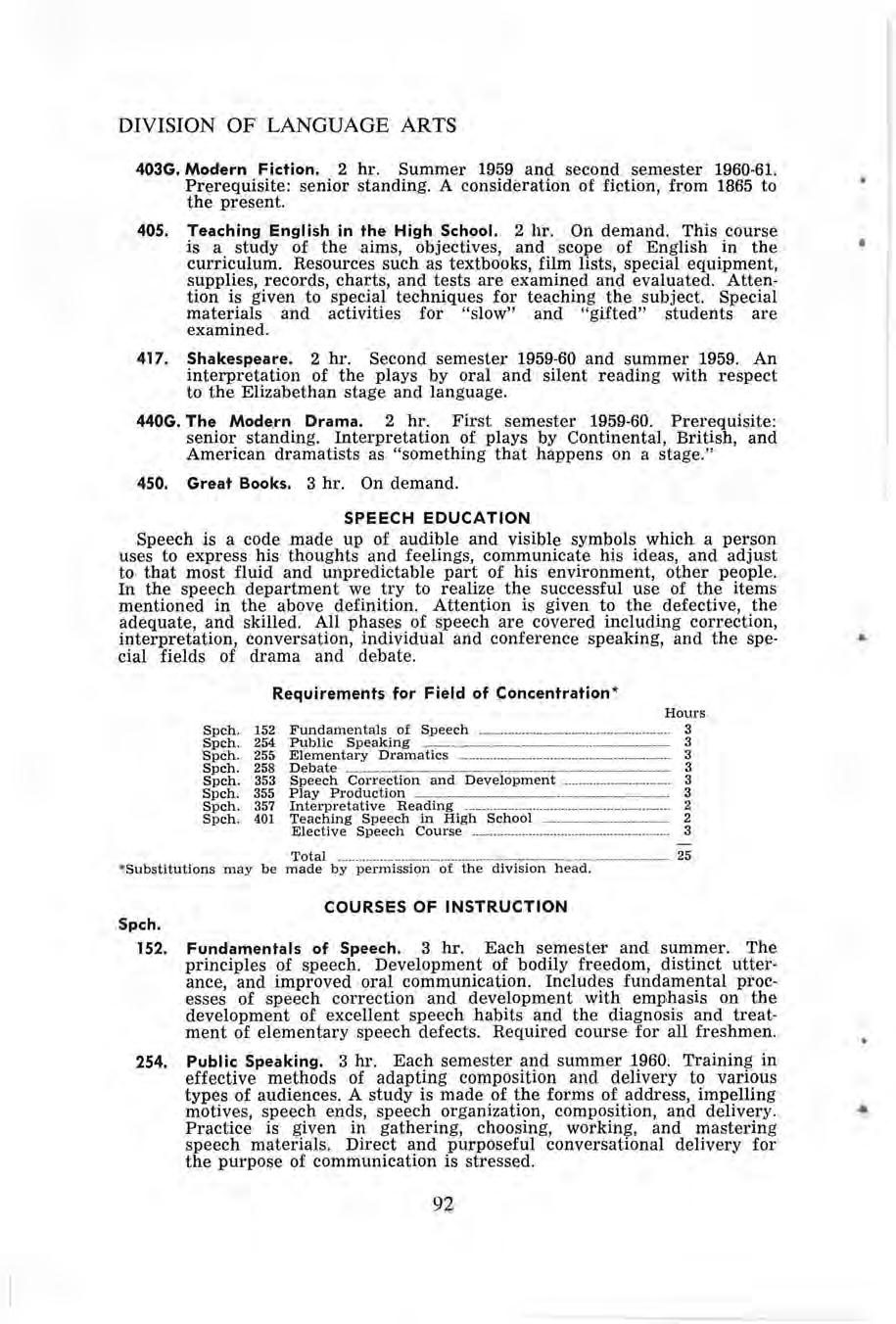
255. Elementary D,ramatics. 3 hr. First semester. A study and application of principles of dramatic interpretation with particular emphasis on personality development; the development of creative imagination; analyzing and playing a part; an intensive training in pantomime, posture , movement, stage business, body control, vocal control, dialogue, and characterization
258. Debate. 3 hr. First semester. Basic theory and practice of argumentation, the conventions of debate, parliamentary procedure, and the analysis of questions.
353. Speech Correction and Development . ..3 hr. Second semester and summer. The physiological factors involved in oral communication, the genetic basis of speech, and the development of excellent speech habits in the individual. Diagnosis and treatment of speech defects.
355. Play Production. 3 hr. Second semester and summer 1960. A course for the director of dramatics in schools and communities. It answers the fundamental questions pertaining to play selection, casting, directing, steps in rehearsal, scenery, lighting, costume, make-up, and business . organization .
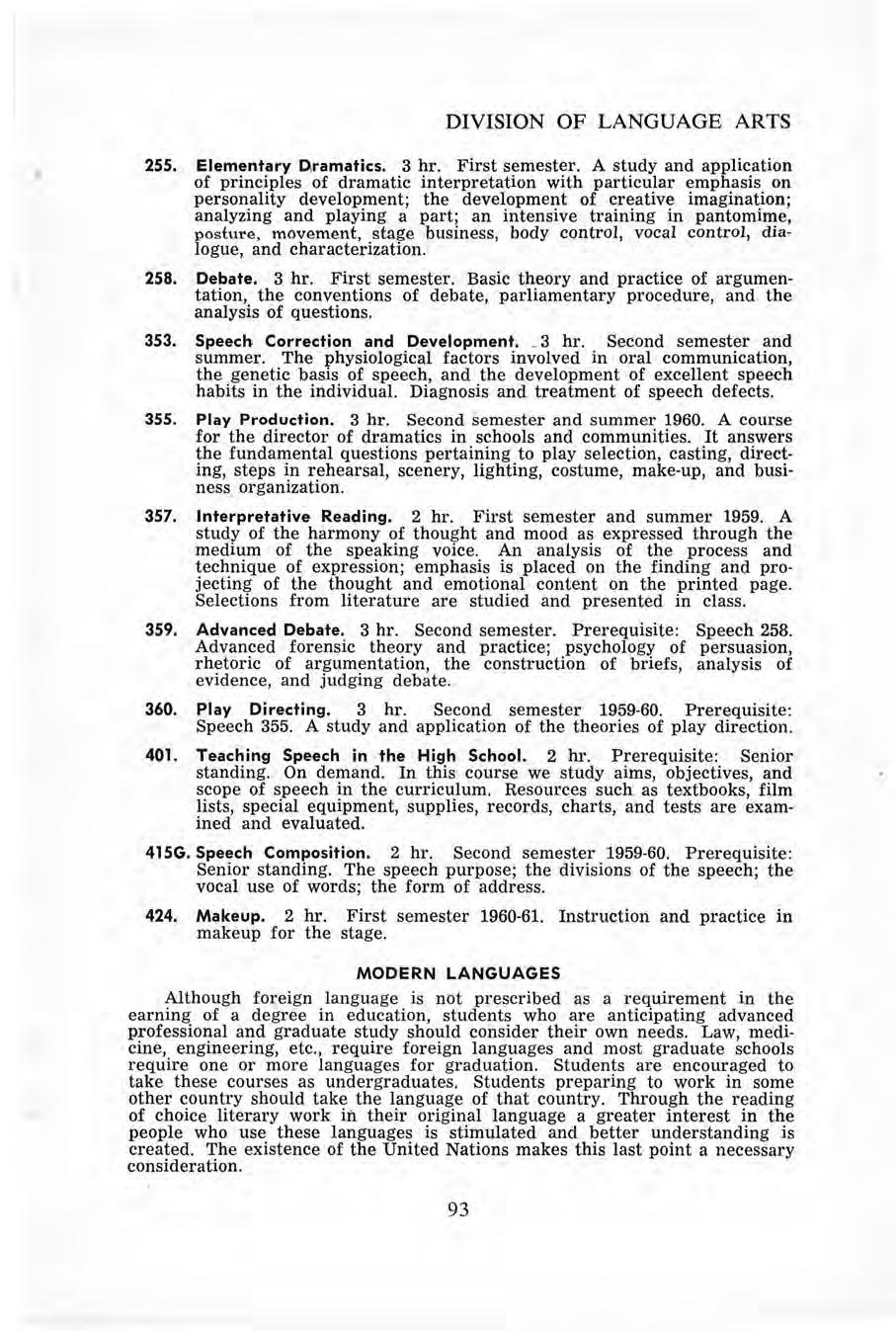
357. Interpretative Reading. 2 hr. First semester and summer 1959. A study of the harmony of thought and mood as expressed through the medium of the speaking voice. An analysis of the process and technique of expression; emphasis is placed on the finding and projecting of the thought and emotional content on the printed page. Selections from literature are studied and presented in class.
359. Advanced Debate. 3 hr. Second semester. Prerequisite : Speech 258. Advanced forensic theory and practice; psychology of persuasion, rhetoric of argumentation, the construction of briefs, analysis of evidence, and judging debate .
360. Play Directing. 3 hr. Second semester 1959-60 Prerequisite: Speech 355. A study and application of the theories of play direction
401. Teaching Speech in the High School. 2 hr. Prerequisite: Senior standing. On demand. In this course we study aims, objectives, and scope of speech in the curriculum. Resources such as textbooks, film lists, special equipment, supplies, records, charts, and tests are examined and evaluated .
415G. Speech Composition. 2 hr Second semester 1959-60. Prerequisite: Senior standing. The speech purpose; the divisions of the speech; the vocal use of words; the form of address.
424. Makeup. 2 hr. First semester 1960-61. Instruction and practice in makeup for the stage.
Although foreign language is not prescribed as a requirement in the earning of a degree in education, students who are anticipating advanced professional and graduate study should consider their own needs. Law, medicine, engineering, etc., require foreign languages and most graduate schools require one or more languages for graduation. Students are encouraged to take these courses as undergraduates. Students preparing to work in some other country should take the language of that country. Through the reading of choice literary work in their original language a greater interest in the people who use these languages is stimulated and better understanding is created. The existence of the United Nations makes this last point a necessary consideration .
Other com~inations may be arranged according to need or professional goal.
F,rench
101. Elementary French. 5 hr First semester. Beginners ' course It comprises the fundamental phases in the study of the F re nch language as: grammatical form, pronunciation, vocabulary. Work is done in reading, translation, and conversation.
102. Elementary French.. 5 hr. Second semester Prerequisite: Fr. 101 or equivalent. This is a continuation of Course 101. Here also stress is laid on grammar, syntax, oral drill, and conversation . Easy reading in modern French is given.
201. French Re.ading and Composition. 3 hr. First semester. Prerequisite: One year French or equivalent. The purpose of the course is to give the students a fair reading knowledge of French. Gr a mmar and syntax are studied on a wider basis. Stress is put on free composition, oral retelling and reading passages , and conversations. Material for reading is chosen so as to give the students the b est things they can read with enjoyment.
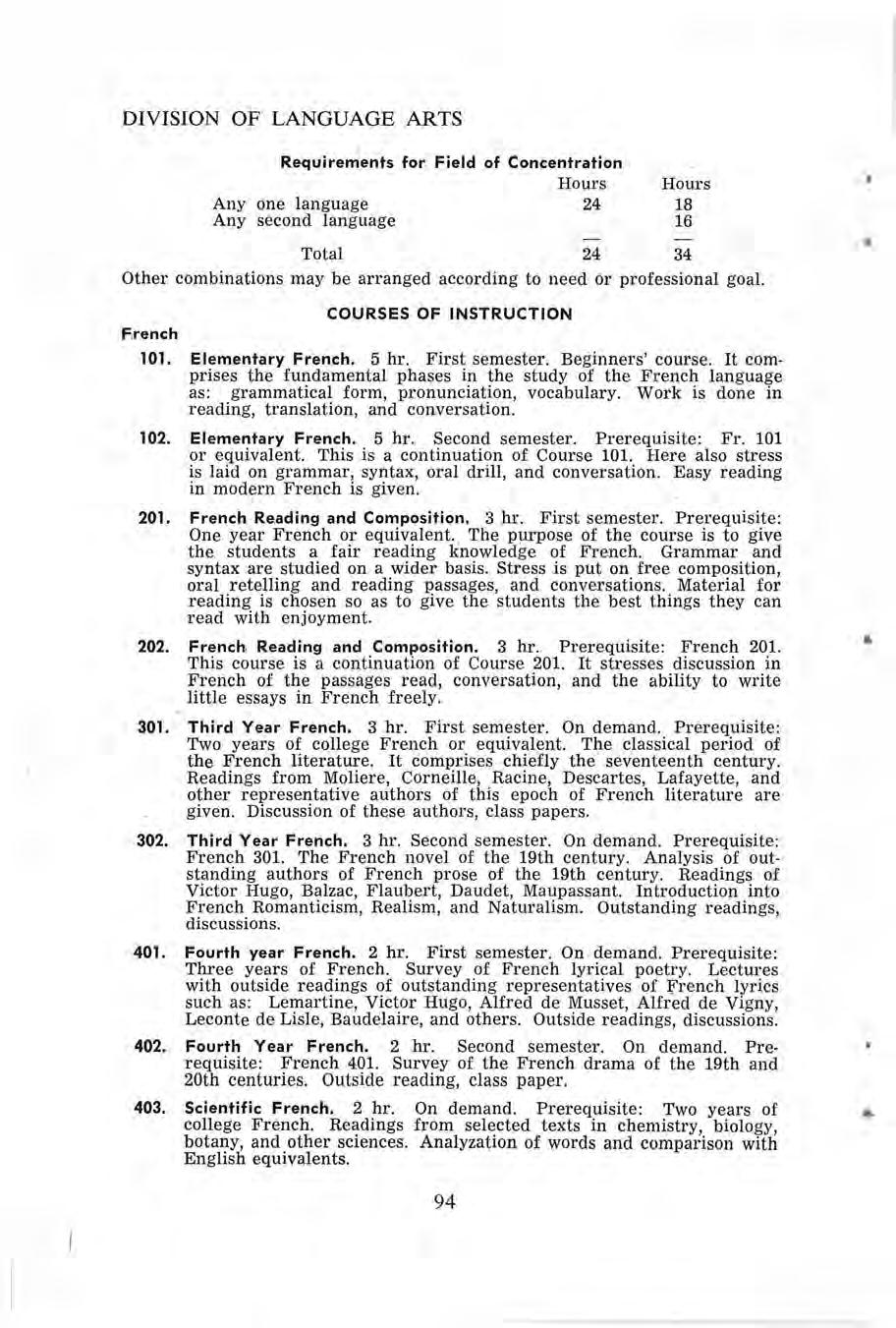
202. French, Reading and Composition. 3 hr. Prerequisite: French 201. This course is a continuation of Course 201. It stresses discussion in French of the passages read, conversation, and the ability to write little essays in French freely.
301. Third Year French. 3 hr First semester On demand. Prerequisite : Two years of college French or equivalent. The classical period of the French literature. It comprises chiefly the seventeenth century . Readings from Moliere, Corneille, Racine, Descartes, Lafayette, and other representative authors of this epoch of French literature are given. Discussion of these authors, class papers.
302. Third Year French. 3 hr. Second semester. On demand. Prerequisite : French 301. The French novel of the 19th century Analysis of outstanding authors of French prose of the 19th century. Readings of Victor Hugo, Balzac, Flaubert, Daudet, Maupassant. Introduction into French Romanticism, Realism, and Naturalism Outstanding readings, discussions .
401. Fourth year French. 2 hr. First semester. On - demand. Prerequisite: Three years of French. Survey of French lyrical poetry. Lectures with outside readings of outstanding representatives of french lyrics such as: Lemartine, Victor Hugo, Alfred de Musset, Alfred de Vigny, Leconte de Lisle, Baudelaire, and others. Outside readings, discussions.
402. Fourth Year French. 2 hr Second semester. On demand Prerequisite: French 401. Survey of the French drama of the 19th and 20th centuries Outside reading, class paper.
403. Scientific French. 2 hr On demand. Prerequisite: Two years of college French. Readings from selected texts in chemistry, biology, botany, and other sciences. Analyzation of words and comparison with English equivalents.
101. Elementary German. 5 hr First sem ester Beginners ' course Stress is placed on the fundamentals in grammar. Students are taught a proper pronunciation and must acquire a basic vocabulary. Emphasis is further placed on translation, oral drill, and conversation.
102. Elementary German. 5 hr. Second semester. Prerequisites : German 101 or equivalent. This course is a continuation of Course 101. It broadens the knowledge of grammar and syntax, adds more easy reading , and continues with conversation.
202. German Reading and Composition. 3 hr. Second semester . Pre • requisite : German 102 This is a continuation of Course 102. Reading of German authors is contin~ e d. Grammar and syntax are deepened and concluded .
301. Third Year German. 3 hr. First semester. On demand Prerequisite : Two years of college German or the equivalent. Classical period . The course comprises the essentials of the classical period of German literature and includes th e study of Lessing, Schiller, and Goethe.
302 . Third Year German. 3 hr Second semester. On demand Prerequisite : German 301. The German novel of 19th century. This is a continuation of Course 301. It introduces the student into the novel of German Romanticism and Realism. Selections from Auerback, Freytag, Raabe, Keller, Storm, C. F. Meyer, and Scheffel are read and discussed .
401. Fourth Year German. 2 hr. On demand. Prerequisite: Three yearsof German . Survey of German lyrical poetry. Lectures on German lyrics, beginning with folklore till the first part of the 20th century Movements in German lyrics are studied and discussed in their different phases . Outside reading .
402. Fourth Year German. 2 hr. On demand. Prerequisite: German 401. Survey of German drama. Especially the drama of -the 19th century is studied in its Romantic , Realistic, and Naturalistic aspects Outside reading . Papers, class di s cussion .
403. Scientific German. 2 hr. On demand. Prerequisite : Two years of college German or equivalent. Reading of texts in the field of sciences such as chemistry, physics , and biolo gy Study of origin of words and comparison with corresponding English expressions
404. German Literature of the Twentieth Century. 2 hr. On demand Prerequisite: Three years of German. A survey of the German literature of the 20th century including drama, prose, and lyrics of this period. Reading of authors like Gerhard Hauptman, R. Dehmel, D. Lilienkren , Reiner, Maria Rilke, Thomas Mann, Hans Grimm, E. Kelbenheyer, and others .
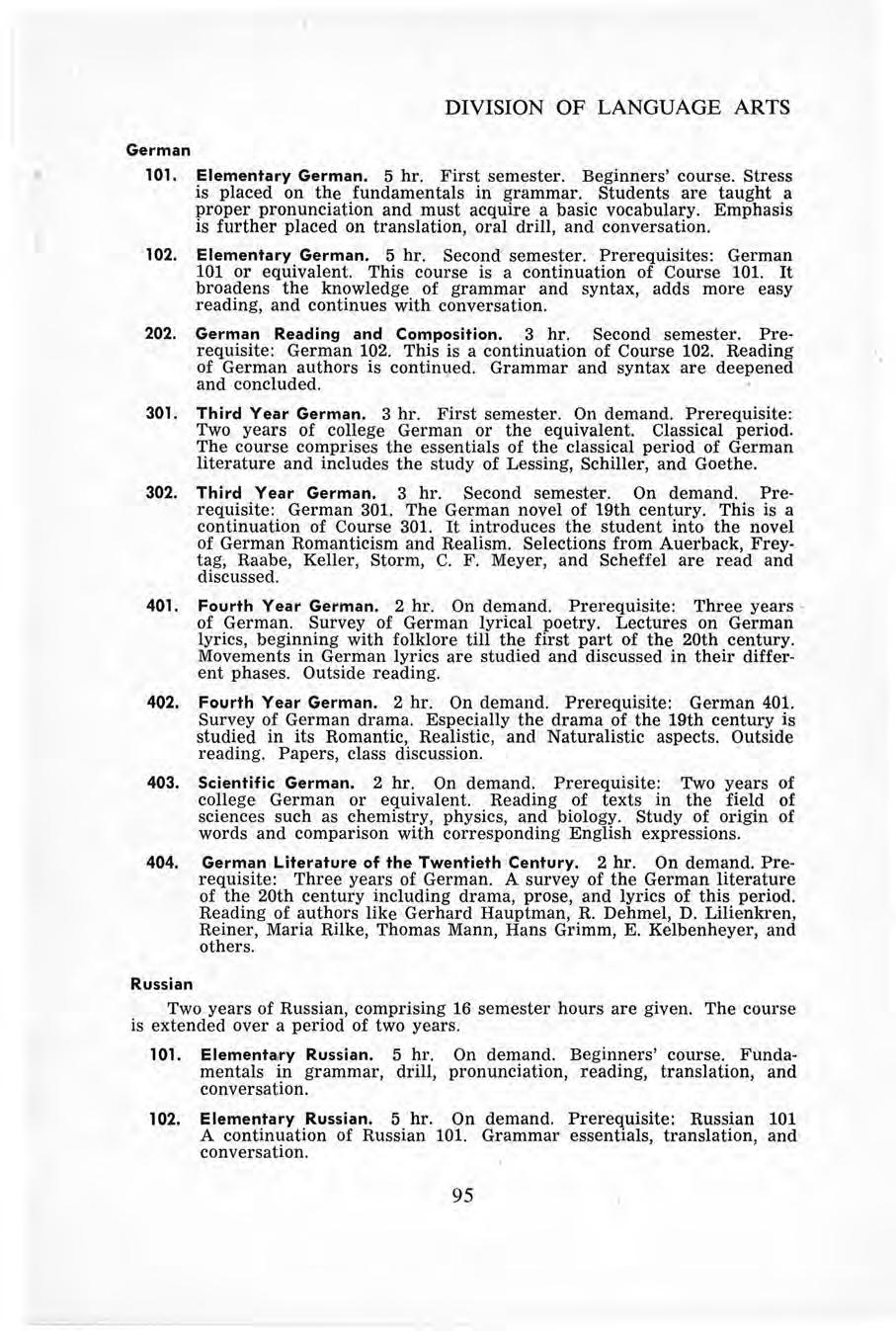
Russian
Two years of Russian, comprising 16 semester hours are given The course is extended over a period of two years .
101. Elementa,ry Russian. 5 hr. On dem a nd . Beginn e rs' course. Fundamentals in grammar, drill, pronunciation, reading, translation, and conversation.
102. Elementary Russian. 5 hr. On demand . Prerequisite: Russian 101 A continuation of Russian 101. Grammar essentials, translation, and conversation
201. Russian Reading and Composition. __ 3 hr. On demand. Prerequisite : Ten hours of colleg e Russian . The purpose of the course is to give the student a fair ability to speak the language, to read, and to compose.
202. Russian Reading and Composition. 3 hr On demand Prerequisite:
Thirteen hours of colle ge Russian. A continuation of Course 201. Conversation, reading, and composing. Reading of Lermentew and Puschkin
Elementary Spanish. 5 hr First semester 1960-61. Beginners' course. Fundamentals of grammar and pronunciation are studied. Ground work for the acquisition of a vocabulary is laid. Reading, translation, oral drill, and conversation for beginners.
Elementary Spanish. 5 hr. Second semester 1960-61. Prerequisite: Spanish 101 or equivalent. This is a continuation of Spanish 101. It widens the grammar, improves pronunciation, aids reading and con- r versation.
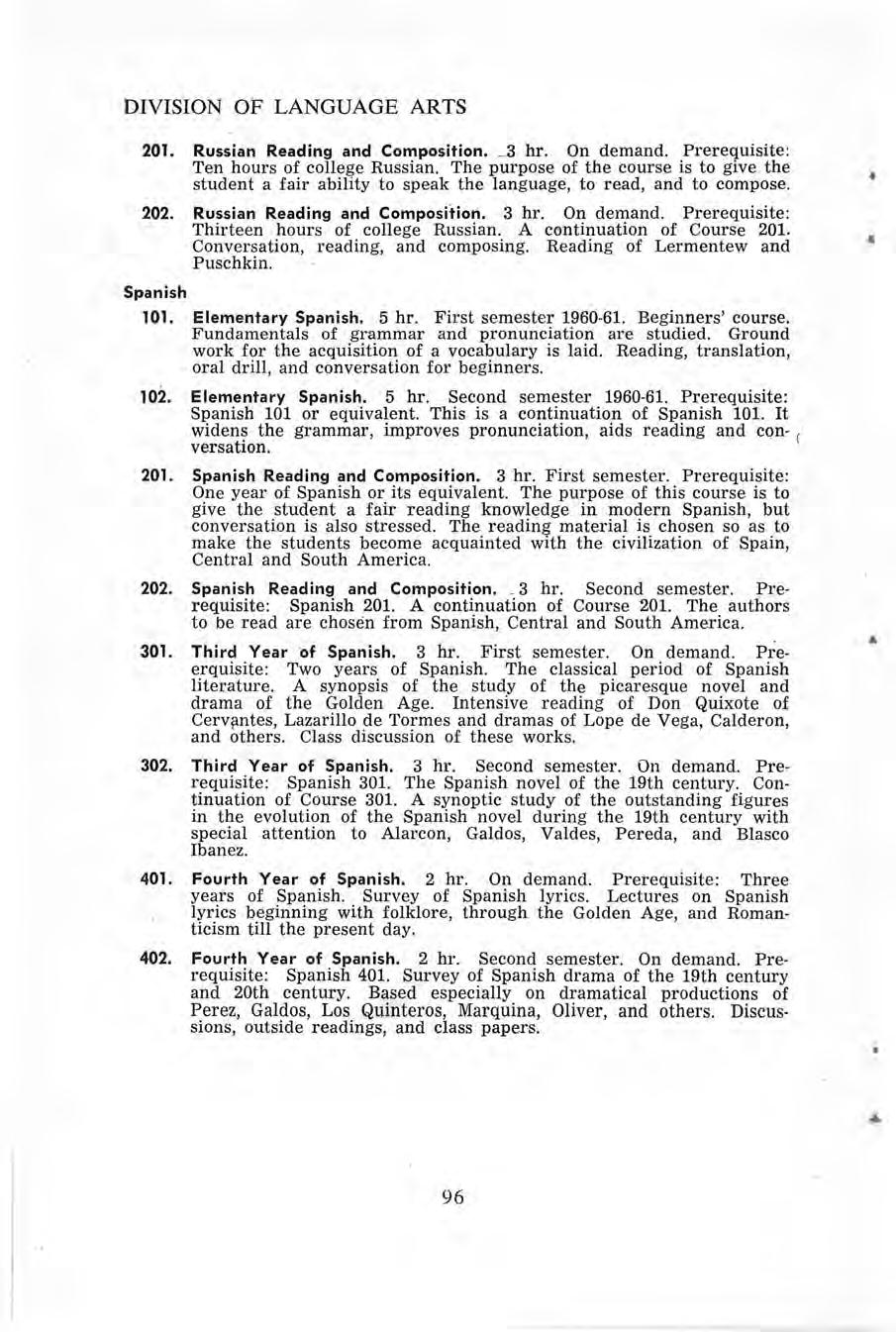
201.
Spanish. Reading and Composition. 3 hr. First semester. Prerequisite: One year of Spanish or its equivalent. The purpose of this course is to give the st udent a fair reading knowledge in modern Spanish, but conversation is also stressed. The reading material is chosen so as to make the students become acquainted with the civilization of Spain, Central and South America .
202. Spanish Reading and Composition. _ 3 hr. Second semester. Prerequisite : Spanish 201. A continuation of Course 201. The authors to be read are chosen from Spanish, Central and South America
301. Third Year of Spanish. 3 hr . First semester . On demand. Preerquisite: Two years of Spanish. The classical period of Spanish literature A synopsis of the study of the picares que novel and drama of the Golden Age Intensive readin g of Don Quixote of Cervimtes, Lazarillo de Tormes and dramas of Lope de Vega, Calderon, and others. Class discussion of these works .
302. Third Year of Spanish. 3 hr. Second semeste r . On demand. Prerequisite: Spanish 301. The Spanish novel of the 19th century . Continuation of Course 301. A synoptic study of the outstanding figures in the evolution of the Spanish novel durin g the 19th century with special attention to Alarcon, Galdos, Valdes, Pereda, and Blasco Ibanez.
401. Fourth Year of Spanish. 2 hr On demand. Prer e quisit e: Three years of Spanish. Survey of Spanish lyrics. Lectures on Spanish lyrics beginning with folklore, through the Golden A ge, and Romanticism tiU the present day.
402. Fourth Year of Spanish. 2 hr. Second semester . On demand. Prerequisite: Spanish 401. Survey of Spanish drama of the 19th century and 20th century. Based especially on dramatical productions of Perez, Galdos, Los Quinteros, Marquina, Oliver, and others. Discussions, outside readings, and class papers.
OWEN
HARLAN, HEAD OF DIVISION Dee V. Jarvis Frieda Rowoldt Raz.el Weare Louise Kregel Lester Russell Darrell Wininger Ina D. SproutThe division of Practical Arts embraces three fields-Business Education , Home Economics, and Industrial Arts. The offerings in these areas are wide and varied yet are of sufficient concentration that further study can be readily made .
The major objective of these areas is to provide the necessary training and preparation for teaching However, for those who do not desire to teach in these fields, the courses offered will provide opportunities for direct entry into vocational fields and will satisfy other person al or avocational interests.
The college offers a master's degree in industrial arts. See graduate bulletin for listing of courses and complete information .
BUSINESS EDUCATION
The Business Education curriculum of the college leads to the Bachelor of Science in Education degree which enables the student to qualify for the Nebraska Secondary School Certificate.
The curriculum may be modified to meet the requirements for the liberal arts degree . (See Index for listing of courses).
A specialized curriculum of one or two years duration is available in the department for those students who desire preparation for vocational employment. (See Index for these course listings.)
B .E . 101 as a prerequisite
Students earning the Liberal Arts ( A B.) degr ee may make some substitutions for above courses with approval of Head of Practi cal Arts Division.
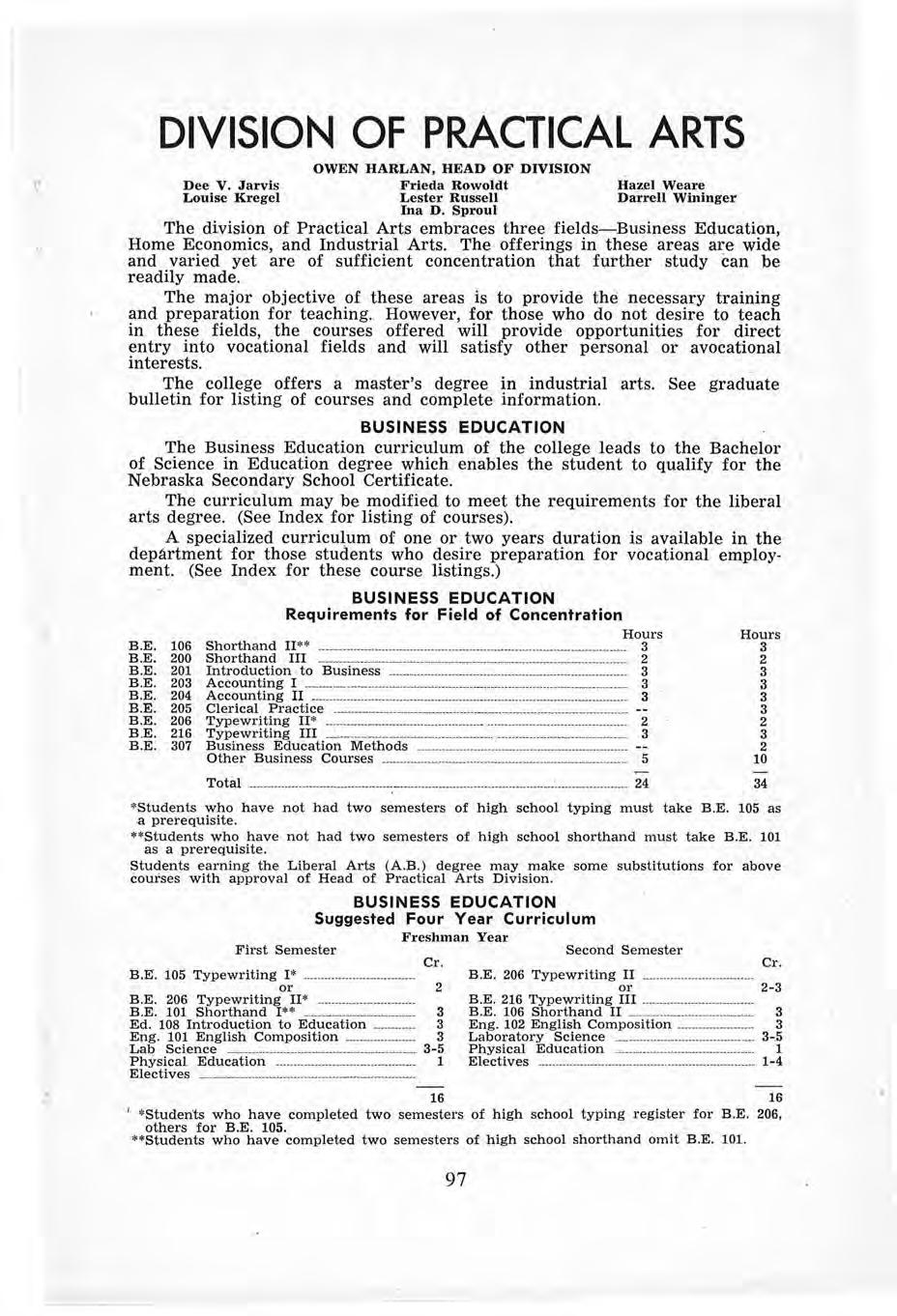
Shorthand 1-Elementary Shorthand Theory. 3 hrs. First semester and summer. Five hours attendance. An introduction to Gregg Shorthand Simplified through the study of a basic business vocabulary, organized for reading and writing practice with some initial dictation and transcription
105. Typewriting I-Beginning Typewriting. 2 hrs. First semester and summer. Five hours attendance . Mastery of keyboard, establishment of correct techniques, simple centering, manuscript typewriting, typewriting of various styles of business letters, and simp le tabulation .
106. Shorthand II-Applied Shorthand Theory. 3 hrs. Second semester and summer. Prerequisite : B. E. 101 or two semesters high school s horthand. Five ·hours attendance A continuation of the study of shorthand theory with the development of correct and rapid shorthand writing and reading . Instruction in the technique and practice of typewriting mailable transcripts from shorthand dictation .
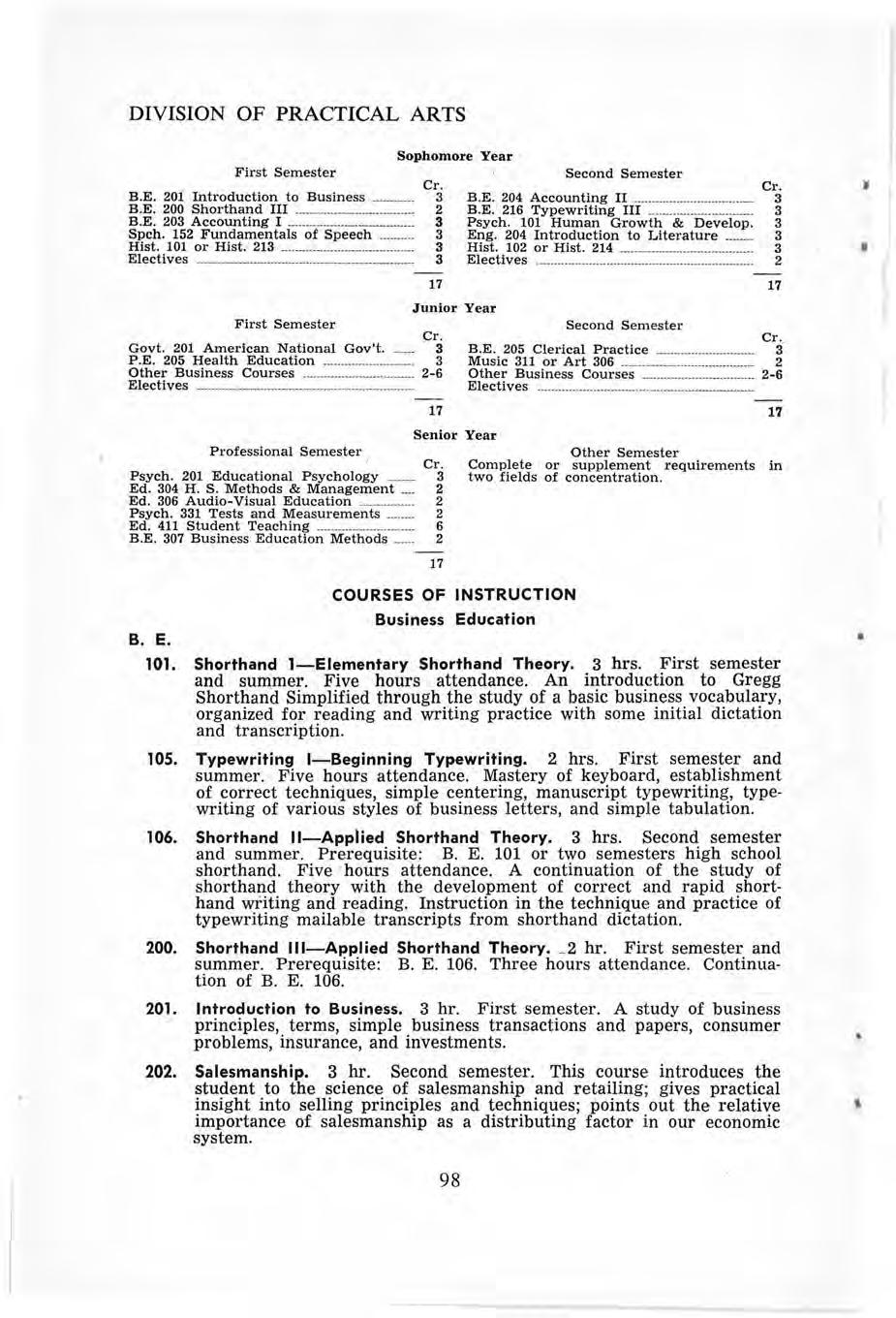
200. Shorthand Ill-Applied Shorthand Theory . __ 2 hr . First semester and summer Prerequisite : B. E 106 Three hours attendance Continuation of B. E. 106.
201. Introduction to Business. 3 hr First semester. A study of business principles, terms, simple business transactions and papers, consumer problems, insurance, and investments.
202. Salesmanship. 3 hr. Second semester . This course introduces the student to the science of salesmanship and retailing ; gives practical insight into selling principles and techniques; points out the relative importance of salesmanship as a distributing factor in our economic system.
203. Accounting I. 3 hr First semester. Five hours attendance. Designed to furnish a knowledge of the underlying principles of accounting and the application of such principles through problems and a practice set.
204. Accounting 11. 3 hrs. Second semester. Prerequisite : B. E. 203. Five hours attendance. A continuation of Accounting 203 with empha sis on partnership, corporation, and manufacturing accounting in addition to an analysis and interpretation of financial statements.
205. Clerical Practice. 3 hrs. Second semester. Three hours attendance, four hours laboratory. Prer e quisite : Ability to typewrite efficiently. Use of adding, calculating, duplicating, voice writing machines, and filing, with general office procedures.
206. Typewriting . 2 hr . Each semester. Prerequisite: B. E. 105 Typewriting or equivalent. Five hours attendance. Speed development, mastery of letter forms, advanced problems in centering, outlining, manuscript writing, and duplicating devices.
207. Shorthand IV-Dictation and T,ranscription . 3 hr s. Second semester. Four hours attendance. To give timed dictation and transcription practice of elementary business lette rs, reports, and articles. The emphasis will be commercially satisfactory quality and quantity of stenographic production.
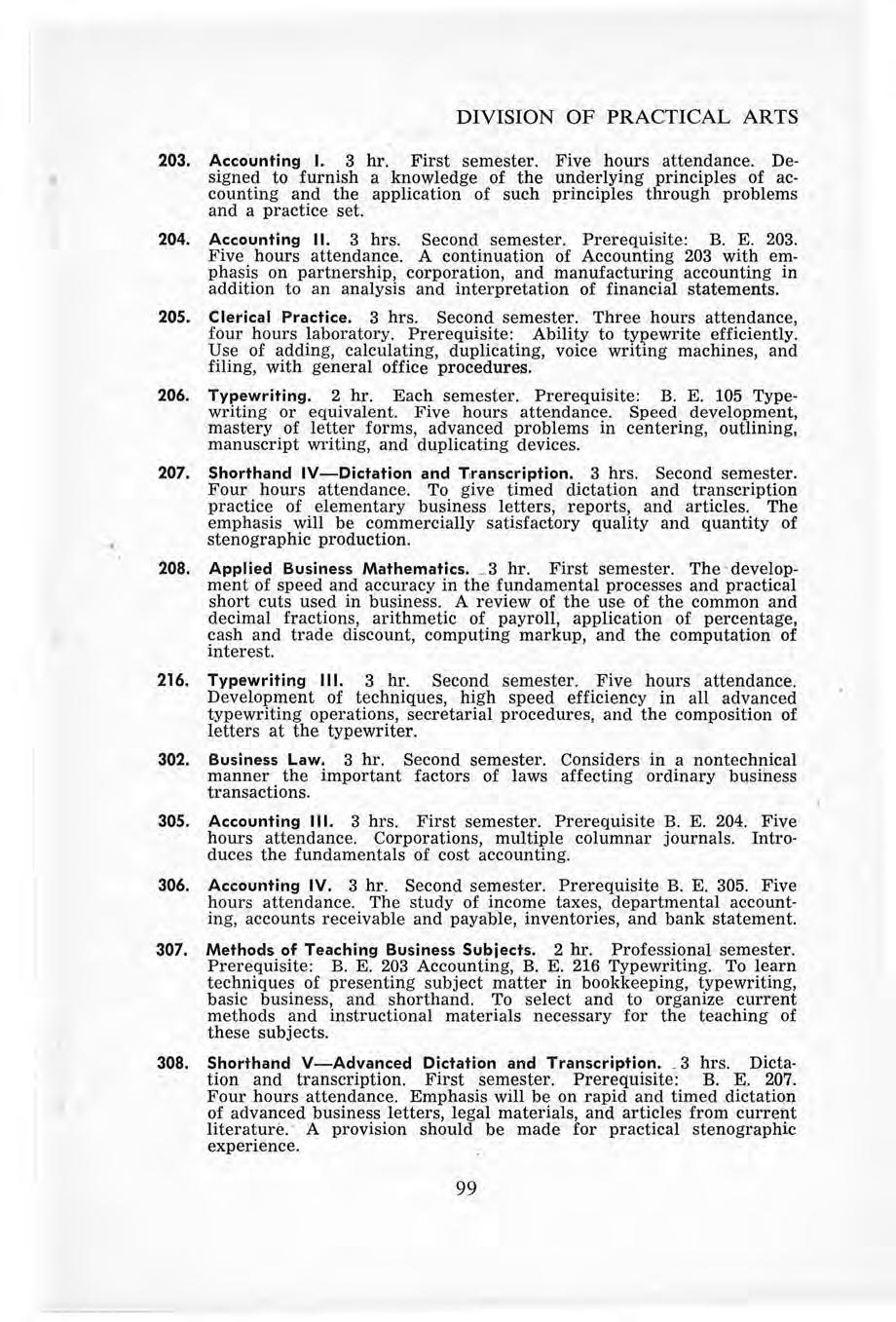
208. Applied Business Mathematics . .. 3 hr. First semester. The ·development of speed and accuracy in the fundamental processes and practical short cuts us e d in business A review of the use of the common and decimal fractions, arithmetic of payroll, application of percentage, cash and trade discount, computing markup, and the computation of interest.
216. Typewriting Ill. 3 hr. Second semester. Five hours attendance . Development of techniques, high speed efficiency in all advanced typewriting operations, secretarial procedures, and the composition of letters at the typewriter .
302. Business Law. 3 hr. Second semester. Considers in a nontechnical manner the important factors of laws affecting ordinary business transactions.
305. Accounting Ill. 3 hrs. First semester. Prerequisite B. E. 204. Five hours attendance. Corporations, multiple columnar journals. Introduces the fundamentals of cost accounting.
306. Accounting IV. 3 hr Second semester. Prerequisite B. E. 305. Five hours attendance. The study of income taxes, departmental accounting, accounts receivable and payable, inventories, and bank statement.
307. Methods of Teaching Business Subjects. 2 hr . Professional semester. Prerequisite : B. E. 203 Accounting, B E. 216 Typewriting To learn t e chniques of pres e nting subject matter in bookkeeping, typewritin g, basic bus iness, and shorthand. To select and to organize current methods and instructional materials necessary for the teaching of these subjects.
308. Shorthand V-Advanced Dictation and Transcription. _ 3 hrs . Dictation and transcription. First semester. Prerequisite: B . E . 207. Four hours attendance. Emphasis will be on rapid and timed dictation of advanced business letters, l egal materials, and articles from current literature. · A provision should be made for practical stenographic experience.
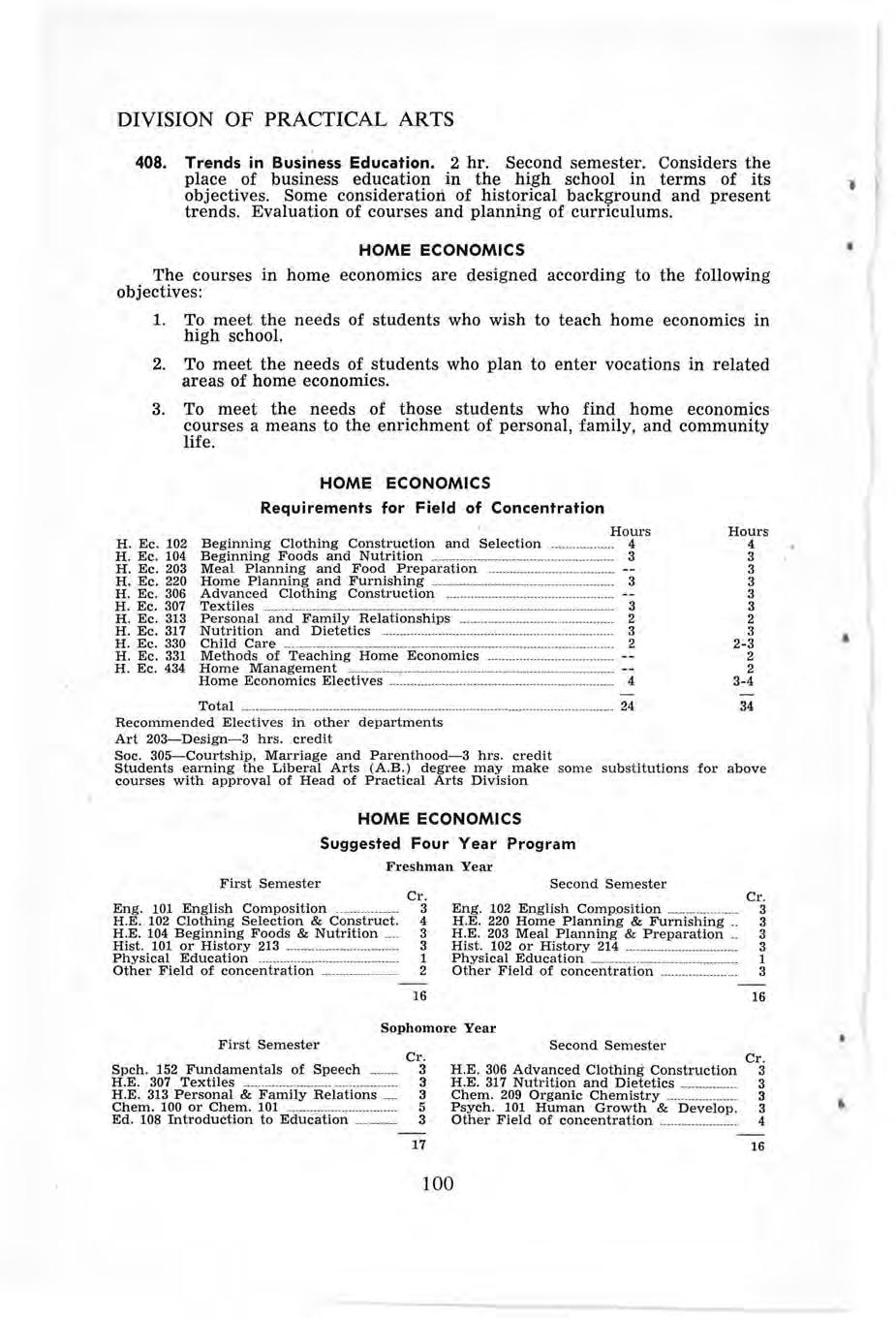
408. Trends in Business Education. 2 hr. Second semester. Considers the place of business education in the high school in terms of its objectives . Some consideration of historical background and present trends. Evaluation of courses and planning of curriculums.
The courses in home economics are designed according to the following objectives:
1. To meet the n eeds of students who wish to teach home economics in high school.
2. To meet the needs of students who plan to enter vocations in related areas of home economics.
3. To meet the needs of those students who find home economics courses a means to the enrichment of personal, family, and community life.
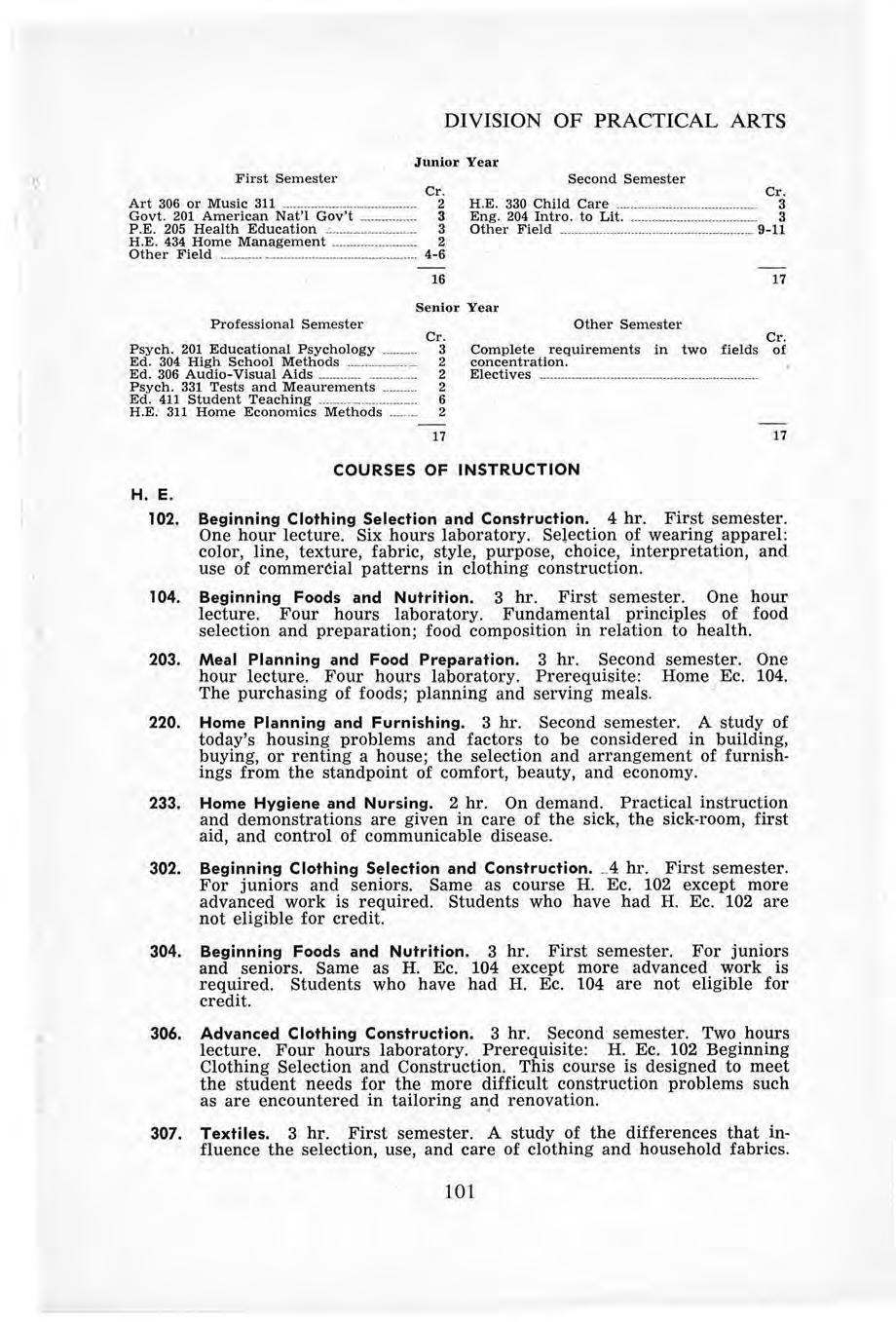
Beginning Clothing Selection and Construction. 4 hr. First semester. One hour lecture. Six hours laboratory Selection of wearing apparel : color, line, texture, fabric, style, purpose, choice, interpretation, and use of commercial patterns in clothing construction .
Beginning Foods and Nutrition. 3 hr First semester. One hour lecture. Four hours laboratory . Fundamental principles of food selection and preparation; food composition in relation to health .
Meal Planning and Food Preparation. 3 hr . Second semester. One hour lecture . Four hours laboratory. Prerequisite : Home Ee. 104. The purchasing of foods; planning and serving meals
Home Planning and Furnishing. 3 hr . Second semester. A study of today's housing problems and factors to be considered in building, buying, or renting a house; the selection and arrangement of furnishings from the standpoint of comfort, beauty, and economy
Home Hygiene and Nursing. 2 hr. On demand. Practical instruction and demonstrations are given in care of the sick, the sick-room, first aid, and control of communicable disease.
Beginning Clothing Selection and Construction . 4 hr. First semester. For juniors and seniors. Same . as course H. Ee. 102 except more advanced work is required. Students who have had H. Ee . 102 are not eligible for credit.
Beginning Foods and Nutrition. 3 hr. First semester. For juniors and seniors. Same as H . Ee. 104 except more advanced work is required. Students who have had H Ee. 104 are not eligible for credit.
306. Advanced Clothing Construction. 3 hr. Second semester. Two hours lecture . Four hours laboratory . Prerequisite: H . Ee . 102 Beginning Clothing Selection and Construction. This course is designed to meet the student needs for the more difficult construction problems such as are encountered in tailoring an_d renovation.
307. Textiles. 3 hr . First semester. A study of the differences that influence the selection, use, and care of clothing and household fabrics
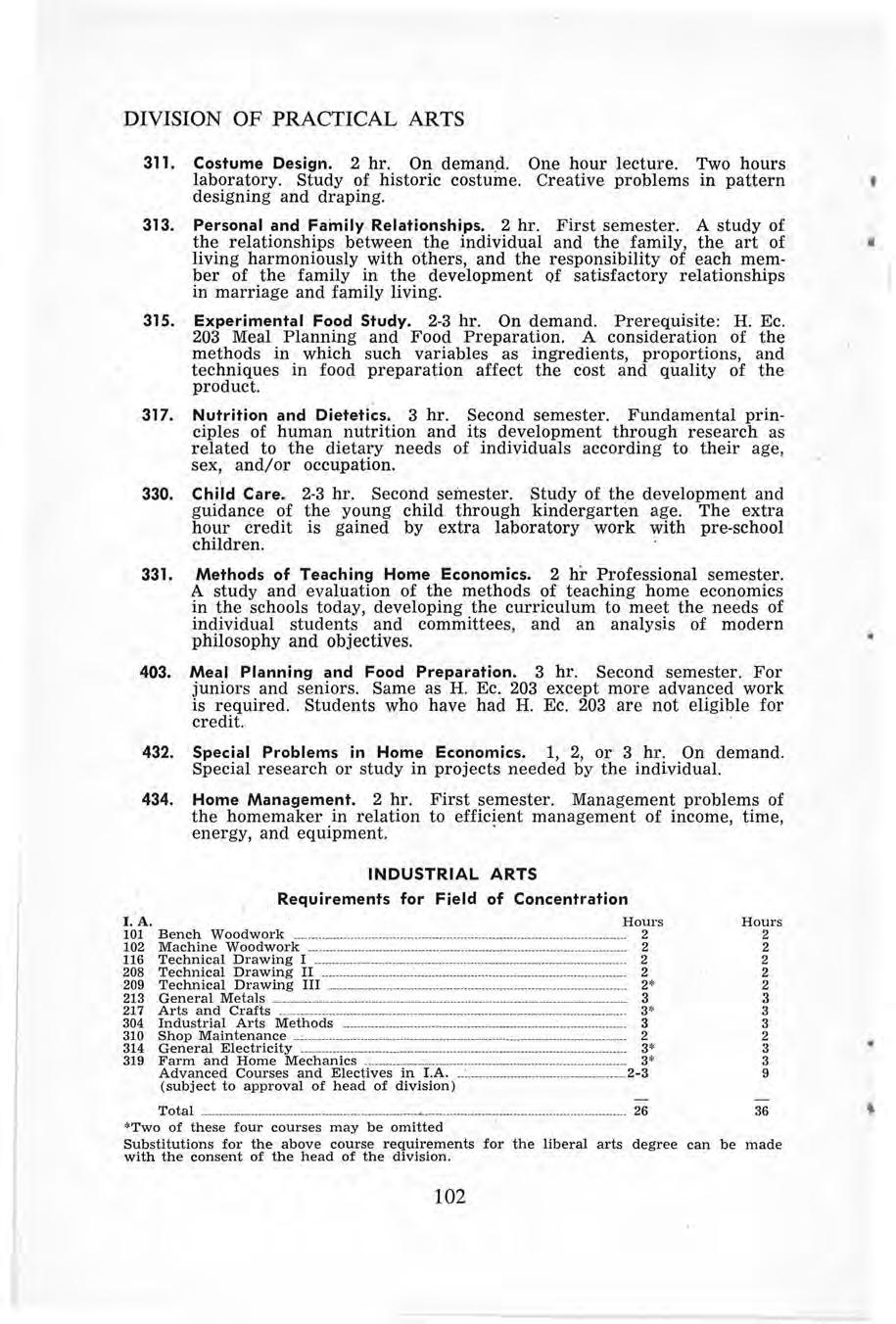
311. Costume Design. 2 hr . On deman d . One hour lecture. Two hours laboratory Study of historic costume. Creative problems in pattern designing and draping.
313. Personal and Family Relationships. 2 hr. First semester. A study of the relationships between the individual and the family, the art of living harmoniously with others, and the responsibility of each member of the family in the development of satisfactory relationships in marriage and family living .
315. Experimental Food Study. 2-3 hr . On demand. Prerequisite: H. Ee. 203 Meal Planning and Food Preparation. A consideration of the methods in which such variables as ingredients, proportions, and techniques in food preparation affect the cost and quality of the product.
317. Nutrition and Dietetics. 3 hr. Second semester. Fundamentai principles of human nutrition and its development through research as related to the dietary needs of individuals according to their age, sex, and/or occupation.
330. Chi .Id Care. 2-3 hr Second semester. Study of the development and guidance of the young child through kindergarten age. The extra hour credit is gained by extra laboratory work with pre-school children
331. Methods of Teaching Home Economics. 2 hr Professional semester. A study and evaluation of the methods of teaching home econ omics in the schools today, developing the curriculum to meet the needs of individual students and committees, and an analysis of modern philosophy and objectives.
403. Meal Planning and Food Preparation. 3 hr. Second semester . For juniors and seniors. Same as H. Ee. 203 except more advanced work is required. Students who have had H. Ee 203 are not eligible for credit. ·
432. Special Problems in Home Economics. 1, 2, or 3 hr : On demand Special research or study in projects needed by the individual.
434. Home Management. 2 hr. First semester. Management problems of the homemaker in relation to effictent management of income, time, energy, and equipment.
COURSES OF INSTRUCTION
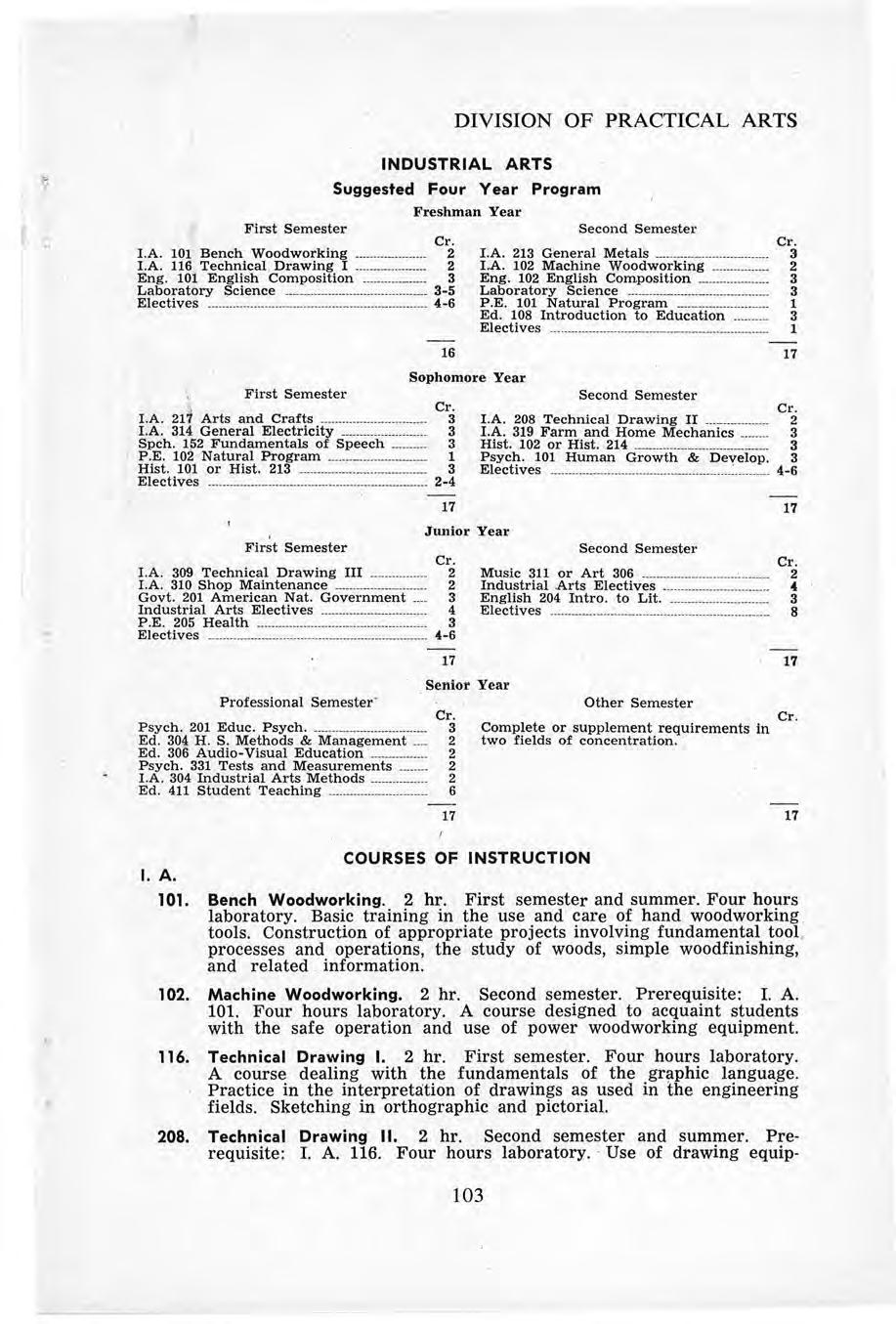
Bench Woodworking. 2 hr. First semester and summer. Four hours laboratory. Basic training in the use and care of hand woodworking tools. Construction of appropriate projects involving fundamental tool , processes and operations, the study of woods, simple woodfinishing, and related information. ·
Machine Woodworking. 2 hr . Second semester. Prerequisite: I. A. 101. Four hours laboratory. A course designed to acquaint students with the safe operation ·and use of power woodworking equipment.
Technical Drawing I. 2 hr. First semester. Four hours laboratory. A course dealing with the fundamentals of the graphic language. Practice in the interpretation of drawings as used in the engineering fields . Sketching in orthographic and pictorial.
Technical Drawing II. 2 hr. Second semester and summer. Prerequisite: I. A. 116. Four hours laboratory. · Use of drawing equip•
ment. Studies in orthographic projection including auxiliaries and sections. Practice in freehand lettering.
209. Technical Drawing Ill. 2 hr. First semester and summer . Prerequisite : I. A. 208. Four hours laboratory. Working drawings, developments, pictorial representations, tracing, and blueprinting.
213. General Metals. 3 hr . Second semester and summer. Six hours laboratory. Emphasis will be placed on the fundamental operations in the various metal areas of sheet metal, bench metal, forging and heat treating, casting, welding, and elementary machining
'
217. Arts and Crafts. 3 hr . First semester and summer . Six hours laboratory. Open to all students This course deals with fundamentals in working with plastic, leather, art metal, and other craft media
304. Industrial Arts M~thods and Observation. 3 hr. Professional semester. The course will emphasize teaching methods and aids , course construction, testing, shop discipline, grading, safety, and other problems pertinent to the teaching of the Industrial Arts.
305. Wood Finishing. 2 hr First semester and summer. Prerequisite: I. A. 102 or by special permission. Four hours laboratory. Designed to give information about and experience in using the principal types of woodfinishing materials suitable for work in school shops.
309. Woodturning. 2 hr. On demand. Prerequisite : I. A. 102. Four hours laboratory. A study of the fundamentals of spindle and faceplate turning.
310. Shop Maintenance. 2 hr . First semester and summer. Four hours laboratory. Instruction in the use and care of equipment commonly found in the industrial arts shop and a study of the various sharpening devices. Practice will be given in the conditioning of hand and power saws, knife and tool sharpening, and setting up of equipment.
315. General Safety Education. 3 hr. Second semester. This course is designed to familiarize the student with problems of accident prevention and conservation of human life and limb. Emphasis will be placed in the following areas: occupational, transportation , farm, and the home and school. Instructional materials will be d eveloped · and studied.
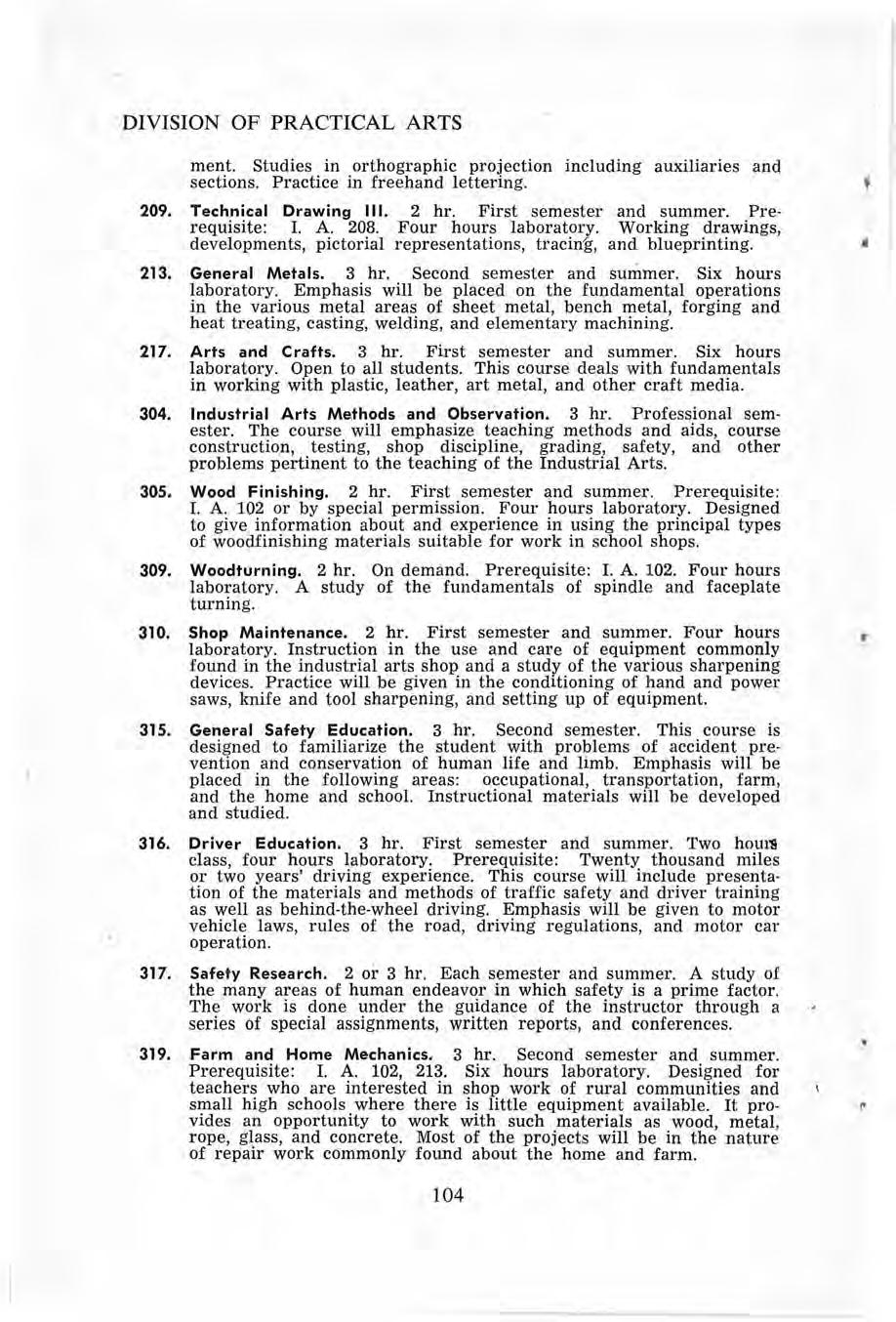
316. Driver Education. 3 hr. First semester and summer . Two hours class, four hours laboratory. Prerequisite: Twenty thousand miles or two years' driving experience. This course will include presentation of the materials and methods of traffic safety and driver training as well as behind-the-wheel driving Emphasis will be given to motor vehicle laws, rules of the road, driving regulations, and motor car operation .
317. Safety Research. 2 or 3 hr . Each semester and summer. A study of the many areas of human endeavor in which safety is a prime factor. The work is done under the guidance of the instructor through a series of special assignments, written reports, and conferences.
319. Farm and Home Mechanics. 3 hr. Second semester and summer
Prerequisite: I. A. 102, 213. Six hours laboratory. Designed for teachers who are interested in shop work of rural communities and small high schools where there is little equipment available. It provides an opportunity to work with such materials as wood, metal, rope, glass, and concrete. Most of the projects will be in the nature of repair work commonly found about the home and farm
321. Machine Woodworking. 2 or 3 hr. First semester and summer. A continuation of I. A. 102. Designed to further acquaint students in the proper use of woodworking machinery and to provide training over a wider scope of machine operations. Also further study of woods and their identification.
406. Upholstery. 2 hr . Second semester and summer . Prerequisite: I. A. 102 or by special permission. Designed to give experience in and information about various methods of construction in upholstery both with and without use of springs.
410. Architectural Drawing. 2 hr. First semester and summer Prerequisite: I. A. 208. Four hours laboratory. A practical course for students, home builders, and others desiring a knowledge of construction of small frame buildings . Floor plan, elevations details , standard conventions , and specifications.
411. Descriptive Geometry. 2 hr Second semester. Prerequisite: I. A. 209. Four hours laboratory. This course gives added training in the use of the principles of orthographic drawing. Problems involve the · visualization of points, lines and planes, intersection of surfaces and solids, development of surfaces. Of special interest to pre-engineering students.
412. Industrial Arts for Elementary Teachers. 2 hr. Second semester and summer. Four hours laboratory. Designed especially for elementary rural teachers Emphasis is on the development of fundamental skill in working with woods and other materials, teaching methods, and study of tools
414. General Electricity. 3 hr First semester and summer. Prerequisite: I. A 102 and 213. Six ·hours laboratory. Basic principles and practice with the various applications of electricity in industry and the home . Units covered within the course include basic circuits, lighting, heating, motors , automotive electricity, and elementary radio and electroni,cs
418. Welding. 2 hr. First semester and summer. Prerequisite: I. A. 213. Four hours laboratory. Practice in the use of the oxy-acetylene torch and the arc-welding machines. Study of the common fluxes as directly related to welding; practice in brazing and welding of the common metals as cast iron, steel, and aluminum.
422. Machine Woodworking. 2 hr. Second semester and summer . Prerequisite: I. A. 321 or by permission. Four hours laboratory . Modern production methods and procedures will be studied in working out group projects.
423. Advanced Metal Work. 2 hr. Ind. Arts Elective. Prerequisite: I. A. 213 and permission. Four hours laboratory A second course in metal work with emphasis in the areas of heat treatment, foundry and machine tool operation
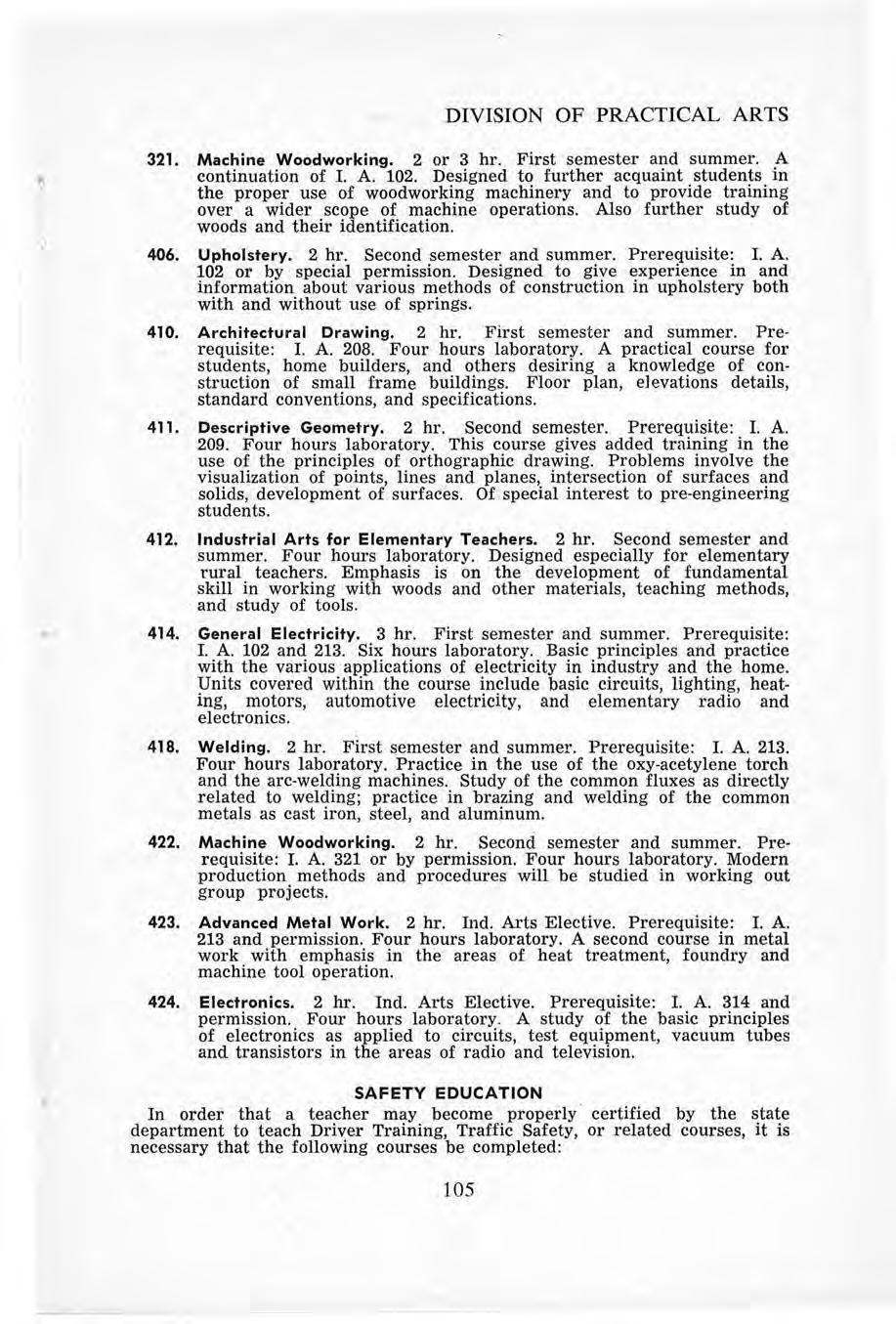
424. Electronics. 2 hr. Ind . Arts Elective. Prerequisite: I. A. 314 and permission. Four hours laboratory. A study of the basic principles of electronics as applied to circuits, test equipment, vacuum tubes and transistors in the areas of radio and television.
In order that a teacher may become properly certified by the state department to teach Driver Training, Traffic Safety, or related courses, it is necessary that the following courses be completed :
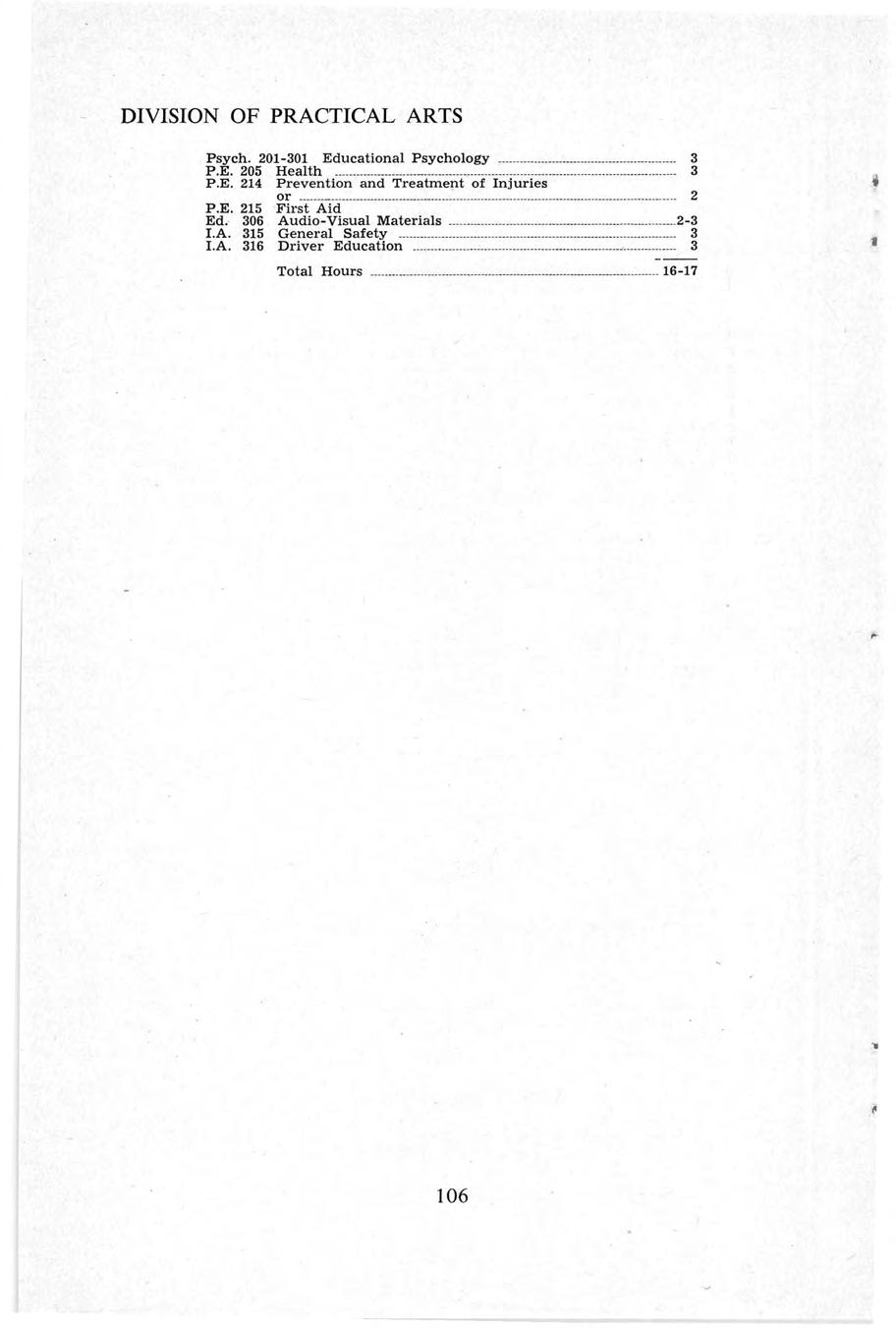
The Division of Science and Mathematics aims to provide for the needs of students in teacher preparation, pre-professional areas, and general education. In each of these, mathematics and science is regarded both as an organized body of knowledge ·and as a method of investigation . Open-mindedness and a genuine appreciation of our environment is encouraged. The relation of these subjects to current affairs, the dependence of mod e rn society upon the sciences, th e research features of industry, medicine and government, as well as vocational opportunities iii. the various fields are included in the program
The Division of Science and Mathematics includes the subdivisions of biology, chemistry , earth science, general science , mathematics, physical scie nce and physics . Requirements for · concentration in any area are given in each subdivision. Students are urged to obtain a wide range of training in several of these fields. Those who concentrate their training in a particular field of science, with the intention of teaching are advised to take extensive work in one or two other fields.
Course of Instruction General Biology · (Plant). 3 hr. Each semester and Summer. Two hours classwork. Two or three hours laboratory . A basic course in botany.
General Biology (Animal). 3 hr Each semester and summer. Two hours classwork. Two or three hours laboratory. A basic course in zoology
Invertebrate Zoology. 3 hr . First semester. Prerequisite : Biology 102. Two hours classwork and two to three hours of laboratory. Structure, cla ssification, and relationships of the invertebrate animals. Vertebrate Zoology. 3 hr. Second semester following Biology 203. Prerequisite: Biology 102. Two hours classwork and two to three hours of laboratory The anatomy, development, and phylogeny of the vertebrates .
General Bacteriology. 3 hr. Second semester, 1960-61. Prerequisite: Biology 101. A basic course in chemistry recommended. Two hours classwork and two to three hours laboratory. An introduction to bacteriology.
Courtship, Marriage, and Parenthood. 3 hr. Second semester. Prerequisite: PE 205 . A study of attitudes, habits, and ideals which
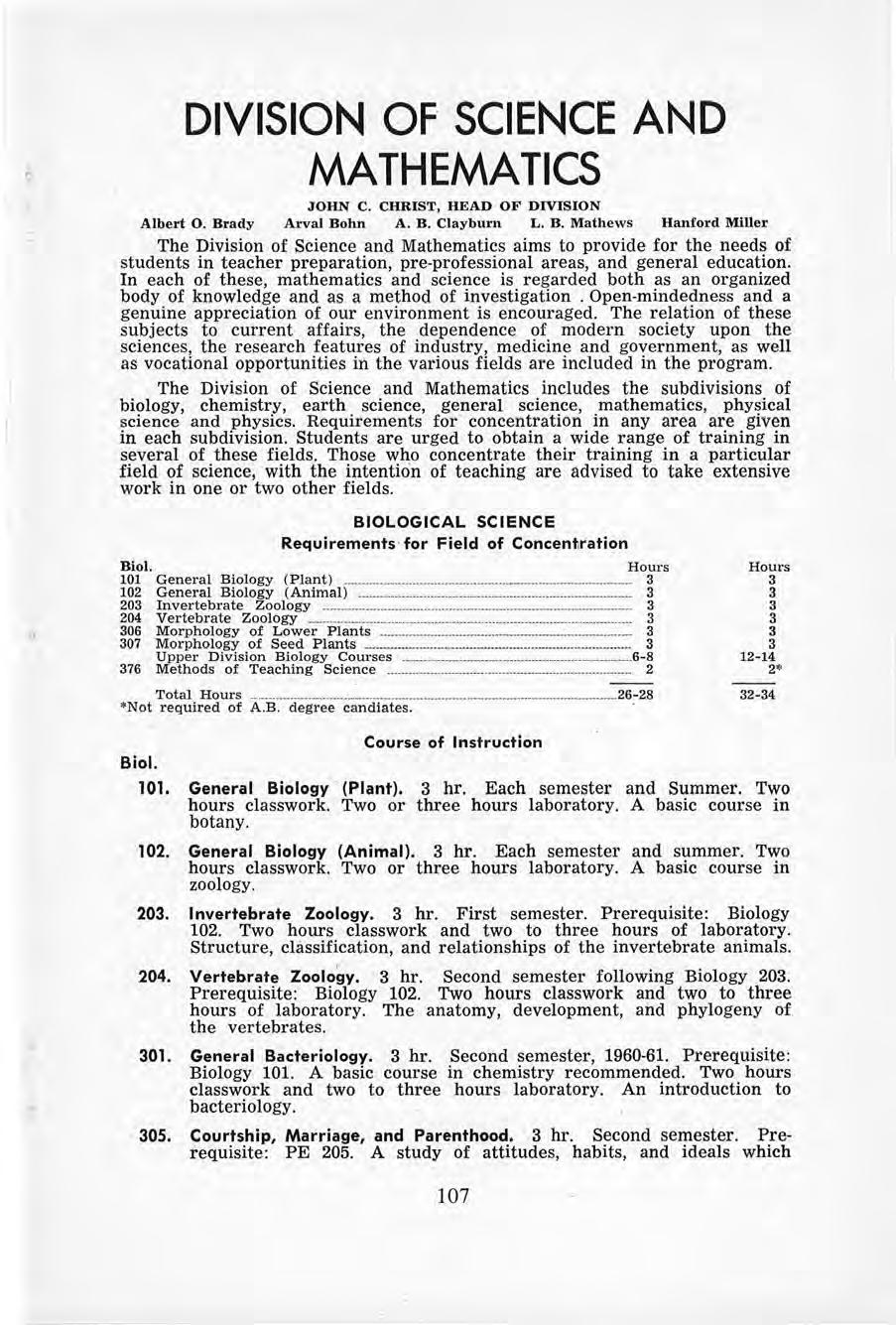
make for wholesome relationships between the sexes and the establishment of a permanent and happy family life. Does not apply on a biology group but is highly recommended as an elective. Also listed as Sociology 305 .
306. Morphology of the Lower Plants. 3 hr. First semester . Prerequisite: Biology 101. Two hours classwork, two to three hours laboratory Structure , anatomy, and form of the lower plants, and their effects on man .
307. Morphology of the Seed Plants. 3 hr . Second semester, following Biology 306. Prerequisite: Biolo gy 101. Two hours classwork, two to three hours laboratory. Form and structure of the seed plants and their economic value .
310. Biological Readings. 1-4 hr. Each semester and summer by special permission . By arrangement only. Work is done under the guidance of the instructor through a series of written reports and conferences. May not be used to meet science requirements.
404G. Genetics. 3 hr. , Second semester, 1959-60 Three hours classwork The principles of heredity.
405G. Histology. 3 hr On demand. Prerequisite: 15 hours of biology
One hour classwork and at least 4 hours of laboratory per week. A detailed study of the microscopic anatomy of mammalian organs.
406G. Embryology. 3 hr . On demand. Prerequisite : 15 hours of selected biology courses. Two hours classwork and three or more hours of laboratory . Embryology as exemplified by the frog, th e chick, the pig, and man .
407G. Human Physiology. 2 hr . On demand. Prerequisite: At least two courses in animal biology, PE 205. A detailed study of functions of the human organs.
415G. Taxonomy. 3 hr. First semester, 1959-60. Two hours classwork and two to four hours of laboratory work and field study. The classification and identification of plants Of considerable value to teachers of biology
417G. Ecology. 3 hr . First semester, 1960-61. Three hours classwork . A study of organisms in relation to their environments.
421G. Parasitology. 2 hr. On demand. Prerequisite: 15 hours of biology. From three to four hours of laboratory and discussion. A study of the morphology and life histories of parasites affecting man and the domestic animals.
422G. Entomology. 3 hr. On demand. Two hours classwork and two to four hours of labora tory and fieldwork. Morphology, classification, life histories distribution, and economic importance of insects . Prerequisite: 15 hours of biology including Biology 102 and 203 or equivalent.
501. The History of Biology. 1-4 hi:. Summer, 1960 Open to graduates only Extensive reading in the history of biology Reports, conferences, and interviews will be a part of this course . Permission of instructor required for registration.
502. Biology Problems. 1-6 hr. Summer, 1959. Open to graduates only. Permits student to do advanced work in various fields of biology
Prerequisite: The background to do the work and the ability to do
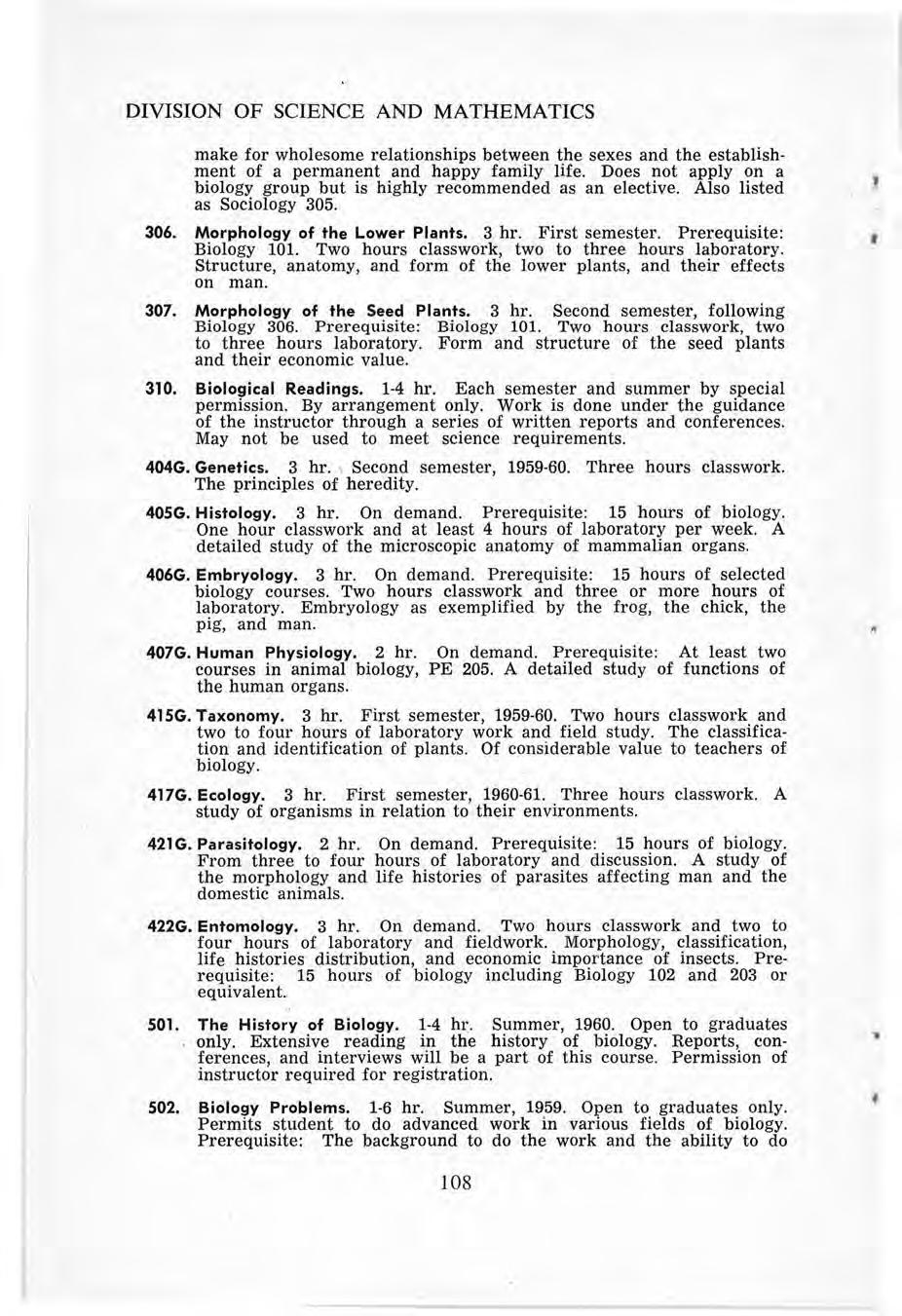
extensive, individual study. Permission of instructor required for ~- registration.
503. Research Problems in the Teaching of Biology. 1-4 hr. Summer, 1960. Open to graduates only The student and his advisor will select problems related to the teaching of biology in the secondary schools, and these will be the basis upon which the course is set up. The difficulty of the problems selected and the amount of time required in solving them will determine the student's credit and grade. Permission of instructor required for registration .
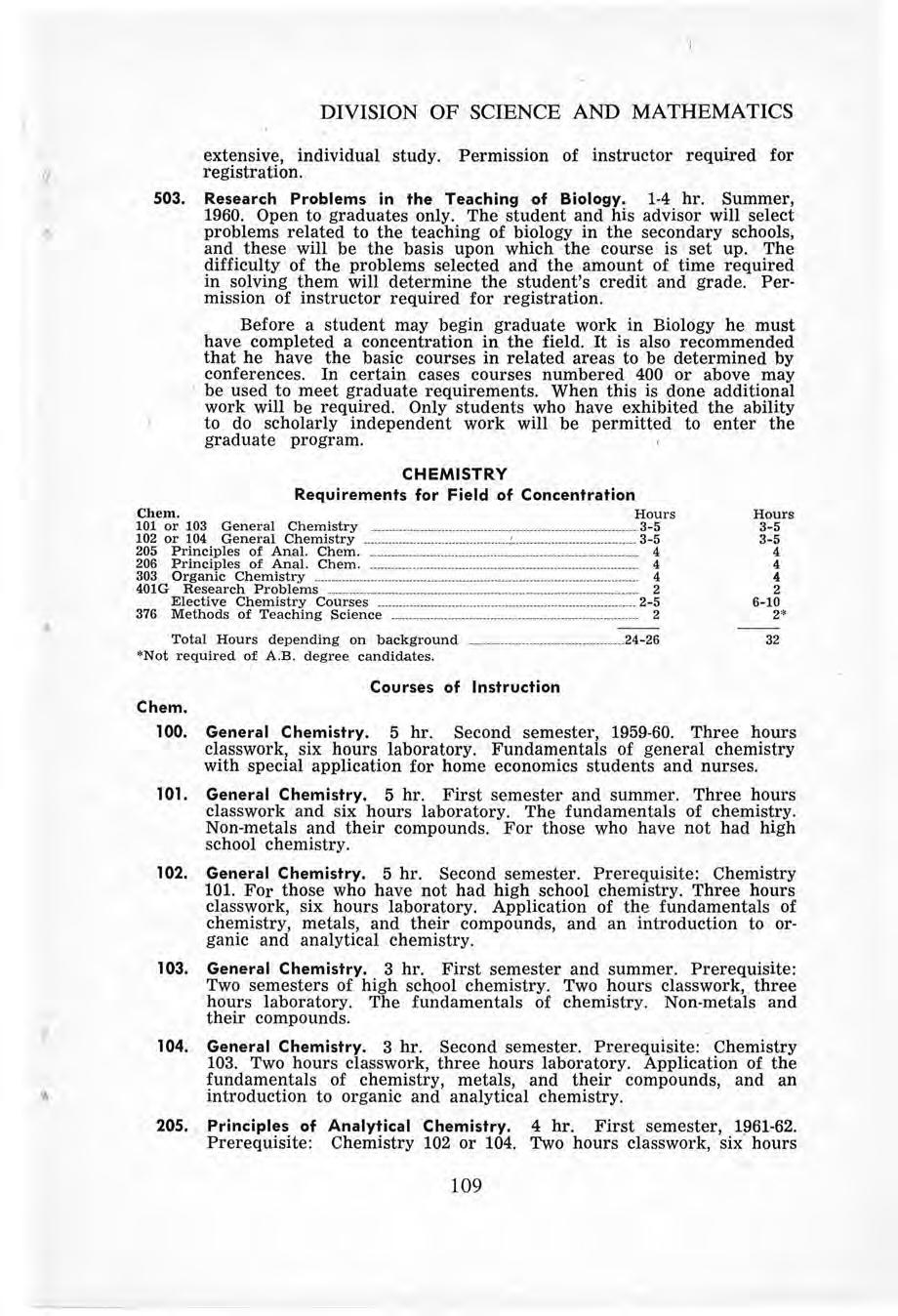
Before a student may begin graduate work in Biology he must have completed a concentration in the field It is also recommended that he have the basic courses in related areas to be determined by conferences. In certain cases courses numbered 400 or above may be used to meet graduate requirements. When this is done additional work will be required . Only students who have exhibited the ability to do scholarly independent work will be permitted to enter the graduate program .
General Chemistry. 5 hr. Second semester, 1959-60. Three hours classwork, six hours laboratory. Fundamentals of general chemistry with special application for home economics students and nurses .
General Chemistry. 5 hr . First semester and summer. Three hours classwork and six hours laboratory. The fundamentals of chemistry. Non -metals and their compounds. For those who have not had high school chemistry.
General Chemistry. 5 hr . Second semester. Prerequisite: Chemistry 101. For those who have not had high school chemistry. Three hours classwork, six hours laboratory. Application of the fundamentals of chemistry, metals, and their compounds, and an introduction to organic and analytical chemistry
General Chemistry. 3 hr. First semester and summer Prerequisite : Two semesters of high sch,ool chemistry Two hours classwork, three hours laboratory. The fundamentals of chemistry . Non-metals and their compounds. ·
104. General Chemistry. 3 hr. Second semester. Prerequisite : Chemistry 103 . Two hours classwork, three hours laboratory. Application of the fundamentals of chemistry, metals, and their compounds, and an introduction to organic and analytical chemistry.
205. Principles of Analytical Chemistry. 4 hr. First semester, 1961-62 Prerequisite : Chemistry 102 or 104. Two hours classwork, six hours
laboratory Principles of qualitative analysis, and their application in the laboratory .
Principles of Analytical Chemistry. 4 hr. Second semester, 1961-62. Prerequisite: Chemistry 205. Two hours classwork, six hours laboratory. Principles of quantitative analysis and their application in the laboratory
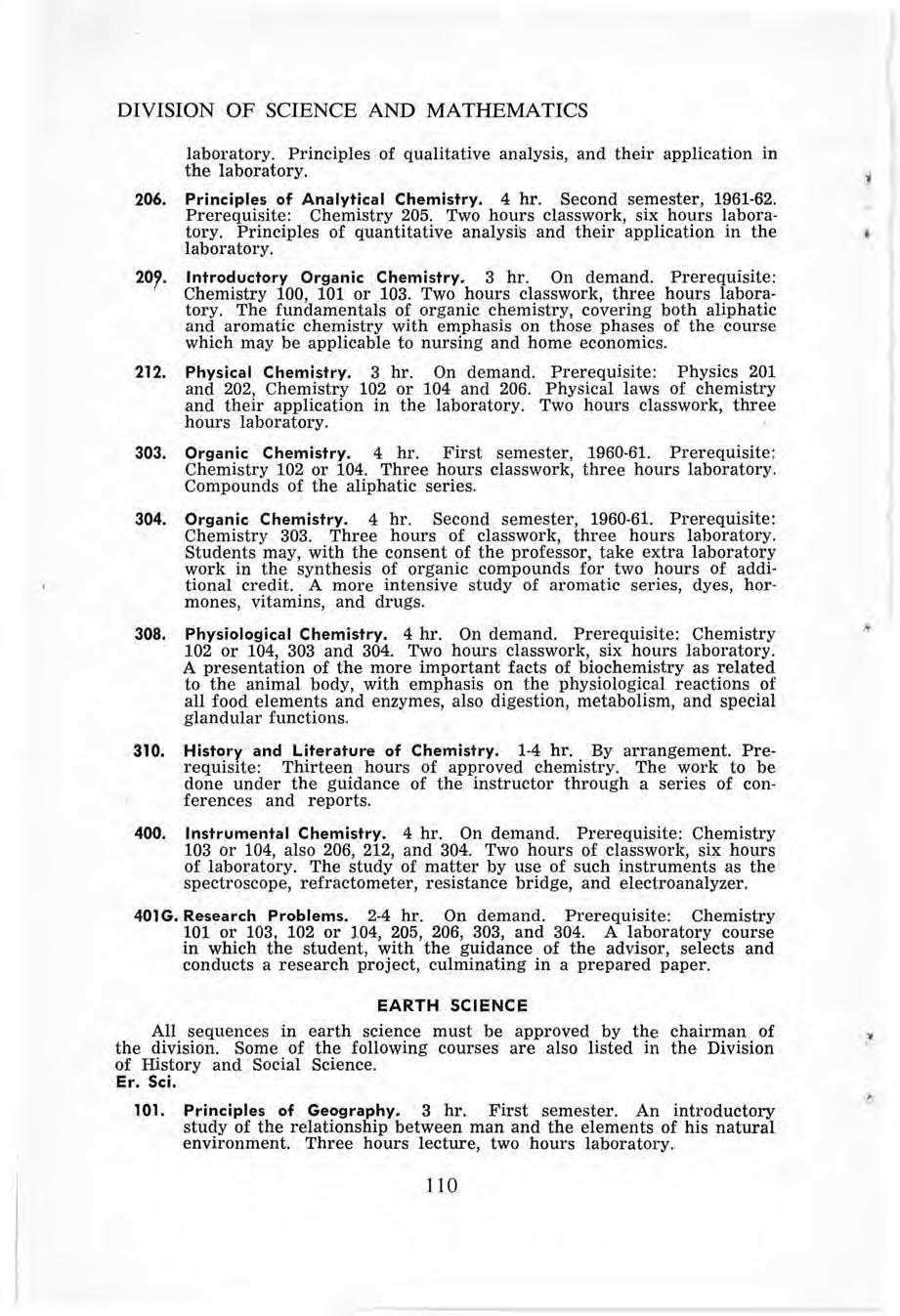
Introductory Organic Chemistry. 3 hr. On demand. Prerequisite : Chemistry 100, 101 or 103. Two hours classwork, three hours laboratory. The fundamentals of organic chemistry, covering both aliphatic and aromatic chemistry with emphasis on those phases of the course which may be applicable to nursing and home economics.
Physical Chemistry. 3 hr . On demand. Prerequisite: Physics 201 and 202, Chemistry 102 or 104 and 206 Physical laws of chemistry and their application in the laboratory. Two hours classwork, three hours laboratory.
Organic Chemistry. 4 hr. First semester, 1960-61. Prerequisite : Chemistry 102 or 104. Three hours classwork, three hours laboratory. Compounds of the aliphatic series.
Organic Chemistry. 4 hr. Second semester, 1960-61. Prerequisite: Chemistry 303. Three hours of classwork, three hours laboratory Students may, with the consent of the professor, take extra laboratory work in the synthesis of organic compounds for two hours of additional credit . A more intensive study of aromatic series , dyes, hormones, vitamins, and drugs.
308. Physiological Chemistry. 4 hr. On demand. Prerequisite : Chemistry 102 or 104, 303 and 304. Two hours classwork, six hours laboratory A presentation of the more important facts of biochemistry as related to the animal body, with emp hasis on the physiological reactions of all food elements and enzymes, also digestion, metabolism, and special glandular functions.
310. History and Literature of Chemistry. 1-4 hr. By arrangement. Prerequisite: Thirteen hours of approved chemistry. The work to be done under the guidance of the instructor through a series of conferences and reports.
400. Instrumental Chemistry. 4 hr. On demand . Prerequisite : Chemistry 103 or 104, also 206, 212, and 304. Two hours of classwork, six hours of laboratory The study of matter by use of such instruments as the spectroscope, refractometer, resistance bridge, and electroanalyzer.
401G. Research Problems. 2-4 hr. On demand. Prerequisite: Chemistry 101 or 103 , 102 or 104, 205, 206, 303, and 304. A laboratory course in which the student, with the guidance of the advisor, selects and conducts a research project, culininating in a prepared paper.
All sequences in earth science must be approved by the chairman of the division Some of the following courses are also listed in the Division of History and Social Science. Er. Sci.
101. Principles of Geography. 3 hr. First semester. An introductory study of the relationship between man and the elements of his natural environment. Three hours lecture, two hours labor atory.
206. 212. 303. 304.120. Regional Geography. 3 hr. Second semester. Ari application of geographic principles to the interpretation of the interests, policies, and activities of the peoples in significant regions of . the world . Three hours lecture, two hours laboratory.
226. Conservation of Natural Resources. 3 hr. First semester, 1959-60. An evaluation of the extent of our natural resources and plans for their utilization, with discussions on current proble ms and projects of conservation
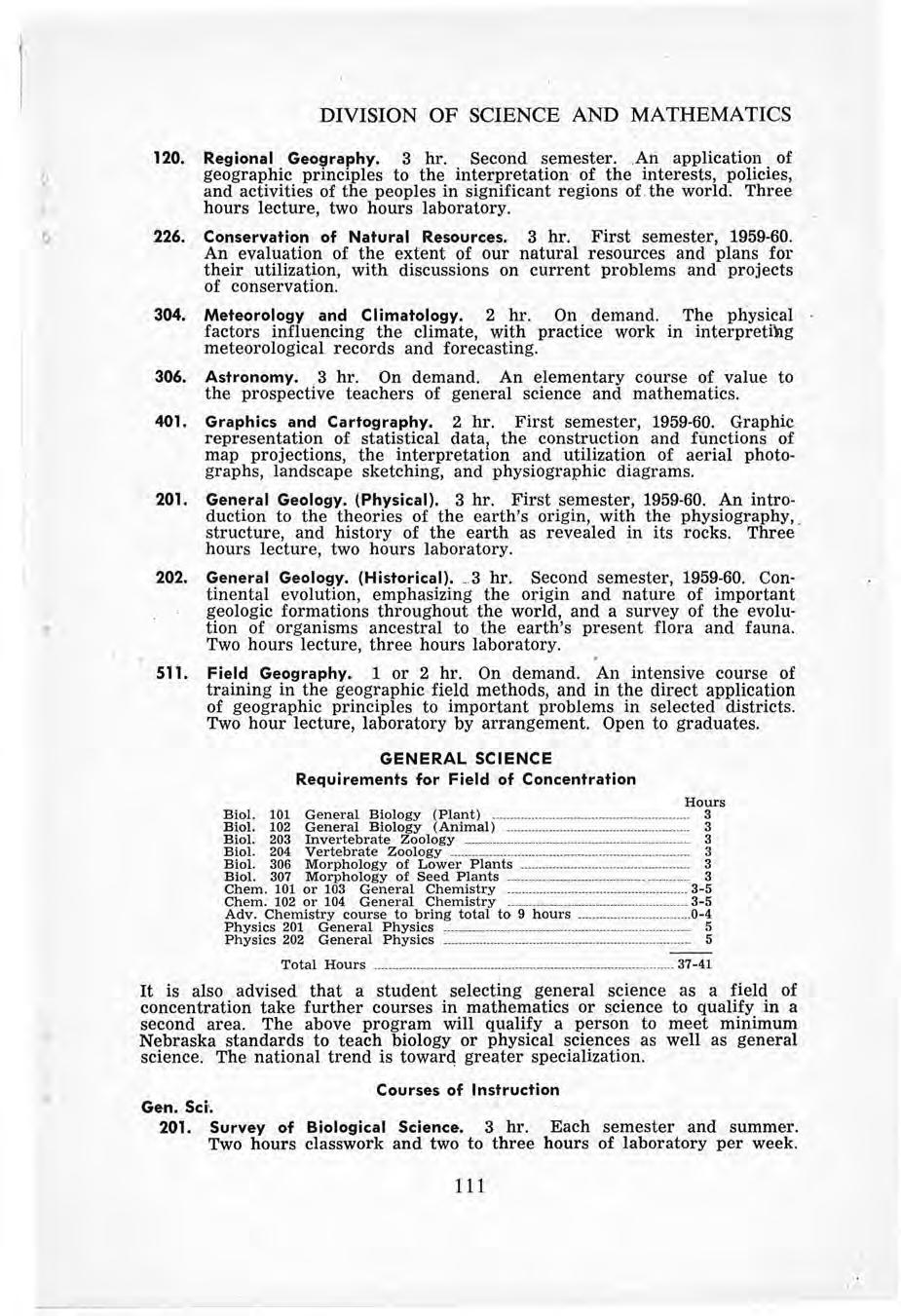
304. Meteorology and Climatology. 2 hr On demand. The physical factors influencing the climate, with practice work in interpretillg meteorological records and forecasting .
306. Astronomy. 3 hr . On demand . An elementary course of value to the prospective teachers of general science and mathematics.
401. Graphics and Cartography. 2 hr. First semester, 1959-60. Graphic repres entation of statistical data, the construction and ·functions of map projections, the interpretation and utilization of aerial photographs, landscape sketching, and physiographic diagrams.
201. General Geology. {Physical). 3 hr. First semester, 1959-60 An introduction to the theories of the earth's origin, with the physiography, . structure, and history of the earth as revealed in its rocks Three hours lecture, two hours laboratory
202. General Geology. (Historical). __ 3 hr. Second semester, 1959-60. Continental evolution, emphasizing the origin and nature of important geolo gic formations throughout the world, and a survey of the evolution of organisms ancestral to the earth's present flora and fauna. Two hours lecture, three hours laboratory .
511. Field Geography. 1 or 2 hr. On demand. An intensive course of trainin g in the geographic .field methods, and in the direct application of geographic principles to important problems in selected districts . Two hour lecture, laboratory by arrangement. Open to graduates
It is also advised that a stu(l.ent selecting general science as a field of concentration take further courses in mathematics or science to qualify in a second area The above program will qualify a person to meet minimum Nebraska standards to teach biology or physical sciences as well as general science. The national trend is toward greater specialization.
· An integ rated course covering the various pha ses of natural science, with special applications for elementary teachers. Requir ed for all students in th e elementary curriculum.
202. Survey of Physical Science. _. 3 hr. Each semester and summer. Two hours of classwork and two or three hours of laboratory per week. An integrated course covering the various phases of physical science. Requir ed of all students in the elementary curriculum
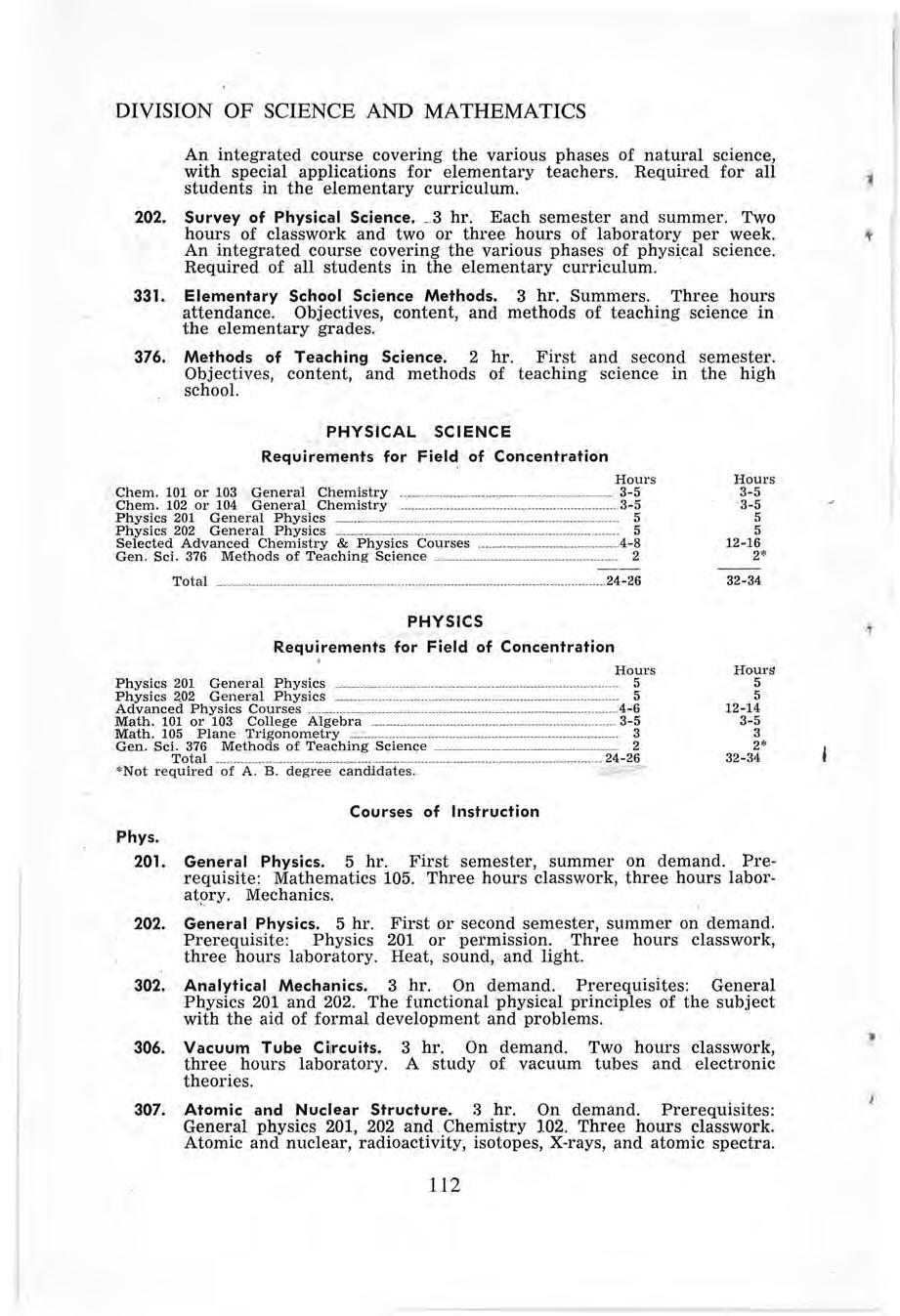
331. Elementary School Science Methods. 3 hr. Summers. Three hours attendance. Objectives, content, and methods of teaching science in the elementary grades.
376. Me,thods of Teaching Science. 2 hr First and second semester. Objectives , content, and methods of teaching science in the high school.
Courses of Instruction
General Physics. 5 hr. First semester, summer on demand. Prerequisite: Mathematics 105. Three hours classwork, three hours laborat9ry. Mechanics.
G1meral Physics. 5 hr. First or second semester, summer on demand. Prerequi site: Physics 201 or permission. Three hours classwork, three hours laboratory H ea t, sound, and light.
Analytical Mechanics. 3 hr. On demand
Prerequisites: General Physics 201 and 202. The functional physical principles of the subject with the aid of formal development and problems.
Vacuum Tube Ci1rcuits. 3 hr. On deman,d. Two hours classwork, three hours laboratory A study of vacuum tubes and electronic theories.
Atomic and Nuclear Structure. 3 hr On demand. Prerequisites: General physic s 201, 202 and Chemistry 102. Three hours classwork. Atomic and nuclear, radioactivity, isotopes, X-rays, and atomic spectra.
..
310 . History and Literature of Physics. 1-2 hr Each semester and summer. By arrangement. Work to b e done under the guidance of the instructor through a series of reports and conferences.
• Not required of A.B. degree candid ates.
It is highly recommended that s tud en ts specialize in one or more of the s ci en ces along with mathematics. Many mathematics teachers are sought who ' can qualify in the physical sciences.
Basic Mathematics. 3 hr. Each term .' Required of all students deficient in basic mathematical skills as revealed by a standardized test, given during the freshman year. Course is a study of fundamental processes including algebra and the application thereof. Does not apply in mathematics field of · concentration. ·
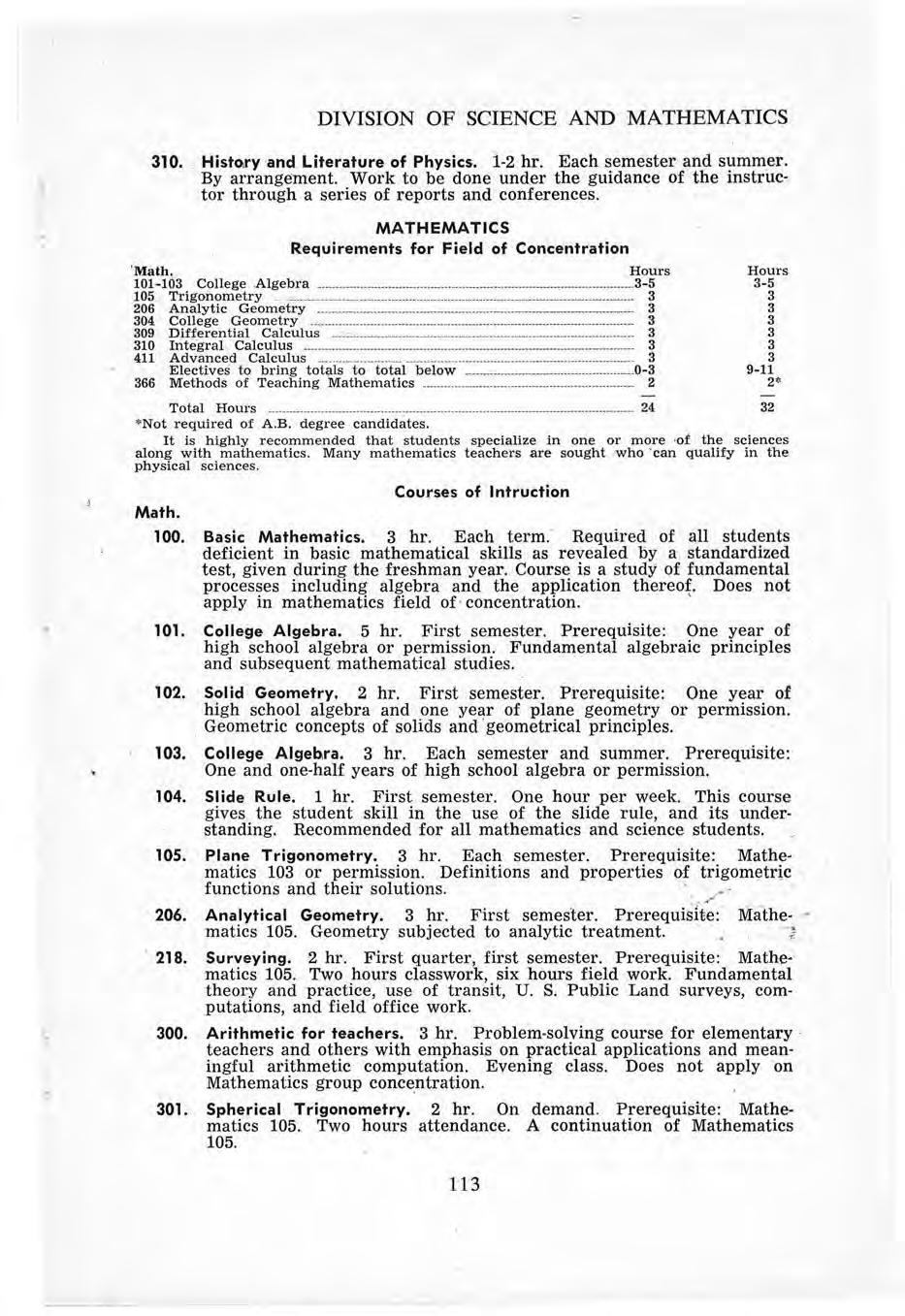
College Algebra. 5 hr . First semester. Prerequisite : One year of high school algebra or permission. Fundamental algebraic principles and subsequent mathematical studies.
Solid Geometry. ·2 hr. First semester . Prerequisite: One year of high school algebra and one year of plane geometry or permission . Geometric concepts of solids and ·geometrical principles.
College Algebra. 3 hr . Each semester and summer. Prerequisite: One and one-half years of high school algebra or permission.
Slide Rule. 1 hr . First semester. One hour per week. This course gives the student skill in the use of the slide rule, and its understanding . Recommended for all mathematics and science students.
Plane Trigonometry. 3 hr Each semester. Prerequisite: Mathematics 103 or permission . Definitions and properties of trigometrtc . functions and their solutions. ' ·
Analytical Geometry. 3 hr. First semester. Prerequisite : Mathe-matics 105. Geometry subjected to analytic treatment. · ·
Surveying. 2 hr . First quarter, first semester. Prerequisite : Mathe•· matics 105 . Two hours classwork, six hours field work . Fundamental theory and practice, use of transit , U. S. Public Land surveys, computations, and field office work.
Arithmetic for teachers. 3 hr. Problem-solving course for elementary · teachers and others with emphasis on practical applications and meaningful arithmetic computation. Evening class. Does not apply on Mathematics group conce.ntration .
Spherical Trigonometry. 2 hr On demand Prerequisite: Mathematics 105. Two hours attendance. A continuation of Mathematics 105
304. College Geometry. 3 hr First semester and summer. Prerequisite : Two semesters of high school geometry. A thorough consideration of the geometry of the triangle and the circle. Recommended for prospective teachers of high school geometry.
309. Differential Calculus. 3 hr. Second semester . Prerequisite: Mathematics 206. Concerned with the problem of rate of change of a function with respect to a variable.
310. Integral Calculus. 3 hr. First semester. Prerequisite : Mathematics 309. Relations connecting finite values of variables
366. Methods of Teaching Mathematics. _. 2 hr. First and second semester. Objectives, content, and methods of teaching mathematics in the high school.
401. Solid Analytical Geometry. 2 hr. On demand. Prerequisite: Mathematics 206. A study of three dimensional space including loci, the plane, the straight line, surfaces, and curves.
404. History of Mathematics. 3 hr. On demand. Prerequisite: Nine hours of college mathematics . A history of ma t hematics and its effects on man.
411. Calculus Ill. 3 hr. Second semester Prerequisite: Ma t hematics 310. Indefinite series, partial differentiation and multiple integrals, with application .
415 . . __ .Theory of Equations. 3 hr . Second semester 1959-60 . Prerequisite: Mathematics 310. Algebraic solution of cubic and quadratic equations, methods of approximatin g roots, symmetric functions, resultants, determinants, and systems of linear equations.
416. Differential Equations. 3 hr. Second semester 1959-60. Prerequisite: Mathematics 310 Formation of differential equations, equations of high order, linear equation with constant and v ariabl e co-efficients, partial differentiation, application to geometry, m echanics, and physics.
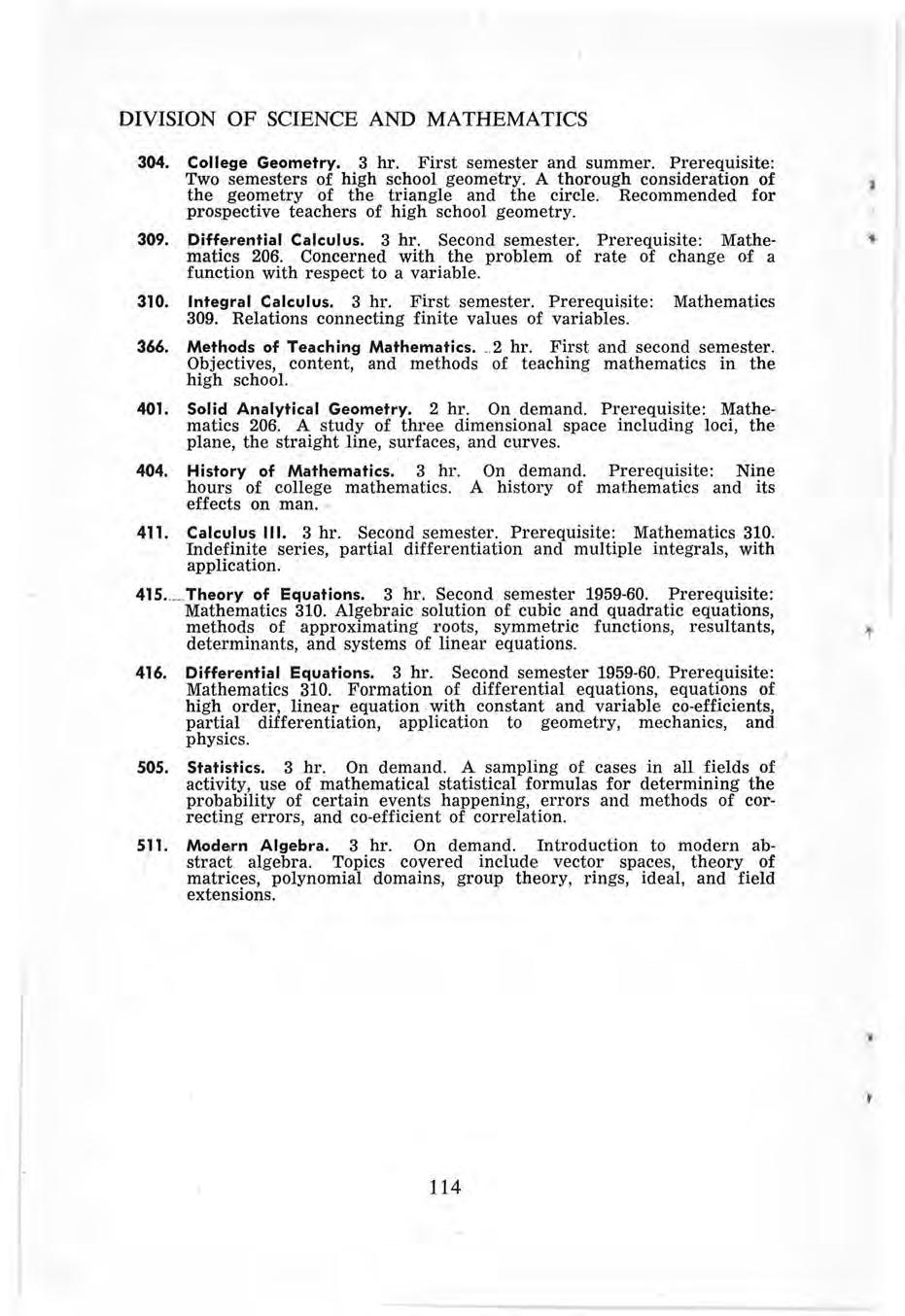
505. Statistics. 3 hr. On demand. A sampling of cases in all fields of activity, use of mathematical statistical formulas for determining the probability of certain events happening, errors and methods of correcting errors, and co-efficient of corre lation.
511. Modern Algebra. 3 hr. On demand. Introduction to modern abstract algebra. Topics covered include vector spaces, theory of matrices, polynomial domains , group theory, ring s, ideal, and field extensions .
Granted in the Year 1958
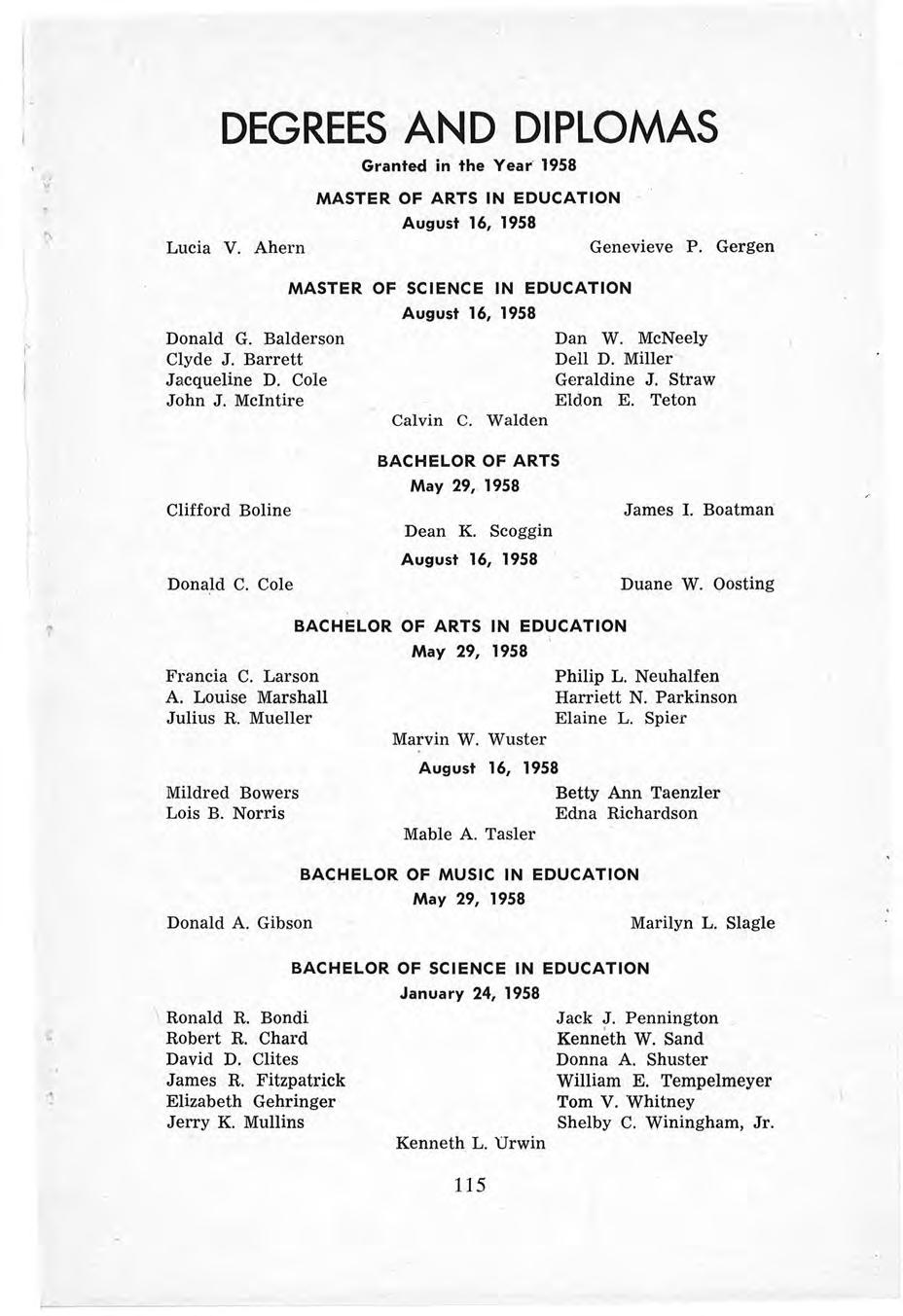
MASTER OF ARTS IN EDUCATION
August 16, 1958
Lucia V. Ahern Genevieve P. Gergen
MASTER OF SCIENCE IN EDUCATION
August 16, 1958
Donald G. Balderson
Clyde J. Barrett
Jacqueline D. Cole
John J . McIntire
Calvin C. Walden
BACHELOR OF ARTS
May 29, 1958
Clifford Boline
Dean K. Scoggin
August 16, 1958
Donald C Cole
Dan W. McNeely
Dell D. Miller
Geraldine J. Straw
Eldon E. Teton
James I . Boatmari
Duane W. Oosting
BACHELOR OF ARTS IN EDUCATION
May 29, 1958
Francia C Larson
A. Louise Marshall
Julius R. Mueller
Marvin W. Wuster
August 16, 1958
Mildred Bowers
Lois B. Norris
Mable A. Tasler
Philip L. Neuhalfen
Harriett N. Parkinson
Elaine L. Spier
Betty Ann Taenzler
Edna Richardson
BACHELOR OF MUSIC IN EDUCATION
May 29, 1958
Donald A. Gibson Marilyn L. Slagle
BACHELOR OF SCIENCE IN EDUCATION
January 24, 1958
Ronald R. Bondi
Robert R. Chard
David D. Clites
James R. Fitzpatrick
Elizabeth Gehringer
Jerry K. Mullins
Kenneth L Urwin
Jack J Pennington
Kenneth W. Sand
Donna A. Shuster
William E. Tempelmeyer
Tom V. Whitney
Shelby C. Winingham, Jr.
May 29, 1958
Corwin V. Arndt
A. Robert Auffert
James F. Bennett
Kenneth W . Clark
Richard L. Corwine, Jr .
Martha Cox
Nedra E. Craig
Thomas R. Eastman
Rose M. Edelman
Ray F. Ehlers
Carrol W. Engdahl
Norman H Fredericks
Marie F. Gerdes
Robert E . Gess
Douglas J. Gibson
Jerry J Grancer
JoAnne Gruber
Lorraine L . Haack
Henry W. Hart
Rodney M. Heim
H. Glen Heywood
Richard D Heywood
LeRoy D. Hughes
Virginia A. Karas
Jerome J. Koenig
Richard P. Kumpf
Jerry P. Ludwig
Sidney D. Applegate
Rose M. Bernard
Freda L Bliven
Norma D. Bremer
Patty Colby
Elaine V. Dailey
Irene M. Dierking
Lillian J. Eddy
Gerda D. Foged
Constance C. Francois
Lois A. Giles
Gilbert E . Gray
E. Eunice Harshbarier
Hariey D. Hecker
Irene M. Heng
Johnielee C. Henning
Chet Henninger
Evelyn Hermsmeier
Bess B. Jacquot
August 16, 1958
Alonzo E. McCain
Marilyn A. Meyer
William A. Miller
Jane E . Monroe
Ardath M. Moore
Berwyn L . Moren
Harold Norris, Jr.
Robert E Norvell
John P O'Connor
Jerry L. Payne
Robert D. Reed
·
Muriel I. Rieke
Philip 0 . Rihner
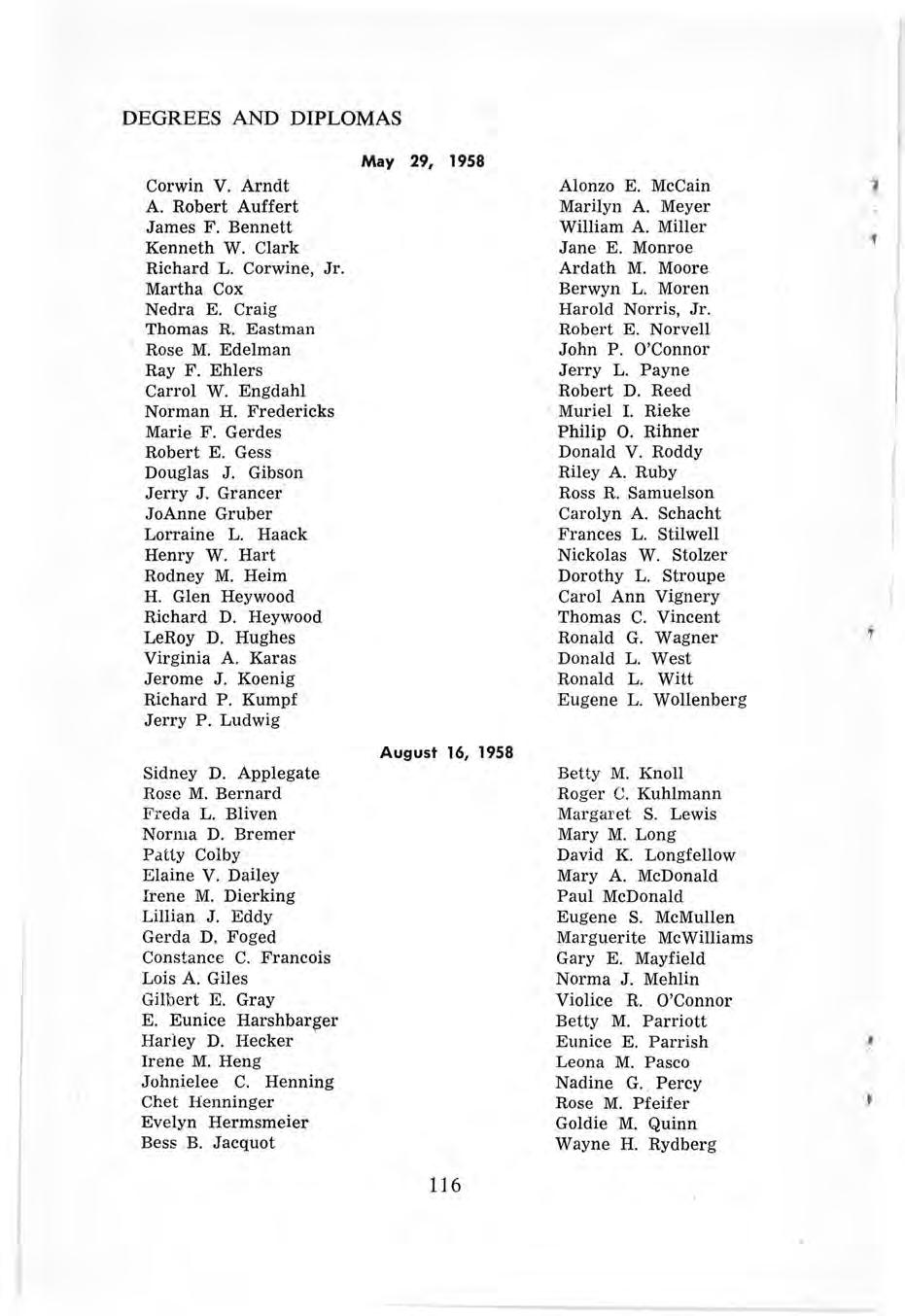
Donald V. Roddy
Rile y A. Ruby
Ross R. Samuelson
Carolyn A. Schacht
Frances L . Stilwell
Nickolas W. Sfolzer
Dorothy L. Stroupe
Carol Ann Vignery
Thomas C. Vincent
Ronald G. Wagner
Don a ld L. West
Ronald L Witt
Eugene L. Wollenberg
Betty M. Knoll
Ro ger C. Kuhlmann
Margaret S Lewis
Mary M. Long
David K. Longfellow
Mary A . McDonald
Paul McDonald
Eugene S. McMullen
Marguerite McWilliams
Gary E. Mayfield
Norma J . Mehlin
Violice R. O'Connor
Betty M. Parriott
Eunice E. Parrish
Leona M. Pasco
Nadine G. . Percy
Rose M Pfeifer
Goldie M Quinn
Wayne H. Rydberg
Richard L. Stogdill
Darleen J Teten
Guilford W. Thomas
Marie L. Thornhill
Enid M. VanLuven
Ida M. Weddle
Naomi L . Wheeler
TWO-YEAR DIPLOMA
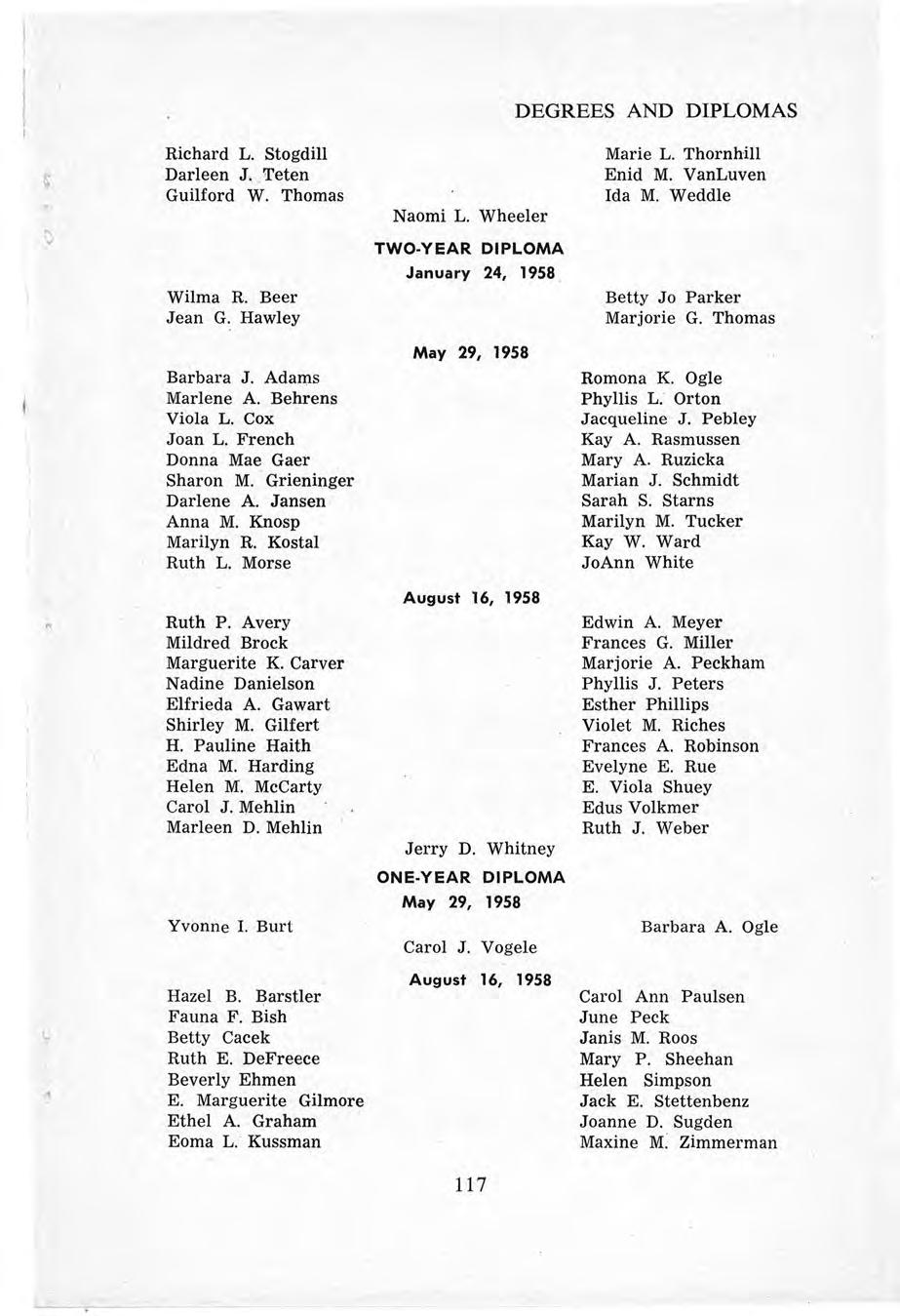
January 24, 1958
Wilma R. Beer
Jean G. Hawley
Barbara J. Adan:is
Marlene A. Behrens
Viola L. Cox
Joan L. French
Donna Mae Gaer
Sharon M. Grieninger
Darlene A. Jansen
Anna M. Knosp
Marilyn R. Kostal
Ruth L. Morse
Ruth P. Avery
Mildred Brock
Marguerite K. Carver
Nadine Danielson
Elfrieda A . Gawart
Shirley M Gilfert
H. Pauline Haith
Edna M. Harding
Helen M. McCarty
Carol J Mehlin
Marleen D. Mehlin
May 29, 1958
August 16, 1958
Betty Jo Parker
Marjorie G. Thomas
Romona K. Ogle
Phyllis L. Orton
Jacqueline J. Pebley
Kay A . Rasmussen
Mary A. Ruzicka
Marian J. Schmidt
Sarah S. Starns
Marilyn M. Tucker
Kay W . Ward
JoAnn White
Edwin A. Meyer
Frances G Miller
Marjorie A . Peckham
Phyllis J. Peters
Esther Phillips
Violet M. Riches
Frances A. Robinson
Evelyne E Rue
E. Viola Shuey
Edus Volkmer
Ruth J . Weber
Yvonn e I. Burt
Jerry D. Whitney
ONE-YEAR DIPLOMA
May 29, 1958
Carol J. Vo gele
August 16, 1958
Hazel B. Barstler
Fauna F . Bish
Betty Cacek
Ruth E. DeFreece
Beverly Ehmen
E. Marguerite Gilmore
Ethel A. Graham
Eoma L. Kussman
Barbara A . Ogle
Carol Ann Pauls e n
June Peck
Janis M. Roos
Mary P Sheehan
Helen Simpson
Jack E Stettenbenz
Joanne D Sugden
Maxin e M: Zimmerman
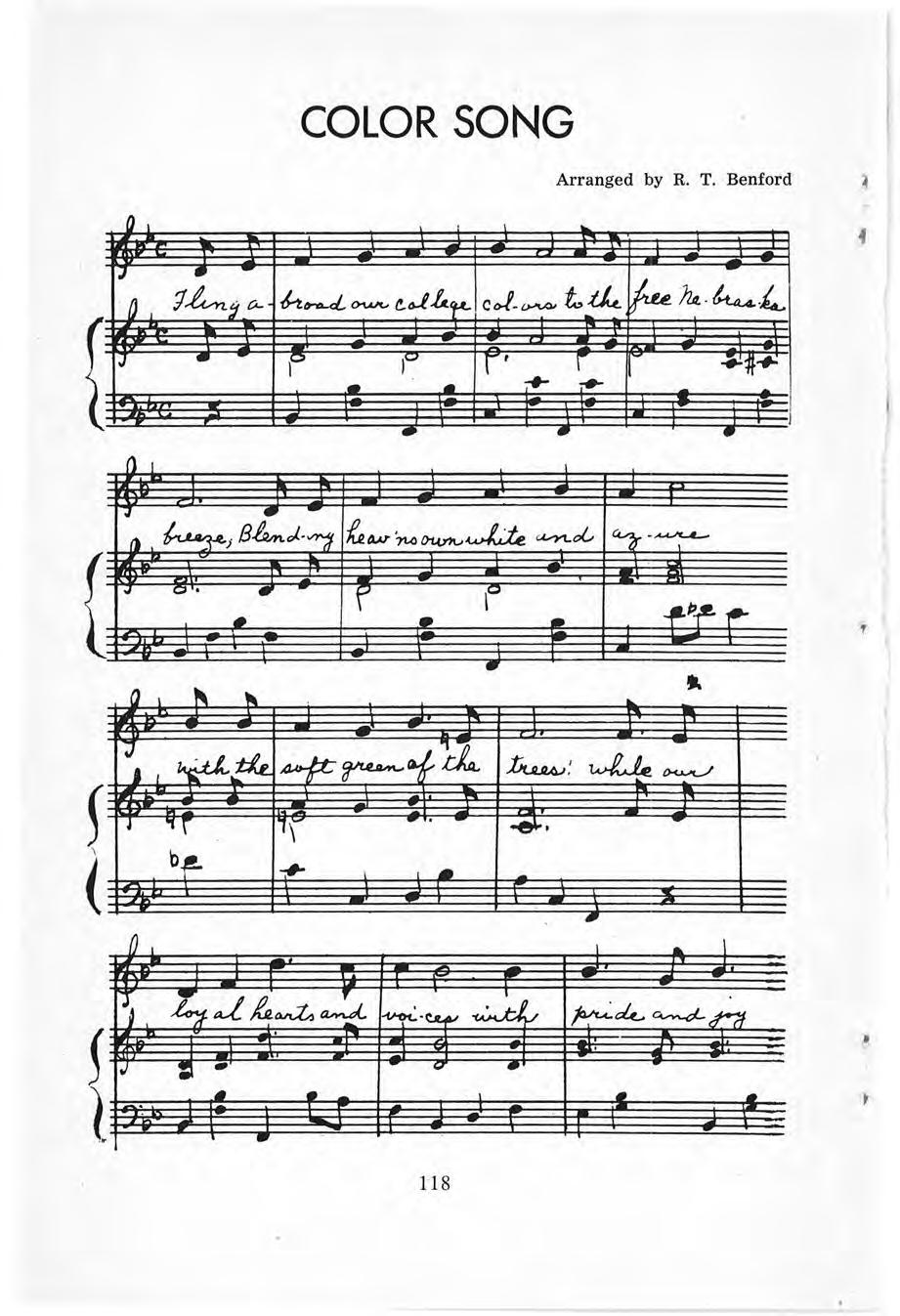
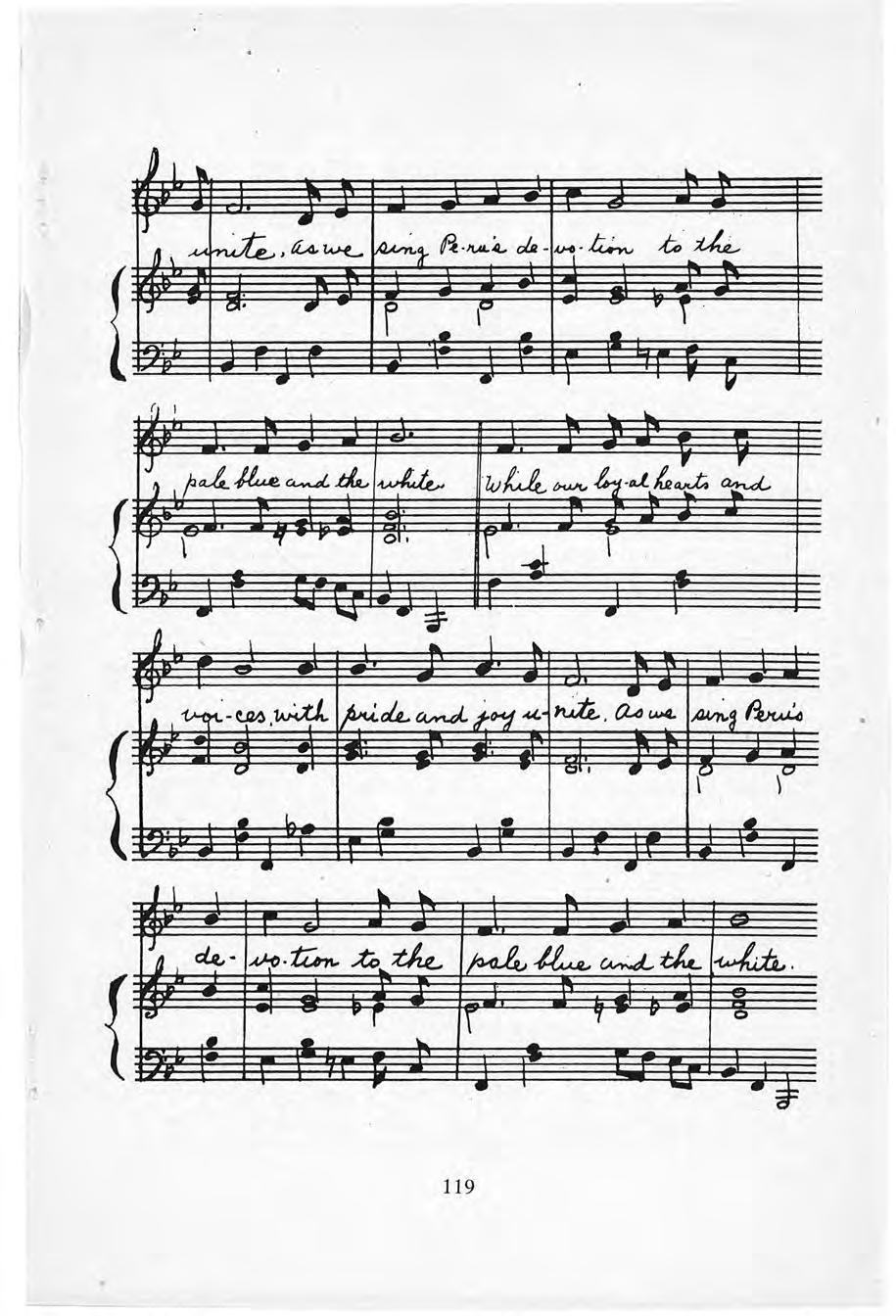
(Date indicates year in which service at Peru began.)
MARYON ADAMS (1955) Assistant Professor of Education. Children's Literature, Kindergarten Supervisor
B.S., M.S., Nebraska State Teache rs College , Peru.
ALMA ASHLEY (1949) ____________ Associate Professor of Elementary Education.
B.S , M A , University of N e bras ka, Lincoln Graduate Study, University of Nebrask a , Lincoln; Teachers College, Columbia Univ ers ity, New York City
ROBERT T. BENFORD (1926) _________ Associate Professor of Piano and Organ.
A.B., Nebraska State Teachers College, Peru M M. , Univ e rsity of Michigan, Ann Arbor. Graduate Study , Univ e rsity of Nebraska, Lincoln ; State University of Iowa , Iowa City
ARVAL BOHN (1958) Assistant Professor of Mathematics
A.B ., M.A., Univers ity of Texas , Au s tin. Graduate Study , University of Texas, University of California , Berkeley.
CLARA BOATMAN (1953) College Nurse.
R.N , Beatiice (Nebraska) Lutheran Hospital. Graduate Stud y, University of Minnesota , Minneapolis.
HAROLD BORAAS (1951) . Dean of Students, Prof . of Educational Psychology.
A.B ., St. Olaf College, Northfield , Minnesota M.A., Teachers College, Columbia University , New York City Ph.D. , Cornell Univer s ity , Ithaca, New York
JUANITA BRADLEY (1956) Associate Dean of Students Assistant Professor of Education.
B.S. , Central Missouri State College , Warrensburg. M.A. , George Peabo dy College for Te a chers , Nashville, Tennessee. Graduat e Study , University of Indiana, Bloomington; University of Chicago.
ALBERT 0. BRADY (1957) _ Assistant Professor of Biological Science .
B.S. , Northern State Teachers College, Aberdeen, South Dakota. M S. , University of South D a kota, Vermillion. Graduat e Study, University of Minnesot a, Lake Itasca ; University of Southern California, Los Angeles.
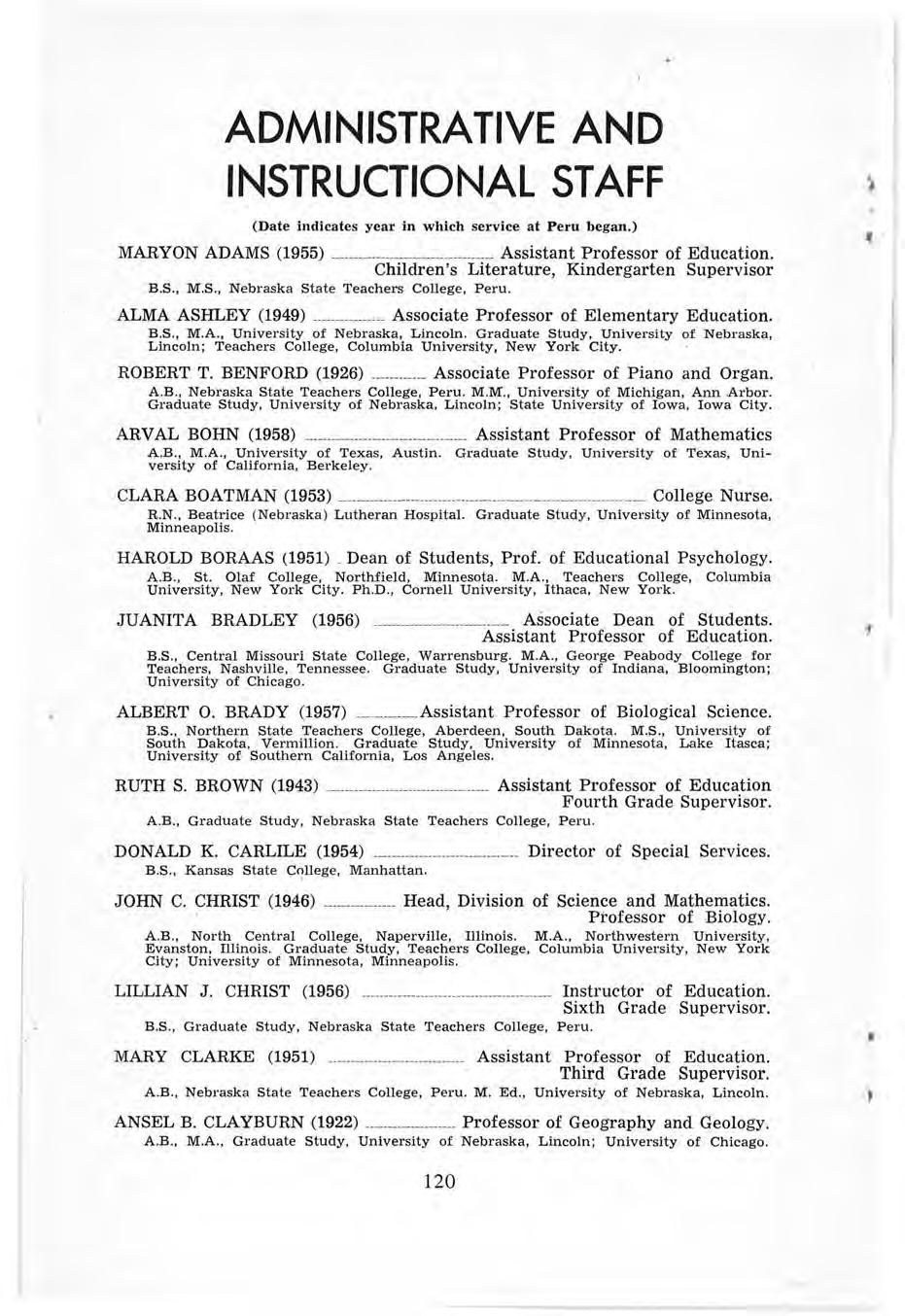
RUTH S. BROWN (1943) - Assistant Professor of Education Fourth Grade Supervisor .
A B. , Graduate Study , N ebraska State T eachers College, P er u.
DONALD K. CARLILE (1954) - Director of Special Services.
B.S. , Kansas State College , Manhattan.
JOHN C. CHRIST (1946) _____________ Head, Division of Science and Mathematics. · Professor of Biology.
A.B ., North Central College , Naperville , Illinois. M.A., Northwestern University, Evanston , Illinois Gradu a te Study, Teachers College, Columbia University , New York City; University of Minnesota, Minne a polis.
LILLIAN J. CHRIST (1956) - Instructor of Education. Sixth Grade Supervisor.
B.S. , Graduate Study , Nebraska State Teachers College, Peru.
MARY CLARKE (1951) - Assistant Professor of Education. Third Grade Supervisor.
A.B. , Nebraska State Teachers College , Peru. M. Ed , University of N e braska, Lincoln
ANSEL B. CLAYBURN (1922) _________ Professor of Geography and Geology.
A.B ., M A ., Graduate Study , University of Nebraska, Lincoln; University of Chicago
·
CHARLOTTE DAVIES (1958) _ _______________ Assistant Librarian . Assistant Professor of Library Science.
B.A ., Augustana College ,:-. Sioux Falls, South Dakota. M.A ., University of Dertver
JOHN A DEARTH (1958) ________ Associate Professor of History and Sociology
A.B., Dai-tmouth College, Hanover, New Hampshire M.A., Clark University, Worcester, Massachusetts. Ph.D., University of Colorado, Boulder.
VIRGIL L. De ZWARTE (1955) __________ Assistant Professor of Physical Education · and Social Science in Campus School.
B .S., Wisconsin State Teachers College, Lacrosse. M .A., Northwestern University , Evanston , Illinois . Graduate Study, University of Nebraska, Lincoln; Nebraska State Teachers College, Peru.
NORMA L. DIDDEL (1929) - Associate Professor of Art.
A.B., University of Denver. M A., Colora do State College of Education , Greeley Graduate Study, Harvard University, Cambridge, M a ssachusetts.
B. A. EDDY (1951) Assistant Professor of Education. Principal, Campus Elementary School, Seventh Grade Supervisor.
B.S., M.A., University of Nebraska, Lincoln. Graduate Study , Nebrask a State Teachers College, Peru; University of Nebraska , Lincoln.
GENEVIEVE GERGEN (1958) __ Assistant Professor of Education . Supervisor of English, Campus School.
A.B., M A. , Nebra ska State Teachers College, Peru.
NEAL $. GOMON (1950) President.
A.B., M A. , Ed.D., University of Nebraska , Lincoln.
OWEN HARLAN (1958) - - - - Head, Division of Practical Arts. Professor of Industrial Arts.
B Ed., Eastern State College, Charleston, Illinois. M A., University of Minnesota, Minneapolis. Ed.D ., University ·of Missouri , Columbia.
HAROLD HUTCHESON (1957) ________________________ Head, Division of Education Professor of Education. Director, Campus School.
B.A., Nebrask a State Teachers College, Wayne. M.A., Ed.D., University of Nebraska, Lincoln.
DOROTHY IVERSEN (1954) ___ : __ Assistant Professor of Education
Fifth Grade Supervisor.
A B., Nebraska State Teachers College, Peru. M A., Colorado State College of Education, Greeley. · ·
D. V. JARVIS (1948) - Associate Professor of Industrial Arts .
A .B., Nebraska State Teachers College, Peru . M.A., Graduate Study, Colorado A . & M., Fort Collins
VICTOR H. JINDRA (1923) - Head, Division of Fine . Arts. Professor of Music, Director of College and Campus School Orchestra.
A B ., University of Nebrask a, Lincoln, Music Certificate, Chicago Musical College. Violin student of Carl Frederick Stecke lberg , Max Fischel , Victor Kuzdo.
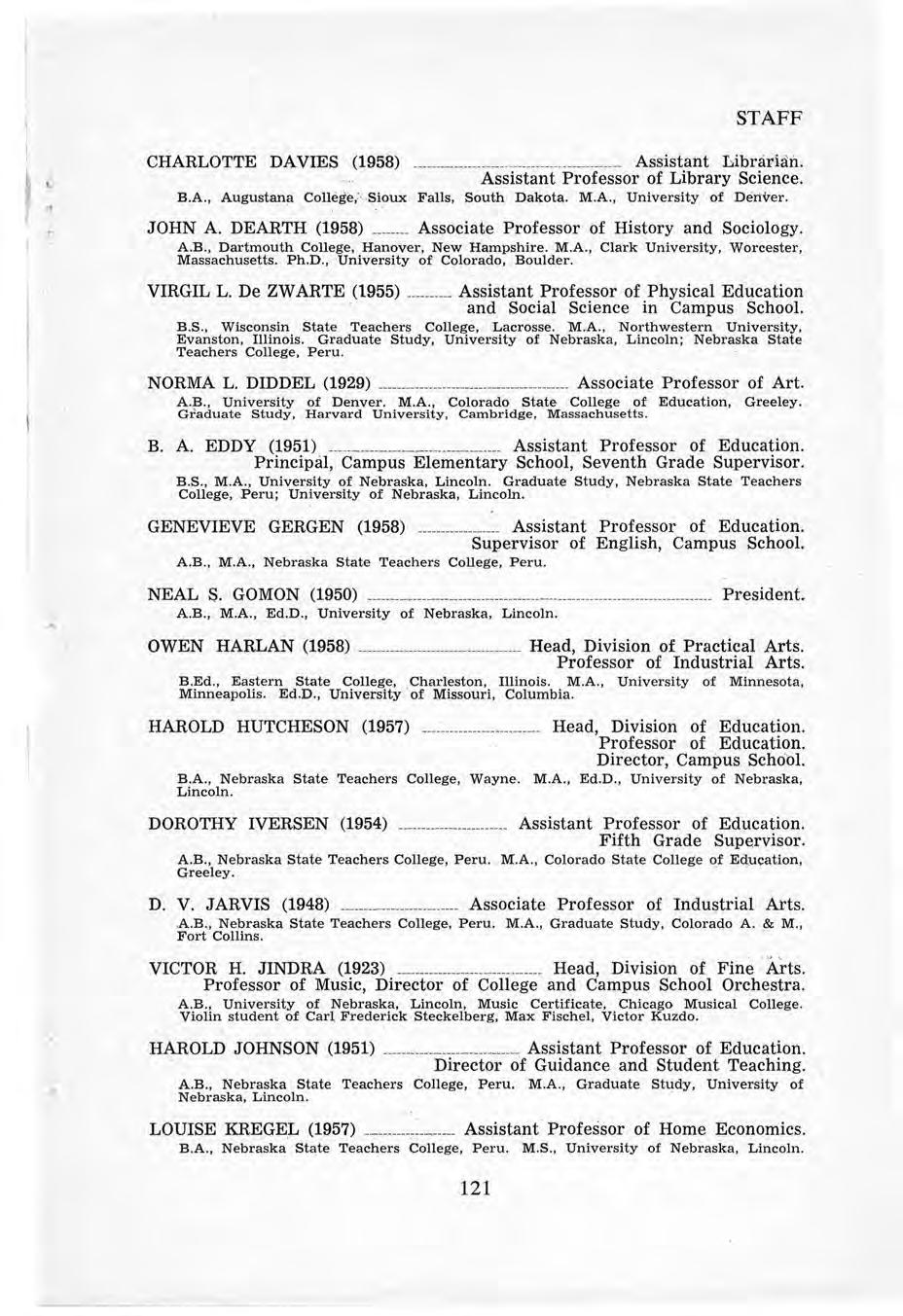
HAROLD JOHNSON (1951) Assistant Professor of Education. · Director of Guidance and Student Teaching .
A .B., Nebraska State Teachers College, Peru . M.A., Graduate Study, University of Nebraska , Lincoln. ·
LOUISE KREGEL (1957) -----,:-~----- Assistant Professor of Home Economics.
B.A ., Nebraska State Teachers College, Peru . M.S ., University of Nebraska , Lincoln.
MAX LANGHAM (1957) - - --- - Librarian. Assistant Professor of Library Science.
B.S., Pennsylvania State Teachers College, Clarion. M.S.L.S., Syracuse University, Syracuse, New York. Additional work, Geneva College, Beaver Falls, Pennsylva ni a.
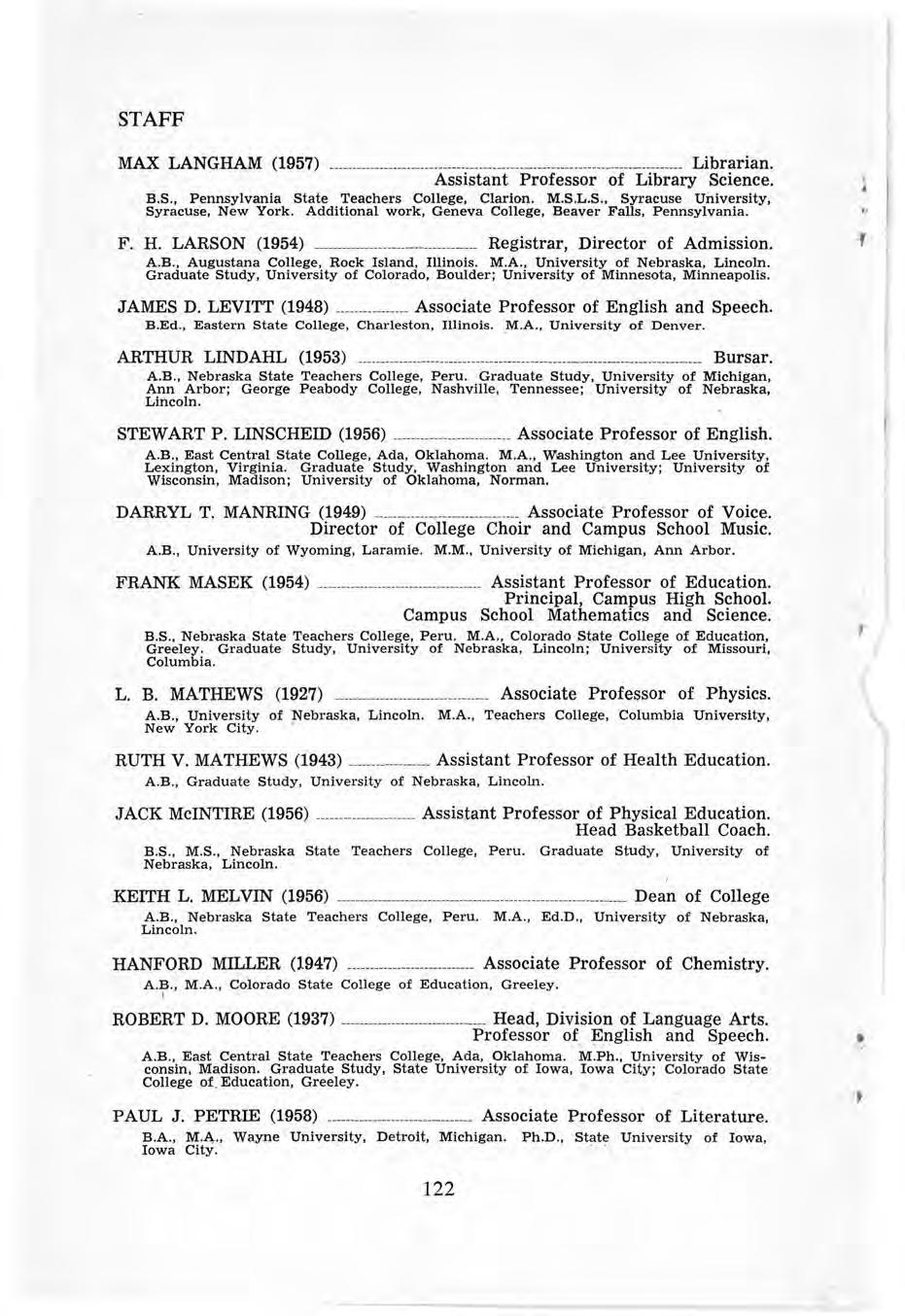
F. H. LARSON (1954) - - Registrar, Director of Admission.
A.B , Augustana College, Rock Island , Illinois. M A., University of Nebraska, Lincoln. Graduate Study, University of Colorado, Boulder ; University of Minnesota , Minneapolis
JAMES D. LEVITT (1948) __ Associate Professor of English and Speech. B.Ed., Eastern State College, Charleston , Illinois. M.A. , University of Denver.
ARTHUR LINDAHL (1953) - - - - Bursar.
A .B., Nebraska State Teachers College , Peru . Graduate Study, University of Michigan, Ann Arbor; George Peabody College, Nashville, Tennessee; University of Nebraska, Lincoln .
STEWART P. LINSCHEID (1956) ___ Associate Professor of English.
A.B., East Central State College, Ada, Oklahoma. M.A ., Washington and Lee University, Lexington, Virginia. Graduate Study, Washington and Lee University; University of Wisconsin, Madison; University of Oklahoma, Norman.
DARRYL T MANRING (1949) - - -- -- Associate· Professor of Voice. Director of College Choir and Campus School Music
A B., University of Wyoming , Laramie M.M., University of Michigan, Ann Arbor
FRANK MASEK (1954) - Assistant Professor of Education. Principal, Campus High School. Campus School Mathematics and Science.
B.S., Nebraska State Teachers College, Peru. M.A., Colorado State College of Education, Greeley. Gr a duate Study, University of Nebraska, Lincoln; University of Missouri, Columbia.
L. B. MATHEWS (1927) - Associate Professor of Physics.
A.B , University of Nebraska, Lincoln. M.A., Teachers College, Columbia University, New York City.
RUTH V. MATHEWS (i943) ____ Assistant Professor of Health Education.
A.B. , Graduate Study , University of Nebraska, Lincoln
JACK McINTIRE (1956) __ Assistant Professor of Physical Education. Head Basketball Coach.
B.S., M S., Nebraska State Te a chers College, Peru G raduate Study, University of Nebraska, Lincoln.
KEITH L. MELVIN (1956) - - Dean of College
A.B., Nebraska State Teachers College, Peru. M.A. , Ed.D. , University of Nebraska, Lincoln.
HANFORD MILLER (1947) - - Associate Professor of Chemistry
A B., M A. , Colorado State Co llege of Education , Greeley
ROBERT D. MOORE (1937) Head, Division of Language Arts. Professor of_ English and ~peech.
A.B ., East Central State Teachers College, Ada , Oklahoma. M.Ph.; University of Wisconsin, Madison. Graduate Study, State University of Iowa, Iowa City; Colorado State College of Education, Greeley.
PAUL J. PETRIE (1958) ----------·---- Associate Professor of Literature
B.A., M ;\ , Wayne University, Detroit, Michiga n. Ph.D., State University of Iowa, Iowa City
GEORGE RATH (1946) _ Associate Professor of Modern Languages .
B .D ., Univer sity of Tuebingen, Germany. A .B ., University of Denver . M .A ., University of Nebraska, Lincoln Study, University of Dorpat, Russia ·
FRIEDA D ROWOLDT (1952) _________________________ Assistant Professor of Education Campus School Commerce Supervisor.
A.B., Nebraska State Teachers College, Wayne. M.A ., Graduate Study , University of Nebra s ka, Lincoln
LESTER RUSSELL (1956) __________________________ Assistant Professor of Industrial Arts .
A.B., Nebraska Sta te Teachers College , Peru. M.A. , University of Minnesota , Minneapolis.
GEORGE SCHOTTENHAMEL (1957) ___________ Acting Head, Division of History and Social Sciences Professor of History and Social Sciences
B.A., North .Central College, Naperville, Illinois M.A in Histo ry, M.A. in Educ atio n, Ph .D ., University of Illinois , Urbana .
GLEN SHEELY (1953) __________________ Assistant Professor of Education . Director Audio-Visual, Eighth Grade Supervisor.
A.B. , Nebraska State Teachers College , Peru M.A ., University of Nebraska, Lincoln.
INA SPROUL (1958) ___________________ Assistant Professor of Home Economics .
B.S. , M.S ., Kansas State College, Manhattan.
JEROME D. STEMPER (1950) • Associate Professor of Physical Education. Director, Intramural Athletics. Head Track Coach, Assistant Football Coach.
A.B., Nebraska State Teachers College , Kearney. M A ., University of Nebraska, Lincoln
GERALDINE STRAW (1957) ___ Assistant Professor of Education. First Grade Supervisor
B.S , M.S., Nebraska State Teachers College, Peru.
JOHN R. THOMPSON (1954) ---------·--------------------------- College Physician.
M.D , College of Medicine, University of Nebraska, Omaha.
STACY VANCE (1922) _________________ Superintendent of . Buildings and Grounds . Nebraska State Teachers College , Peru.
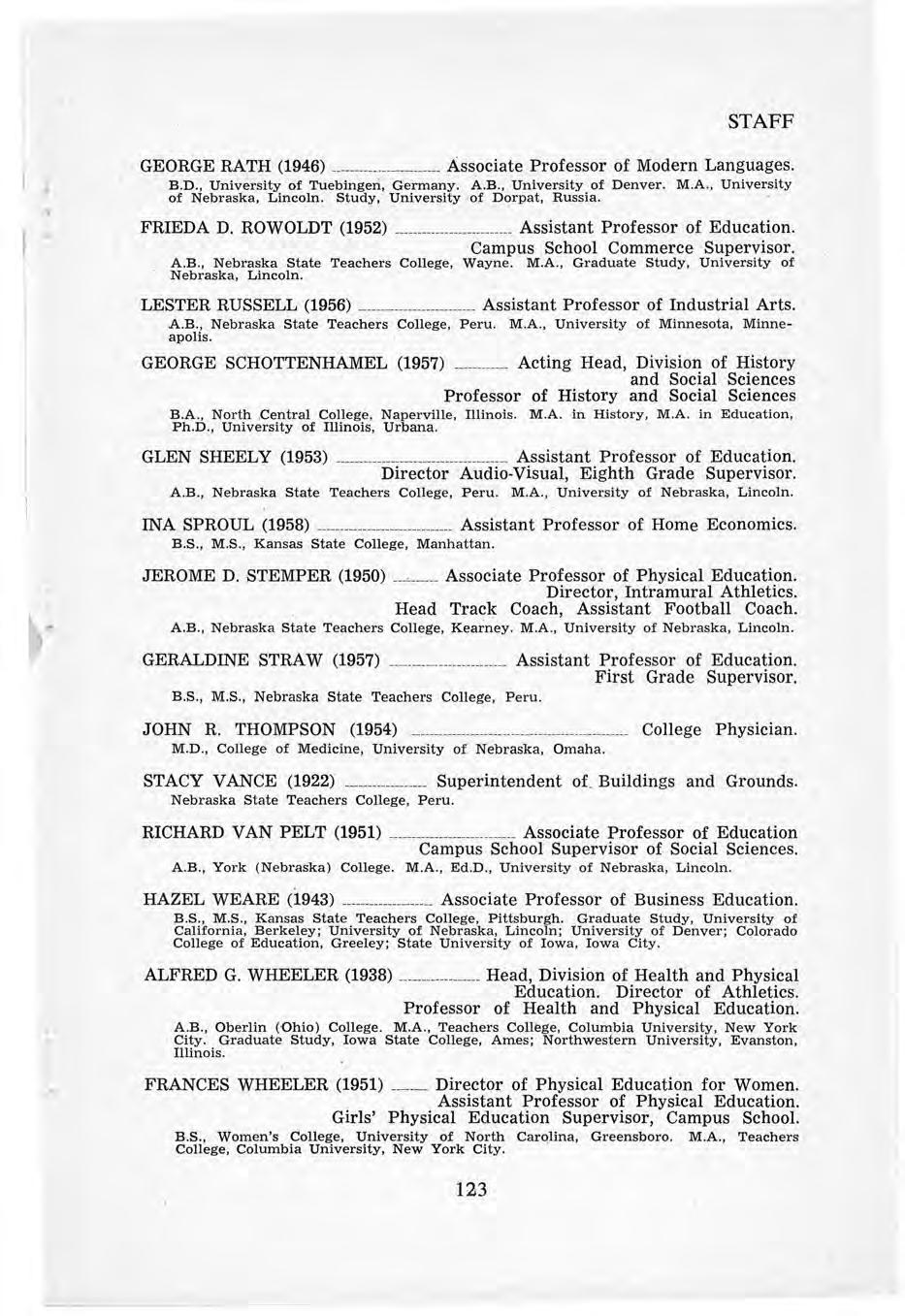
RICHARD VAN PELT (1951) Associate Professor of Education Campus School Supervisor of Social Sciences .
A B ., York (Nebraska) College M A , Ed D. , University of Nebraska, Lincoln.
HAZEL WEARE (i943) ______ Associate Professor of Business Education .
;B.S., M .S., Kansas State Teachers College , Pittsburgh Graduate Study, University of California , Berkeley ; University of Nebraska, Lincoln; University of Denver; Colorado College of Education, Greeley; State University of Iow a , Iowa City.
ALFRED G. WHEELER (1938) ______________ Head, Division of Health and Physical Education. Director of Athletics. Professor of Health and Physical Education.
A.B. , Ob erli n (Ohio) College. M.A ., Teachers College, Columbia University , New York City Graduate Study, Iowa State College, Ames; Northwestern University, Evanston , Illinois.
FRANCES WHEELER (1951) __ Director of Physical Education for Women . Assistant Professor of Physical Education Girls' Physical Education Supervisor, Campus School.
B.S ., Women's College, University of North Carolina, Greensboro. M.A., Teachers College, Columbia University, New York City
GILBERT E. WILSON (1957) __________ Assistant Professor of Instrumental Music Director of College and Campus School Bands
B.S., Southeast Missouri State College, Cape Girardeau M M ., Vande r cook School of Music , Chicago , Illinois Graduate Study, Chicago Musical College
DARRELL WININGER (1952) _ Associate Professor of Educational Psychology.
B S ., M.S ., K a ns as State Te ac hers College, P ittsburgh Ed.D., Colorado State Teachers College , Greeley
ZELMA WONDERLY (1950) - ·- - - Instructor of Education Second Grade Supervisor.
A .B ., Nebrask a State Teachers College, Peru. Gr ad uate Study, Colorado State Teachers College of Education , G ree ley.
C. A HUCK (1923-1951) -- Professor of Mathematics.
NONA PALMER (1915-1950) - Professor of Commerce .
GRACE TEAR (1921-1950) - - Professor of Education.
NELLIE M. CAREY (1944-1957) _____ - -- -- Librarian
PHYLLIS DAVIDSON (1929-1957) _ Professor of Womens' Physical Education.
BLANCHE A GARD (1930-1957) Professor of Education.
EDNA WEARE (1929-1957) Professor of Home Economics.
A. V. LARSON (1926-1958) - - - Professor of Industrial Arts
Administrative and Educational Policies
Admission to Teacher Education
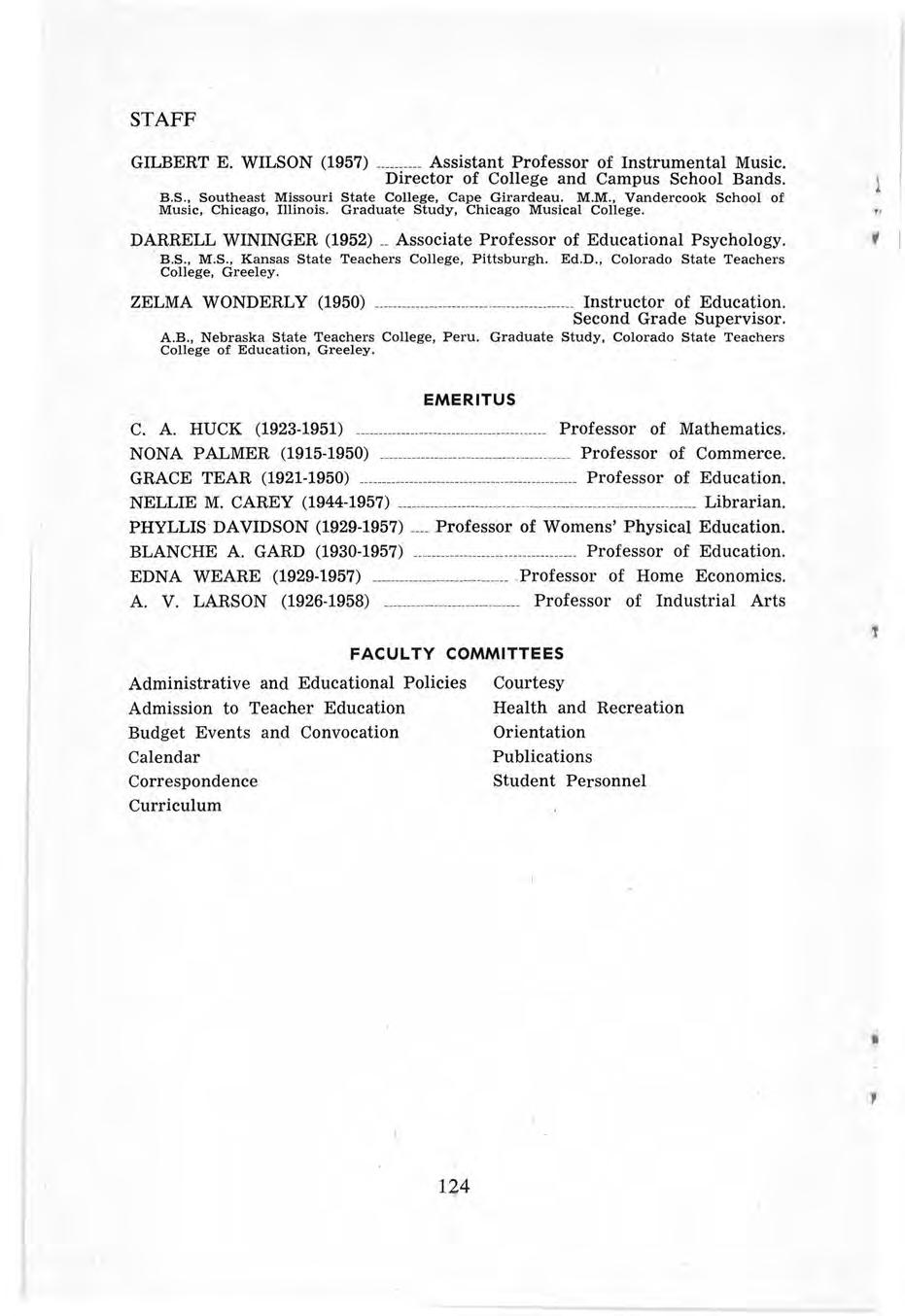
Budget Events and Convocation
Calendar
Correspondence
Curriculum
Courtesy Health and Recreat i on Orientation
Publications
Student Personnel
